

FlightCm Afr ican Commercial Aviation Edition 338 May 2024 Cover: Ken Clark Peter Garrison: Lift Unexplained Jim: More Fuelish Mistakes FLIGHT TEST: Pitts Special – ‘Watch This’ crash. Guy: Boeing’s Incestuous Culture! GULFSTREAM COMMANDER 1000 – BETTER THAN A KING AIR! Okavango – Romantic exploits! Aero Expo - full report! REFURBISHMENT GUIDE
p
DESIGNED FOR THOSE WHO REFUSE TO TRAVEL LIGHT
Big things should be expected from such a big door. The PC-12 NGX is the only single-engine turboprop to provide a pallet-sized cargo door as standard. So, when packing for your next trip in the PC-12 NGX, you won’t have to choose between which pair of shoes to bring. Bring them all. You may even decide to bring your favourite surfboard, motorbike, or mountain bike. Yes, we’ve carried them all, and so can you in the PC-12 NGX. pilatus-aircraft.com
Contact Pilatus PC-12 Centre Southern Africa, your nearest Authorised Pilatus PC-12 NGX Sales Centre for further information on Tel: +27 11 383 0800, Cell +27 82 511 7312 or Email: aircraftsales@pilatuscentre.co.za
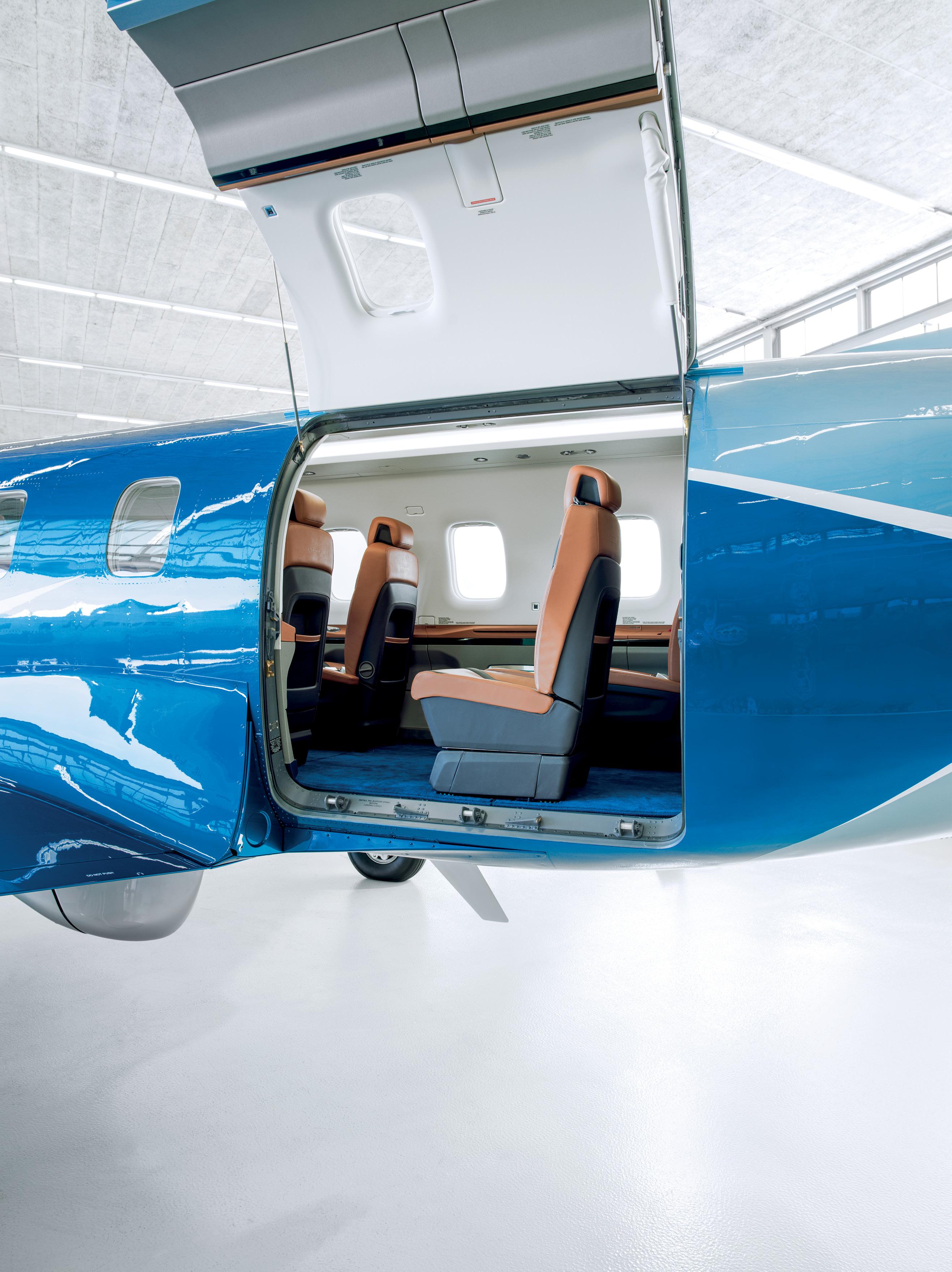
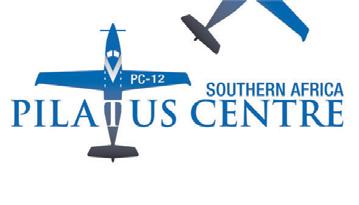
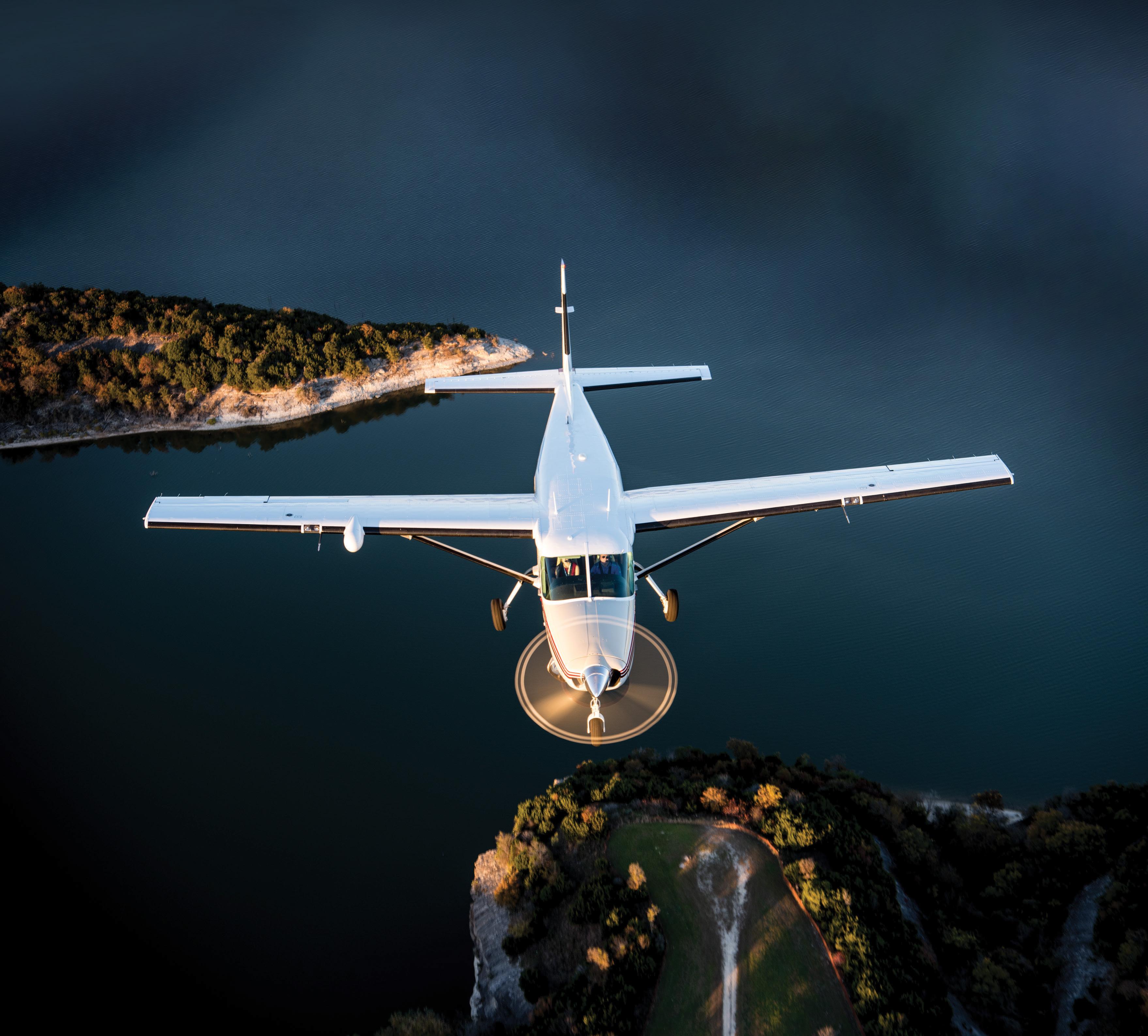
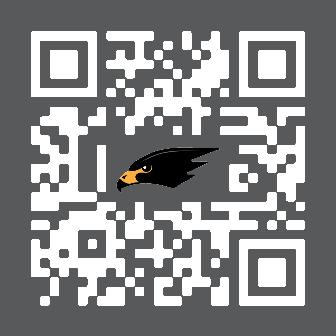

POSITION REPORT
Sometimes it is necessary to take a step back from the day to day business of aviation to remind ourselves of our industry’s overall impact.
THE AVIATION INDUSTRY has become an essential component of almost all economic growth. So an important question is just how big an impact does it have?
IATA commissioned Oxford Economics to do studies on this impact for various countries around the world. These studies found that air transport’s contribution is unique in the bridges it creates between cities. This then translates into the flows of goods, people, investment and ideas that all go to stimulate economic development.
The ease with which goods and people flow across borders has a direct impact on economic growth. The key benefit of good air connectivity is increased foreign direct investment, which creates productive assets that generate a longterm increase in GDP.
Of course, it also works the other way around, in that GDP growth leads to improved air connectivity.
Air transport generates benefits to the wider economy by providing speedy connections between cities. These virtual bridges enable the economic flows of goods, investments, people and ideas that are the drivers of economic growth. The question then is, how well is South Africa doing? In terms of air connectivity for passengers, South Africa’s passenger facilitation rating (3.9/10) scores above the African average (3/10). But hey, TIA, that’s an African
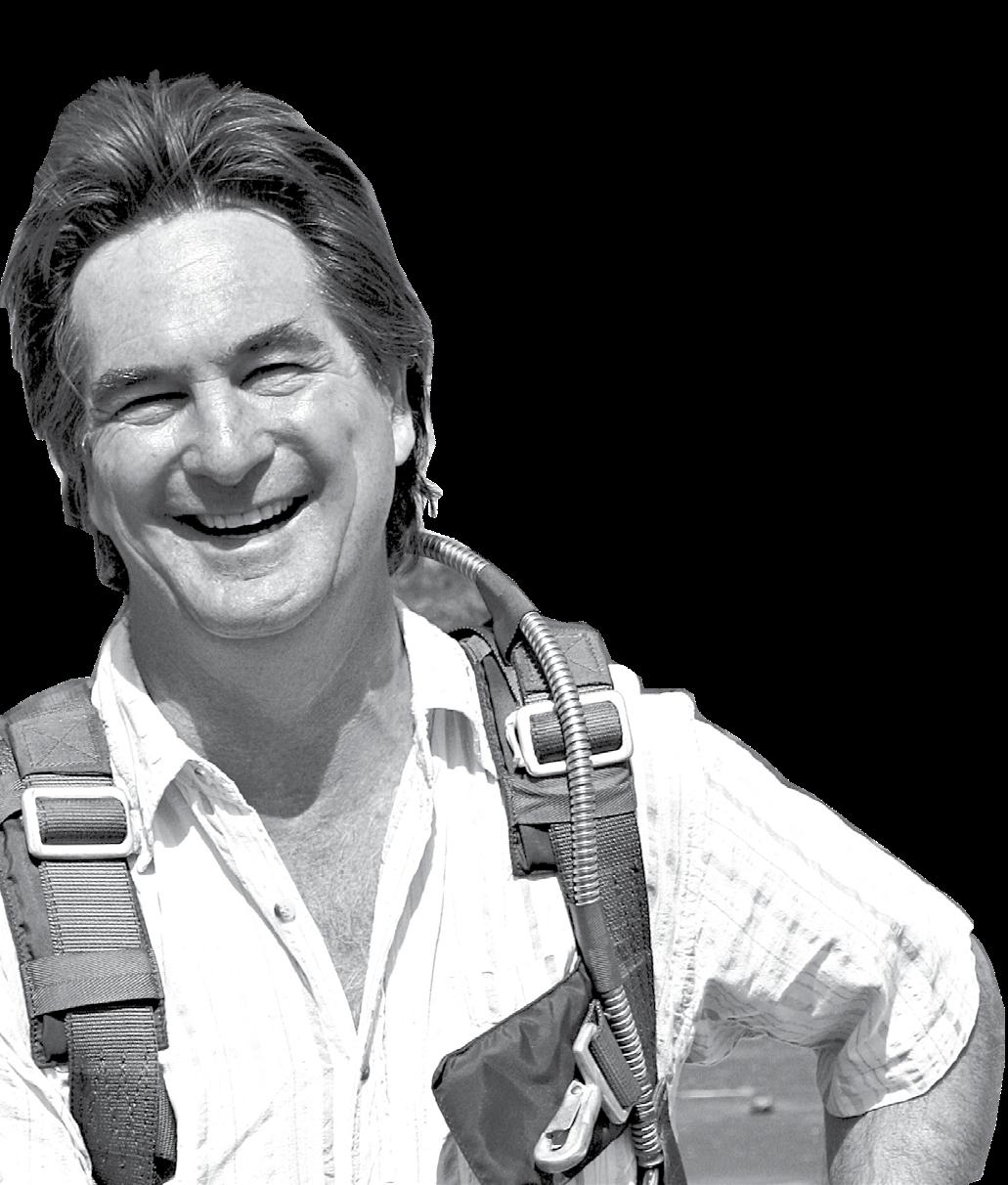
The South African government has come under fire for its unhelpful customs and visa regime. On the World Economic Forum’s Travel and Tourism Competitiveness Index, South Africa ranks in the bottom half for visa openness, (71/136) and 80/136 for cost competitiveness.
By definition, the flows of goods, people, investment and ideas that stimulate economic development must flow unimpeded to maximise their contribution to consumers and the wider economy. For this IATA measures how freely goods and people flow across borders.
Perhaps surprisingly, South Africa’s facilitation of air cargo through its customs and borders regulations ranks 41/124 countries in terms of the Air Trade Facilitation Index (ATFI) and 9/135 countries in terms of the eFreight Friendliness Index (EFFI) globally. The Enabling Trade Index (ETI) ranks South Africa 55/136 countries globally for the facilitation of the free flow of goods over borders and to its destination.
The most recent Oxford economics study was done before Covid-19 and it forecast that under the “current trends” scenario, the air transport market in South Africa would grow by 102% in the next 20 years. This would result in an additional 21.4 million passenger journeys by 2037. If met, this increased demand would support approximately US $19.1 billion of GDP and almost 797,410 jobs.
So the aviation industry is important – and these are just some of the facts that prove it.
j
Guy Leitch


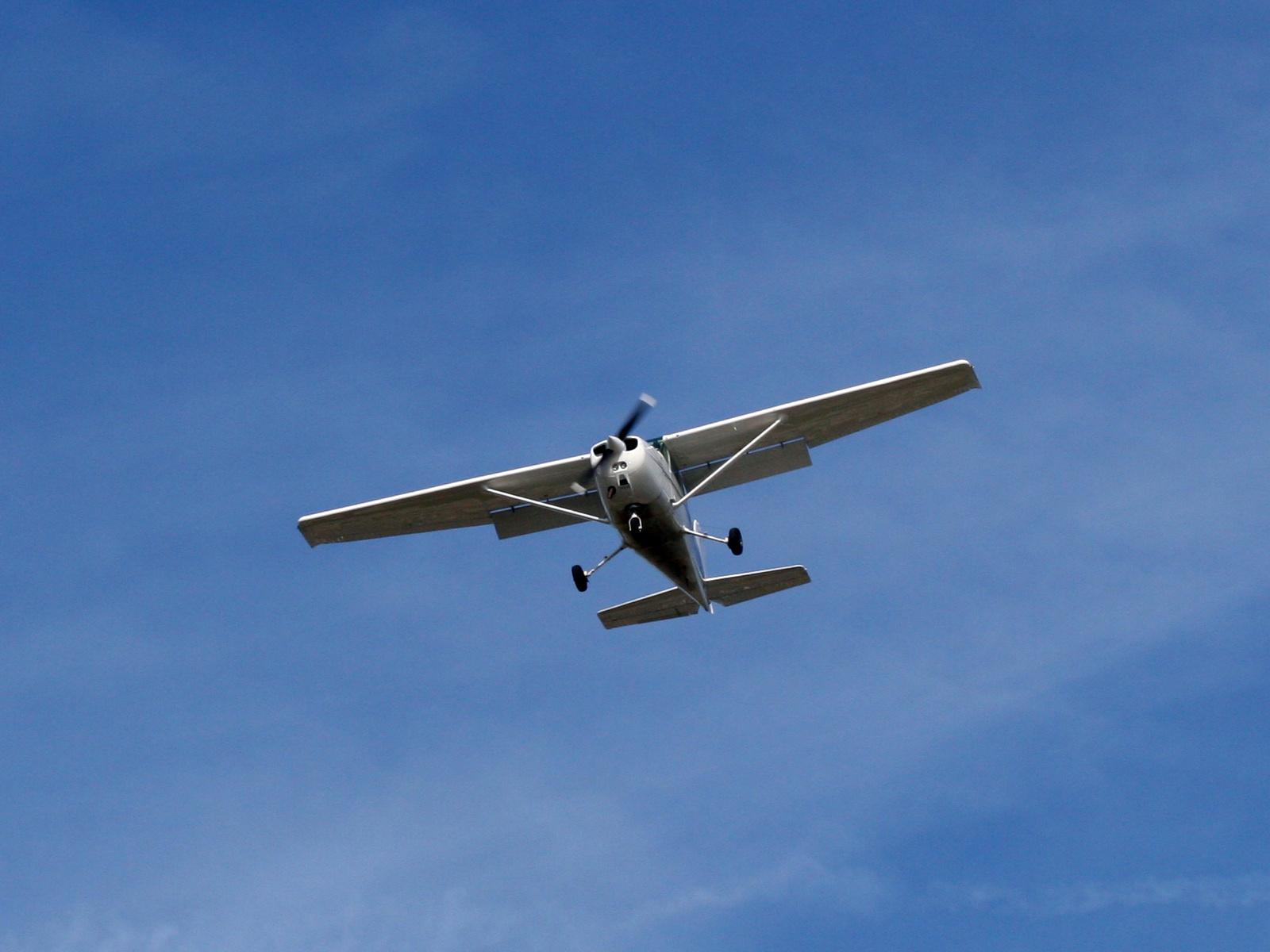
www.merchantwest.co.za Divisions in the Group are licensed and authorized FSPs OWN YOUR AIRCRAFT? LET US HELP YOU MAKE THOSE DOLLARS WORK HARDER FOR YOU.


COLUMNISTS FLIGHTCOM 04 Hugh Pryor - TELEPORTATION PT2 08 Laura McDermid - IRIS FLIES SUDAN Edition 338 FLIGHT TEST: FC 24 CONTENTS SAF 32 GULFSTREAM COMMANDER 1000 SA FLYER 12 Guy Leitch - THE FALL OF BOEING 18 Peter Garrison - LIFT UNEXPLAINED 22 Jim Davis - RIGHT SEAT RULES 17 44 Jim Davis - ACCIDENT REPORT 50 Morne Booij-Liewes- REGISTER REVIEW
SALES MANAGER
Howard Long sales@saflyermag.co.za 076 499 6358
TRAFFIC
Howard Long traffic.admin@saflyermag.co.za
ACCOUNTS
Angelique Joubert accounts@saflyermag.co.za
EDITOR
Guy Leitch guy@saflyermag.co.za
PUBLISHER
Guy Leitch guy@saflyermag.co.za
PRODUCTION & LAYOUT
Patrick Tillman www.imagenuity.co.za design@saflyermag.co.za
CONTRIBUTORS
Jim Davis
Peter Garrison
Hugh Pryor
CONTRIBUTORS CONTINUED
John Bassi
Morne Booij-Liewes
Laura McDermid
Darren Olivier
Jeffrey Kempston
ILLUSTRATIONS
Darren Edward O'Neil
Joe Pieterse
WEB MASTER
Emily Kinnear


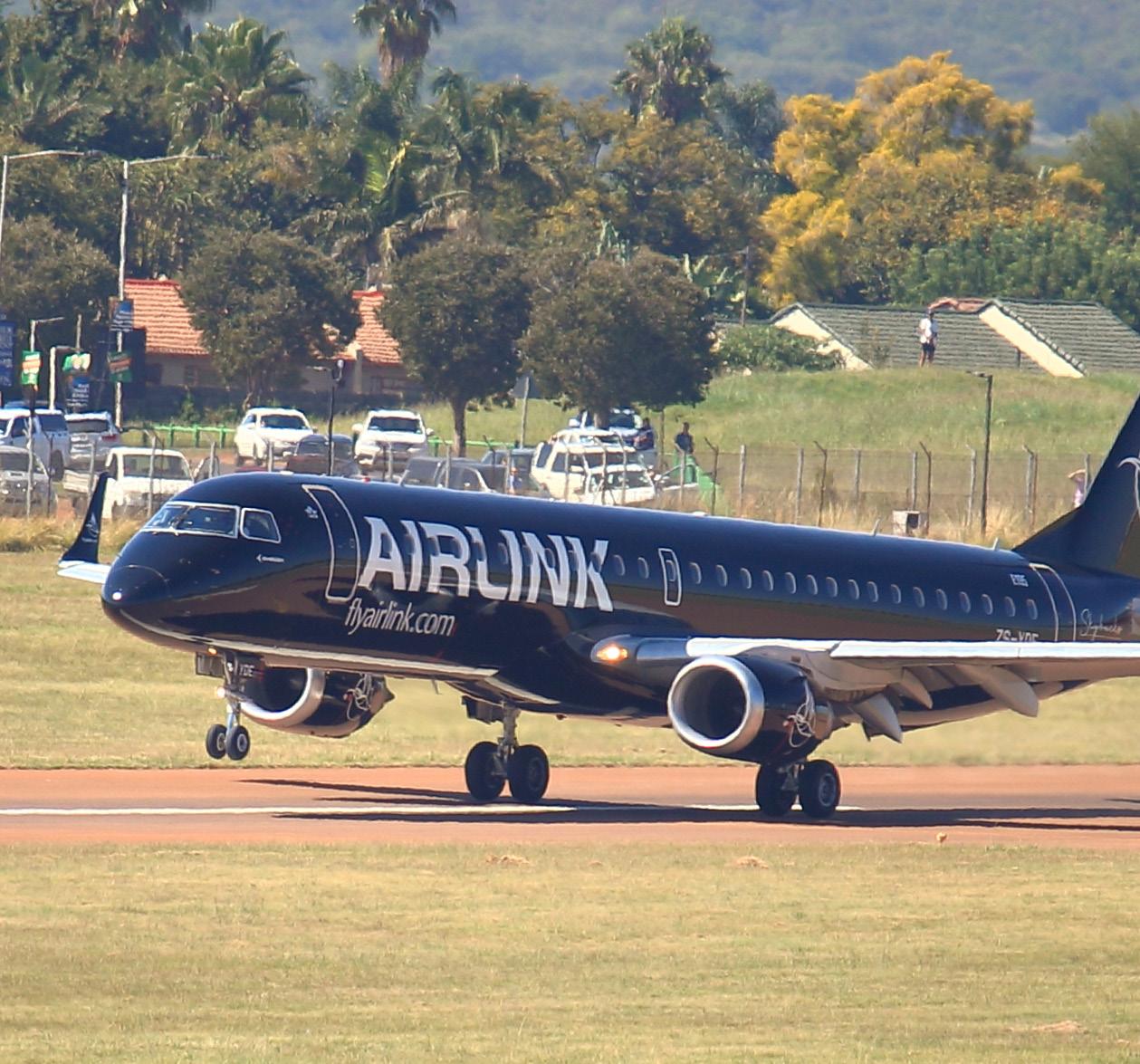
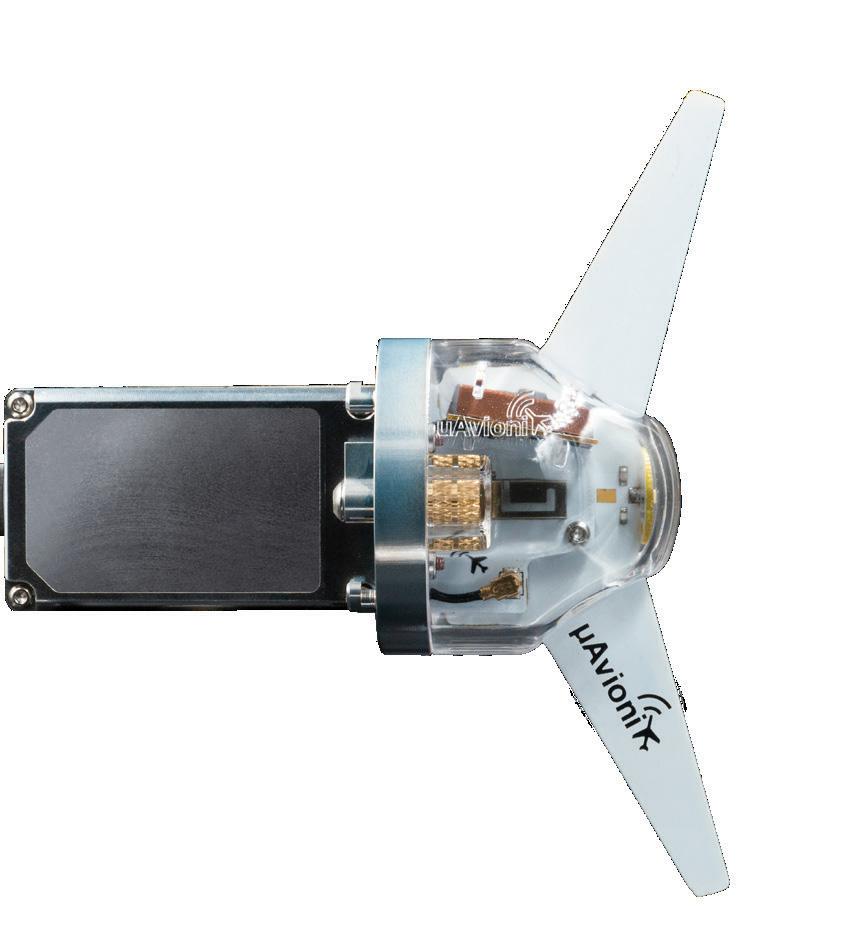
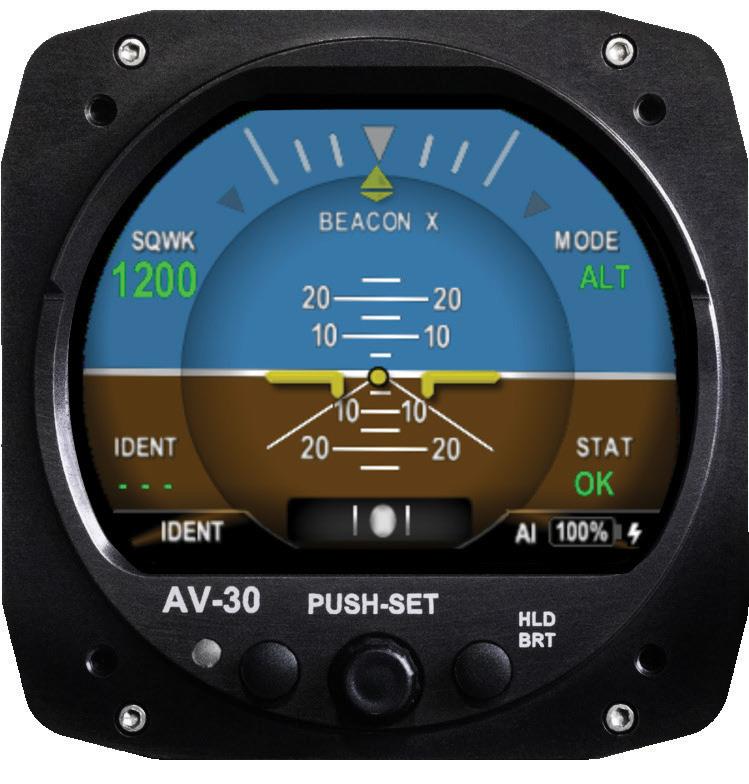
tailBeaconX panel display. With seamless integration, advanced features, and reliability at your fingertips, the destinations are uAvionix—your key to opening the skies.
CAA’S 25TH ANNIVERSARY SHOW
May 2024
LIMITLESS DESTINATIONS
© SA FLYER 2023. All rights reserved worldwide. No part of this publication may be reproduced, stored in a retrieval system, or transmitted by any means, electronically, mechanically, photocopied, recorded or otherwise without the express permission of the copyright holders.


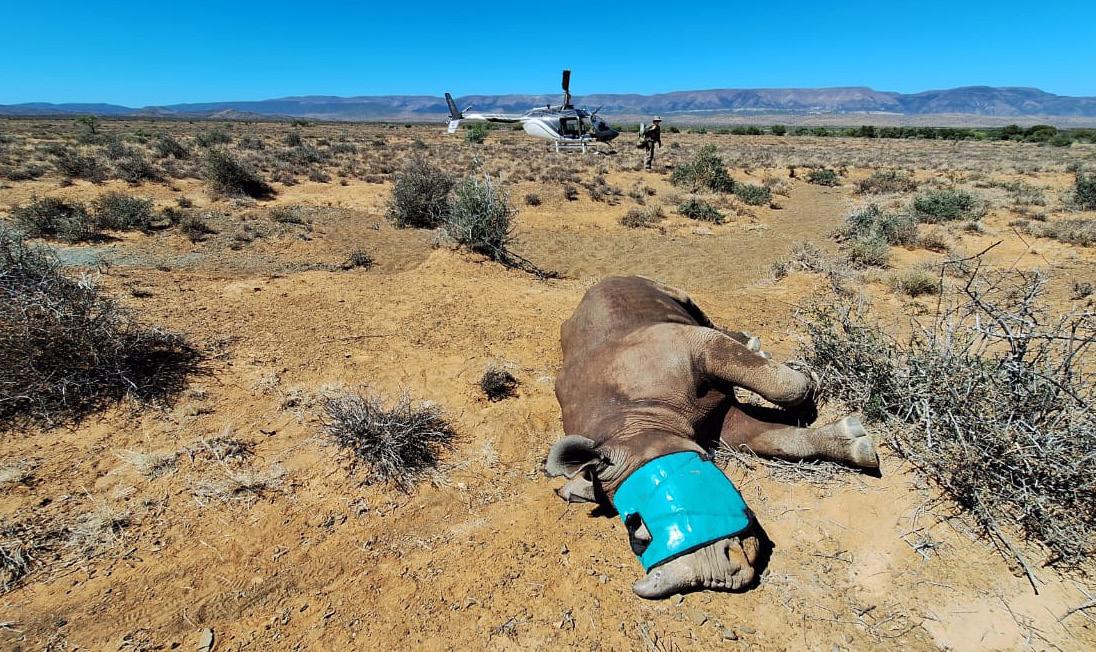
May 2024 8 10 Opening Shot 56 M & N Acoustic Register Review 60 Aero Engineering and Powerplant Aviation Fuel Table 84 Executive Aircraft Refurbishment Events Calender FLIGHTCOM 07 AME Directory 32 Superior Pilot Services: Flight School Directory 33 Merchant West Charter Directory 34 Skysource AMO Listing 36 Aviation Directory CONTENTS Edition 338 REGULARS FEATURES SA FLYER 32 FLIGHT TEST: GULFSTREAM COMMANDER 58 HELICOPTER SERVICES DIRECTORY 62 HISTORIC NEWS: HUMBLE BEGINNINGS 63 QUOTE OF THE MONTH 64 AERO FRIEDRICHSHAFEN 2024 – FULL REPORT 81 NEWS: ELECTRIC AIRCRAFT – NO LICENCE 82 NEWS: VANS AIRCRAFT - EMERGING FROM CH 11 85 REFURBISHMENT GUIDE FLIGHTCOM 12 News - SAA – Takatso deal investigation 13 News - Russian Tu-22M3 Backfire shot down 14 Jeffery Kempson - Okavango Dreaming Pt1 19 News - SITA Latest Airport Tool 20 John Bassi - When Things Fall Apart Pt1 24 CAA’s 25th Anniversary Airshow


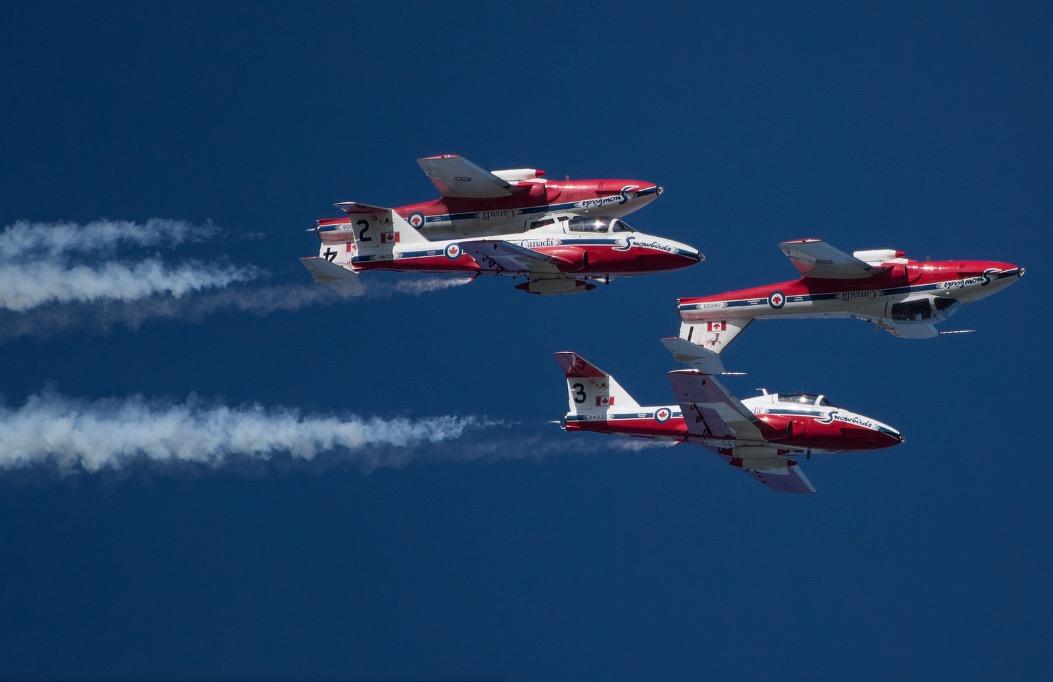



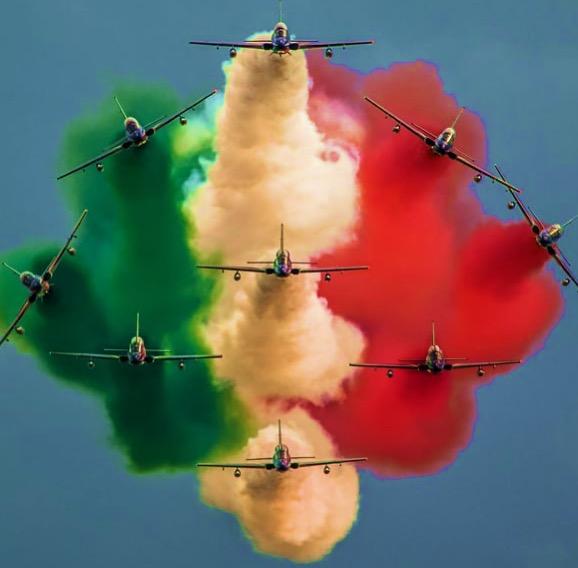

May 2024 9 Greatest Aviation Event! Oshkosh Neil +27 84 674 5674 info@airadventure.co.za www.airadventure.co.za Catered Camping on the Airfield, Tents and Bedding provided MORE INFO Flights from Cape Town & Johannesburg This Year! Canadian Snowbirds & Italian Tricolori Formation Teams

Airshows are an excellent opportunity for aviation photographers to capture striking images of aircraft in unusual positions. Simon McDonnell did just that with this beautifully panned, yet remarkably sharp, shot of Juba Joubert wowing the crowd in the Aloutte 3 he flew at the Stellenbosch Air Show.
The image is notable for its sharp subject matter despite the long 600 mm lens, and the slow shutter speed to get a dynamic blur. Simon used his Canon R6 mirrorless with a prime 600mm f/11 IS STM lens. Exposure is 1/50th second at f/11 with an ISO of 500.
May 2024 10
SIMON MCDONNELL

May 2024 11 Send your submissions to guy@saflyermag.co.za
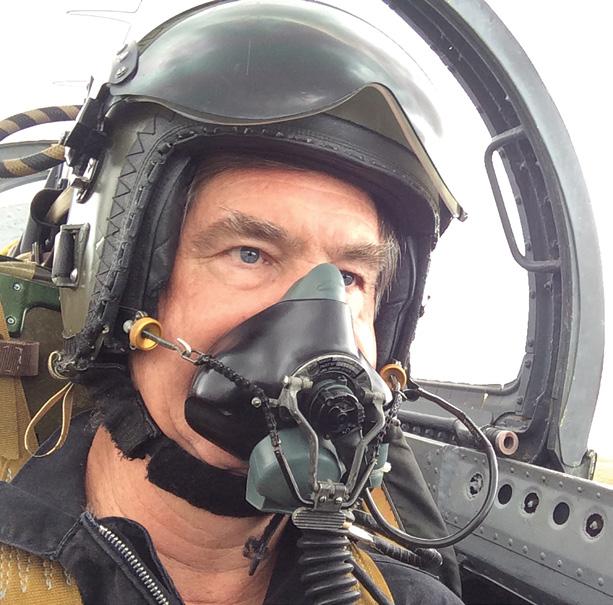
The fall –and fall and fall of Boeing
After the Boeing Max crashes, the chatterati were suddenly experts on MCAS. Now everyone is an expert on Boeing’s management problems. I have dug up what I trust are some fresh new insights.
LIKE MARY POPPINS, let’s start at the very beginning. Boeing was founded by William Boeing in 1916, and over the years, it became the paragon of American excellence, building air and space craft as diverse the first stage of the Saturn V rocket, and a long stream of excellent fighters.
The company’s success rests heavily on its reputation for excellence. That reputation for excellence was credited to the company’s engineercentred open culture. After noticing some shoddy workmanship, William Boeing famously said, that he would “close up shop rather than send out work of this kind.” Boeing had such a great reputation for safety there was a popular saying: “If it ain’t Boeing, I ain’t going.”
To take on the growing threat of Airbus, in 1997 Boeing did a reverse takeover of McDonnell Douglas to create the world’s largest aircraft manufacturer.
McDonnell Douglas, who were primarily known for military planes, had a crap reputation for commercial airliners – most notably the DC10, which killed over 1,100 passengers.
Airbus tried hard not to laugh.
After the takeover, McDonnell Douglas gave Boeing management a copy of an Economist magazine cover about the challenges of corporate mergers, which sounds sweet until you see that the cover had a picture of two camels humping. McDonnell Douglas bosses added the caption; “Who’s on top?”
In 1967, Boeing introduced the 737, and it has delivered over 11,000 of them. Boeing airliners dominated the market until Airbus overtook them in 2019. So how did they get so far from that culture today? There was a pivotal event.
John Oliver’s Last Week Tonight show reveals an even more cringeworthy development, Boeing’s then CEO Phil Condit pushed the big idea of “less family, more team.” The irony of Condit having married his first cousin Jan Condit was seemingly lost on him – but not the market.
May 2024 12
ATTITUDE FOR ALTITUDE: GUY LEITCH
The merger is blamed for a profound culture change. A year after the merger, Boeing announced a stock buyback, taking company money that should have gone to making better planes, and using it to inflate the stock price. A huge campaign called Share Value was launched. The idea was that they wanted everybody to work together to increase the stock price.
Even technical meetings revolved around the Boeing stock price. And in retrospect this was not reassuring because no one wants to get on a plane and hear, “This is your captain speaking. We had a few technical problems, but our maintenance crew’s assured us that the stock price is still holding strong. So let’s get these million rivets airborne and all flying in tight formation.”
The share price culture change was solidified by the decision to relocate the corporate headquarters from Seattle — where the planes were actually designed and built — 2,000 miles to Chicago. Management were saying that they don’t want to be bothered by engineers.
The problems with the “stock price-first” approach became apparent during the production of the radically new composite 787 Dreamliner, which Boeing had announced in 2004. Despite the 787’s pioneering of composite construction, Boeing slashed the R&D budget as the company continued with large stock buybacks and dividends.
Boeing also outsourced production to about 50 suppliers, each of whom was responsible for managing its own subcontractors. So the plan was for Boeing to assemble components other people made – for the cheapest price.
Years later, Boeing admitted that had been a fiasco. Executing a supply chain of such complexity proved to be more than some suppliers could handle. Problems were legion. The huge fuselage barrels did not fit together. Fasteners were incorrectly used. There were gaps between components. Airbus tried hard not to laugh.
MacDonnel Douglas sent this cover to Boeing with the question - who is on top?

Phil Conduit had been busted for a dodgy deal, and his successor, Harry Stonecipher, was forced to resign after an affair with a Boeing VP – so he was also keeping it in the family. In echoes of SAA, Boeing got its third CEO in as many years: Jim McNerney, who accelerated the cost-cutting.
Despite all the outsourcing difficulties, in 2007 Boeing rolled out the 787 on time in an elaborate ceremony – except it wasn’t real. A reporter wrote, “… in rolls this beautiful, beautiful aircraft. And then we discovered that the whole thing was made out of plywood and lies!
The plane was supposed to take its first test flight within two months of that launch, but unsurprisingly, that didn’t happen. In fact, the 787 was three years late and $25 billion over budget. And almost immediately, there were big problems. Two 787s had fires on board, within nine days of each other, attributed to a defective Lithium battery, made by a subcontractor that Boeing had never audited.
May 2024 13
Boeing's reign of CEOs and the share price.

So the FAA grounded the 787 — the first time it had grounded a whole type since the DC10 in 1979, making it clear that the wrong attitudes had prevailed after the merger. Basically, the wrong camel came out on top.
While the 787 had its problems, Airbus, was unveiling the A320neo, which was a huge sales success. Boeing was caught sleeping, so it scrambled to announce a plane it hadn’t even engineered yet, the 737 Max.
They had to get it into production as fast and as cheaply as possible. Sales for the promised plane were strong and Boeing made grand predictions about ramping up production to 57 new planes a month. They still have a backlog of no less than 7,000 Maxes to deliver.
The catchphrase, “more for less,” became the company’s theme. And still, Boeing’s board signed off on yet more large stock buybacks. From 2014 to 2018, Boeing diverted 92% of its operating cash flow to dividends and share buybacks to benefit investors, far exceeding the money it spent on R&D for new planes.
The Max was rushed through design and production, with tragic consequences. Workers
on the production line for the Max describe a process that valued speed over quality.
The big question then becomes – where was the FAA? As the regulator of safety standards, why didn’t the FAA catch this before 346 people died?”
The answer is that unbelievably, for fifty years, Boeing was allowed to use FAA designated inspectors – who were employed by Boeing. That’s a somewhat large conflict of interest.
The FAA’s excuse was that it had to rely on Boeing to vouch for the Max’s safety, because they lacked the knowledge and skills to evaluate what was going on. A Boeing employee said a presentation to the regulators was; “like dogs watching TV,” because they didn’t understand what they were seeing.
So Boeing was paying Boeing employees to regulate Boeing. And this self-regulation was increasd from 2005, after Boeing successfully lobbied to reduce government oversight.
Unsurprisingly, several of these Boeingemployed “representatives of the FAA” have admitted that they faced heavy pressure from
May 2024 14
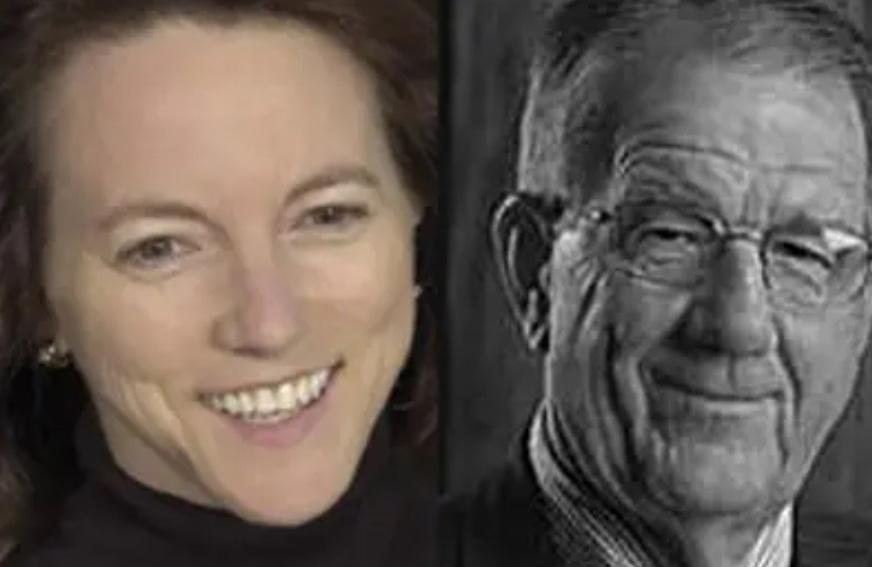
managers to limit safety analysis and testing, so the company could meet its schedule and keep costs down. At every point along the production process, the FAA either delegated responsibility to Boeing, or gave them the benefit of the doubt.
So, what now? Well, Boeing’s not going out of business anytime soon. It’s half of the happy A&B duopoly of the two major commercial airliner manufacturers. So we, the passengers, need them to survive – and get better.
Four years after the 737 Max crashes and now the Alaska door plug, plus a plethora of problems with the 787 and 777X the key question is still — can Boeing change?
Well, thanks in part to pressure from the families who lost loved ones in those crashes, congress has passed bipartisan legislation rolling back much of Boeing’s ability to oversee its own work. And it’s encouraging that the FAA is now insisting Boeing come up with a plan to address safety in 90 days — although we’ll see what that brings.
Whistle-blowers have repeatedly said Boeing won’t change until it has new leadership. The toll on whistle-blowers has been huge, so much so, that John Barnett blew his brains out. Boeing has much lost ground to recover so, to show how serious it is CEO, Dave Calhoun and other senior C-suite execs have been shown the door.
Meanwhile every media platform sees Boeing as a free hit. Even the smallest incident gets headlines. Boeing’s incoming management is going to have to go on a major charm offensive to convince the world that their planes are indeed safe.
And they need to come up with two all-new planes – a ‘middle of the market’ to replace the 757 and take on the A321, and a replacement for the 737. But right now the once proud plane maker is too weak to even try fund the massive cost of new designs – especially if they are to be done properly. j
guy@saflyermag.co.za

May 2024 15
Boeing CEO Harry Stonecipher had a disasterous affair with his Operations VP Debra Peabody.
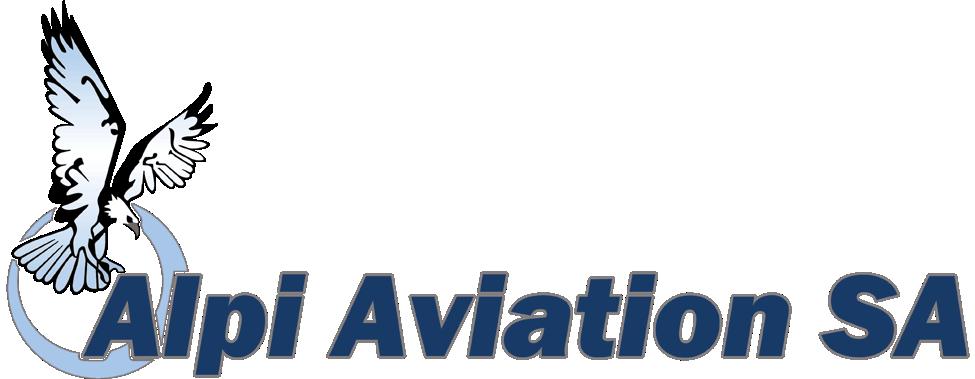
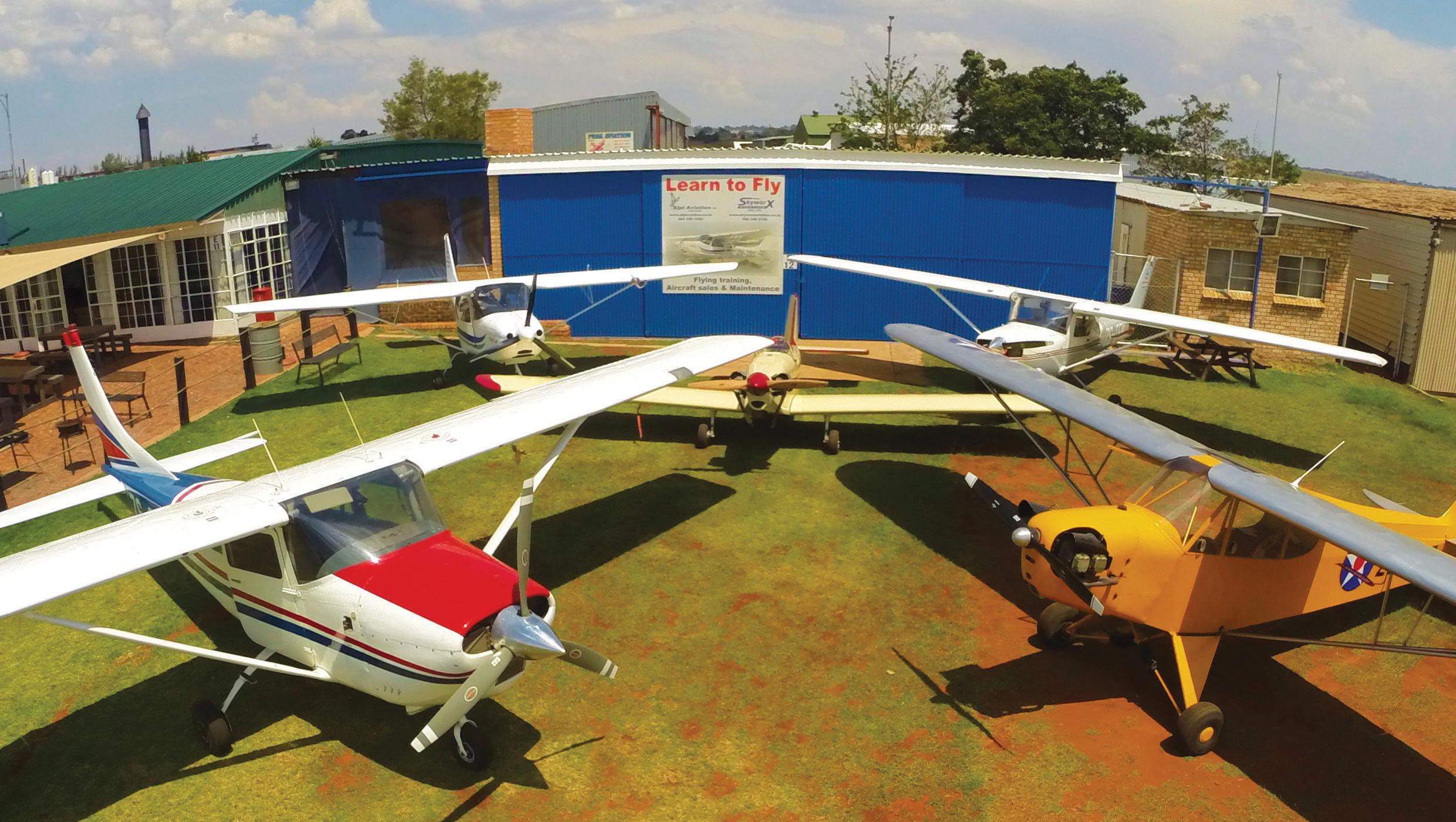

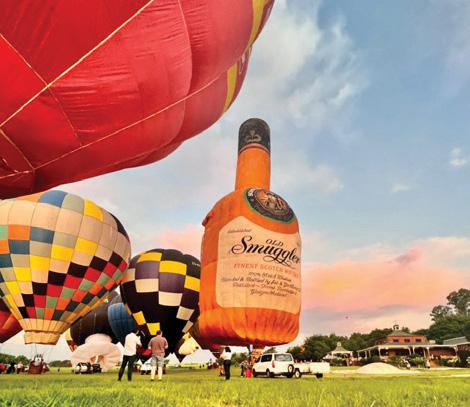

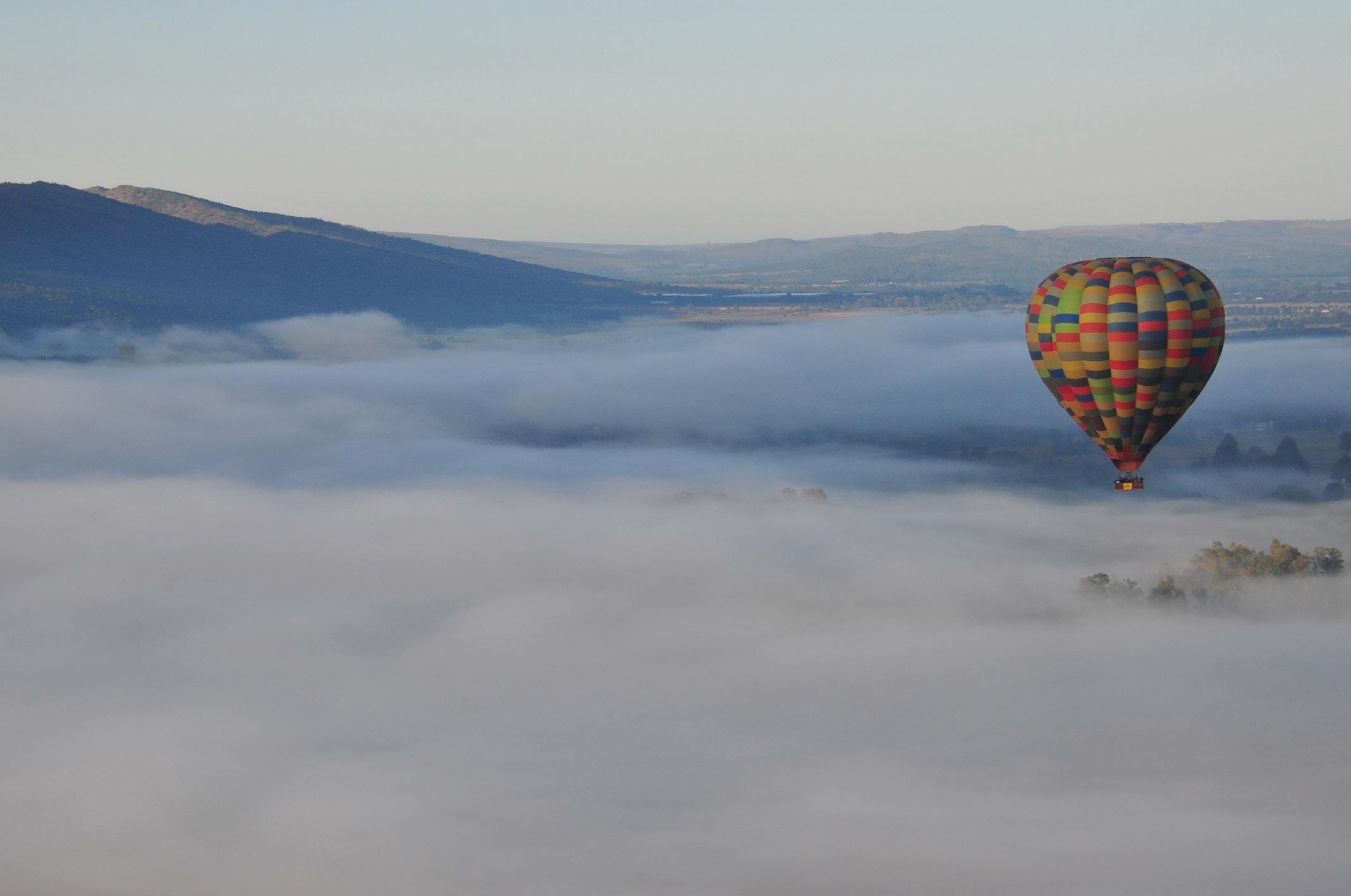
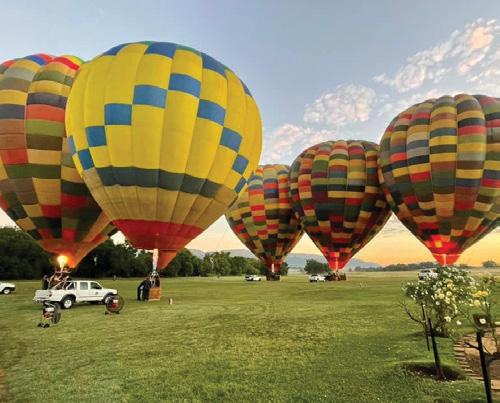
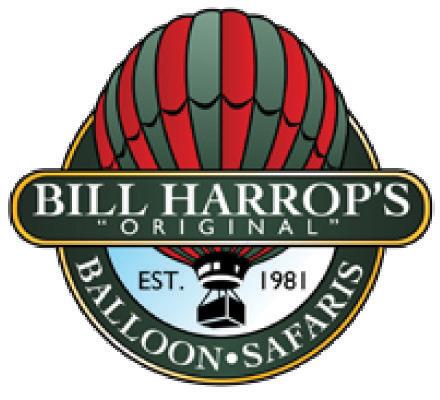
May 2024 16 WE NOW OFFER TAILWHEEL TRAINING www.alpiaviation.co.za Dale de Klerk Cell: +27825563592 Fax: 0866058948 Skype: dale_de_klerk Email: dale@alpiaviation.co.za FROM NPL THROUGH TO CPL LEARN TO FLY WITH US Bill Harrop’s ‘Original’ Balloon Safaris +27 83 457 3402 or +27 83 443 2661 / 2 • email: website@balloon.co.za • www.balloon.co.za Learn to Fly with Us • Magalies River Valley Scenic Balloon Safaris • Game viewing Balloon Safaris at Mabula Private Game Reserve • Private Balloons and Groups Rates • Team Building and Product Launches • We fly from the beautiful Magalies River Valley just west of Hartbeespoort Do it in style!
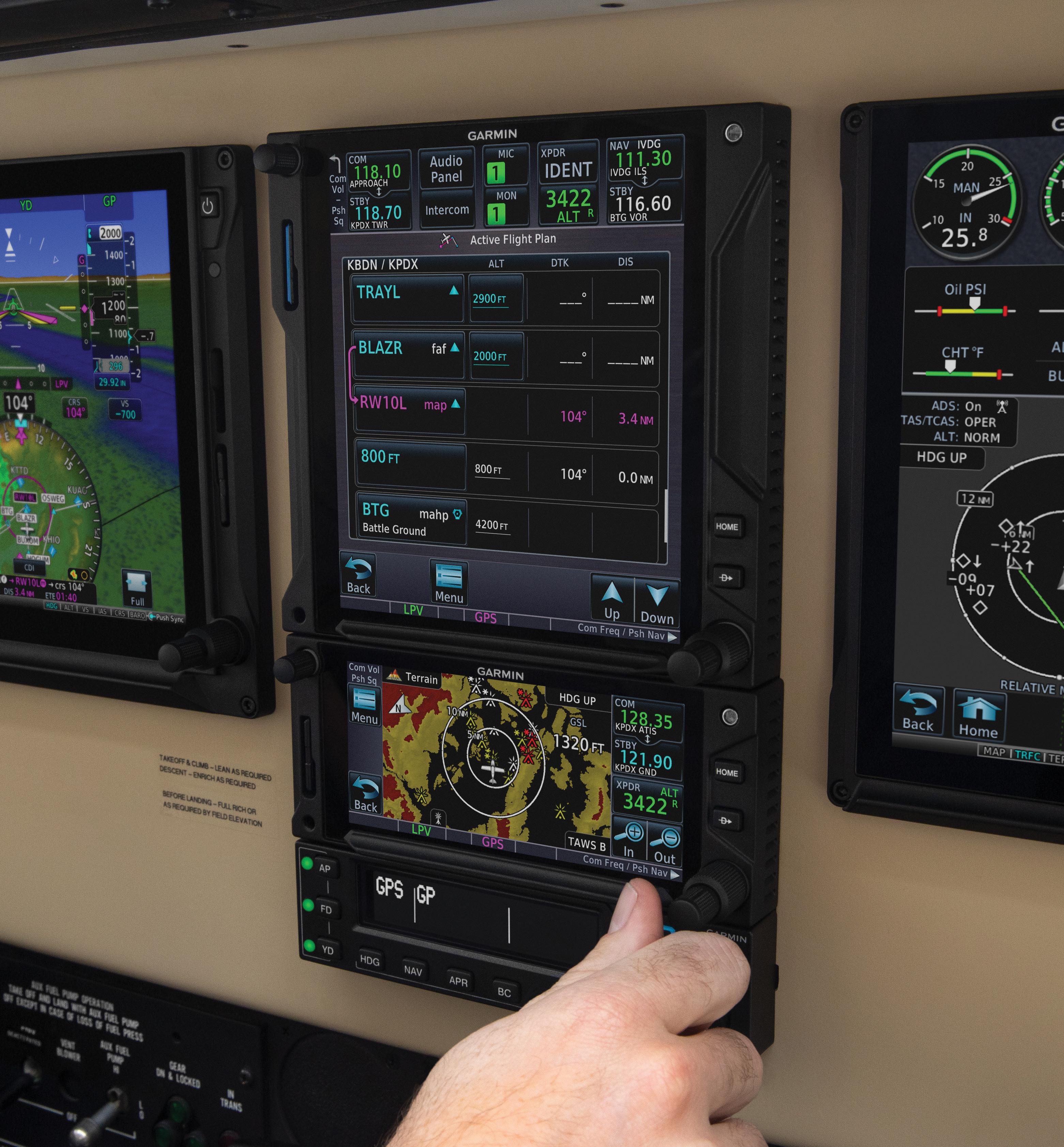
May 2024 17 YOUR AIRPLANE. READY FOR THE FUTURE. 1Additional hardware equired; sold separately. 2With select makes/models; visit Garmin.com/autopilots for more details. © 2023 Garmin Ltd. or its subsidiaries. HIGH-RESOLUTION TOUCHSCREEN DISPLAYS INTERFACES WITH POPULAR NEW AND EXISTING AVIONICS OPTIONAL ENGINE INDICATIONS WITH DATA LOGGING EASY UPGRADE TO YOUR PANEL COUPLE WITH GFC™ SERIES AUTOPILOT2 EFB FLIGHT PLAN SYNC1 GTN™ Xi NAVIGATORS AND TXi FLIGHT DISPLAYS TO LEARN MORE, VISIT GARMIN.COM/AVIATION

An explanation is a collage in which bits and pieces of the familiar combine to make an image of the unfamiliar. The more obscure the thing being explained, the more numerous and remote the elements that comprise the explanation. It’s a wonder we understand anything at all.
I SUPPOSE THAT GALE CRAIG, a retired General Motors researcher and engineer, wrote his little book with the indignant title “Stop Abusing Bernoulli!” in the hope that he might, once and for all, dispose of the perennial question, “How do wings produce lift?” If so, he failed, not because of any fault in his own argument, but because the mechanisms involved are sufficiently obscure and remote from everyday experience to defy simple explanation.
All that a pilot really needs to know about lift can be learned by sticking a hand out the window of a moving car. Clambering up to the next level of insight – the one to which Craig hopes to guide us – requires an agility most of us lack, and climbing shoes that we have worn out or lost.
LIFT UNEXPLAINED answers can be concocted
bits of air that part company at the leading edge must, like star-crossed lovers, be reunited at the trailing edge, air passing over the wing’s upper surface must move faster than that passing below the wing.
At this point Daniel Bernoulli (Swiss mathematician and physicist, 1700-1782) is brought in as an expert witness. It was he who first derived, from first principles, the conclusion that as flow through a duct accelerates, pressure within the duct must diminish in proportion to the square of the flow velocity. Applying this principle to wings, the pressure on the upper surface must be less than that on the lower. Ergo, the wing lifts.
The customary explanation for the production of lift, which Craig contemptuously dubs “hump theory”, has air moving a longer distance over the top of an aerofoil than over the bottom, because of the aerofoil’s camber. Since it is assumed, without evidence, that neighbouring
In every ground school class, however, there is one pest who raises a hand to inquire how aeroplanes manage to fly upside down, or how aeroplanes with uncambered wings (like many competition acrobatic aeroplanes) or with perfectly flat wings (like paper or balsa gliders) manage to fly at all.
May 2024 18
PETER GARRISON
More inventive sceptics might ask why making the upper surface of the wing wavy would not further increase the transit distance, and therefore the flow velocity and the lift. And diehard agnostics will wonder who it was, exactly, who decreed that the particles of air that pass over the top of the wing have to arrive at the trailing edge at the same time as those that go underneath. (Actually, they don’t – they get there sooner.)
Makeshift answers to all these questions can be concocted, but the truth is that the patented, FAA-approved Bernoulli explanation is just no good. It’s not false – pressure and velocity really are related in the way Bernoulli described, and the variations can be precisely measured on the surface of a wing – but, as Wolfgang Langewiesche put it in his 1944 classic Stick and Rudder, “the explanation is more puzzling than the puzzle!”
Although Craig is not alone in having pointed out the inadequacy of the Bernoulli explanation of lift, it continues to be offered to high school students, would-be pilots, and lay readers aspiring to understand physics. Worse, it is the orthodoxy espoused by the FAA, and so in order to get certain test questions right you have to parrot the Bernoulli explanation. Ironically, Daniel Bernoulli himself would undoubtedly object to his pressure-velocity relation being passed off as the “cause” of wing lift; but dust has stopp’d his mouth.
For the more scientifically sophisticated among his readers, Craig also takes on what he calls the “induction” theory of lift. This is also known as the “circulation” theory, and it is less an explanation than a mathematical convenience. Craig criticises the induction theory as resting upon a useful but incomplete analogy between fluid dynamics and certain electromagnetic phenomena; like “hump theory,” he says, induction theory fails to account for several commonly observed phenomena.
Daniel Bernoulli's theorem is still the required explanation for lift.
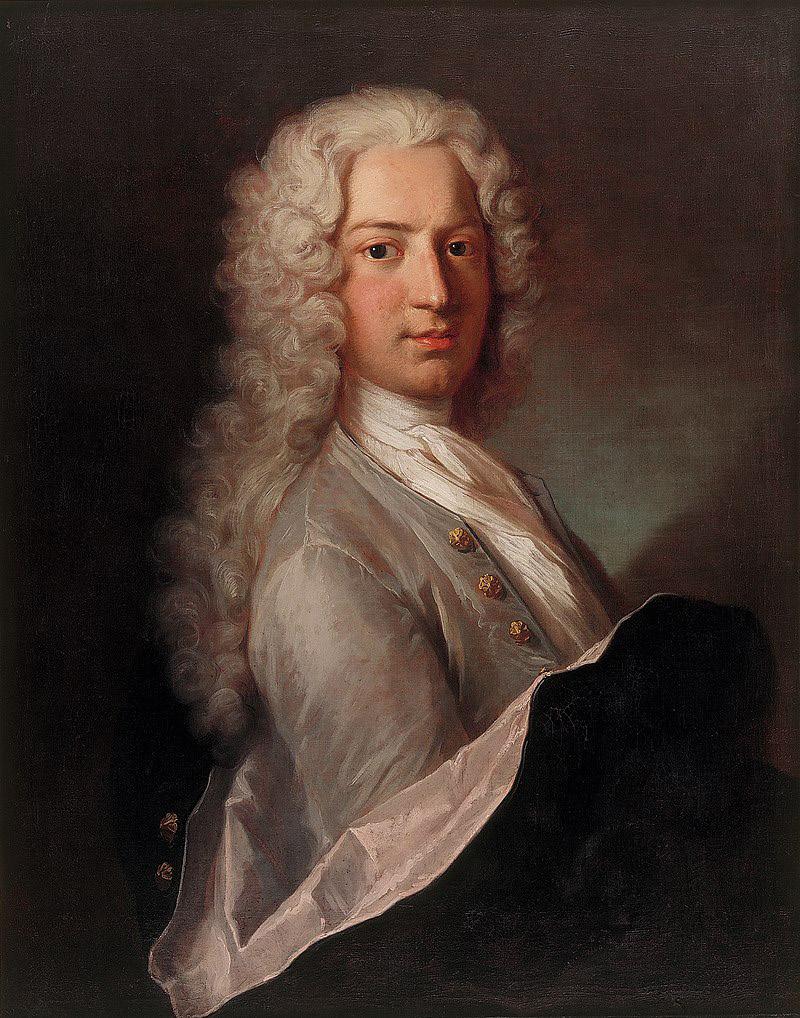
If Craig had his way, we would explain lift by purely Newtonian principles of action and reaction. The lift is the equal and opposite reaction to the force exerted by the wing to accelerate air downward. This is what you experience when you fly your hand out the car window, and it is what we intuitively sense is happening when a plane surface moves through air at a slight positive angle.
more puzzling than the puzzle!
If lift could be adequately accounted for by Newtonian principles, however, one would have to wonder why Newton himself could not correctly predict the lift of a flat plate. He tried to, and came up with a formula that grossly underestimated lift and, some say, retarded, by its pessimism and his own godlike authority, the attainment of manned flight. Actually, it’s doubtful that Newton’s sine-squared law had any such effect, since aeronautical experimenters have tended to be practical rather than theoretical sorts, and the fallacy of Newton’s conclusion can be readily demonstrated by the simple
May 2024 19
experiment of going out on a windy day with an umbrella.
Newton got it wrong, Craig says, because he failed to take into account several different factors that enter into the production of lift. One of these is “flow attachment.” Without this tendency of fluids to follow surfaces over which they are flowing, air might simply peel away from the leading edges of wings, lift would be reduced to the magnitudes predicted by Newton, and we would still be taking the train.
explaining it, one is left reflecting that the virtue of hump theory, whatever its faults, is that it can at least be stated in a single sentence.
Having begun this article with a lecture on explanation, I would like to end it in the same way – this being a common writer’s trick to neatly tie up a package of loosely related ramblings.
it is the orthodoxy espoused by the FAA
Unfortunately, after disposing of hump theory and induction theory, Craig finds that his own account, which he styles “recirculation theory,” is actually quite complicated. It involves a good many separate phenomena, and by the time he has finished
We frequently overlook the fact that our understanding of things goes only to a certain point, and that by tacit agreement we do not look any further. For example, all discussions of lift, including Craig’s, contain mention of the word “pressure.” We all know what pressure means, because we have exerted pressure on things and had it exerted on our own skin. If we have read popular scientific texts we know that the pressure of air arises from the impacts of

An image like this does not give any idea of how much space there is between atoms.
May 2024 20
Theory vs Praxis - You can feel lift by putting your hand out a moving car window.

air molecules on a surface in the course of their random flights (which, by the way, occur, on average, at the speed of sound). The surface of a wing is also a network of molecules, but unlike those of a fluid they are held in place, vibrating but not, by and large, escaping. But what is a surface, really, and what are these molecules? They aren’t baseballs. They are strange, almost immaterial things.
If we could shrink ourselves to atomic dimensions (while acquiring a suitable new sensory apparatus), we would find a very unfamiliar world indeed.
For one thing, it would be largely empty. An atom is to an apple as an apple is to the Earth. Atoms themselves, however, are not closelypacked solids. They consist of a tiny nucleus whose radius is only one ten-thousandth of that of the weird, indescribable, but decidedly un-matter-like electron cloud surrounding it. In this world, mass is unrelated to size. Matter is
mostly empty space, like the universe itself, and so the collisions that produce pressure are really advances and retreats of fields of force, similar to magnetic or gravitational fields.
An aeroplane is “really” a cloud of forces barely differentiable from the surrounding electromagnetic haze. In this alien world, which is arguably the most “real” world we can try to imagine, our common ideas of weight, pressure, solidity and flow mean nothing, and the terms we use to “explain” phenomena like lift turn out to be just as mystifying and incomprehensible as the things themselves.
And that is why, when it comes to understanding lift, feeling your hand respond to the wind can be just as good as reading a book. j
May 2024 21
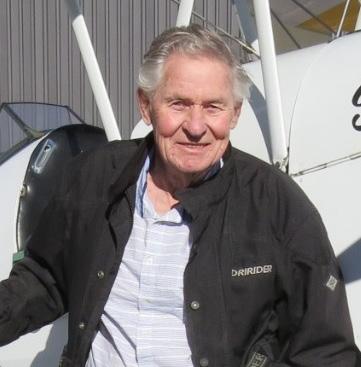
RIGHT SEAT RULES NO. 17
FIGHTING FUEL FOOLERY
This was meant to be the last of four articles persuading instructors, and everyone else, that they will have a longer and happier life if they understand this 20 point outline of the fuel system.
BUT IT’S NOT THE LAST ONE.
I underestimated how much more there was to be said about a system that’s just waiting to betray ignorant or unwary instructors and pilots.
We are making progress, but it’s taken four articles and 10,000 words (that’s like a young Wilber Smith novel) to get us about three quarters of the way to a place of comfort.
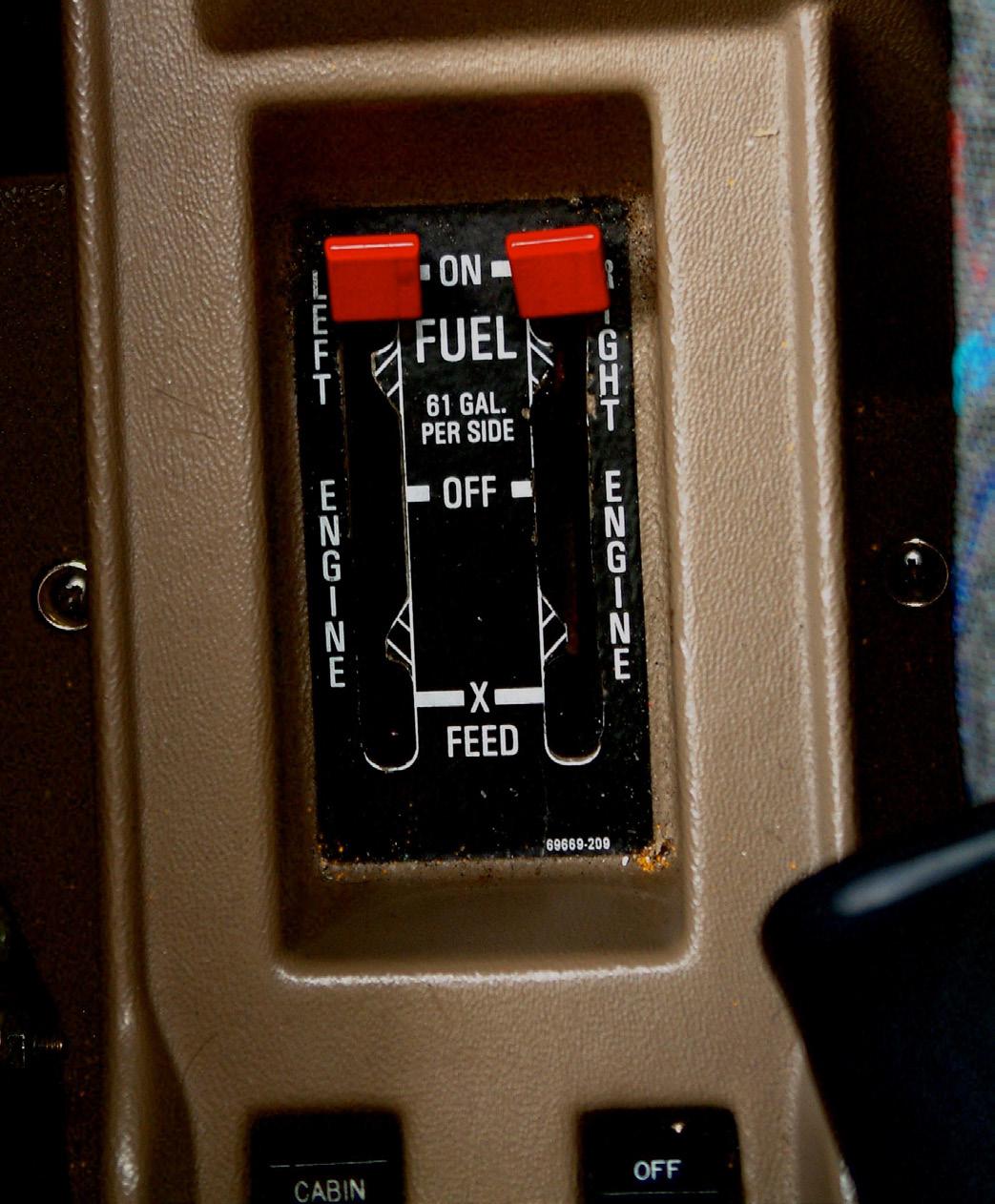
Would you trust a doctor who doesn’t understand your blood system, or an electrician who is vague about wiring, or a neurologist who is puzzled by your nervous system? Okay, so the same applies to pilots and fuel systems.
If a pilot only understands one thing about the machinery under his command, let it be the fuel system.
And you, budding instructors, are the ones to bring this about. It’s your job to make it interesting and memorable by involving your pupes in a tour through the labyrinth of pipes and wires and valves and drains and taps that will keep the engine running and everyone smiling.
12 The fuel selector
I was looking at an accident report the other day where a 20 year old commercial pilot lost both engines in a Seneca soon after takeoff. Why? Because both selectors were in the OFF position.
Silly bugger you might say. Well, yes and no. Yes, he was vastly overconfident for one with so little time on the aircraft. If he wasn’t sure where the selectors should be, he could have looked in
May 2024 22 PLANE TALK - JIM DAVIS
A young pilot did not know where Off was on a Seneca fuel selector.
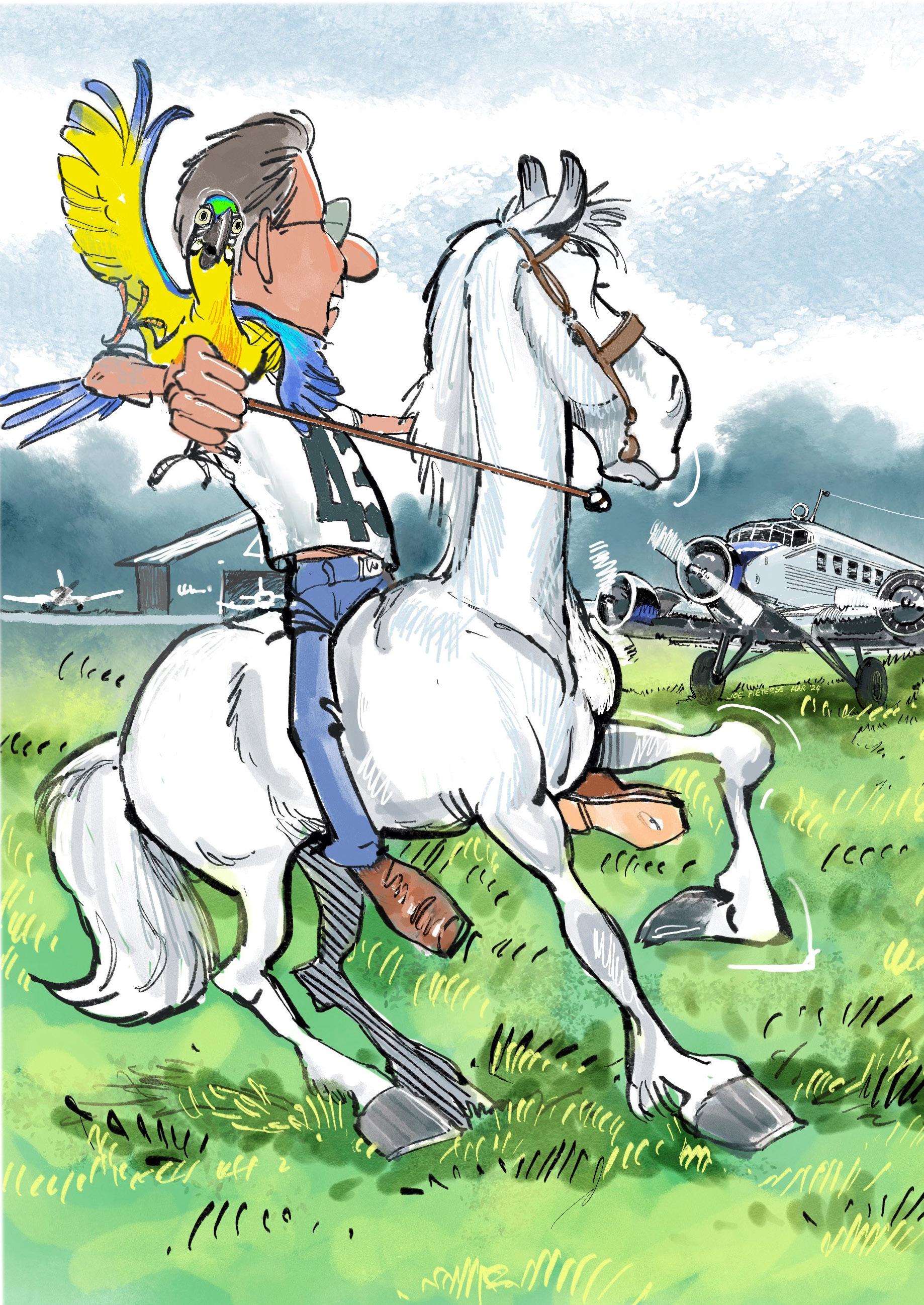
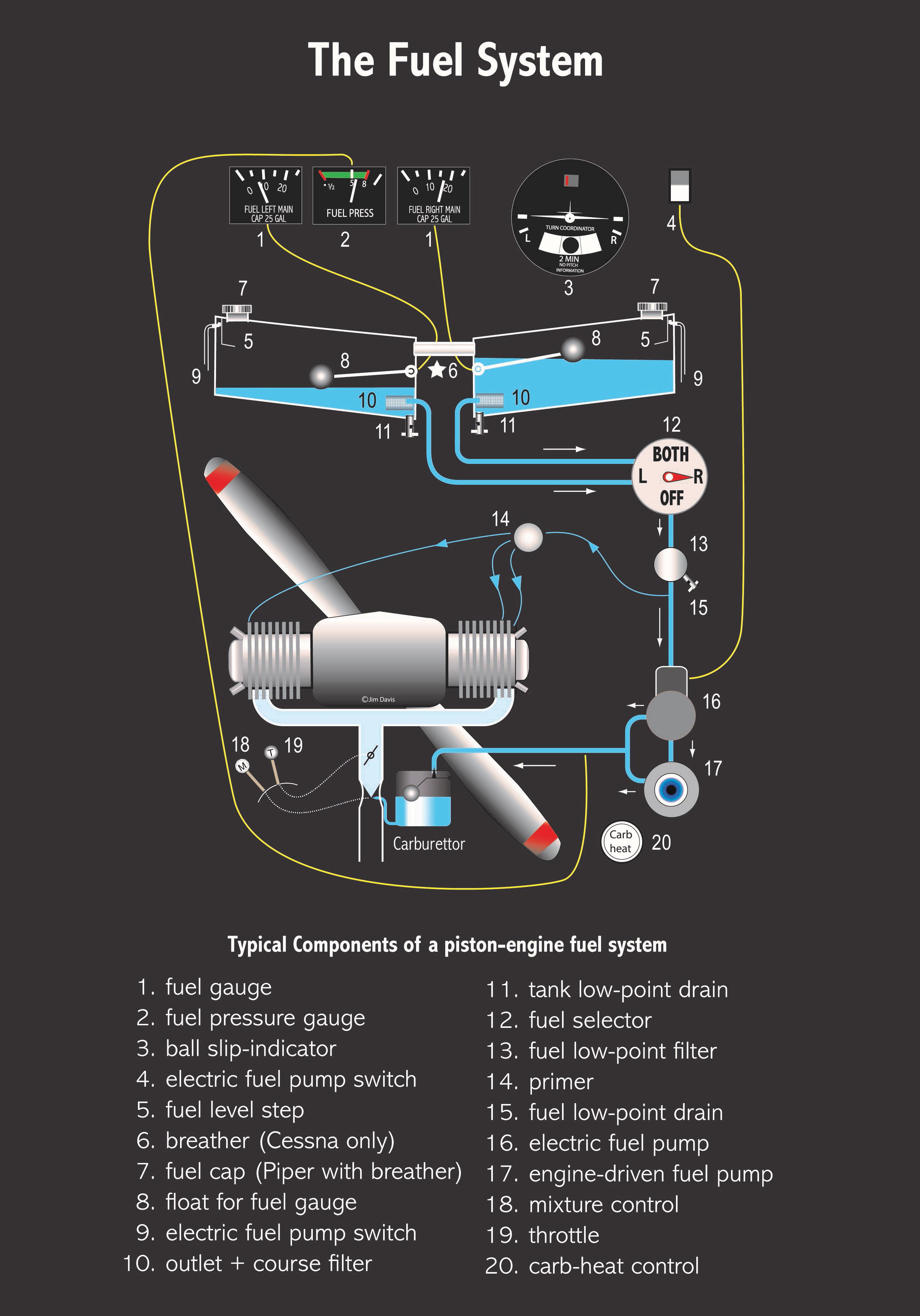
May 2024 24
typical single engine fuel system schematic.
A
The Cessna 150 has a confusing selector because of the way it is mounted.

the POH. Particularly as the decal showing the OFF, ON and X-FEED positions was missing.
So he bet his life on guessing – and got it wrong. Fortunately the goddess who looks after old ladies, little lambs and student pilots extended her benevolence to this young man. She merely waved a finger in his face and said, “you’re living on borrowed time, my boy.”
The moral of the story is that you must think very carefully before doing anything with the fuel selector.
And then there are fuel selectors that don’t get serviced because they are difficult to get at. Eventually they are so worn and gunged up that you can’t feel the detent positions. Again, an aircraft like that is unserviceable.
There is also the fuel selector that’s so stiff that forcing it eventually breaks or bends part of the mechanism and it fails to select what you think you have selected. There was a Tecnam 2006P that crashed on the reef a while ago because of this.
Always be very clear about who is flying
If the decal showing the various positions is missing, then the aircraft is unserviceable.
And how about the plate in the C150 and 152s, which is meant to show the OFF and ON positions? The plate sits flat on the floor but it’s trying to tell you what to do with a lever which rotates in a perpendicular plane to the floor. It always puzzles me.
Wilber Smith would be jealous of my literary output if I were to write a book called One Hundred True Stories About Fuel Selector Stuff-ups (abridged version).
Seriously – if there is one control in the whole aeroplane that screams, stop and think, and note the time, before you touch me, it’s the fuel selector.
And now here’s something more to think about.
May 2024 25
Why do so many pilots switch the fuel off after flight?
As an instructor I have always taught pupils to do that – not because I particularly want to isolate the engine from the tanks, but because I want the next pupil to develop a lifetime habit of switching the fuel on before he tries to start the engine.
I’m still not sure why other people do it. I guess the main reason for having an OFF position is in case of fire, but perhaps there are other reasons. Certainly a high-wing, normallyaspirated aircraft may leak fuel from the float chamber – perhaps that’s good enough reason to make a habit of turning it off.
Now I’m going to stick my neck out. About six months ago two guys, Richard McSpadden (5000 hours) who was the much-respected senior vice president of the AOPA Air Safety Institute, and Russ Francis (9000 hours) were flying a Cessna 177 RG when it crashed soon
after takeoff, killing them both. The NTSB Preliminary Report says that the engine stopped while they were taxying out at Lake Placid. Quote:
There were several witnesses to the event. One told investigators that when the accident airplane pulled up next to the Beech A36 on the ground, that the accident airplane’s engine then shut off, and about 10 seconds later, the engine restarted.
No, it wasn’t carb icing – the aircraft has a fuel injected engine.
If the engine stops, for no apparent reason, while you are taxying, are you simply going to restart it and carry on with your flight if you don’t know why it stopped?
Of course you’re not, but you can see where I am going with this indictment. The only reason I can see for the engine stopping and then restarting at the touch of a button, is that they
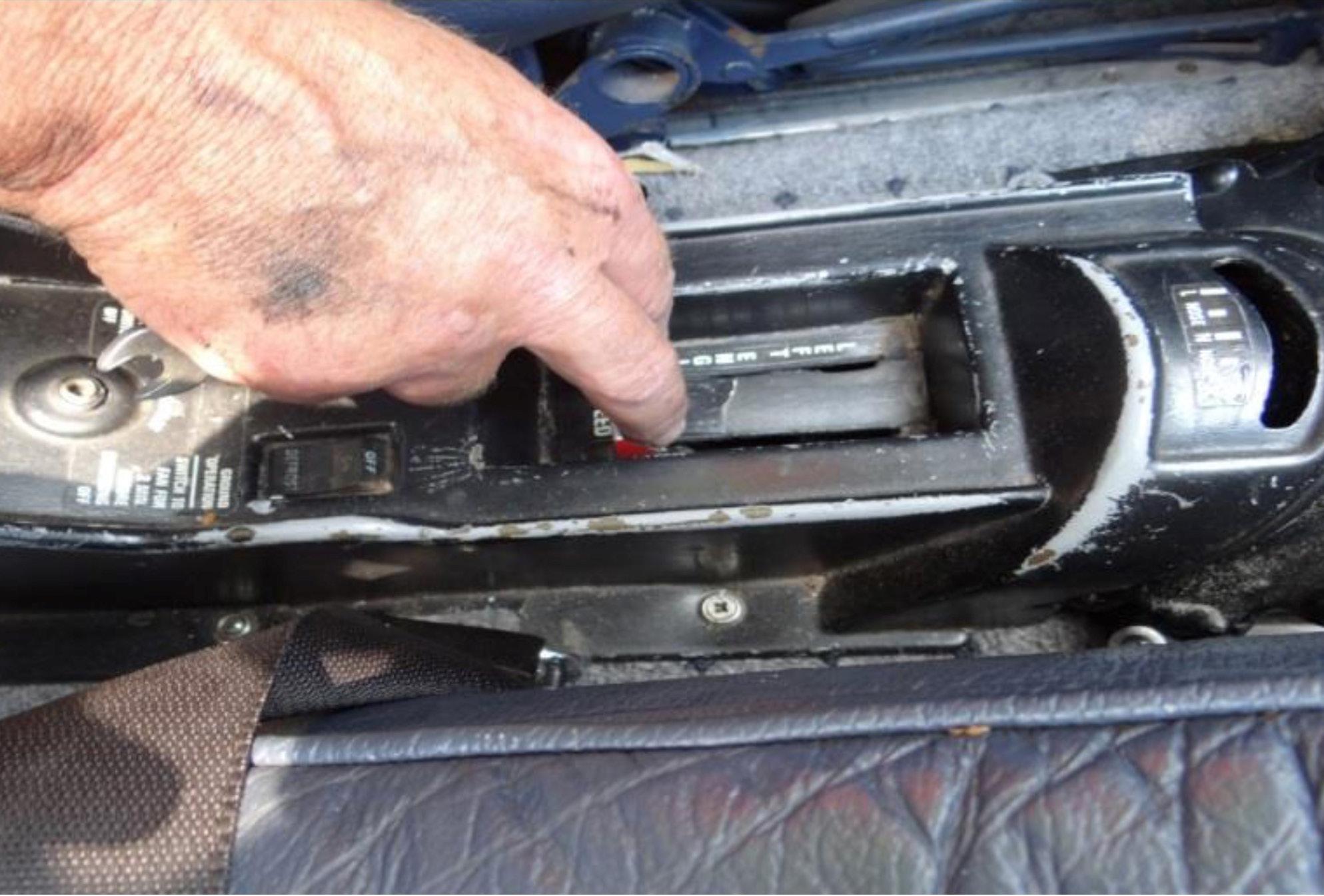
then
May 2024 26
If the decal is missing
the aircraft is unservicable. This photo is of the selectors in the Seneca crash.
both knew exactly why it had stopped – they had forgotten to switch the fuel on in the first place. They realized their mistake and quickly rectified it. Just my opinion.
It’s doubtful whether this had anything to do with the ultimate loss of power that led to them just failing to get back to the field. However several witnesses said they thought the engine didn’t sound as if it was producing full power during the takeoff and climb. Let’s hope the final report clarifies this.
Summary: I believe that two top pilots, with a total of 14,000 hours, forgot to switch the Cardinal’s fuel on.
I’m guessing that this may have been because of divided responsibility and no clear briefing as to who was actually flying this simple little aeroplane.
Dear instructors let that be a lesson to you and your pupils. Always be very clear about who is flying and who is responsible for what.
hand and your feet, while muscle memory takes your other hand behind all the power levers and eases them fully forward. It then raises the gear and flaps.
You can then relax and go through the deadfoot-dead engine, confirming and feathering routine. Bank a few degrees into the dead engine, trim and relax some more while you make a plan and tidy up the cockpit. Finally let ATC know what your plan is.
But I am drifting off the subject. Why did the engine stop when I most needed it?
This is an interesting one. The twin Comanche has two of these little low-point filters and drains. They are under the fuselage and hidden behind a small hatch. And therein lies the problem. The smallness of the hatch.
If the decal is missing, then the aircraft is U/S
I like to check fuel selection three times before leaving the ground. Once during my round-thecockpit inspection before start-up. Then once again during my round-the-cockpit after-start checks. And finally once more during my pretakeoff vital actions.
And they are called VITAL actions, not ‘checks’, for the very good reason that they are vital to your future tenancy on this planet.
13 Fuel low point filter.
I had an engine failure in Twin Comanche ZS-EVB at George. It was at the worst possible time – just after takeoff.
Instructors – you are the best people to deal with such misfortunes because you are pretty much current and in practice. You shouldn’t really have to think what to do. You fly the aircraft with one
One of them is very easy to get at, and the other is a bastard. So much so that engineers when doing MPIs are inclined to pull the left one out, clean it and service it. They then look at the right hand one and decide to have a tea break before tackling it. Over tea they reason that the previous guy probably serviced the right hand one so there is no reason for him to do it. It will be fine for another 100 hours.
You can see where this is going – the right hand one on EVB never got serviced in its entire life, and I think it was the oldest Twin Comanche in the country.
When the engineer, Dave Milne, eventually got it out, with much cursing over cut knuckles, he showed me what was inside. It looked like muddy water. It actually was completely full of water, but the mud colour was rust. In the bottom was a corroded bit of bent wire – that was all that was left of a large spring.
The moral – if a drain is difficult to get at, that’s all the more reason that you MUST get to it.
May 2024 27
The newer Cherokees have a nice, clearly marked selector with a positive stop to prevent you from accidentally switching the fuel off.
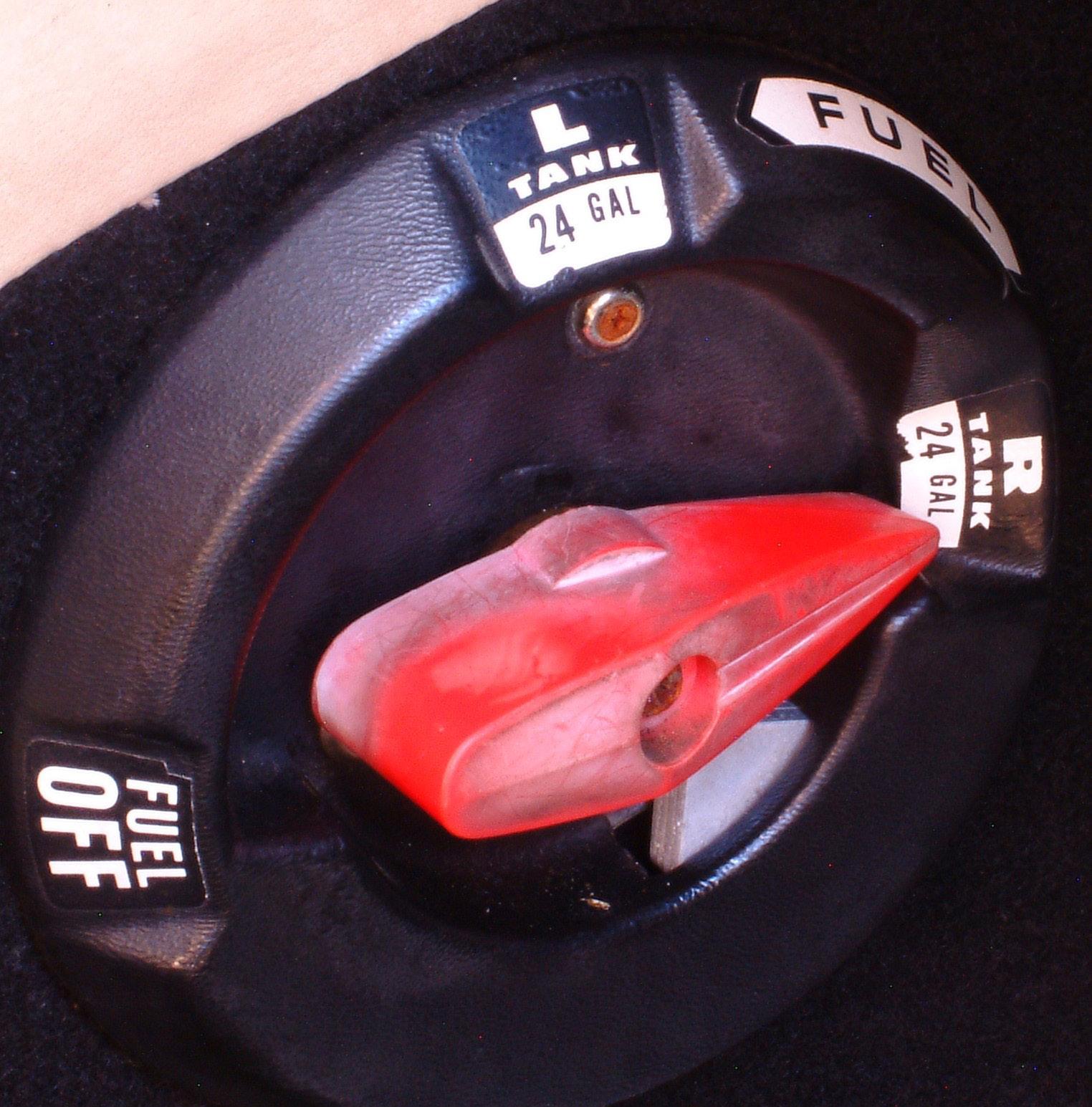
The fuel gascolator and drain is often very hard to get to - but you must.

And how about those really silly ones on the 100 and 200 series Cessnas? There is a white knob that you get at through the hatch where you check the oil. Nice and convenient – you don’t have to bend down for it to shoot a dollop of fuel straight into your shoe.
Worse still, it leaves a puddle of fuel on the concrete directly where the exhaust is about to send flames if it backfires during startup. There have been several Cessnas burned to the ground by this bit of idiocy.
14 The primer.
This is an interesting little gadget that gives you a nice rich mixture for cold starts. Basically, it’s a choke replacement. Every time you unlock it, pull it out and shove it in again, you are actually operating a sort of syringe – pulling it out fills it up and pushing it in injects vaporized fuel into the head, just before the inlet valve.
Here are three crash/don’t crash facts that many instructors don’t know about primers, so how are ordinary pilots meant to know them?
First fact, how do you tell if it’s properly locked, and does it matter? Yes, it does matter a lot, because if it comes unlocked the engine will run rough and lose power.
When you push it in and give it a bit of a turn, you should know what’s going on behind the scenes. Have a look at the photo. The yellow blobs show where two indents are. These are designed to stop the primer from slowly turning until the peg pops out of the hole and unlocks the primer.
The POH, or your instructor, will tell you that after priming you should push the peg into the hole and turn it 90 degrees. This will take the peg into the ‘safe’ zone where it can’t come unlocked. If it turns for any reason the
May 2024 28
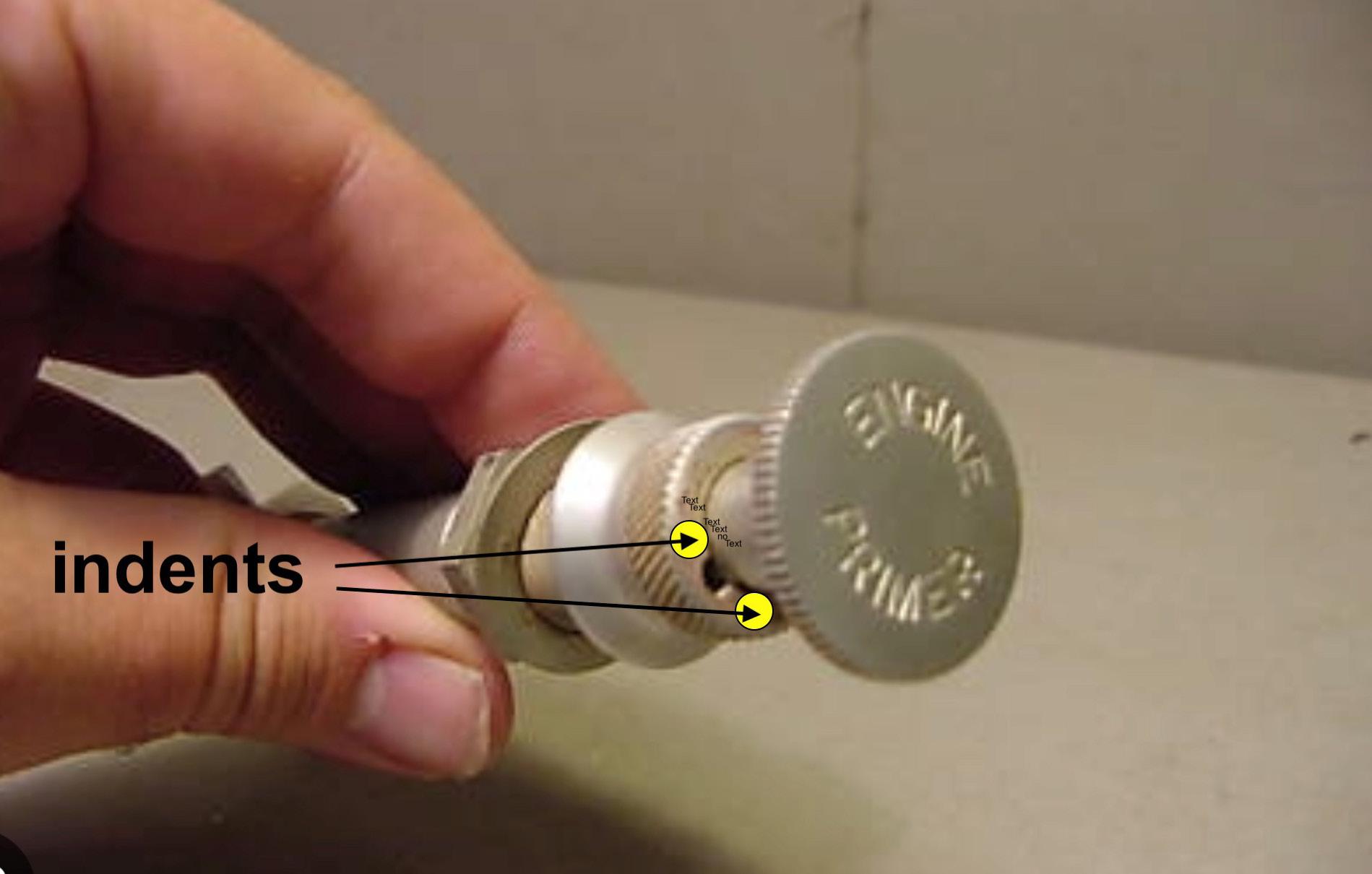
peg will go into one of the indents and prevent it from turning any further
Now, if you are not going to use the primer you have probably been taught to pull gently on it to make sure it’s locked – that’s fine – but if you give it a bit of a twiddle – just to make sure, then you stand a chance of twiddling it into the minute ‘unsafe’ zone – that’s the small gap between the indent and the hole. If it then pops out of the hole you will lose power – possibly during takeoff.
Second fact. If you have a look at the engine you will notice that those thin primer pipes don’t
go to all the cylinders – usually three out of four on Lycomings. This is to make sure that if you have primed too much and flooded the engine, at least one cylinder is not flooded so she stands a chance of starting on that one.
Third fact – under certain conditions you may be able to use the primer to give you a bit of power after a complete, or partial, engine failure. It will get fuel to the cylinders if dirt, or water, or something else prevents the carburetor from doing its job. It’s a long shot, but always worth a try if you need some extra urge to get you to that forced landing field.

May 2024 29
where the indents
to keep the primer locked.
Cessna's fuel drain knob drains fuel on to the apron beneath the engine.
Understand
are
15 Fuel system low point drain.
We covered this pretty thoroughly under 13 fuel low point filter. We need to think about the consequences of accidentally leaving this drain in the open position. A high-wing aircraft will let the fuel run out as soon as you switch the fuel on. With a low-wing aircraft, the fuel may only run out when you switch the fuel and the electric pump on.
Either way it’s theoretically possible to be streaming fuel into the atmosphere while in flight. You won’t see it – in that way it could be similar to leaving the fuel cap off on a high wing aircraft.
It seems that ship’s captains and engineers need to take a leaf out of pilot’s operating procedures. It sounds as if the crash of the container ship, Dali, into the bridge in Baltimore was probably caused by dirty fuel.
These ships usually have two huge supercharged two-stroke diesel engines driving a single propellor. They only use one engine while moving slowly. That engine not only turns the propellor, but it also powers all the electrical and hydraulic systems. And both those systems are used to move the rudder for steering.
As an afterthought, the Gleitch and I were delighted to receive the following letter:
Dear Guy
I have been following the Jim Davis articles on fuel. He may not remember this but in about December 1995 I was in Port Alfred when I saw SAA’s JU-52 flying overhead.
I drove out to 43 Air School because I heard it was due to land there. When I arrived, the aircraft was being refueled. Jim was supervising this operation from the back of a horse. He was riding bare-back, wearing no shoes and had a parrot on his shoulder.
several Cessnas burned to the ground
I commented on this to one of his staff, a young WW (Weekday Worker – I believe). Who said that Jim sometimes came to work in his 1936 Dodge Fire Engine – complete with ladder and brass bell – and with the same parrot on his shoulder.
The youngster looked round to make sure no one was listening and said, “I think he is a bit eccentric.”
Like aircraft, they have fuel filters and water drains. It sounds as if these were either inadequate or were not properly serviced and drained before departure, allowing dirt to block the fuel injection nozzles, causing the engine failure.
Then they have the equivalent to an APU which takes a bit of time to come on line and then it only supplies limited electrical and hydraulic power.
Short story – if you don’t drain the filter bowl you can cause a monstrous nonsense on anything from a little aeroplane to a bloody great ship.
Just thought you might enjoy this story. All the best Alex.
GL writes: When I asked Jim to comment he admitted it was true – but said it was only at weekends. j
May 2024 30
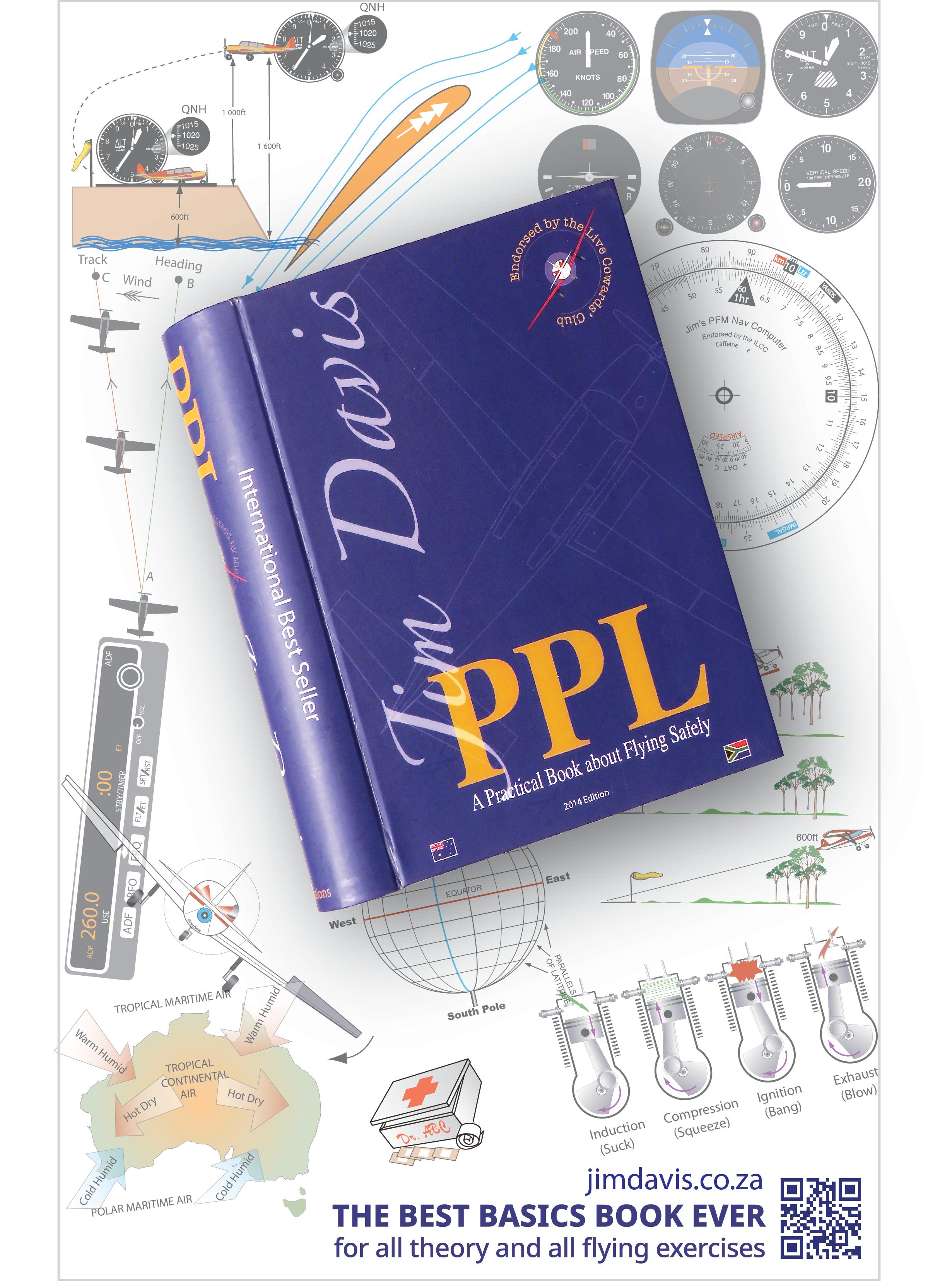
May 2024
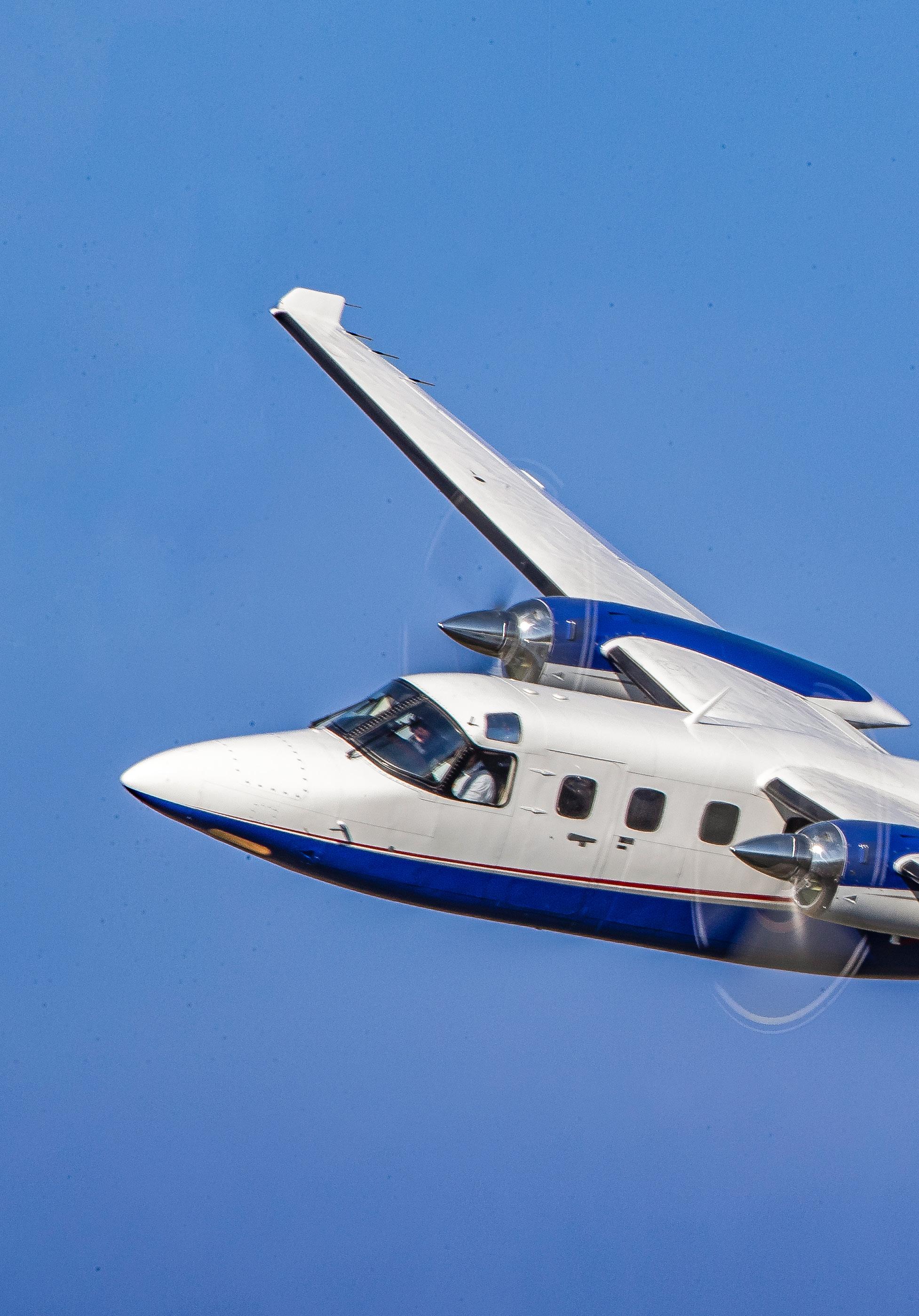
The Gulfstream Commander-1000 outperforms all comparable corporate turboprops in speed and fuel burn.
May 2024 32 FLIGHT TEST: GULFSTREAM 695A COMMANDER 1000
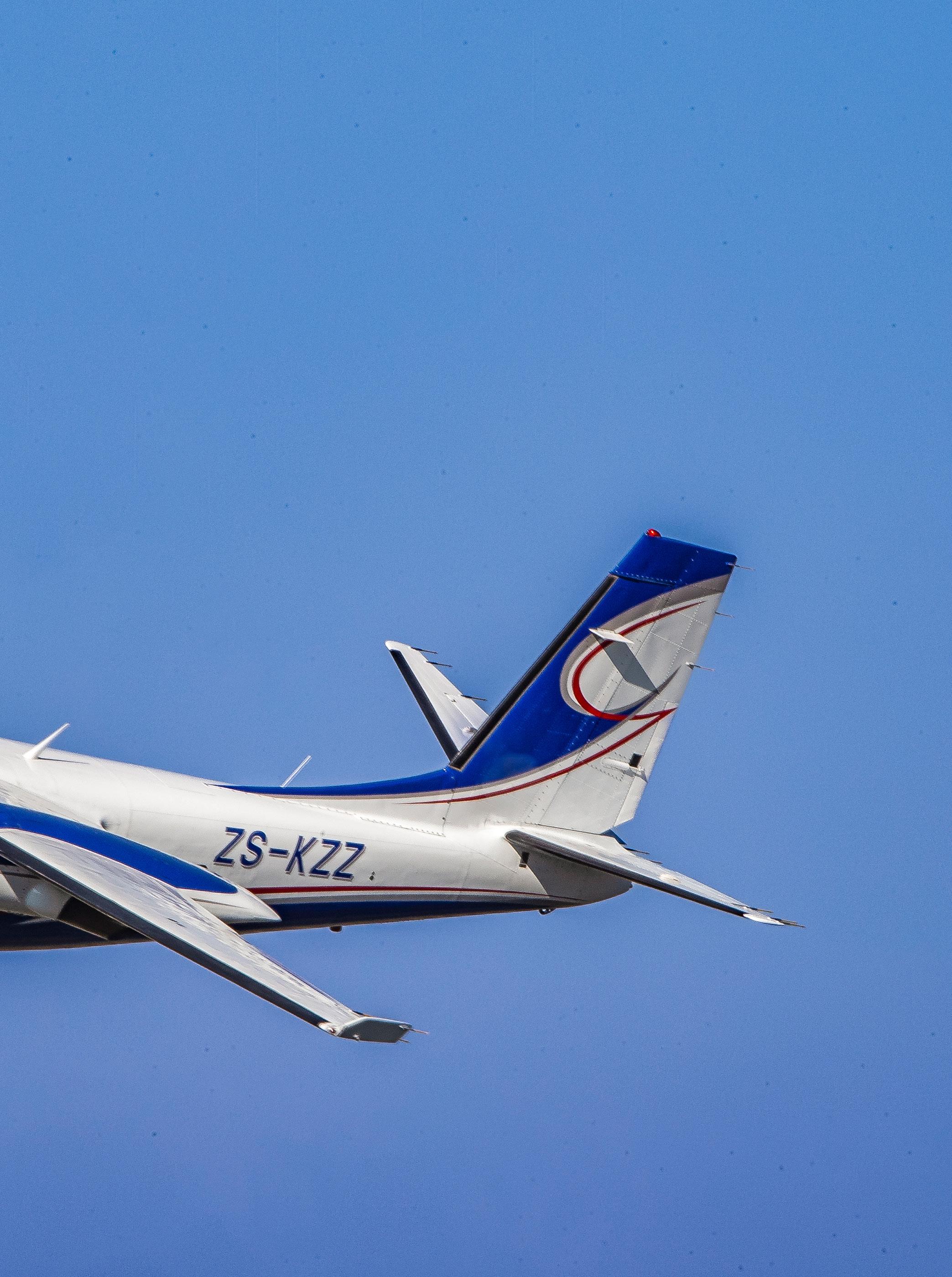
GULFSTREAM COMMANDER 1000
- THE SMART CHOICE
May 2024 33
Text: Guy Leitch. Images: Ken Clark, Mitchell Hill and Guy Leitch
Twin turboprops have always been about performance compared to their piston progenitors. So it is remarkable that by far the best all-round performer is also the biggest secret –and that is the Gulfstream Commander 695A-1000.
THE GULFSTREAM COMMANDER is a product of the aeronautical brilliance of Ted Smith. His Commander 500 through 680 piston twins were among the top corporate transports available. Even President Eisenhower used a 680 Grand Commander as an occasional Air Force One, because of its good short-field capability.
DEVELOPMENT
The first Aero Commander twin, the Model 520, flew on 27 April 1948. Using flat-six piston engines instead of the then still popular radials, and a semi-monocoque construction, Smith’s Model 520 was the first true modern light twin.
comfortably seating 5, and able to squeeze in two more in optional rear-facing seats behind the front seats. Powered by a pair of 240-hp, geared piston engines, the 520 could cruise along at about 200 mph, when most airliners were still only flying at 180 mph.
became famous in Bob Hoover’s hands
Despite having the aura of a private airliner, the Model 520 was blessed with superb handling, great visibility, an easy-to-manage cockpit, and good short-field / rough-field capability, which was important in an age when most airfields were still rough unpaved landing strips.
The 520 has a strong resemblance to the Douglas A-26 Invader which Ted Smith had helped design. With its high wings and tall empennage, the Aero Commander 520 had lots of interior space and load carrying ability,
To demonstrate its excellent engine-out handling, a propellor was removed from the critical engine of the first prototype –which was then taken-off and flown, non-stop, from Oklahoma to Washington, D.C. This feat would serve as a valuable lesson for a company that would eventually benefit from ‘stunt marketing’, thanks to a company vice-president named Bob Hoover.
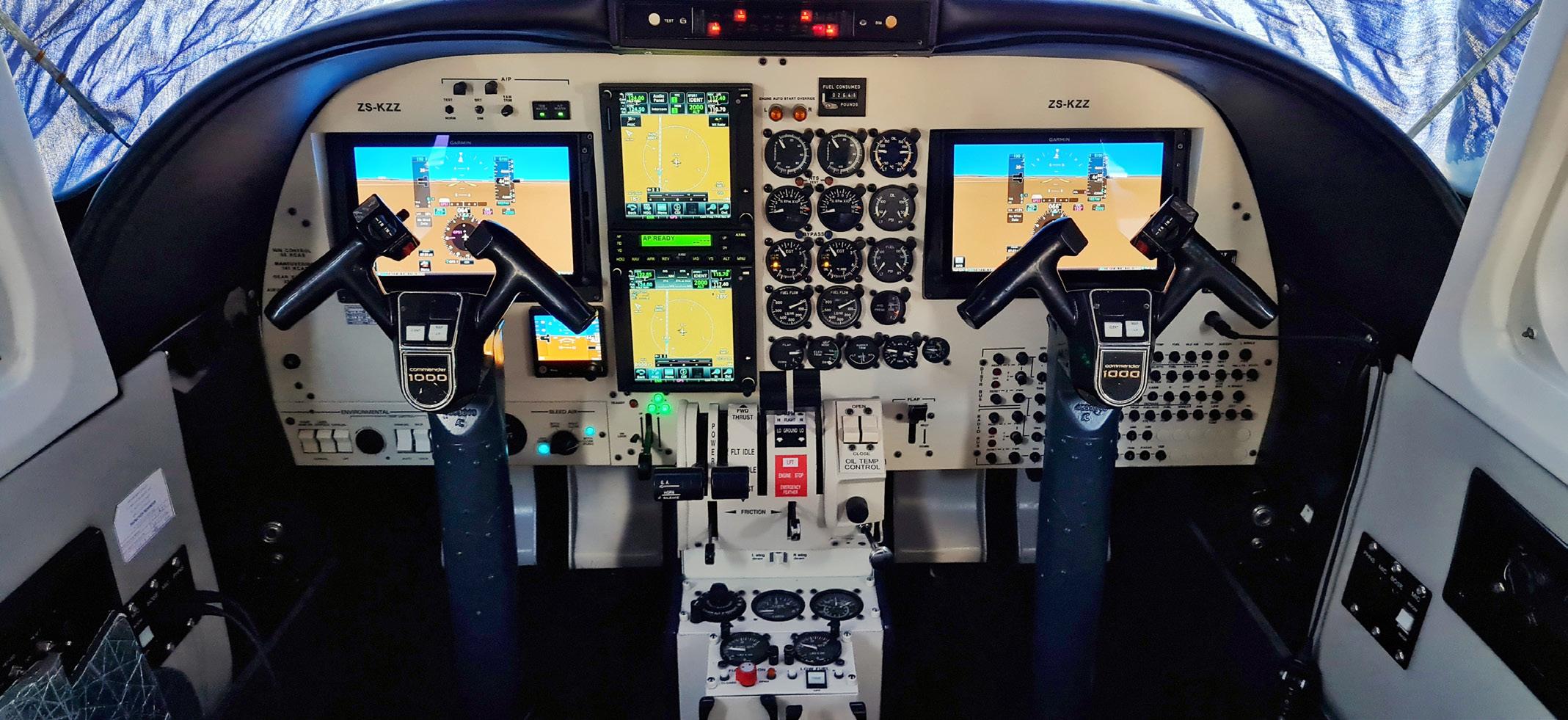
May 2024 34
Cockpit has been fully refurbished with Garmin G600 EFIS. Image Mitchell Hill.
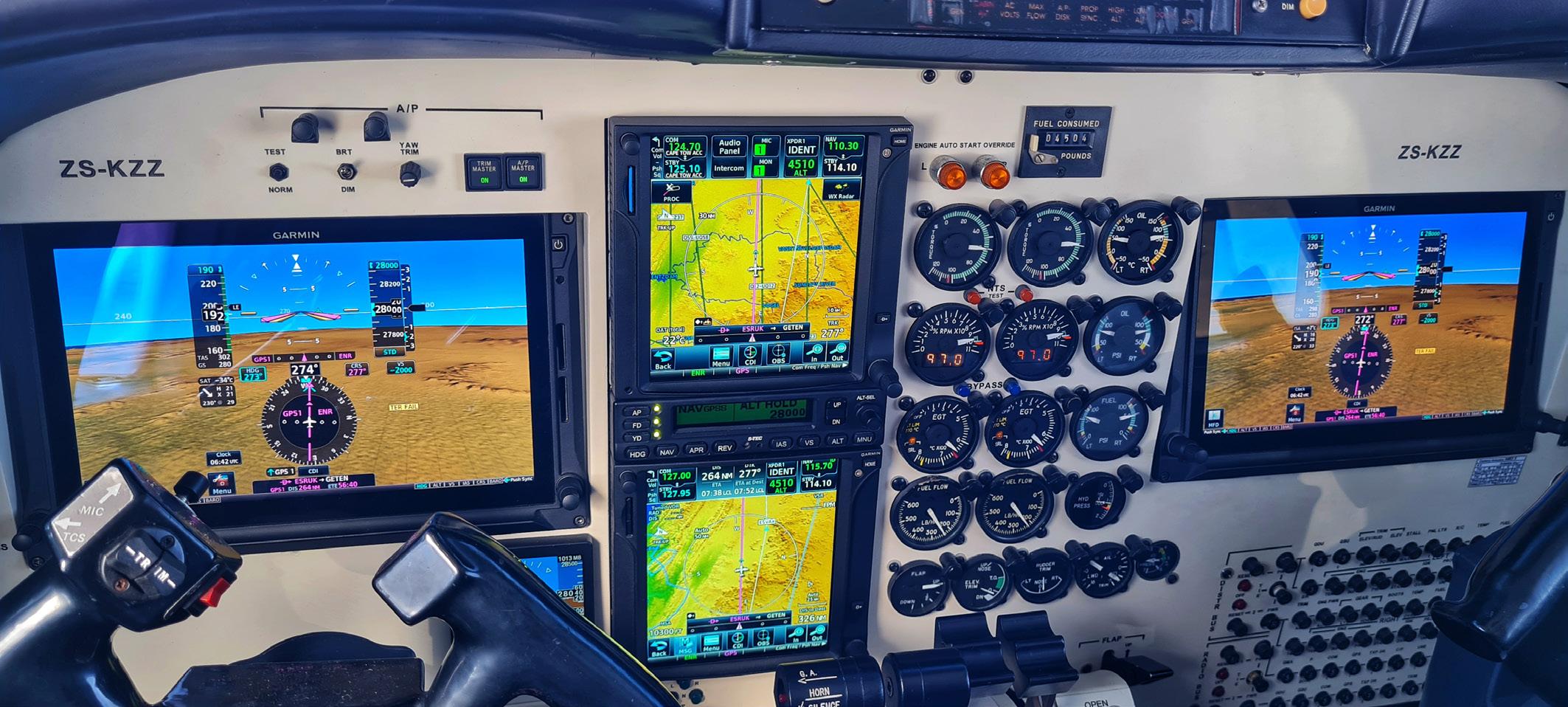
A more streamlined version of the 500 became the Shrike Commander, which soon became famous in Bob Hoover’s hands. Hoover would get into his big, twin-engined Shrike Commander and fly loops and rolls – with both engines running, then on one engine, and finally the whole routine again with no engines, eventually gliding to land and coasting smoothly to stop on the same spot from which he’d departed.
Aero Commanders had been designed around the big-twin concept and could only get bigger – not smaller and more efficient. With an aisle between the seats, this class of plane came to be known as cabin-class. The Beech Model 18 had first claim to the class, and by 1960 Beech had debuted its Queen Air. The long fuselage Aero Commander 680FL was introduced the next year and Cessna and Piper soon followed with the Cessna 400 series and the Piper Navajo and Chieftain.
Aero Commander responded by putting Garrett AirResearch TPE-331 turboprops on its 680FLP. The result was the Aero Commander 681 (commonly known as the Turbo Commander, or – briefly, the Hawk Commander). It soon evolved into the slightly more powerful, and more refined 690.
afforded great visibility for pilots
Faster, by far, than the King Air B200, and any of the large Cessna or Piper piston twins, the beautiful 690 Commander was blessed with a cockpit that afforded great visibility for pilots and remarkably simple cockpit systems, while exuding the sophisticated image of an airliner’s flight deck.
The planes had grown, but the power hadn’t, as the flat six piston engines could not make more than 375 hp. So Beech replaced the Queen Air’s pistons with Pratt & Whitney PT-6s and called it the King Air. As the King Air it quickly began winning sales from all top-of-the-line piston twins.
With a roomy cabin and the advantage of a spectacular earthward view for passengers through huge picture windows (the King Air’s low wing prevented much of a view from its small porthole windows), the Commander retained a great appeal. The Commander’s high-wing and roomy, rectangular cabins (versus the cramped, round oval cabins of competing planes), great handling and hefty load capabilities made it hugely popular with all who flew them – or sat in the back.
The company was bought by Rockwell in 1958, who in 1981, sold it to Gulfstream Aerospace.
May 2024 35
It's all about performance - 302 KTAS at FL280 burning just 460 lbs per hr. Image Mitchell Hill.
Gulfstream introduced a series of improved models, culminating in the Twin Commander 1000, which was produced from 1982 to 1985.
The subject of our evaluation is ZS-KZZ, a 1983 Gulfstream Commander 695A-1000.
ZS-KZZ is the third of three Commander 1000s acquired new by Eskom and operated from Grand Central. It proved adept at the short legs to the nearby Eastern Transvaal power stations with small runways, and well as long flights to Cahora Bassa in Mozambique, and Cape Town, for the Koeberg power station then under construction.
For the historians, Eskom’s three Aero Commander 1000s were ZS-KZX, ZS-KZY and ZS-KZZ. ZS-KZX was exported to the USA in 1997 and KZY went to Australia in November 2014, leaving just KZZ in South Africa. Other 695 Commanders in South Africa are ZS-TWZ and ZS-MWT.
ON THE GROUND
The Commanders may not have the ramp presence of the King Airs with their high stance and even higher T-tail. Instead, they are low slung and sleek – and look fast. The high wing means that the cabin floor is low and easy to access. The fuselage is long and has a rectangular cross section, giving plenty of head room. Another popular Commander feature is the large external baggage compartment behind the cabin.
Ted Smith’s designs are easy to spot as they have the cockpit in front of the engines for better visibility out. The Commanders have the main cabin door at the front of the cabin, so the pilot can be the last one in and the one to close the door, without having to thread her way through passengers to the cockpit.
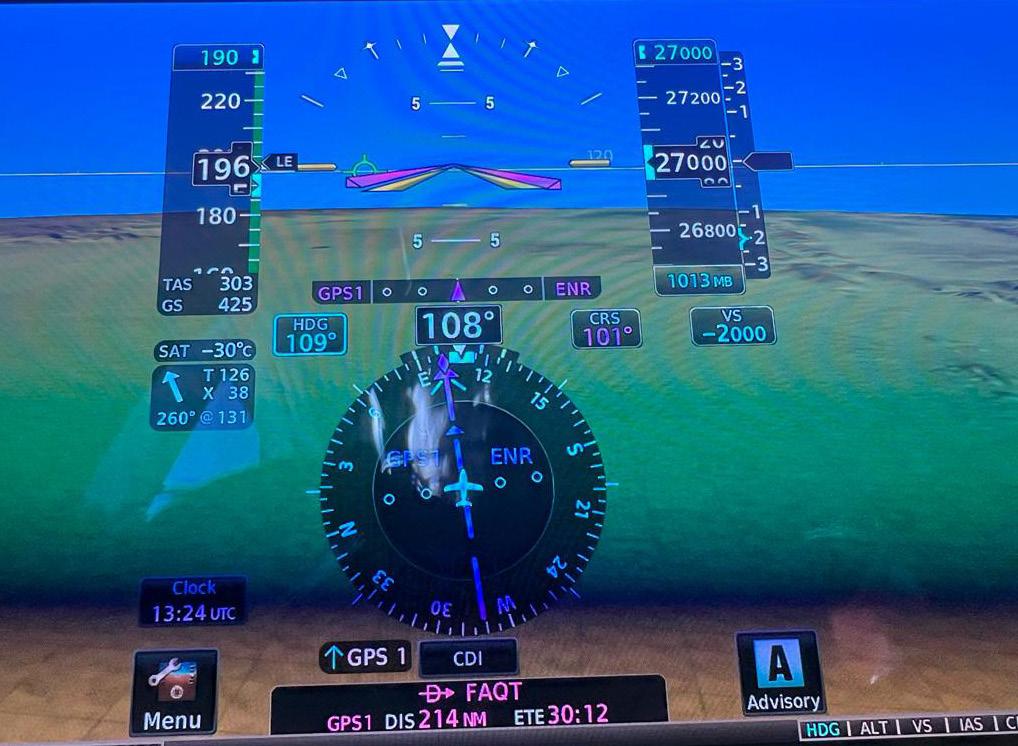
May 2024 36
Just for fun - enjoying a 425 Kt groundspeed. Image Mitchell Hill.
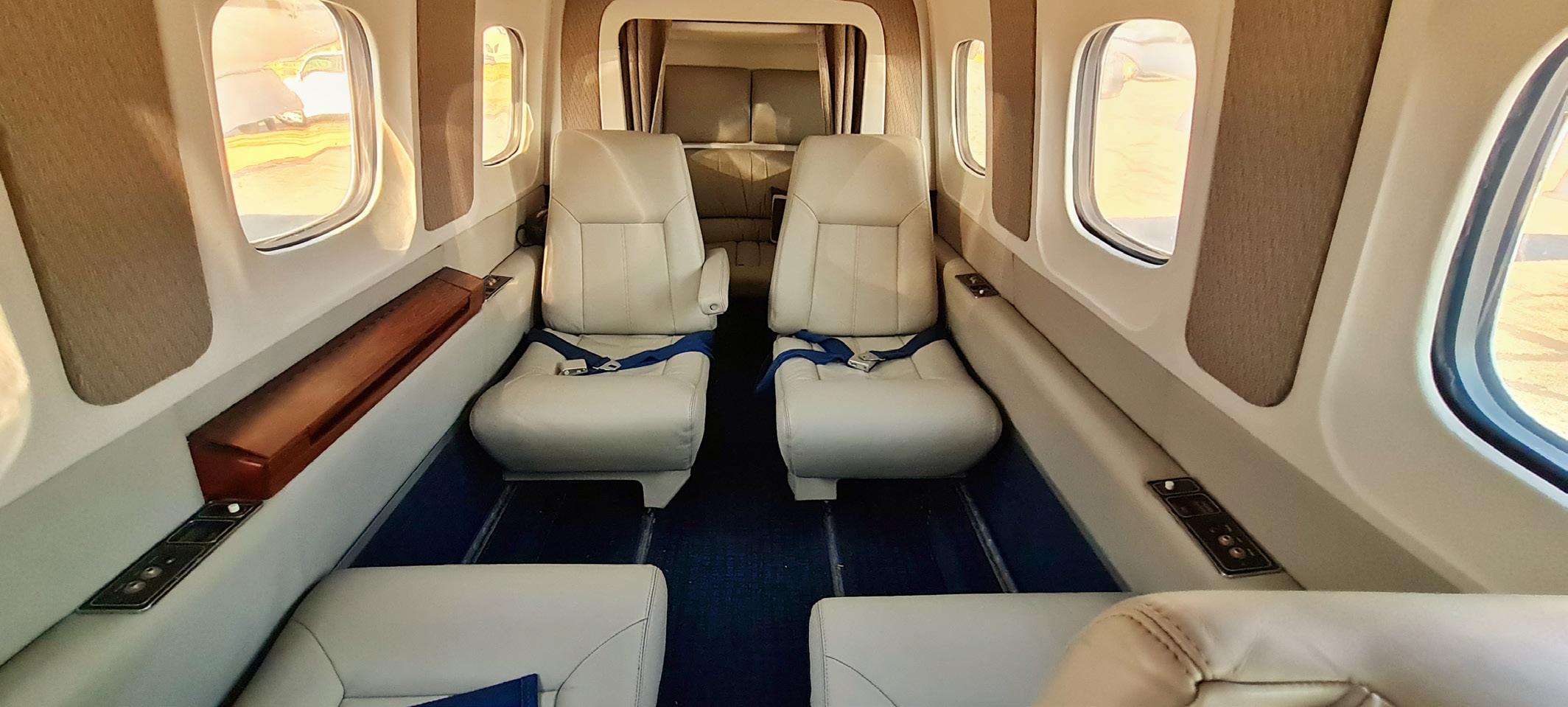
The 695A-1000 is powered by a pair of 820 shaft horsepower TPE331-10 engines, which deliver excellent fuel economy and have long overhaul intervals of 5,400 hours. These turboprops have direct drive props and so need a high idle speed and thus have a loud highpitched scream on the ground.
The high wing gives the props a very useful 35 cm ground clearance, and the props are not as vulnerable to a pitching motion on the ground as are the forward mounted King Air props.
However, it wasn’t until Gulfstream bought Rockwell Commander in 1981 that the brand
really hit its stride with two new models—the 900 and the 1000, also known as the 690D and 695A/B. About 40 of the 900s and approximately 110 of the 1000s were made. You can easily differentiate between the two: the 900s have large mid-cabin picture windows, which offer great views out, but make for a noisier cabin. The 1000s deliver 15 knots better maximum cruise speed—up to 305 knots—and have up to 500 pounds more takeoff weight than the 900s.
ZS-KZZ has just completed a major makeover which includes a new EFIS instrument panel, interior and paint job. Out came the electromechanical ADI and HSI and avionics

Unusual alcove for rear seats can also take a belted potty. Image Mitchell Hill.
May 2024 37
Up to 9 seat interior - but its cozy. Image Mitchell Hill.
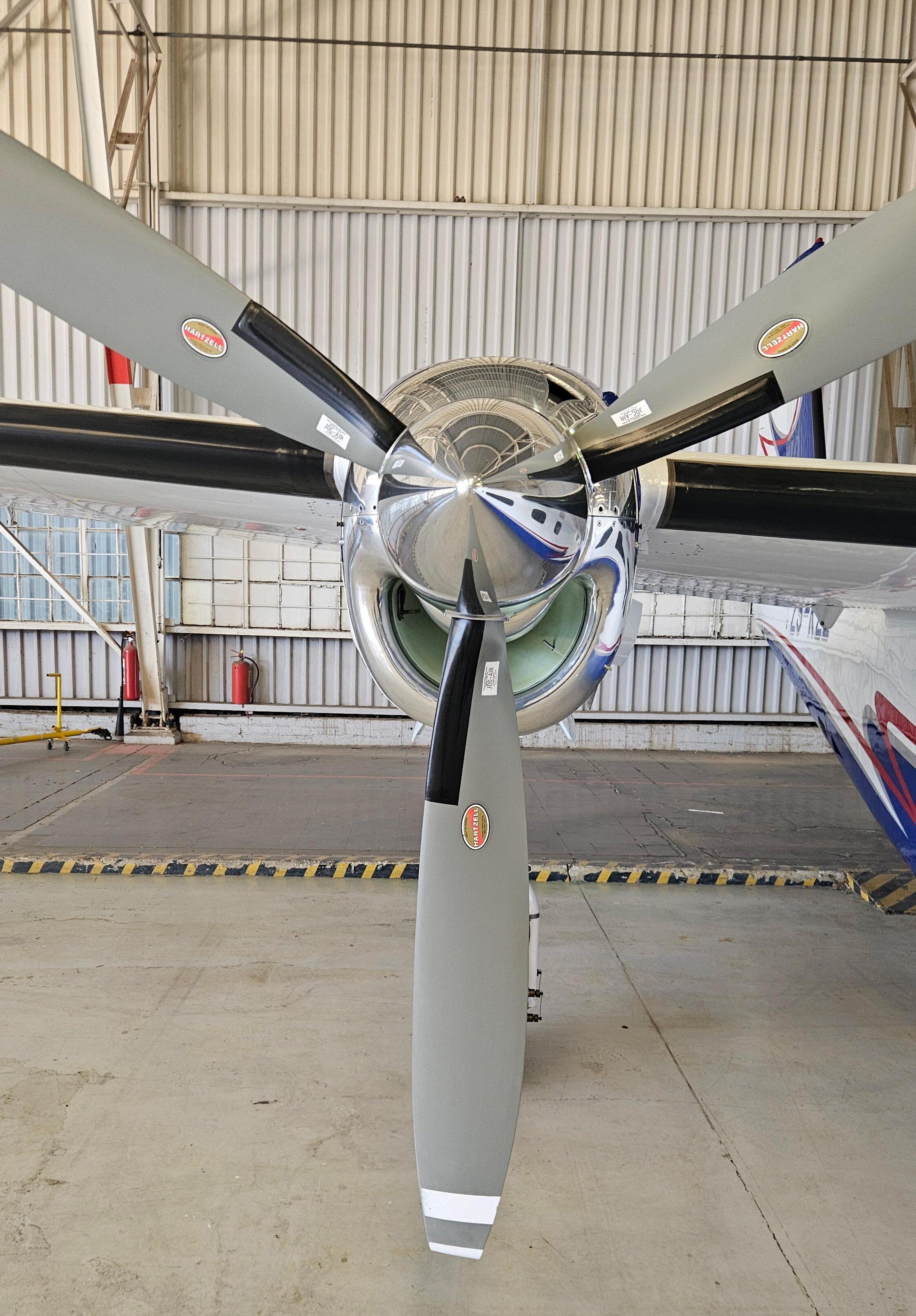
Commander 1000 uses Honeywell TPE-331-10-511K engines which are notably more fuel efficient than the equivalent P&W PT6.
May 2024 38
panel. About 180 lbs of wiring was removed. The new panel features two Garmin G600TXI EFIS displays driven by two Garmin GTN 750 NAV/COM/GPS units in the avionics stack.
Bringing the aircraft fully up to date are two remote ADSB in/out transponders. There is a Garmin 75 weather radar and an S-Tec 2100 digital autopilot.
The cabin has been beautifully redone with a spacious double club interior for 6 adult passengers plus 2 pilots, or 5 adult passengers with 3 children and the 2 pilots.
With an endurance of over 6 hours, the rear cabin can be fitted with a belted electric flushing lav (making it a legal passenger seat) and a semi-rigid privacy door. The ‘squared oval’ cabin provides generous shoulder and headroom for a plane in this class. The baggage section can hold 600 pounds.
All Commanders can be flown single pilot. With pilot, three passengers, full bags, and full fuel, Commander 1000s can fly a very impressive 2,000 nautical miles—that’s eight hours of cruising.
FLYING THE COMMANDER 1000
ZS-KZZ’s Honeywell TPE-331 -10 engines have a ‘mini FADEC’, being a Single Red Line (SRL) computer which prevents novice pilots from doing a hot start by feeding in too much fuel too quickly.
Taxying can take some getting used-to. With the brake pedals operating proportioning valves, Commander brakes are different to most other aircraft. It’s common to see new Commander pilots making jerky side-to side motions with frequent application of brake as they try to figure out the pedal steering.
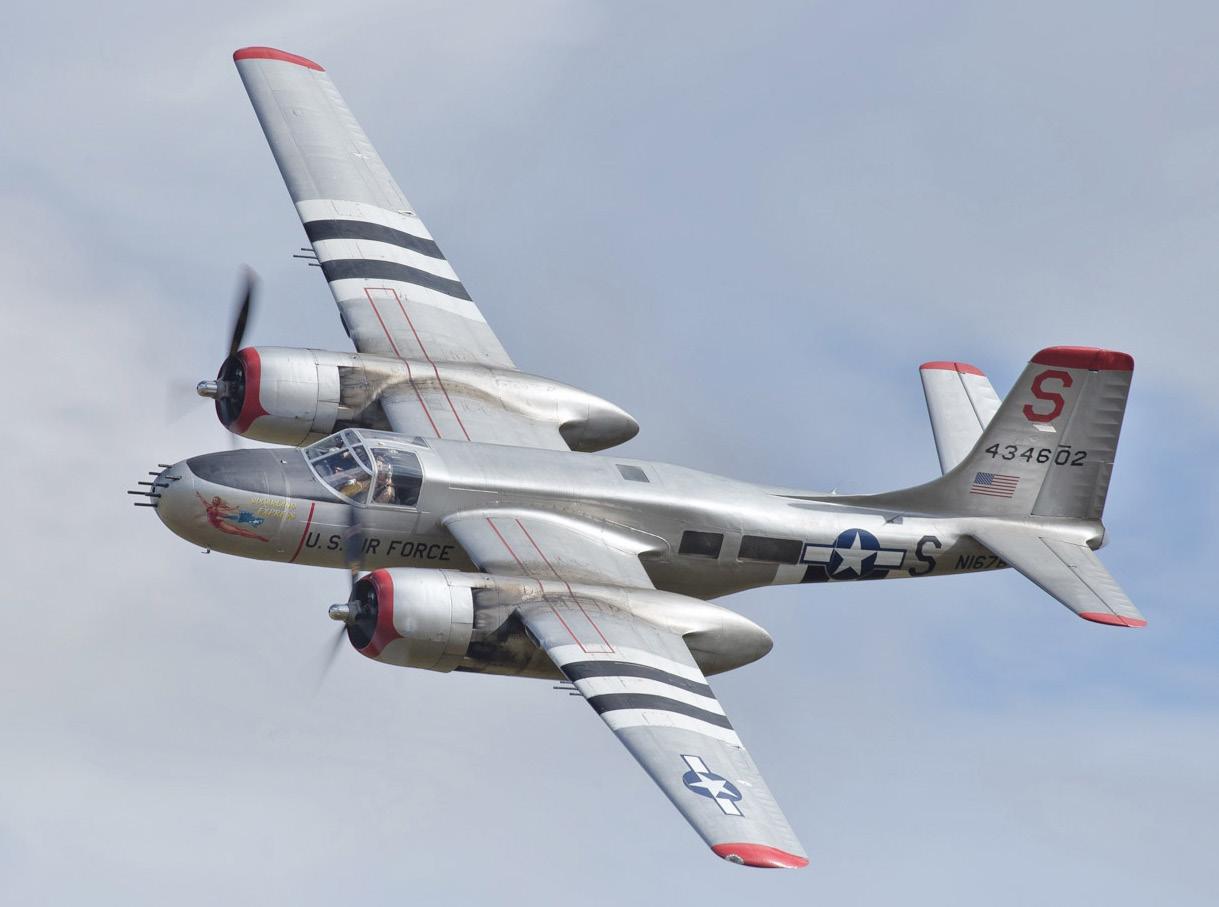
May 2024 39
The Douglas A-26 Invader shows its common heritage with the Aero Commander.
Unlike the Pratt & Whitney PT-6A turboprop, which has propellers that turn independently of the rotating components of the powerplant (the so-called free turbine design), Garrett TPEs use a single-shaft. This means that the shaft to the propeller gearbox is directly connected to the rotating engine’s compressor.
In a power loss, the windmilling prop still drives the engine and so generates huge drag, not to mention asymmetric thrust. So Garrett engineered a system that senses negative torque, then automatically sends the propeller of the sick engine to a nearly feathered condition (the pilot must manually complete the feathering) when it detects that the prop is driving the engine. Without this NTS (negative torque system) a Vmc rollover may be a risk after an in-flight engine failure. A pre-flight check of the NTS is thus required before every flight. If the NTS doesn’t pass the preflight checks, it’s a no-go item.

With the Commander 1000’s good power to weight ratio, acceleration is brisk, especially at typical lighter weights. Rotation is weight dependant but is around 85 KIAS, which can be reached in 300-400 metres, depending on weight and density altitude.
aerodynamic
genius is evident
Climb at 130 KIAS can be greater than 4,000 fpm, and 160 KIAS is a typical cruiseclimb still going up at over 3,000 fpm initial climb. It can climb straight to FL280 with a full load. At that level it will do over 300 KTAS, depending on load, typically burning 450 lbs/h, which is about 70 gph.
The 6.7 psi pressurisation differential keeps the cabin at 7,000 feet at FL280. The two engines combined use about 85 gallons the first hour, and about 75 gallons every hour after that. Fuel burn and speed decreases above FL290, so in its upgrade, ZS-KZZ was not approved for RVSM operations.
If flying for range, the Commander 1000’s 3,200-pound fuel capacity provides an easy six-hour endurance for as much as a 2,000 nm still air range. The aircraft has an amazingly simple fuel system, having what is in effect just one big tank, although there
May 2024 40
Prop clearance is excellent thanks to high wing.
are in fact 22. So there are no issues with crossfeed or fuel mismanagement. Everything is interconnected, so all fuel comes from just one source.
ZS-KZZ is usually flown for its owner by Mitchell Hill, who notes that the perception of speed is much the same at 80 knots as it is at 180 knots. Consequently, the first few landings with a new Commander pilot usually are either too fast or too slow. Most new pilots seem to want to err on what they consider the safe side, and end up doing the approach and the landing much too fast.
Mitch Hill reports that it climbs at around 750 fpm on one engine at gross weight, and with the large rudder, asymmetric thrust is easy to control. “You can even trim the plane out and put your feet on the floor. Most pilots say an engine failure is a non-event.”
Another key safety feature is that the clean stall and Vmc within two knots of each other. With a clean configuration the buffet comes at 75 KIAS and with flaps, at 72 KIAS, with no tendency for either wing to drop.
Every turbine Commander comes with a maximum turbulence-penetration speed. These speeds relate directly to the structural strength of the airframe, with the empennage usually being the weakest link. Most Commander models therefore have a big 180-kt IAS Va (manoeuvring speed) placard on the windscreen post, applicable to flying in light-to-moderate turbulence. In severe turbulence, depending on operating weight, Va can be 40 -50 kt less than the 180-kt limit. The lighter the aircraft, the slower Va is.
Mainwheels rotate to horizontal when they retract.
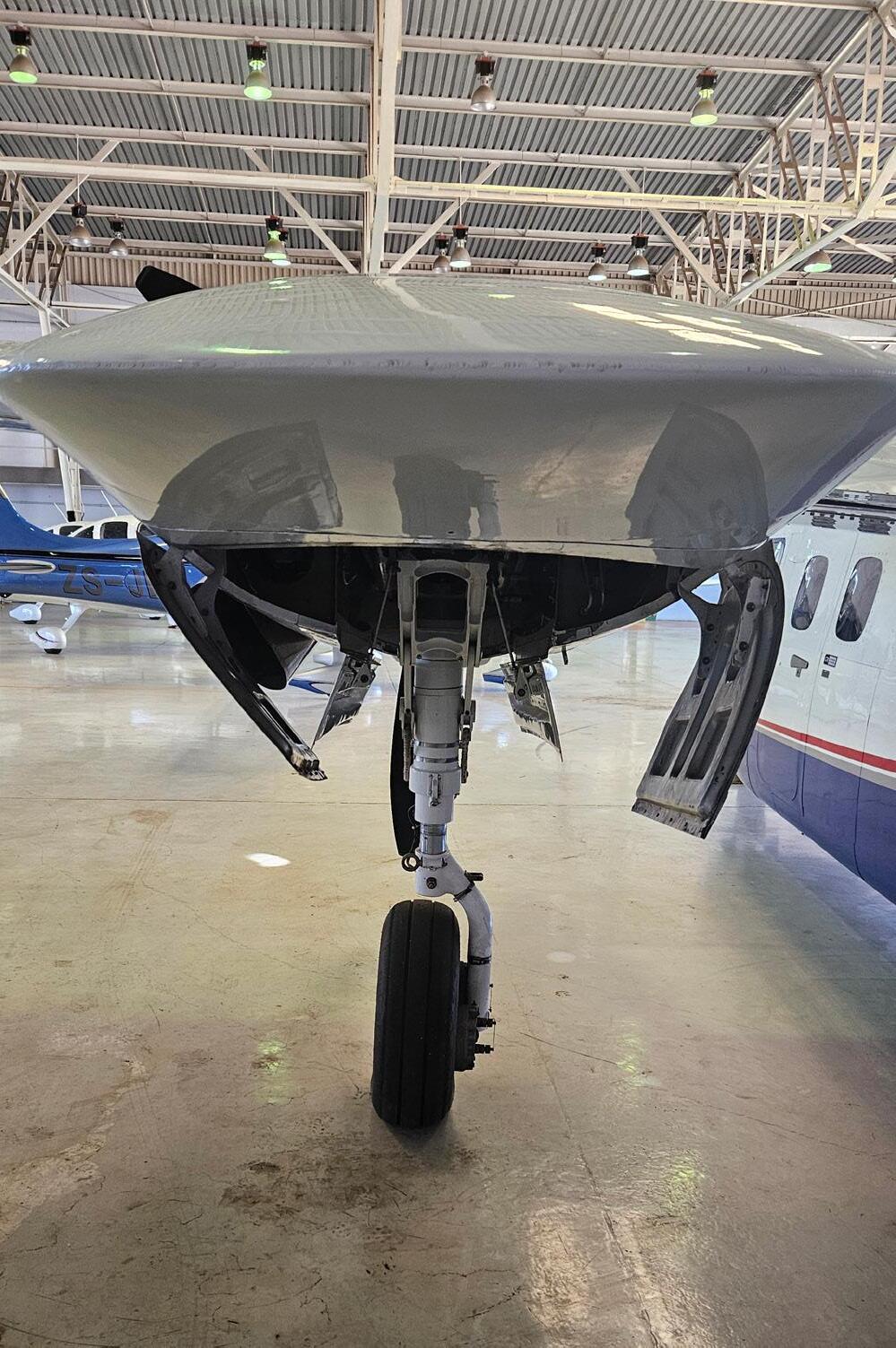
King Air B200 fly-off
Mitch Hill reports that they performed a reallife comparison with a Beech 200 King Air – its direct competitor.
the pilot can be the last one in
All the turbine Commanders have an excellent short and rough field capability. Approach is typically 110 KIAS slowing to 95 knots over the fence. With the big wheels and if necessary, beta or even reverse on the props, you can get stopped in 300 metres.
Flying ZS-KZZ, Mitch took off from Queenstown for the 485 nm sector to Cape Town, ten minutes after the King Air. Despite being kept low by ATC until he had overtaken the King Air, ZS-KZZ landed 20 minutes before the King Air – and burned 200 litres less fuel. And the Commander has significantly lower maintenance costs, due to longer engine times between overhaul.
For an owner operated twin turboprop, the Commander 1000 is indeed the smart choice.
May 2024 41
Characteristic 'canoe' fuselage features a high tail.
CONCLUSION
Ted Smith’s aerodynamic genius is evident in many aspects of the Commander. He got it right first time so you don’t see aerodynamic afterthoughts like stall strips, wing fences or vortex generators.
Gulfstream’s ownership of Commander lasted only from 1981 to 1985, but Commanders produced during this period are highly valued.
Once you have flown a turbine Commander, pilots understand why the passion for these planes runs deep. Commanders might have been out of production for nearly forty years, but with hundreds still flying regularly, and with strong support from type certificate holder Twin Commander, these planes should continue to fly for decades to come.

PARTS AND SUPPORT
FOR AIRCRAFT TYPES no longer in production there is always potential concern for long-term parts supply.
Today, Twin Commander Aircraft of Creedmoor, North Carolina, holds the type certificate and supports the type with parts it makes from more than 58,000 pieces of original production tooling. Matt Isley, the CEO, notes that “95 percent of our parts requests are out the door the same day. We stock a lot of inventory. When you compare the support we provide with the support of an in-production aircraft, we’re on par with some of the best OEMs to make sure our owners have mission-capable aircraft. Guys are comfortable flying this airplane in revenueproducing roles because the product support is there.”
Twin Commander’s Grand Renaissance program is a virtual rebuild of the aircraft that effectively zero-times the airframe. But even without such investment, Commanders tend to be robust. Still, “when you’re dealing with an aircraft that has been flying for 30-plus years, you’re going to have some corrosion things and structural issues,” Isley notes.
“Gulfstream really learned from the earlier models and eliminated a lot of problems with the changes they made on the 900 and 1000,” Isley continues. “There have been only two large service bulletins on the [Commander] line in the last six years, but those have not applied to the 900 and 1000 models, so they are fairly clean from an SB [service bulletin] or AD [airworthiness directive] standpoint.”
May 2024 42
j j
Specifications and Performance
Gulfstream Commander 695A-1000
Specifications

Baggage compartment load limit (unpressurized)
Baggage compartment load limit (pressurized)
Max Ramp Weight: 11,250 lbs
Performance
Maximum Cruise 354mph/308kts
Normal Cruise Speed 348mph/302kts
Twin Engine Vy (IAS) Sea Level: 159mph/138kts
Twin Engine Vx Sea Level: 113mph/98kts
Single Engine Vy (IAS) Sea Level : 138mph/120kts
Single Engine Vx (IAS) Sea Level: 117mph/102kts
Minimum Control Speed (IAS): 93mph/81kts
Stall Speed, Clean (CAS): 91mph/79kts
Stall Gear and Flaps Down (CAS): 89mph/77kts
Wing span 52.12′ Length 42.98′ Height 14.95′ Cabin Height (Inside
4.77′ Cabin Length 17.25′ Cabin Width
4.12′
Interior)
(Inside Interior)
600
lbs
100 lbs
Weight: 10,550 lbs
Empty Weight: 7,289 lbs Useful Load: 3,961 lbs Zero Fuel Weight: 8,800 lbs
600 lbs
Max Take-off Weight: 11,200 lbs Max Landing
Standard
Baggage compartment load limit:
PITTS LOW LEVEL AEROBATICS
Aircraft Registration: ZS-UZZ
Date of Accident: 22 August 2015
Time of Accident: 0758Z
Type of Aircraft: Pitts Special S-1S
Type of Operation: Private
PIC Licence Type: Private Pilot Age: 46
Licence Valid: Yes
PIC Total Flying Hours: 309.1
PIC Hours on Type: 11.4
• This discussion is to promote safety and not to establish liability.
• CAA’s report contains padding and repetition, so in the interest of clarity, I have paraphrased extensively.
History of Flight:
Last point of departure: Brits (FABS)
Destination: Rustenburg (FARG)
Location of the accident: S 25°31’20” E 27°46’33”
Elevation: 3700‘
Met: 150°/05KT, Viz 10k, Temp 23°C, DP 9°, CAVOK
Number of people on board: 1
No. of people injured: 0
No. of people killed: 1
THE PILOT TOOK OFF from runway 20 at Brits at about 0750Z on a private flight to Rustenburg.
After takeoff the aircraft drifted 40° to the left. The pilot did a left-hand circuit followed by a knifeedge along the runway.
He then did a 180 and a 50’ flight along 02 and pulled the nose up at the end of the runway. At about 250’ he rolled inverted. The aircraft pitched nose-down and impacted the terrain in the back yard of a residential area.
The pilot did not hold an aerobatic rating.
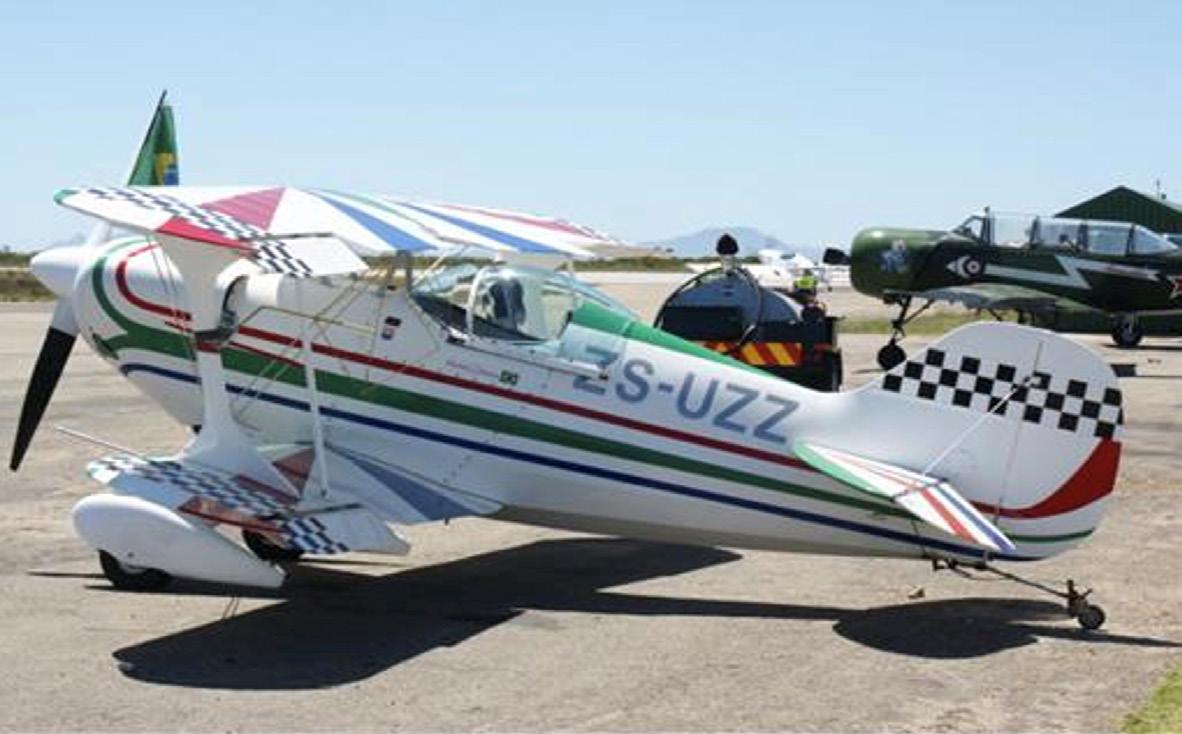
May 2024 44
JIM DAVIS
The pilot had just 11 hours on the Pitts Special.
JIM’S COMMENTS
AT FIRST I DIDN’T THINK this accident had much to tell us ordinary pilots. The aerobatic community understands that this crash was caused by insufficient training, so there’s not much for them to learn from it.
However, it caused considerable comment on SA’s most popular aviation digital chatroom, so I ploughed through more than 300 posts to see what other pilots had to say. They made fascinating reading. So I have selected and condensed some of these views for you to think about.
Some of you will recognize the words of an experienced aerobatic pilot who ironically didn’t listen to his own advice and his own criticism of Andre. Soon afterwards he killed himself doing an unplanned high G pull-up at low level. This tells me you need more than knowledge and skill to be a safe pilot – you need cast iron discipline.
This is the crux of the matter and why I think pilots who do beat-ups are intellectually challenged and personality deficient. If you are so insecure or stupid that you would intentionally take risks to gain a perceived “respect” from others, even after they have told you that they think it makes you a bigger wally, then you probably deserve to remove yourself and your future influence from the gene pool.
Just so sad when family gets left behind for no good reason.
[The guy who wrote the above comments killed himself shortly afterwards. He was showing off doing a high G pull-up at low-level when the main spar failed.]
-------
learn aerobatics at a sensible height
I’ll give you my thoughts at the end and tell you what I believe is the basic cause of Andre’s accident, and many others. Plus a golden tip for avoiding this type of accident.
Guys, he was never a “windgat” [showoff]. The most competent and cautious pilot I ever flew with, which I did a lot.
WAKE UP FOLKS - GET PROPER TRAINING, OR STAY AWAY FROM STUFF YOU DON‘T UNDERSTAND.
-------
So in my total 1400 hours – 15 years with 600+ aerobatic hours – your statement that Aerobatics is dangerous is not only untrue but it sounds like you might have had a bad experience with someone unqualified.
HappySkipper wrote: Jim – let’s say a guy has some aerobatic experience, and flies a light single with a +4/-2 G rating, on arrival at an airshow/gathering/ fly-in or whatever, he does a low-level, high speed run into wind down the active runway, then pulls up into a “zoom” whilst banking 45° to position himself on a downwind, would that be considered dangerous, or showing off? I ask, because I would like to know whether my LCC (the Famous Live Cowards’ Club) membership might be revoked?
ANSWER: Slappy Kipper, you wouldn’t be going to 46° , or even 47° of bank, would you?
Speed is Life... and Altitude is Life Insurance
-------
Good morning Jim. There seems to be a hint that LCC members only pussy-foot around the patch when the weather is fine – and should not really enjoy the “manly” side of flying.
REPLY: That’s stone wrong. The LCC encourages all pilots to learn nice, smooth aerobatics at a sensible height, in the right aircraft, with a good aerobatic instructor.
May 2024 45
There’s no greater pleasure with your pants on – apart from a greasy three-pointer in a taildragger.
Proud LCC life member. This year I celebrate 40 years in aviation - I aim to see many more years – thank you LCC.
Patty Wagstaff (World Aerobatic Champion https://en.wikipedia.org/wiki/Patty_Wagstaff) says: The rules are simple, and I’ve found it’s best to heed them.
So before we criticize somebody like Andre, who died before he aspired to greater heights, don’t be fooled that only the “windgat” die doing aerobatics. History is filled with the names of dead aerobatic pilots
-------
This bloke was sent out by a pro to get comfortable with the aircraft then “come back so we can teach you properly” how to do aerobatics. Now somewhere in between he lost himself and did something stupid and paid dearly so he now won’t be learning to do aerobatics anymore. He just did his last one. Maybe it will sharpen some aviator somewhere on this forum. Me, I will continue with the LCC.
Is it really only “his affair” when he was conducting low-level aerobatics outside of an aerobatic box/practice area which resulted in a crash close to houses, which may well have cost the lives of innocent people going about their household chores?
I can recall so many names of people I knew, who were really nice chaps, good pilots and enthusiastic aviators, whom I wish I could see strolling around on the mentioned aeroplane aprons – but alas, who I can only see in the mirrored images of my memories…. sad?
-------
I think the basic question to be asked is, was this accident sequence part of a “PLANNED” display, or was it a “SPUR OF THE MOMENT” / “UNPLANNED” action?
pilots are intellectually challenged
Andre – the accident pilot –previously wrote: I enjoy the Pitts. Keep checking the sky –would be nice if someone can give me some feedback. I fly almost every weekend from FARG. Would like to see those photos. [Jim says, I’m afraid it sounds a lot like lookat-me].
Even when the professional aero teams do low level aeros my stomach tightens, I turn my head and do something else. I don’t enjoy watching low level aerobatics at all.
Ownership does not guarantee proficiency.
What made him do this? The male f*****g EGO.
Andre, I knew you for a short while but this could have been prevented.
One just needs to look at the number of fatal ‘beat-ups’ that have taken place over the past five years and ask what makes pilots want to show off, just to kill themselves, and sometimes take others with them? US statistics suggest that ‘beat-ups’ are the major cause of fatal accidents in General Aviation, especially when there is an audience
Andre was laid to rest today. What a nice down-to-earth gentleman.
Almost five years ago I lost my leg, and almost my life, in a Harley accident. There
May 2024 46
He rolled inverted at 250 ft, then hit the ground.
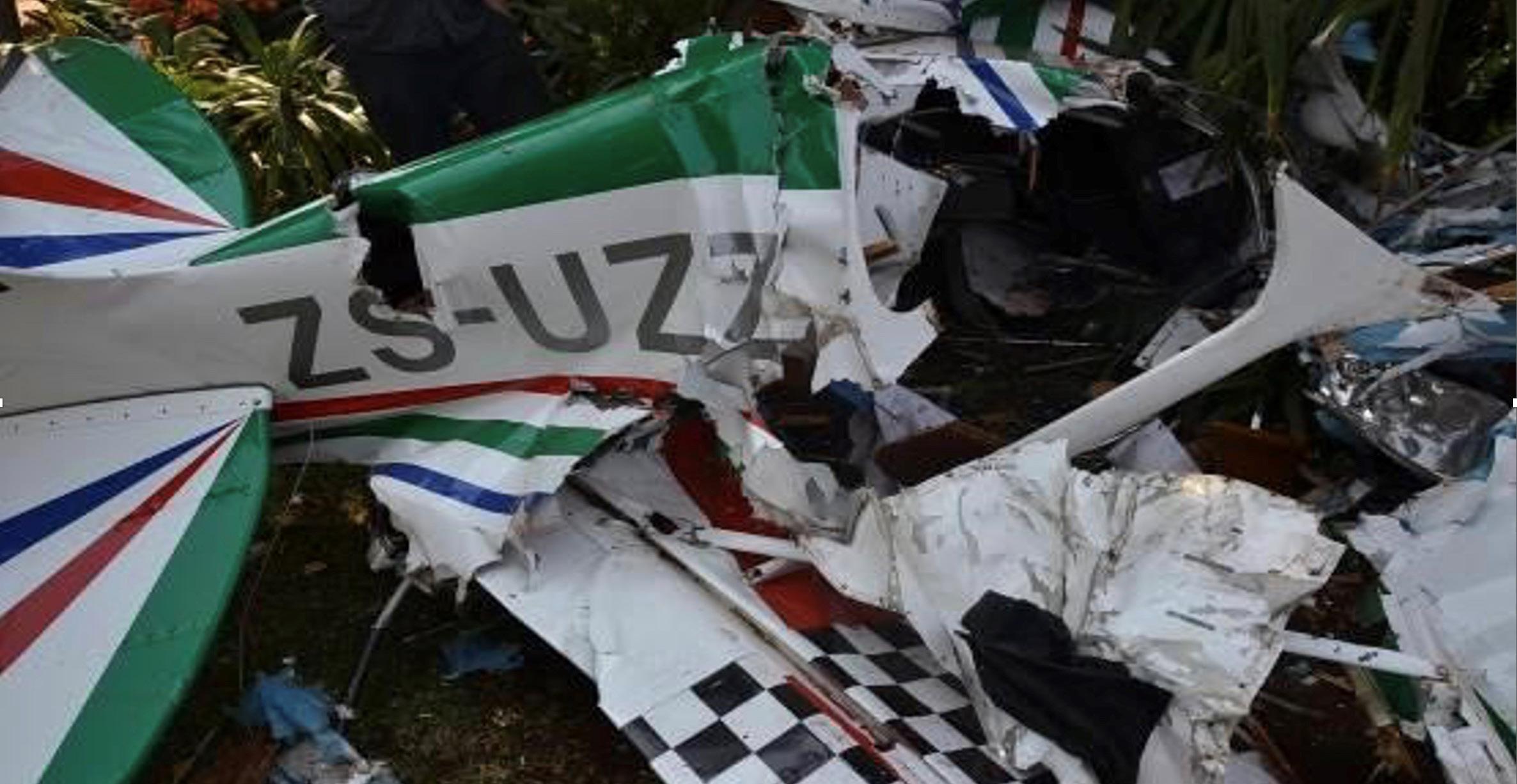
were many times I wished that I never woke up. During the following year I lost my wife and two darling daughters together with their arms and laughter. Also lost was the PPL that I was privileged to enjoy for 20 years.
I didn’t ask for or expect sympathy. My foolish behaviour on my Harley had caused the nightmare that haunted every sleeping and waking hour of my life, but I am paying for it dearly. How I wish I could turn back the hands of time for my family whose lives were also shattered. They had no part in my conduct for which they are also suffering.
If Andre could turn back the hands of time, not for himself, but for all other wives, friends, daughters and parents. If only.
remember the name of the second, but he had three pax in a Sundowner. Then there was Quinton Posthumus, a Placo salesman who did it at Youngsfield in a 140 Cherokee with three girls on board. And then Jack Jay, another Placo salesman, four-up in a 235. He took a photographer’s head off and then crashed. Next was Angus McKenzie, who did it at Parys in a Bonanza. There are more, but these are the ones who spring to mind. All experienced pilots, and all killed doing wing-overs after beat-ups. Oh, and there was Hookie Baldwin who did the same in a homebuilt at Karel van Aswegen’s strip near Plett. The list is impressive – and all experienced pilots.
All because it seems so easy, but it’s far more complicated and dangerous than it looks.
Jim Again
With aerobatics in a high density altitude, you go up slower – and come down faster and further.
Why must it be done at low level? There’s only one answer – showing off!
In the 60s, two successive bosses of the Beech agents killed themselves doing beatups at airshows. The first was Henry Hunt in a Musketeer, with a passenger. I can’t
Briefly, the secondary effect of rudder tries to pull the nose down and roll you on your back. You counteract with elevator and aileron and you spin in from 300’.
Don’t play silly-buggers NEAR THE GROUND.
Golden tip
Keep a photo of your child or loved one stuck on the instrument panel. j
May 2024 47
FOR SALE Piper Comanche PA-24
Price: R950K excluding VAT
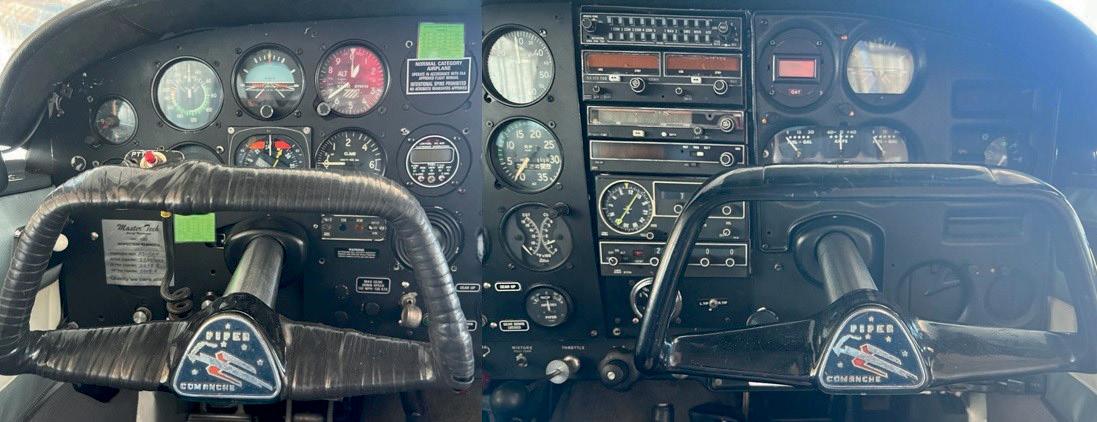
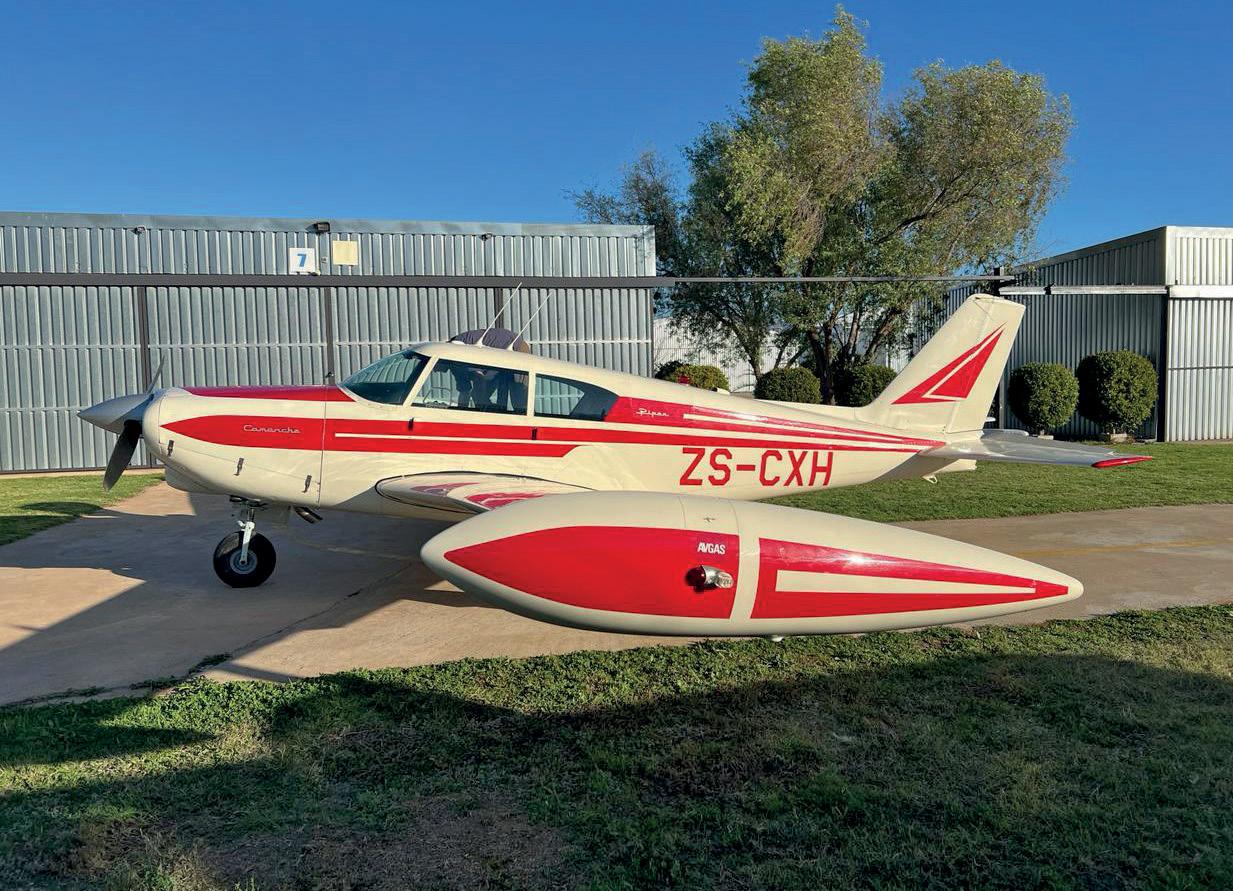
FOR SALE
Tucano Replica
R2 million (replacement kit would cost over R2.8 million before building)
PA-24 – 180 hp: 1962. ZS-CXH.
Fantastic cruiser and hour builder.
Airframe: 2440. Lycoming O-360-A1D
Prop:Hartzell HC-C2YR-1BF
Avionics: Standard six pack
Viewing: Worcester FAWC
FOR SALE
Bearhawk Patrol 2022
R3.5 million
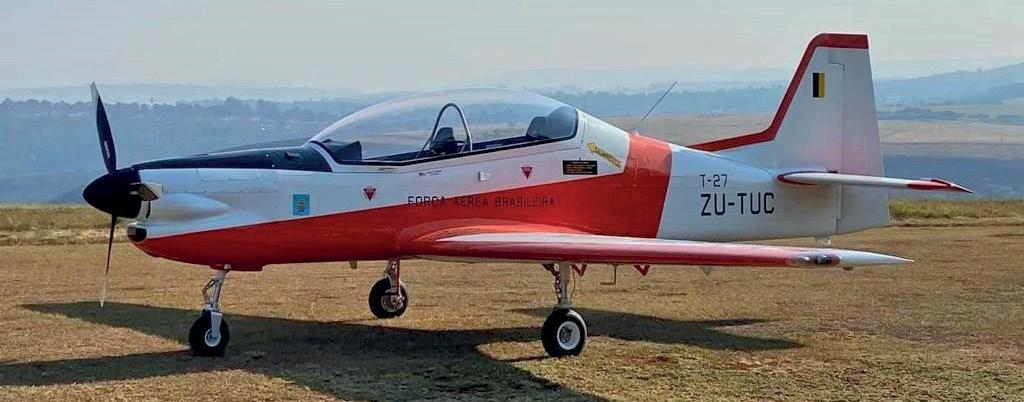
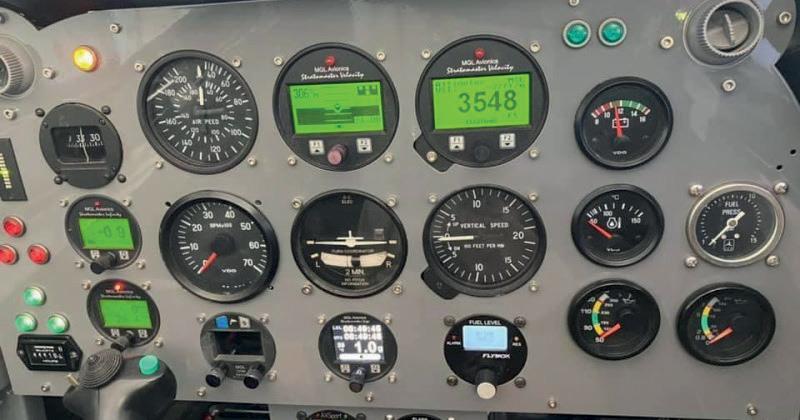
Airframe: 25 hours. ZU-TUC.
Engine: Flygas Supercharged Rotax 912 uls
141 hp. 300 hours since new
Propeller: Elitest carbon fibre electric variable pitch propellor – 25 hours
Instruments: Mostly MGL but too many to list
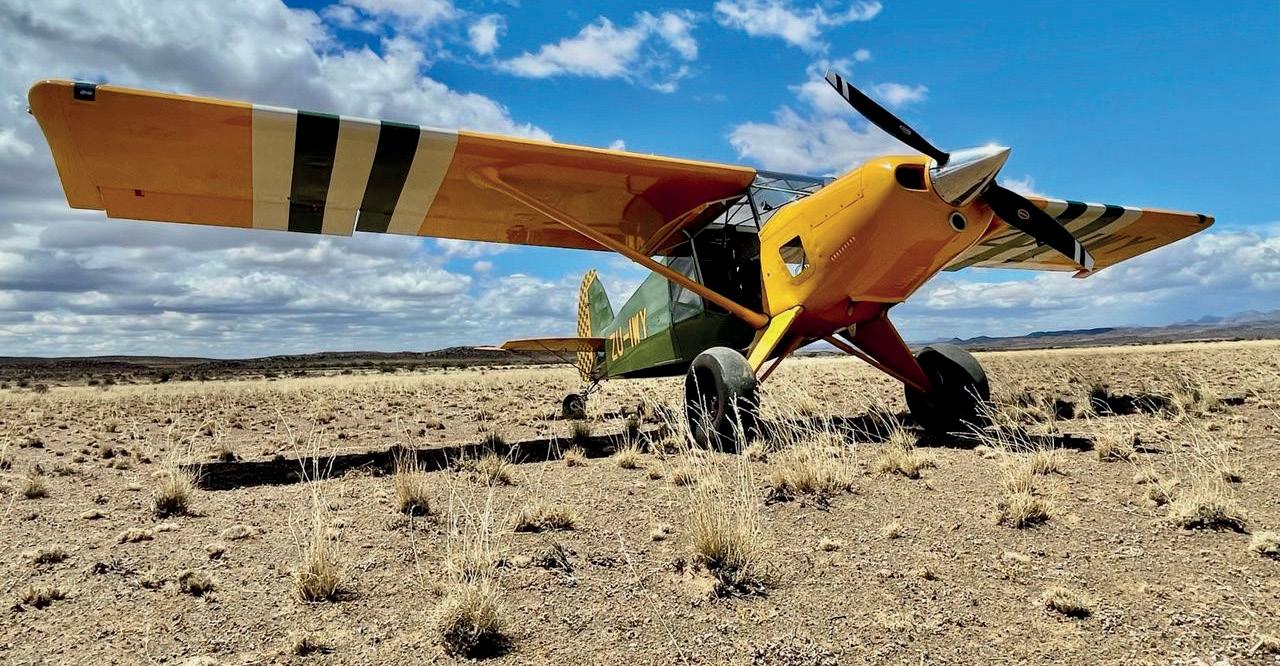
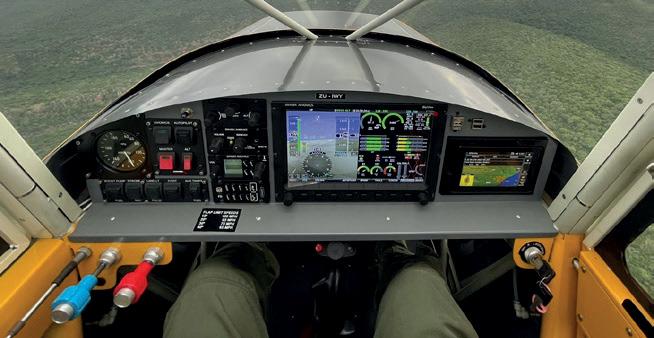
2022 ZU-IWY. A Super Cub on steroids. A bigger, more powerful and faster bush plane
Airframe: 45 hours. Engine: Titan IO-360 180 hp
Prop: Hartzell HC-C2YR-INX
Avionics:Dynon Skyview with autopilot and Aera 600 GPS Viewing: Worcester
May 2024 48
Contact Nick Wilkinson: +27 (0)82 688 0578. Email: info@riolargo.co.za

A LOCAL SOLUTION TO A GLOBAL REQUIREMENT
At Helideck Certification-Africa, we’re dedicated to providing a local solution for a global necessity – the certification of offshore helidecks.
CERTIFICATION FOR SAFETY:
Regular helideck certification is crucial for the safety of helicopter crew and passengers, ensuring the protection of your valuable assets.
ISO9001:2015 APPROVED: Helideck Certification-Africa adheres to international quality standards.
ADHERING TO UKCAA CAP 437:
We base our inspections on this recognized global standard, assuring the highest level of safety for offshore helicopter operations.
PRECISION FRICTION TESTING:
We employ the Findlay Irvine Microgrip friction tester, the only friction tester approved by UKCAA CAP 437.


OUR COMPREHENSIVE INSPECTIONS COVER
• Helideck markings and obstacle-free sectors
• Identification of operational Helideck limitations
• Competence of Helideck Crew
• Communication procedures
• Firefighting and rescue equipment
• Emergency Response Planning
• Helicopter operational procedures

YOUR SAFETY IS NON-NEGOTIABLE. CHOOSE HELIDECK CERTIFICATION-AFRICA FOR PEACE OF MIND AND COMPLIANCE WITH GLOBAL SAFETY STANDARDS!
May 2024 49
For Further Information or to Book an Inspection, contact us today: Email: info@helideckcertification.com Phone: +27(0) 83 263 4439 Website: www.helideckcertification.com
PK-NEX is now ZS-TJA and is another Challenger that may be using South Africa as a front for its Russian owners.
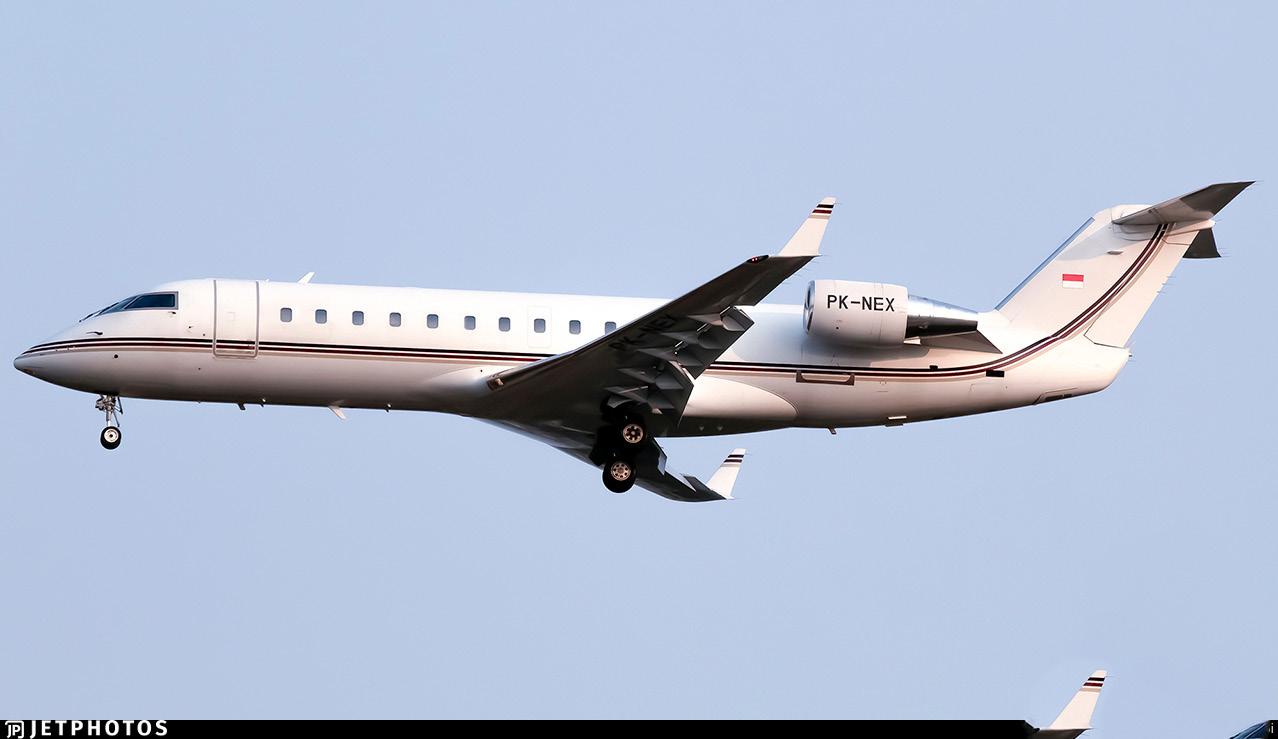
MARCH 2023
It’s hard to believe that we are already more than a third the way through the year. This month sees 13 aircraft added while nine have been cancelled as exported.
I OPEN THIS MONTH’S REGISTER REVIEW with an interesting and unusual addition - a Bombardier Challenger 850ER, ZS-TJA. This is a former Indonesian-registered (PK-NEX) corporate jet and only the second such aircraft to ever be registered in SA. I am unaware that it has been delivered to South Africa at the time of writing, but I have an inkling this may be yet another corporate jet using the ZS- register to “sanitise” its ownership for onward sale, as the last tracked flight of the jet with its Indonesian registration is on 25 January when it routed Dubai (DXB) -Istanbul (ISL).
This is the same pattern as the recentlyimported Global Express 6500, ZS-BPG (60014), that ended up in Russia via a few very quick changes of registration. Watch this space, but I would equally welcome any comment from our readers clearing up this matter!
The Beechcraft 1900D ZS-EAH has returned from its lease to the Maldivian airline, Manta Air, and resumes operating under its former South
African registration. It arrived back in SA at Lanseria Airport on 3 February to clear customs before making a short hop to Rand Airport, and no doubt now awaits new assignments.
The other additions for the month are a brand new Cessna Caravan, ZS-XCA and another CRJ900, ZS-CMH, for Cemair. This registration was previously assigned to a CRJ100 of the airline and increases the carrier’s CRJ900 fleet to six aircraft. This particular aircraft was delivered to Lufthansa Cityline as D-ACKE in July 2006 before being retired from service and going to Regional One in November 2022. Regional One is a purchaser, lessor, and seller of aircraft, aircraft parts, engines and engine parts. Its sale to Maltese-flagged Lillair as 9H-FLITA never materialised and it instead went to Cemair, arriving at OR Tambo International Airport on 23 February.
On the rotorwing front there are three new additions. Another of the popular Robinson R44 Raven IIs is added to the local fleet. A brand
50 May 2024
REGISTER REVIEW: MORNE BOOIJ-LIEWES

ABOVE ZS-EAH is a Beech 1900 returned from the Maldives.
BELOW: CemAir's fleet continues to grow with the addition of Bombardier CRJ-100ER, now ZS-CMH.
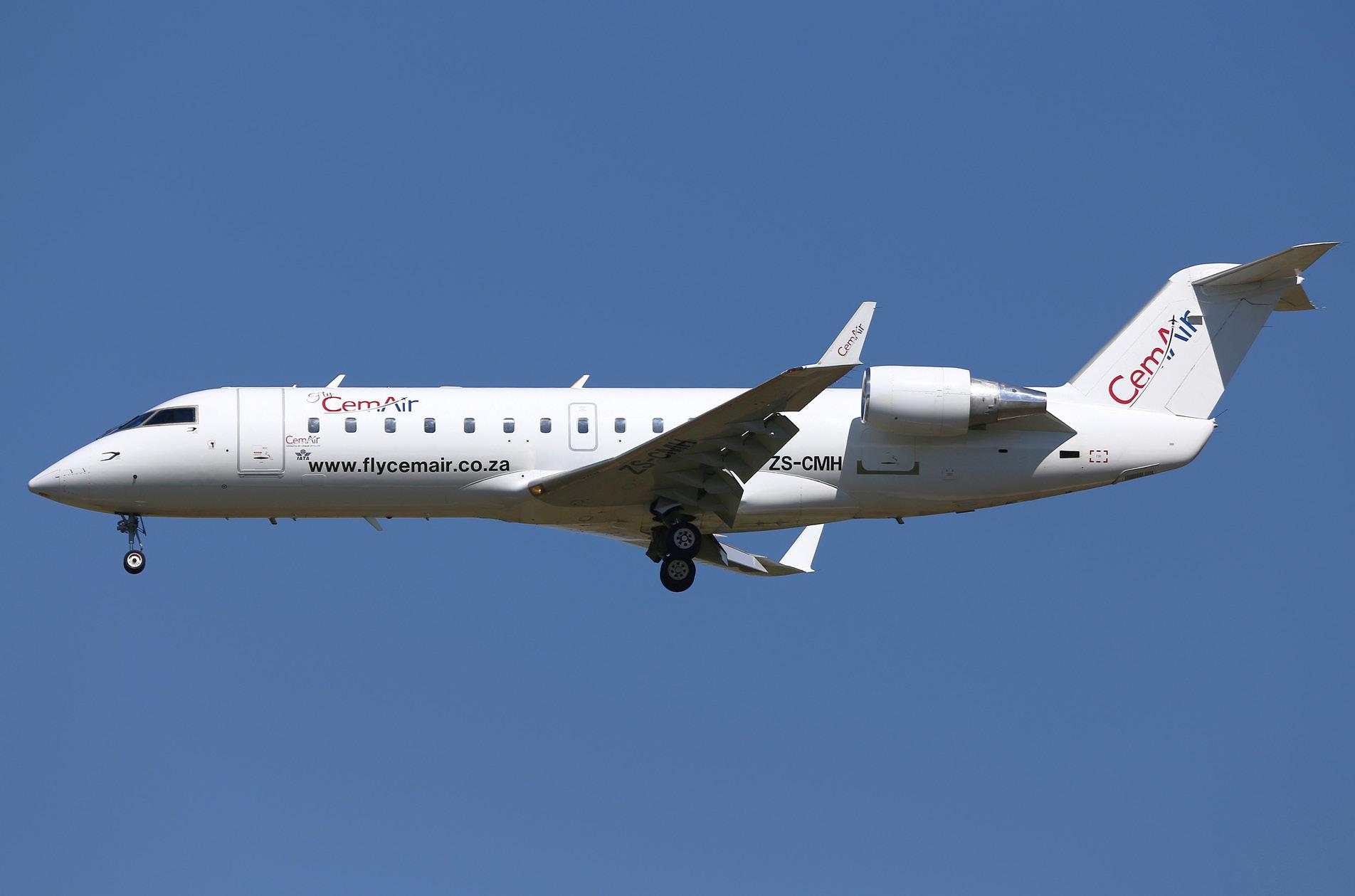
51 May 2024
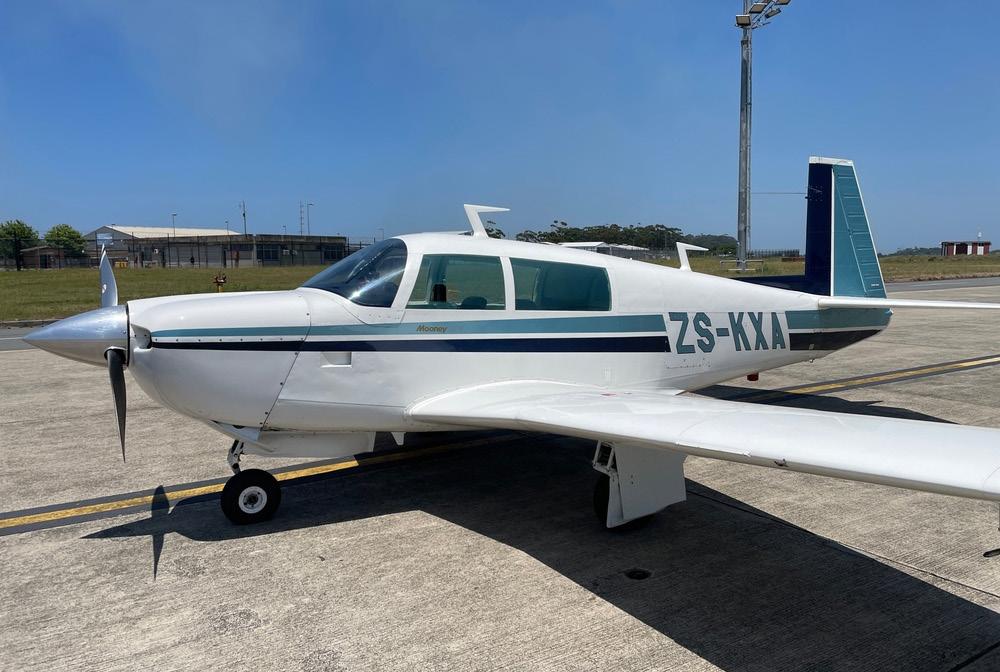
ABOVE: Mooney 201 ZS-KXA has been exported to an unusual destination - Hong Kong.
BELOW: ZS-VMX is, despite its ZS registration, a NTCA Rutan Long-Eze, now exported to the USA. Image Willie Bodenstein.
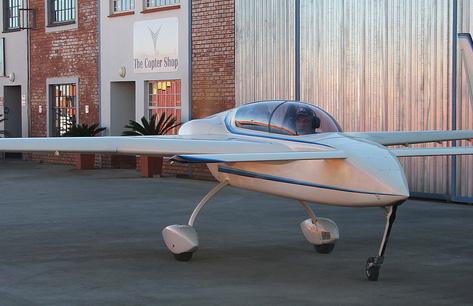
52 May 2024
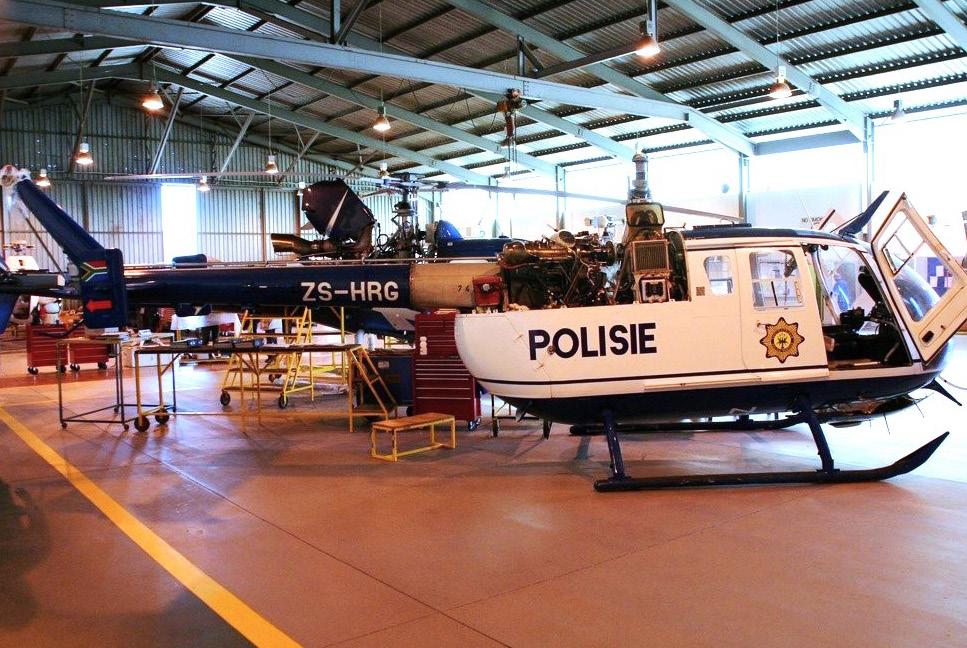
ABOVE: ZS-HRG is a former SAPS BO-105 sold on auction and now exported. Image Bill Teasdale. BELOW: A sad loss is Waco ZS-JMG which has been exported to the USA. Image Rob Holland.

53 May 2024
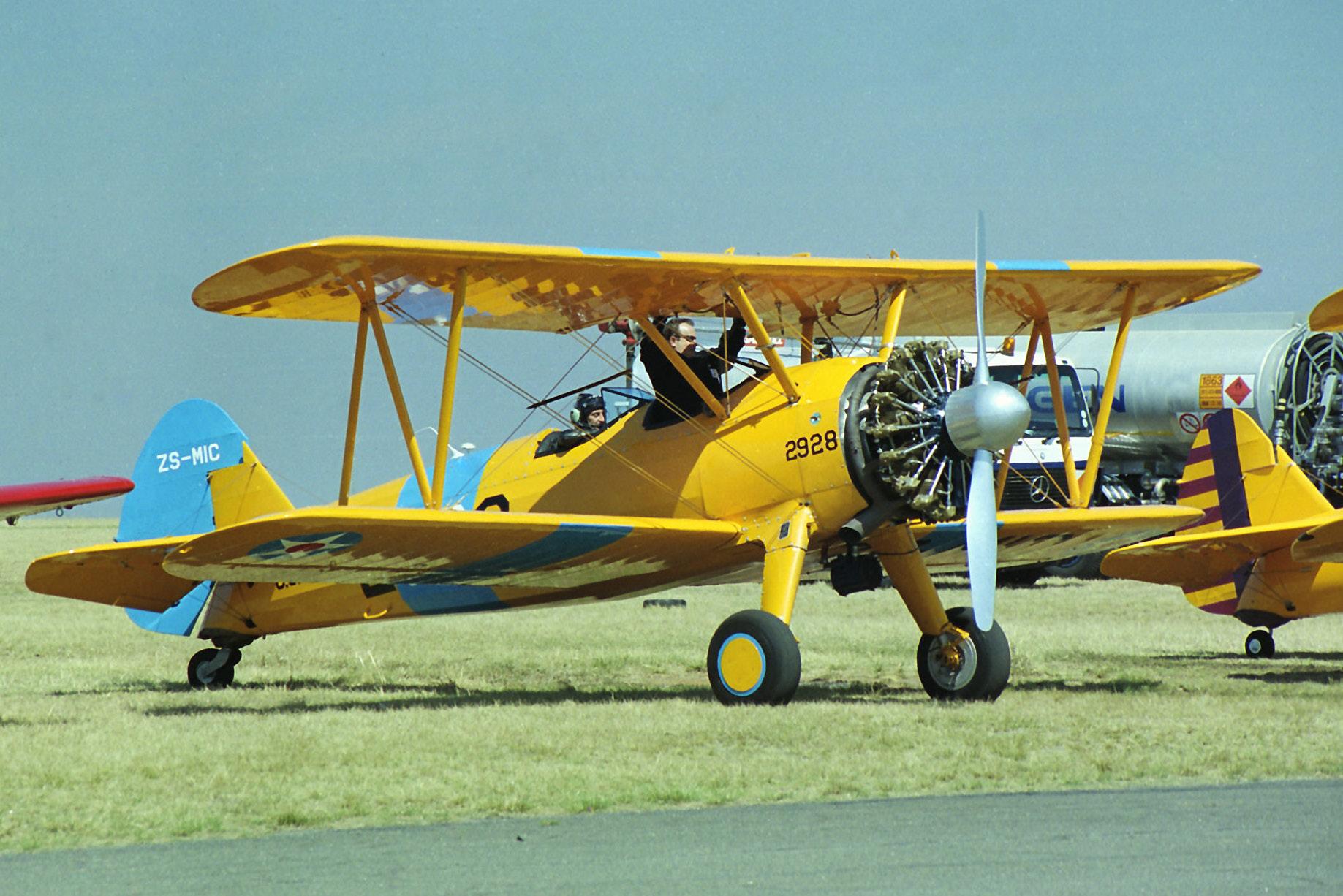
ABOVE: Boeing 75 Stearman ZS-MIC has also been exported. Image Bob Adams Wikimedia.
BELOW: ZS-GPT is a Schempp-Hirth Ventus B which has been exported.
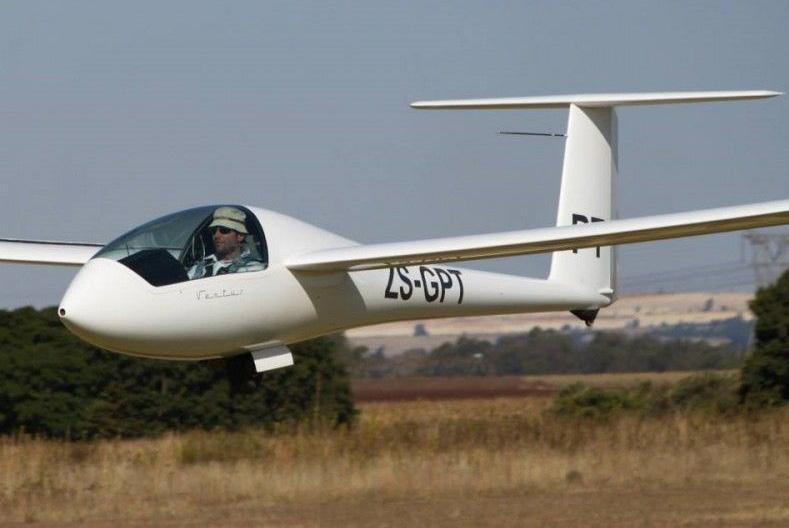
54 May 2024
ZU-ORI is the second VL3 to be registerd in South Africa. Image Willie Bodenstein.

new Airbus Helicopters H130 and another of the smart Bell 430s are the other new additions.
The sleek Bell 430 has become popular in both the corporate and medevac roles in SA and this latest addition is one of two recently imported into South Africa but the first of these to feature in these updates.
This helicopter was built in 1998 and delivered as N8151Y. It was then sold to Turkey where it flew as TC-HTA before its sale to the Kuwait Ministry of Health where it flew as 9K-BBB. It was then sold to a corporate owner in the USA, taking up the registration N965BP before being imported into South Africa and being cancelled from the US Civil Aircraft Register on 18 January of this year.
The NTC section of the register sees six additions with one each of the popular Jabiru J430, and the locally designed and manufactured Sling 4 TSI and Bat Hawk R. A JMB Aircraft manufactured plane ZU-ORI is the second of the sleek new generation VL3s to be imported into South Africa. A Glasair II-S and EXR 540 are the other two additions.
There is a bit of an exodus of planes this month and it unfortunately includes two lovely biplanes – a Boeing Stearman and a Waco, that both depart to the USA. It is really sad to see these lovely radial engine planes leaving our skies. Other exports include a Mooney M20J that moves to Hong Kong. A Cessna 206 relocates to Kenya and will no doubt be flying in support
of the country’s wildlife tourism industry.
A Ventus glider has left to Germany while a Shadowlite Jabiru J430 departs to Nigeria.
The Cemair CRJ200 is cancelled to Gabon to facilitate its operations while on contract to a Gabonese carrier. One of the unique Rutan Long-Eze planes, ZS-VMX, is cancelled but with no additional information. This aircraft had been advertised for sale in late 2023 so it is assumed it must have found a new home outside of South Africa.
The single helicopter deletion this month is an interesting one. BO-105 ZS-HRG is listed as exported to Turkey. This is a former South African Police Service Airwing operated BO-105 that is one of the airframes sold on auction following their retirement from service. This helicopter was recently noted doing test flights following a period of maintenance to restore it to an airworthy state. There still seems to be a lot of life left in this and the other similarly-retired BO-105s that are all again being restored to airworthy condition.
Several of our readers have contacted us about aircraft not appearing in the register updates. We are trying to resolve this matter but we are limited to publishing the lists kindly supplied by the SACAA but we request that should you know of any omissions you contact Guy Leitch or myself via email. We always appreciate hearing from our readers! j
55 May 2024
ZT-HEA
M & N Acoustic Services (Pty) Ltd
ZS-CME
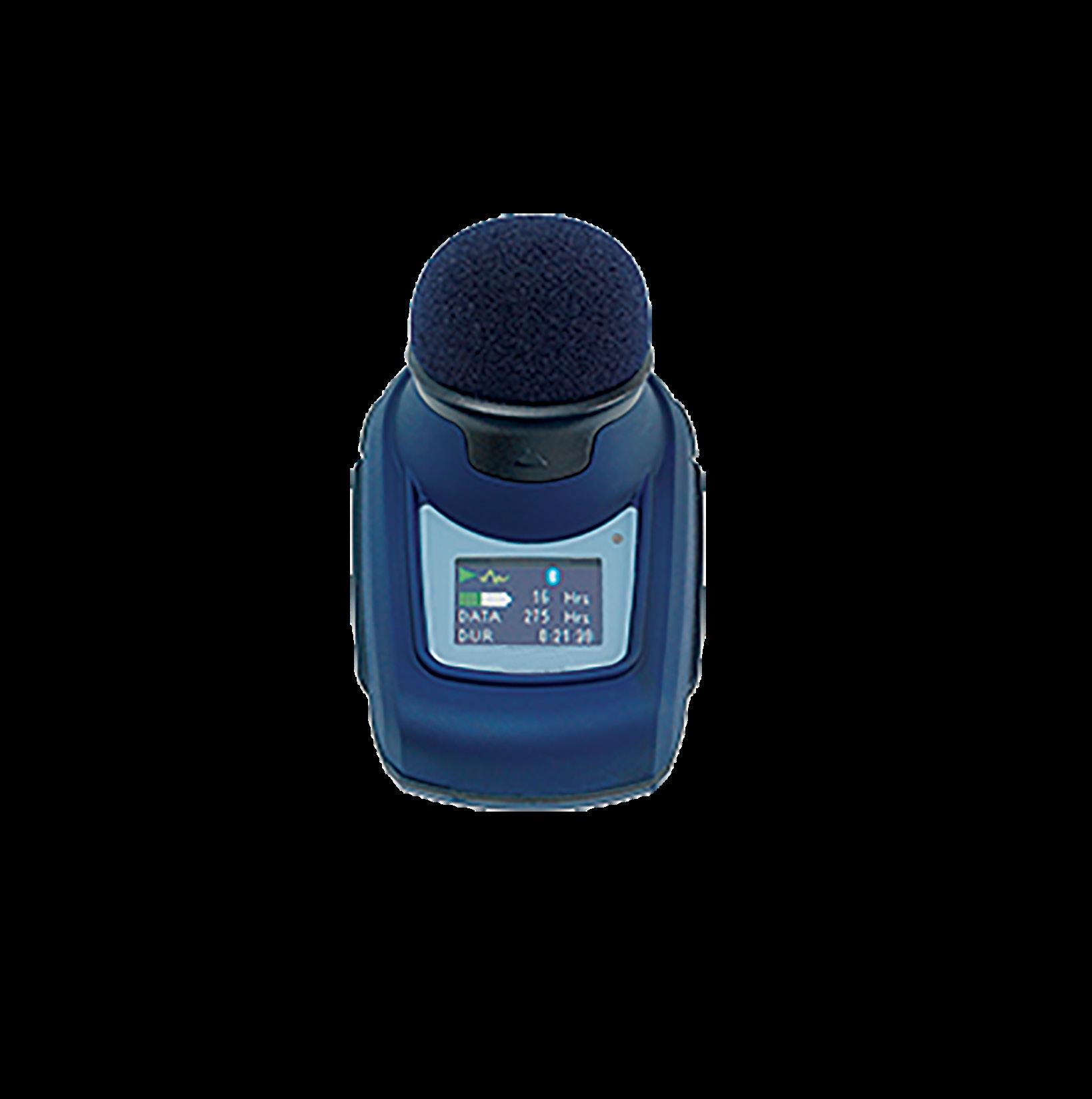
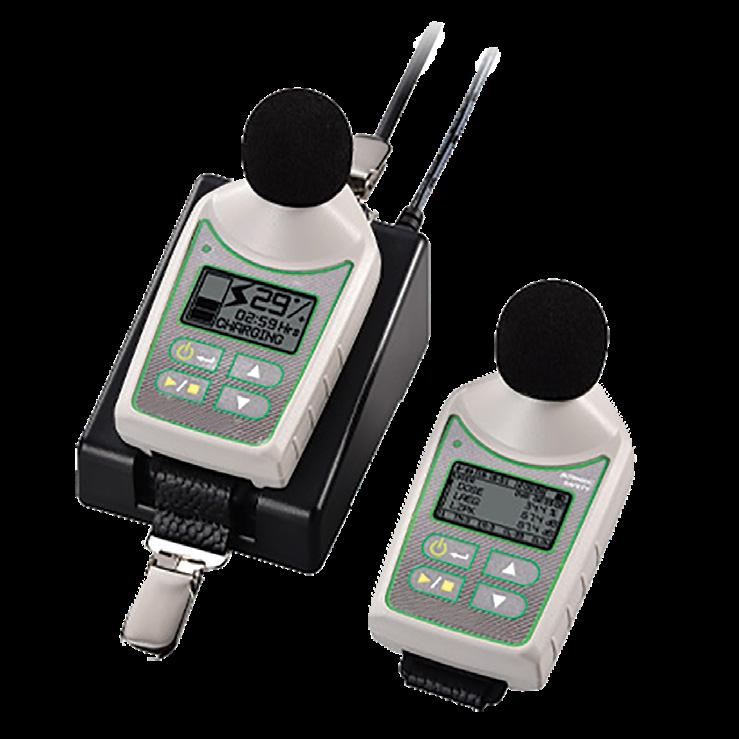


REGISTER REVIEW MARCH
Tel: 012 689 2008 I Cell: 076 920 3070 We perform SANAS certifications on all your: Electrical DC/LF Equipment – inhouse or on site (eg. Fluke Multimeters, Insulation Testers) SANAS Accredited Laboratory REG MANUFACTURER TYPE NAME SERIAL NUMBER PREVIOUS IDENTITY / EXPORT COUNTRY New Registrations ZSZS-EAH Beech Aircraft Corporation 1900D UE-424 ZS-CMH Bombardier Inc. CL-600-2D24 15081 ZS-TJA Bombardier Inc. CL-600-2B19 8100 ZS-XCA Cessna Aircraft Company 208B 208B-0764 New Registrations ZTZT-REK Robinson Helicopter Company R44 II 11144
2024
Airbus Helicopters EC 130 T2 8861 ZT-RNX Bell Helicopter Company 430 49043 New Registrations ZUZU-IZW Sling Aircraft (Pty) Ltd Sling 4 TSI 506S ZU-ORI JMB Aircraft S.R.O VL-3T3-915 546 ZU-RIS Erika du Plassis EXR 540 01 ZU-JAE Micro Aviation SA Bat Hawk R 1026 ZU-JAI Jabiru J430 1013
Jacob Kloosterzeil Glasair II-S 2247 Aircraft deleted ZSZS-JMG Waco Aircraft Co. YMF F5015 USA ZS-MIC The Boeing Company A75N1 75-2936 USA ZS-KXA Mooney Aircraft Corp. M20J Hong Kong ZS-LYX Cessna Aircraft Company U206G U206-05227 Kenya ZS-GPT Schempp-Hirth Flugzeugbau GmbH Ventus B-16.6 207 Germany ZS-VMX Rutan Aircraft Factory Long-Eze DHO-01 Cancelled
ZU-JAH
Bombardier Inc. CL-600-2B19 7293 Gabon
Eurocopter Deutschland GmbH BO105 CBS-5 S-742 Turkey Aircraft deleted ZUZU-IYA Shadow Lite CC
ZS-HRG
M & N Acoustic Services (Pty) Ltd
We perform SANAS certifications on all your:
Acoustics ( eg. CEL 350 )
Vibration ( eg. Rion VA -11)
Human Vibration ( eg. Quest Hav Pro)
Electrical DC/LF Equipment – inhouse or on site (eg. Fluke Multimeters, Insulation Testers)

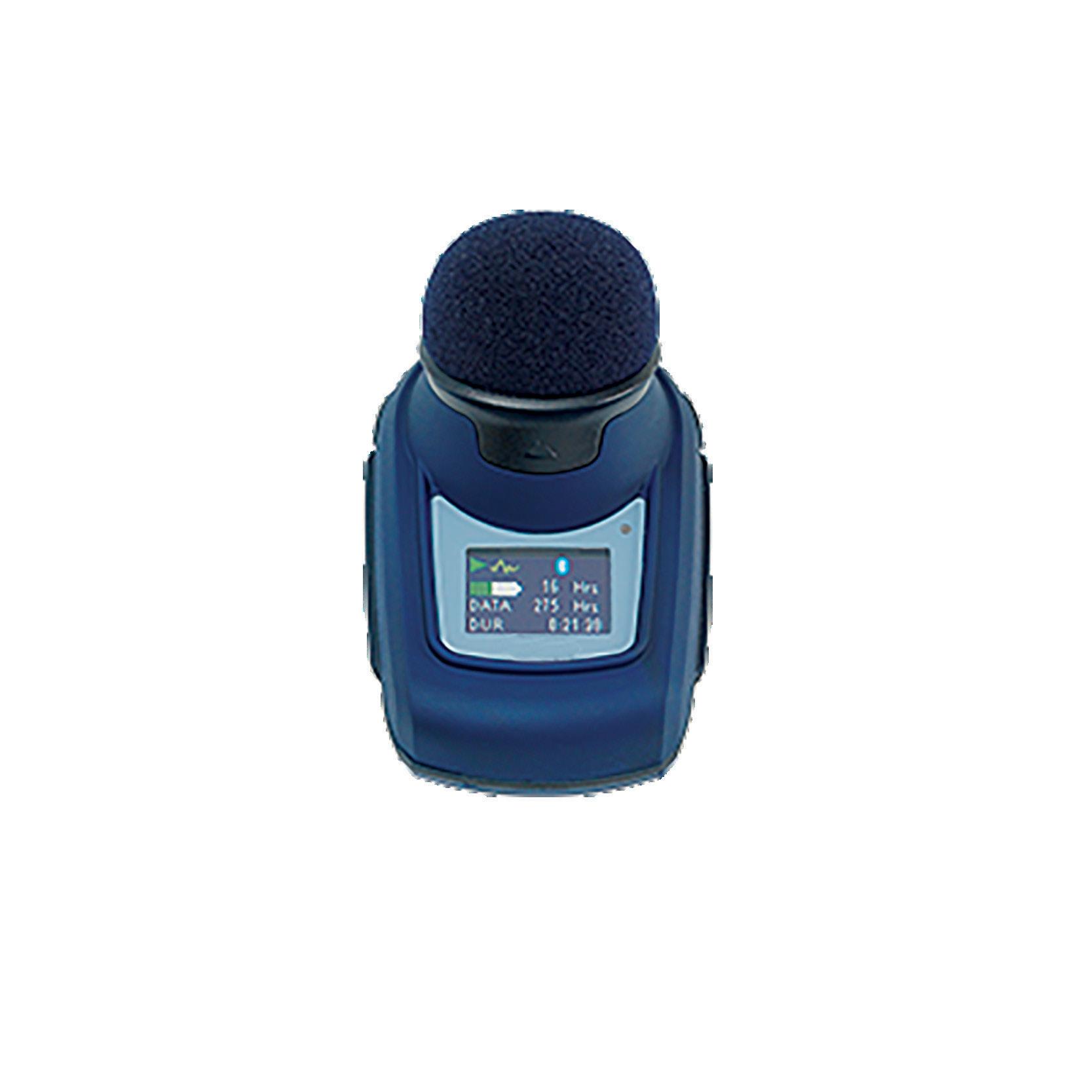


QUOTATIONS ON REQUEST
Contact: Marianka Naude Tel: 012 689 2008 I Cell: 076 920 3070 Email: admin@mnacoustics.co.za SANAS Accredited Laboratory 1302 & 148
HELICOPTER SERVICES

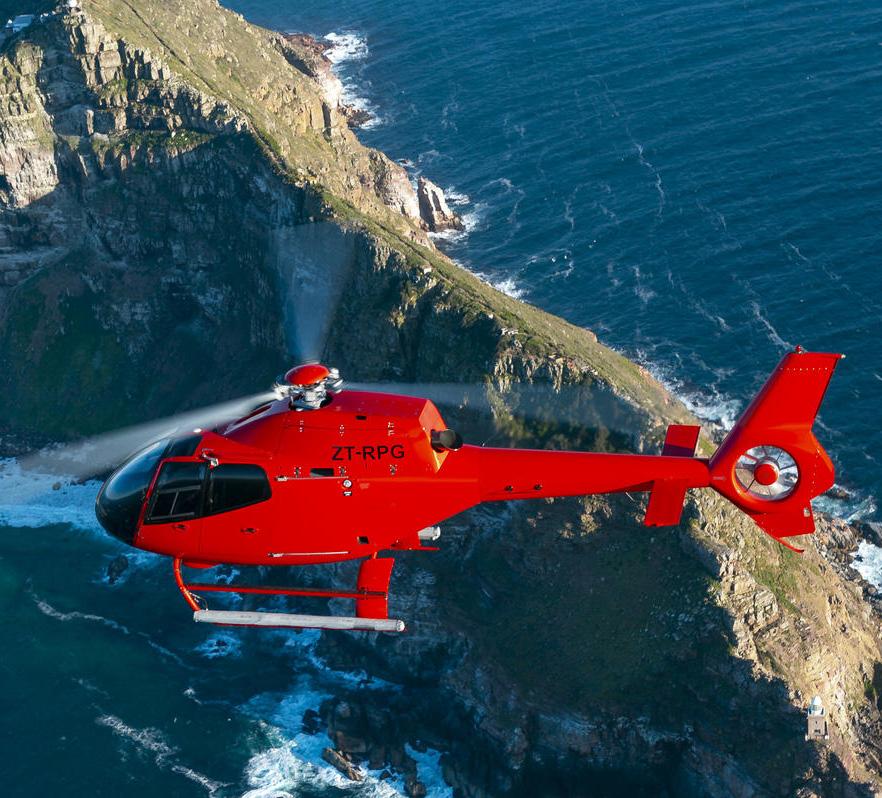
www.saflyer.com SA Flyer Magazine Helicopter Services Directory COMPANY NAME TEL NO WEBSITE Airbus Bell Robinson Leonardo Sikorsky Enstrom Other Sales Maintenance Training Charter FBO HEMS Offshore Wildlife Tourism Other CAPE TOWN NAC (021) 425-3868 www.nachelicopterscapetown.com a Cape Town Helicopters (021) 418-9462 www.helicopterscapetown.co.za a a GEORGE Titan (044) 878-0453 www.titanhelicopters.com a a a a a LANSERIA NAC (011) 267-5000 www.nac.co.za a a a a a a a a NELSPRUIT Leading Edge (013) 741-3654 www.leadingedgeaviation.co.za a a a a a a RAND NAC (011) 345-2500 www.nac.co.za a a a a a a a VIRGINIA BAC (031) 569-1531 www.bachelicopters.com a a a a a a a a a a a NAC (031) 944-1678 www.nac.co.za a a a a a a a AGENCIES SERVICES
SUPPORTING LAW ENFORCEMENT IS CRITICAL MISSION
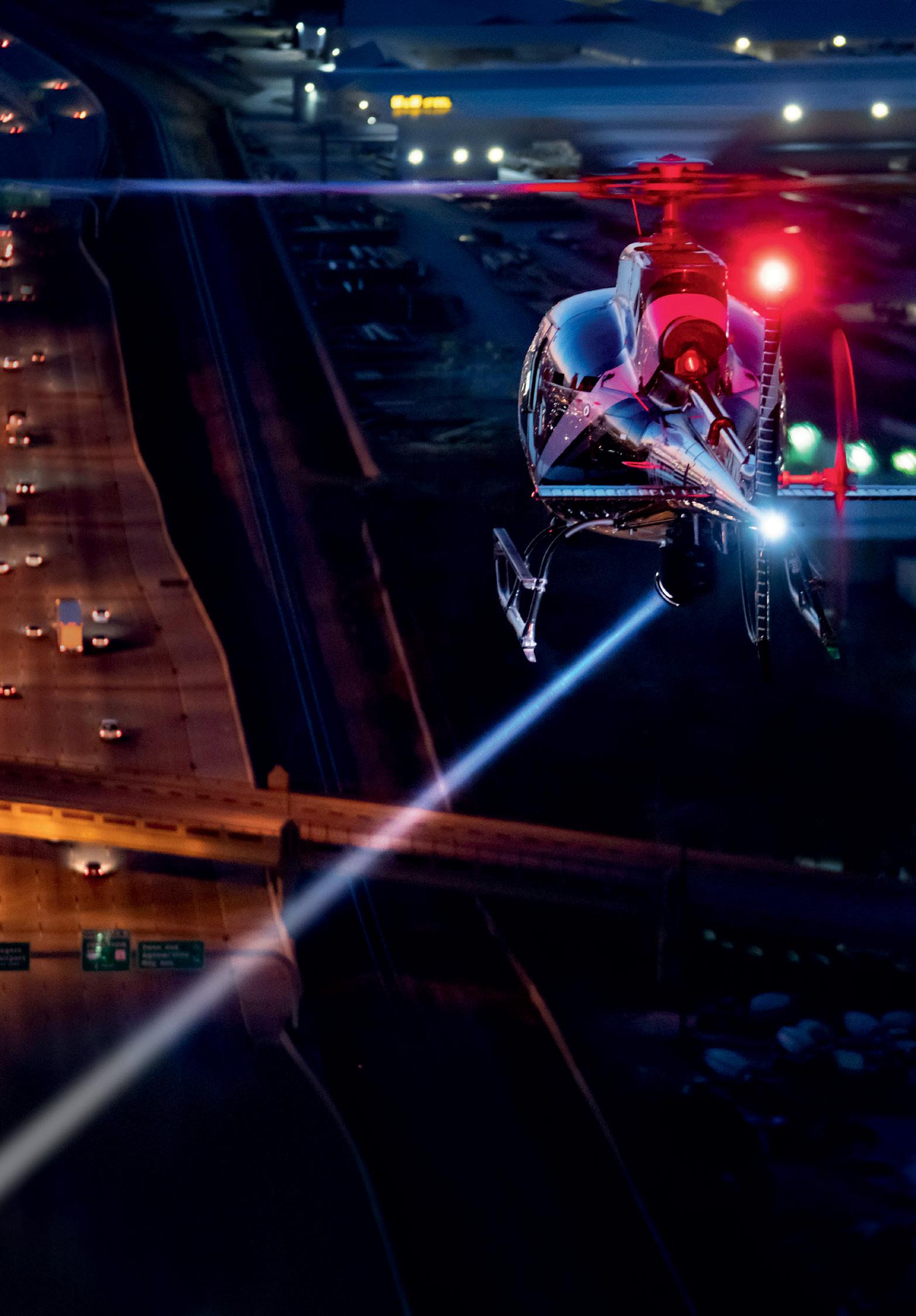
With surveillance and crime-fighting equipment vital to operations, our versatile range of helicopters perform a multitude of critical missions. Supporting law enforcement teams, who in turn support communities, Airbus proudly delivers cutting edge flight technologies that help keep the world a safer place.
airbus.com
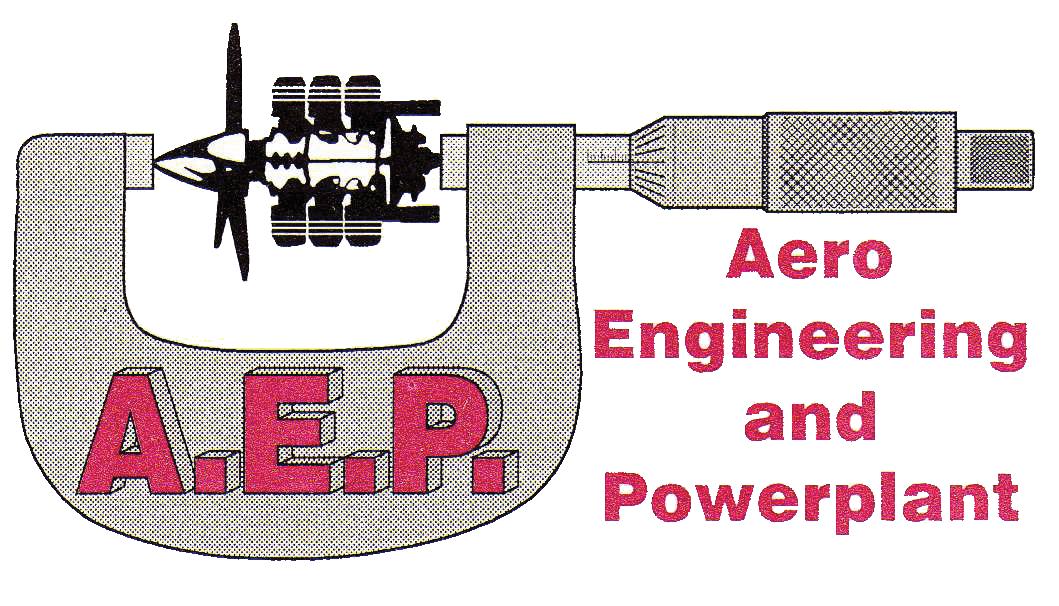

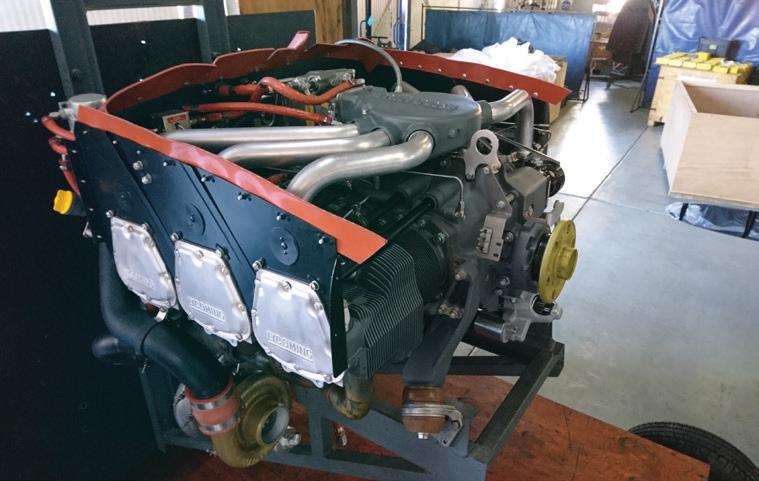
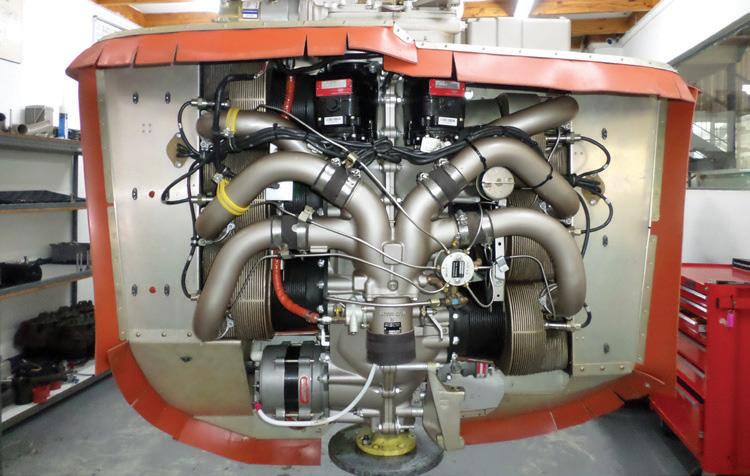
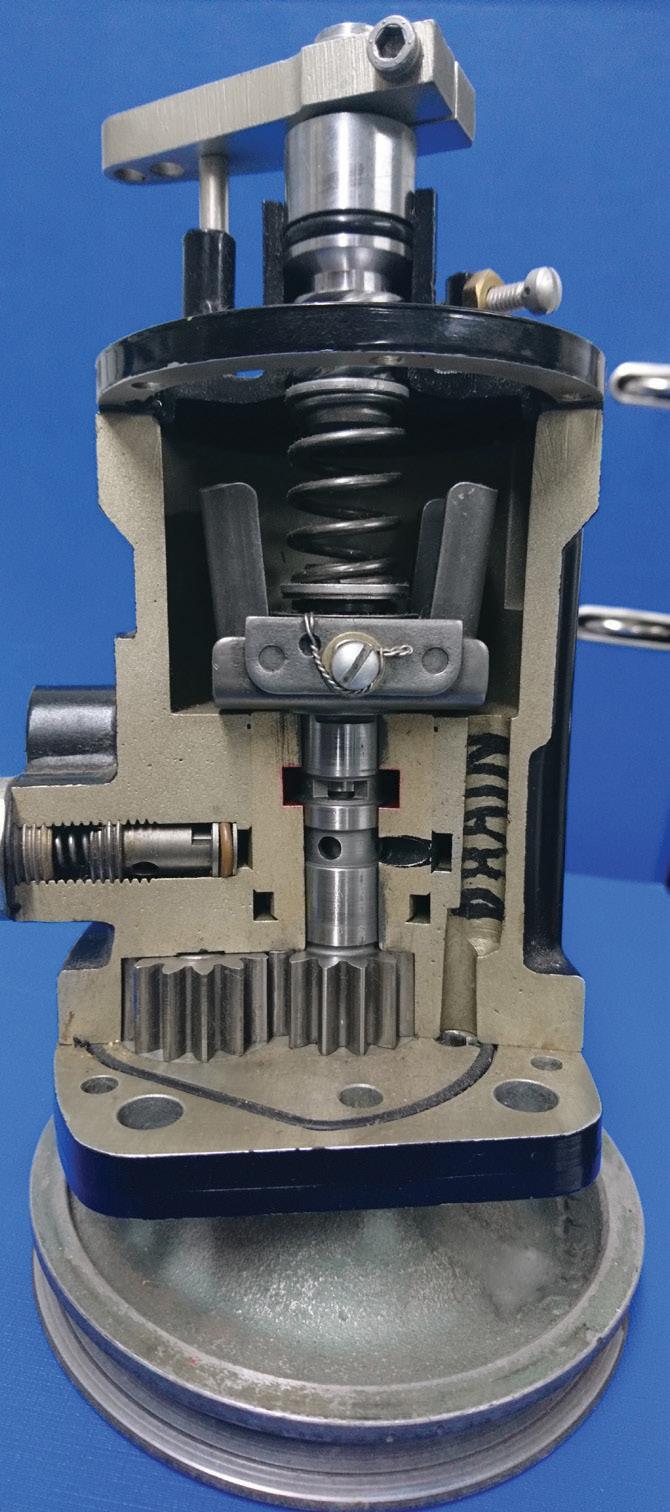

61 May 2024 Overhaul / Shockload / Repair of Continental and Lycoming Aircraft engines Overhaul Engine Components Overhaul and supply of Hartzell / McCauley and Fix pitch Propellers FLIGHT SAFETY THROUGH MAINTENANCE Hangar no 4, Wonderboom Airport, Pretoria PO Box 17699, Pretoria North, 0116 Tel: (012) 543 0948/51, Fax: (012) 543 9447, email: aeroeng@iafrica.com AMO 227
OVERCOMING HUMBLE BEGINNINGS
Barbara Harmer left school at the age of 15 without any qualifications to work as a hairdresser. After five years, she applied to become a trainee air traffic controller at London Gatwick Airport.
WHILE WORKING AT GATWICK, she started taking flying lessons after obtaining a £10,000 bank loan. She got her CPL in 1982 but was rejected by 100 potential employers. Then, in 1984, she got her first pilot job in a small airline, and within that year she joined British Caledonian. Then in 1987, British Caledonian Airlines merged with British Airways.
After four years flying DC-10s, she was selected to train as Concorde pilot, becoming the first woman to qualify. After Concorde she captained the Boeing 777 until 2009, when she retired to
sail her yacht across the Atlantic. But she had developed ovarian cancer.
Captain Harmer, who never had children, died in 2011 at the age of 57, leaving behind her husband of 27 years.
She started low in life, climbed and then soared. Her legacy is an inspiration to women and youngsters everywhere. Through her pragmatic, can-do attitude, she achieved success in a male-dominated industry.
j
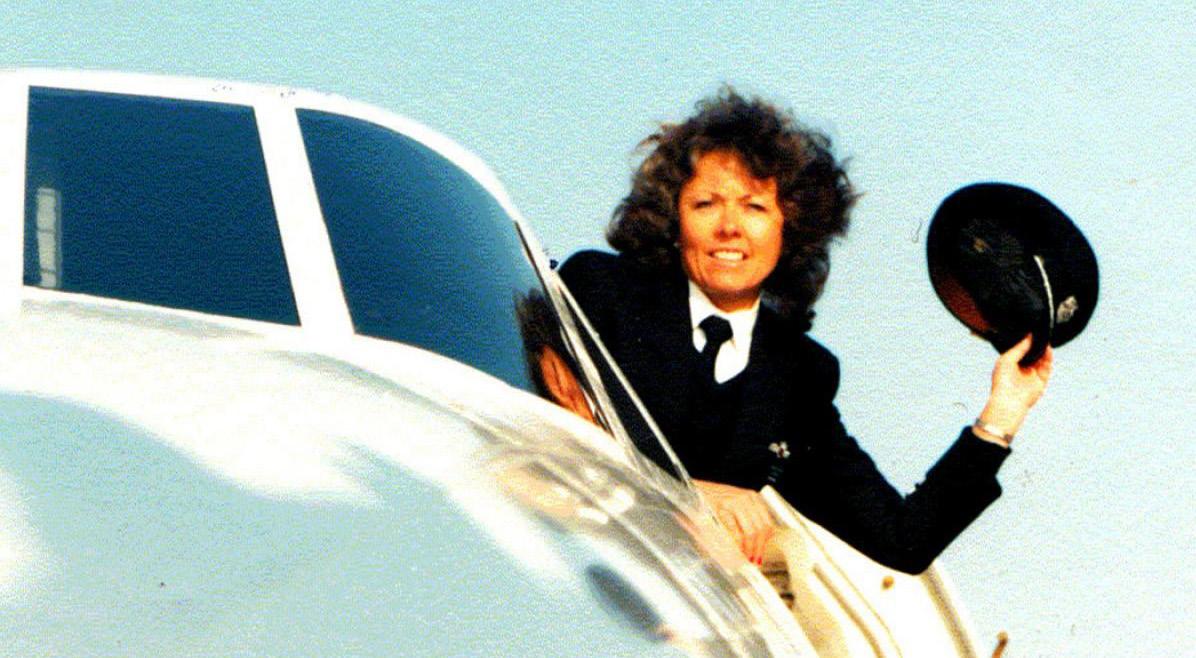
62 May 2024 HISTORIC NEWS
Barbara Harmer overcame great odds to fly Concorde.
QUOTE OF THE MONTH
Joachim Vermooten
QOM
Reacting to SAA’s claims that, after the collapse of the Takatso deal, it would seek private investors and list on the JSE, in a masterful understatement, noted aviation economist Joachim Vermooten, said,
“Until you have a proper accounting system in place, you’re unlikely to find many investors.”
BOOKS
by Peter Garrison

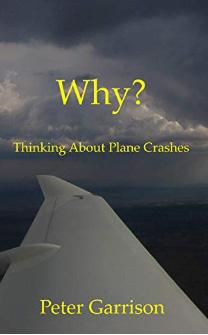


63 May 2024
AERO FRIEDRICHSHAFEN 2024 – FULL REPORT
This year was the 30th year of Aero Friedrichshafen, a General Aviation expo for pilots and knowledgeable owners of planes.
The organisers claim that a high percentage of the 27,200 visitors hold a pilot’s license.
WITH MORE THAN 650 EXHIBITORS from 35 countries, 35,000+ attendees and 500+ journalists from all over the world, AERO Friedrichshafen once again maintained its focus on both traditional designs and future trends.
Unlike conventional airshows, AERO features static displays inside hangars, rather than flying
displays, as for instance Oshkosh AirVenture does. Given the German weather, it is perhaps appropriate that the organisers were not relying on the gee-whizz crowd pull of an airshow.
The American based OEMs happily make the trip to support this expo. Cirrus, Textron, Piper, Garmin and Boeing subsidiaries Jeppesen and
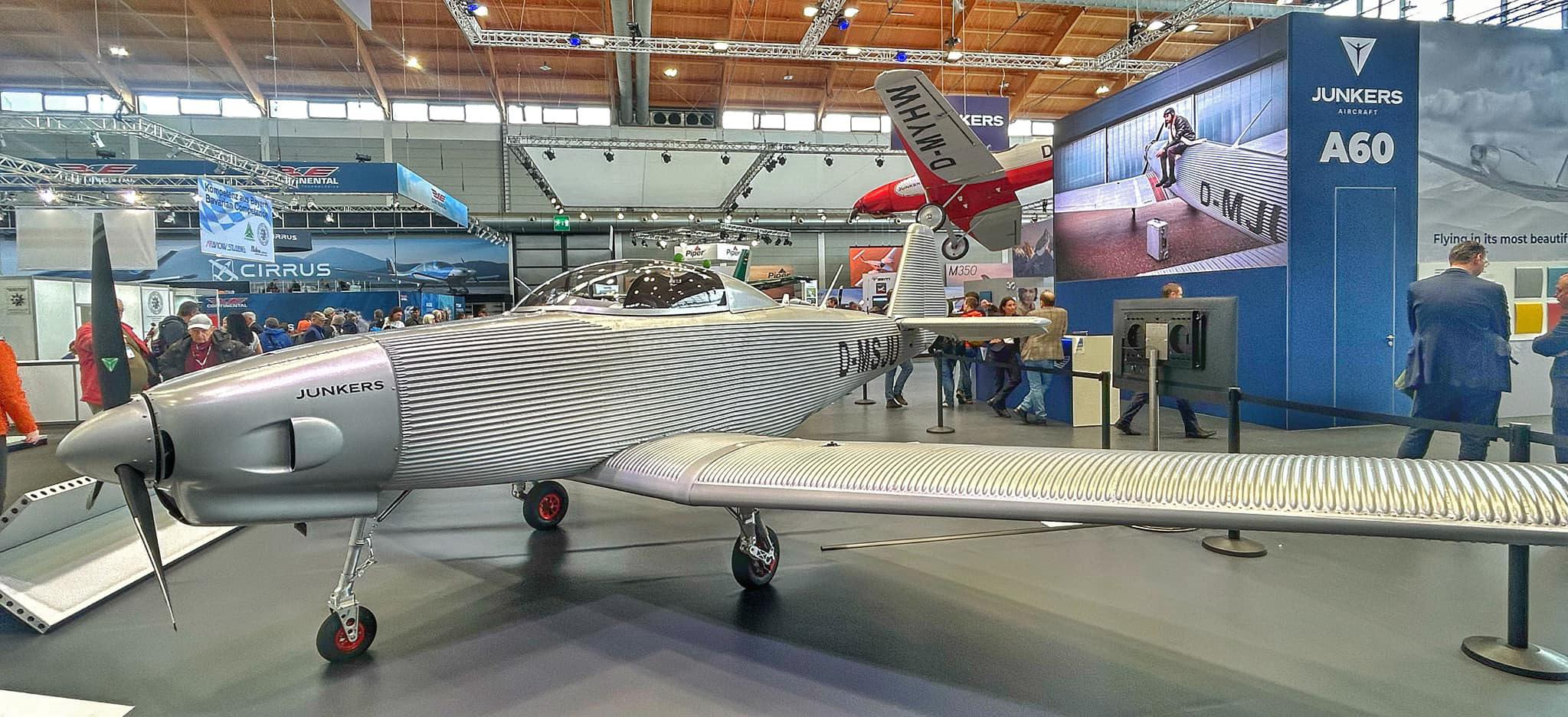
Text Guy Leitch. Images Duncan Gillespie. The re-imagined Junkers A60 was again big this year.
64 May 2024
AIRSHOW
The military was also there - a Luftwaffe Eurofighter.
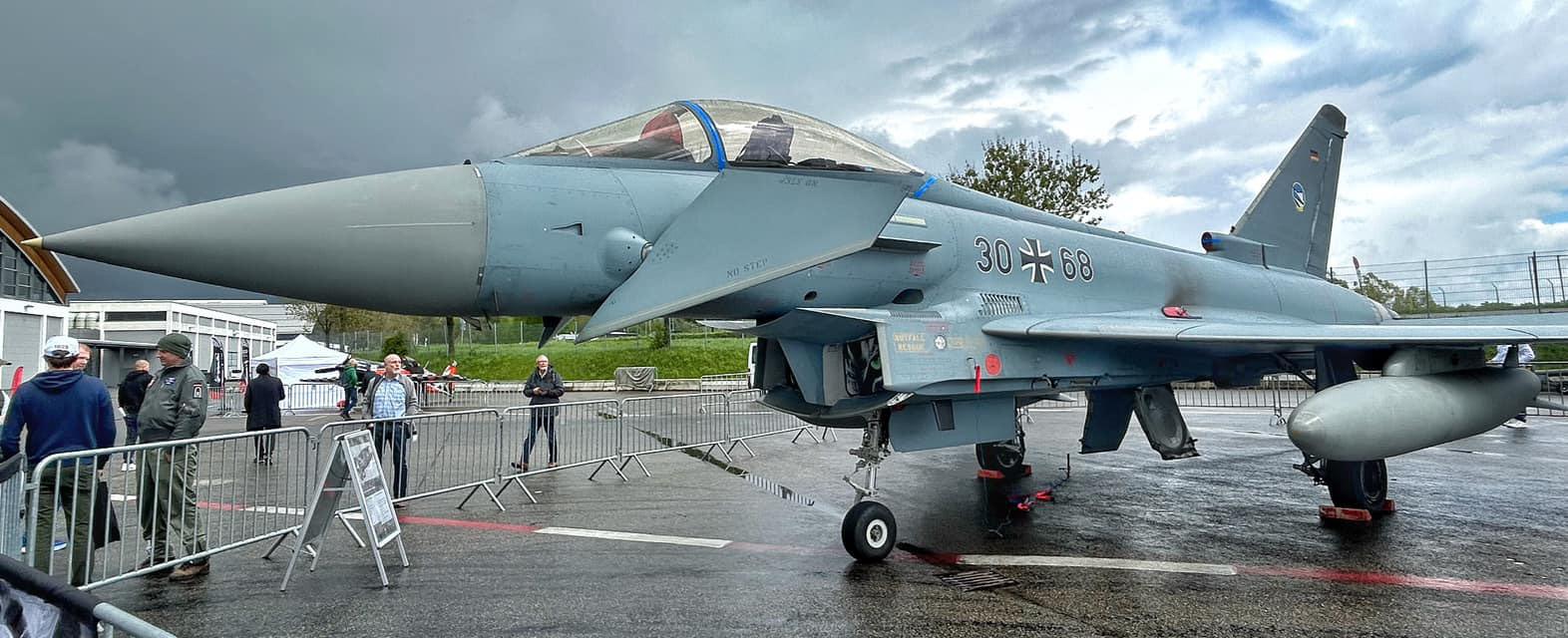
Foreflight were prominent. Gulfstream displayed their G500 and there was in interesting Bombardier Global with a Lesotho flag yet Malta registration.
The expo can be divided into specific categories and themes. Always of interest are new engines – either of the internal combustion (ICE) variety or electric. European daily life is marked by a pervasive concern about carbon emission reductions, sustainable fuel, and the technology
that advances those goals. This is reflected in Aero’s dedication to tracking progress in alternative propulsion schemes.
This year marked the eleventh year that Aero dedicated exhibit halls to what it calls “e-flight expos.” There was a plethora of designs making use of battery-electric and hydrogen-powered airplanes—some of which are certified under EASA rules. This year’s e-flight expo had over 100 exhibitors.

65 May 2024
A Rotax 912-powered Stampe SV4 clone.

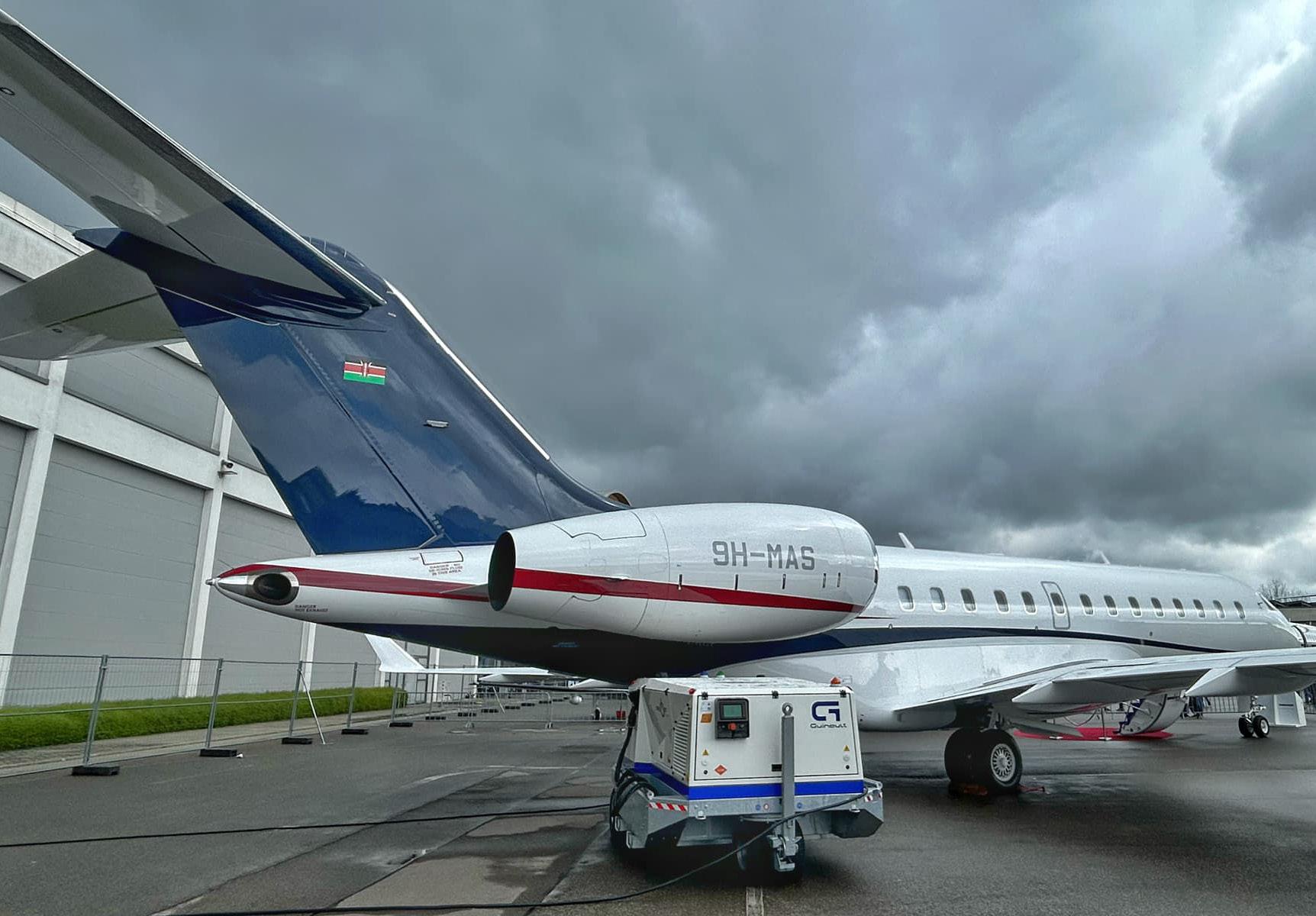
66 May 2024
A Bombardier Global 5500. Maltese registered with an African flag on the tail. Interesting.
Textron brought a King Air 260.
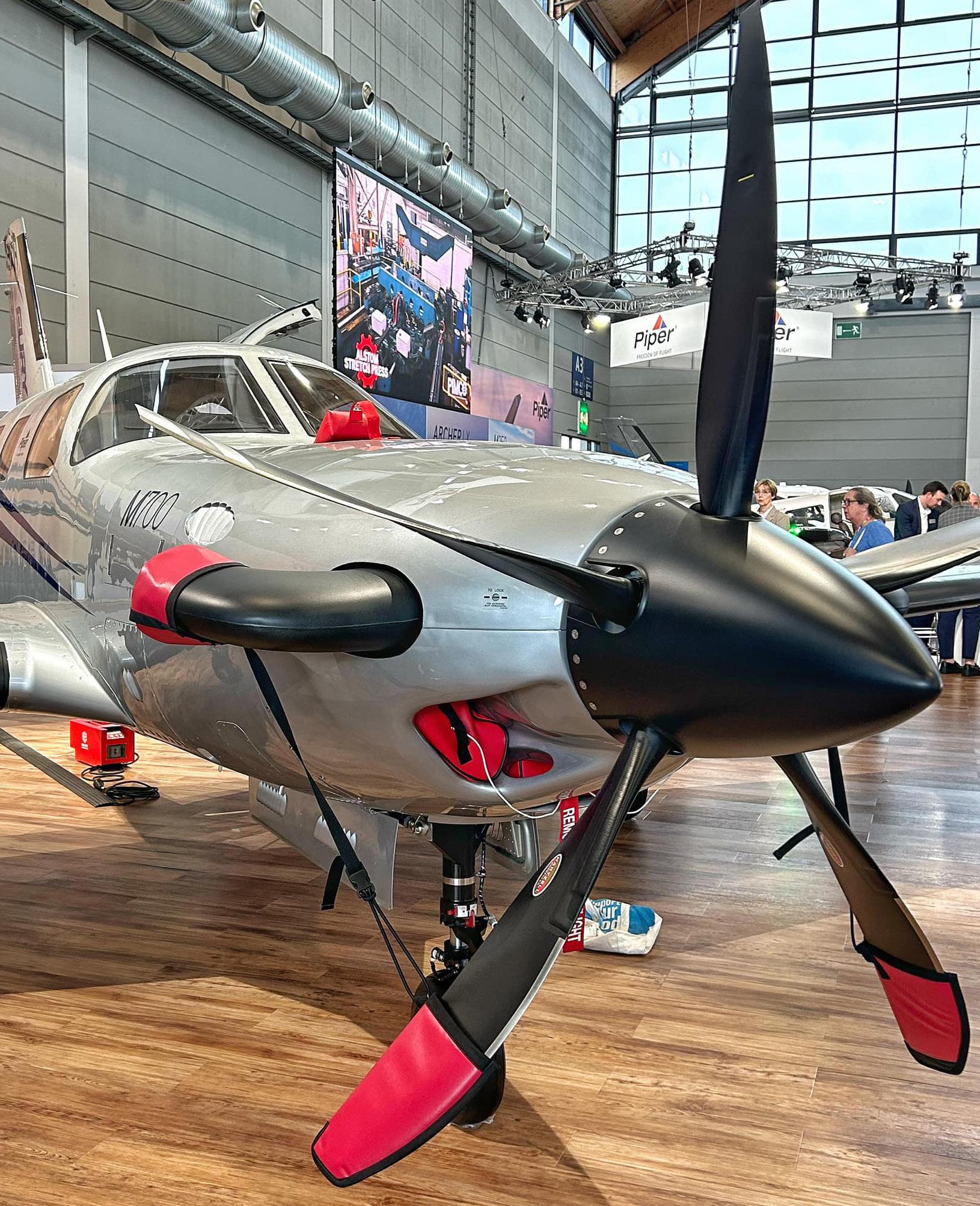
67 May 2024
Piper’s new M700 Fury.

68 May 2024
A Bristell XL8 experimental with the French TurboTech 160 HP powerplant.
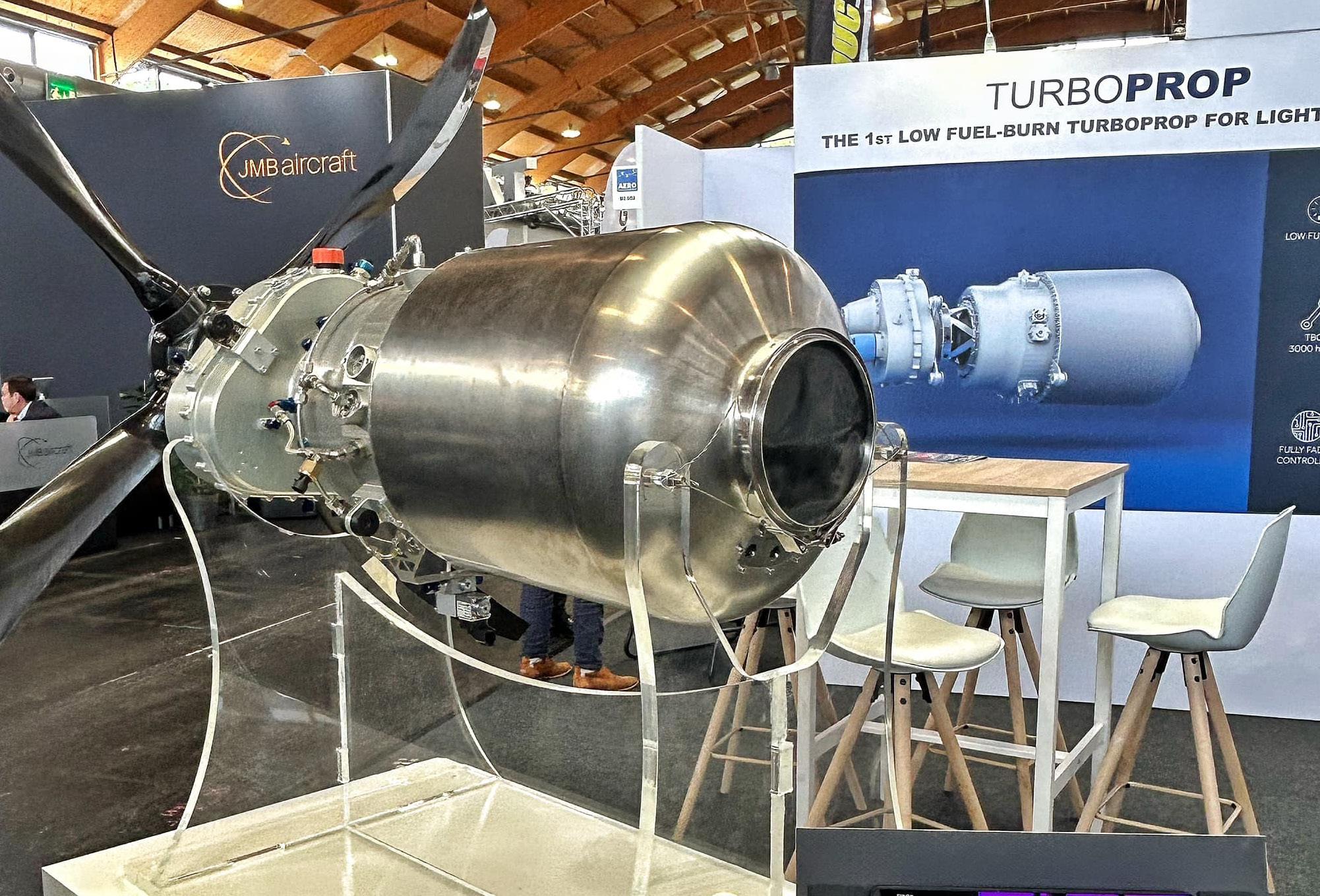
There is a rich vein of new technology designs and pure research efforts. Technical universities in Germany and other European Union states sponsor programmes that allow students to learn the science behind electric and hydrogen propulsion. One large exhibit area showed off the work of students at six different German universities and Technikons.
Aero Friedrichshafen is all about the latest innovations and draws in the first movers and early adopters—from gliders to jets.
Engines
While the aerospace industry globally has agreed to decarbonize by 2050, as of now, the only answer on the market is the very limited two-seat electric trainer, the Pipistrel Velis Electro. Other non-carbon fuel planes nearing EASA certification are all on the motor glider and very light end of the scale.
Woman power remains a challenge
There is always an amazing variety of power plant ideas on view at AERO. One key trend is the need for power solutions using non fossil fuel sources, which is at a critical juncture in the European Union.
Better range in larger and faster planes currently require hybrid power solutions, such as the joint Daher/Airbus/Safran EcoPulse demonstrator, which features six electric Safran motors distributed on a TBM’s wings, and a standard Pratt & Whitney PT6A-66D turboprop on the front end. This project has logged 35 flights total, 14 of which have been flown on electric power. As it enters final testing the lessons learned will go into a new product, the EcoPulse.
Like full electrification, hydrogen has been slow to develop as a practical alternative. A
69 May 2024
The TurboTech 130 shp turbine.
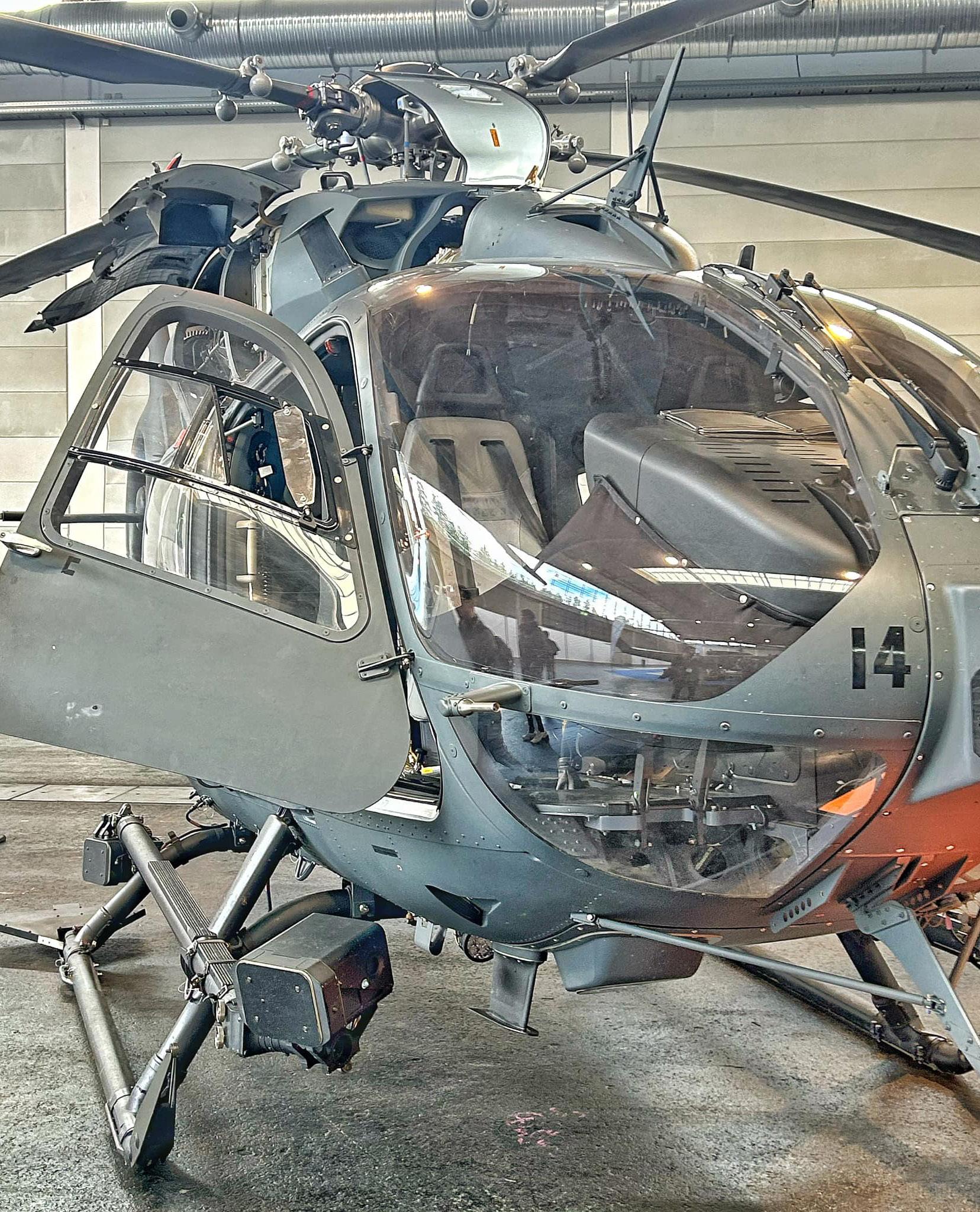
An Airbus H135M (originally the Eurocopter EC635) - the military version of the Airbus 135.
70 May 2024
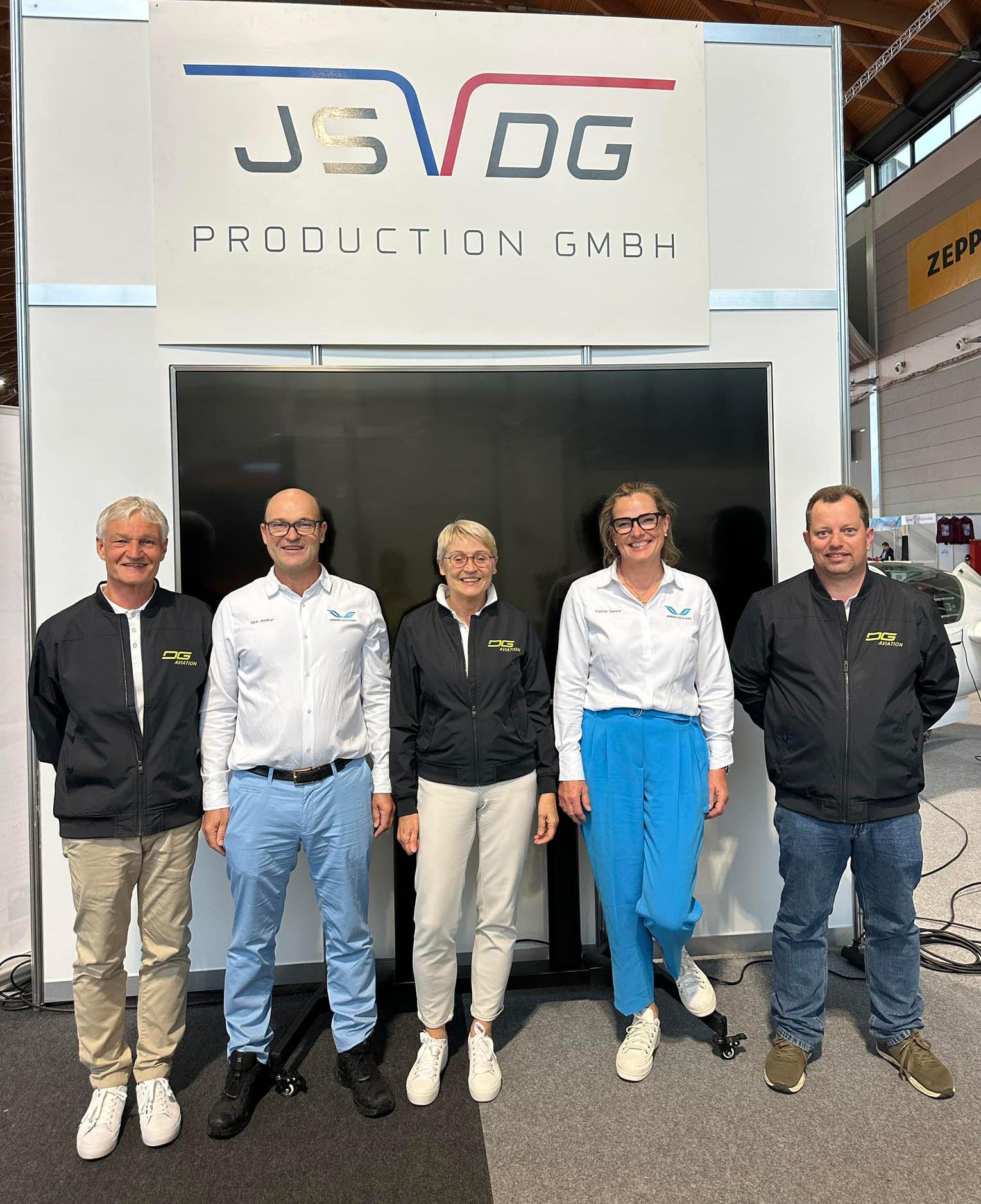
71 May 2024
DG Aviation joined forces with Jonker Sailplanes aas the newly established JSDG Production GmbH.
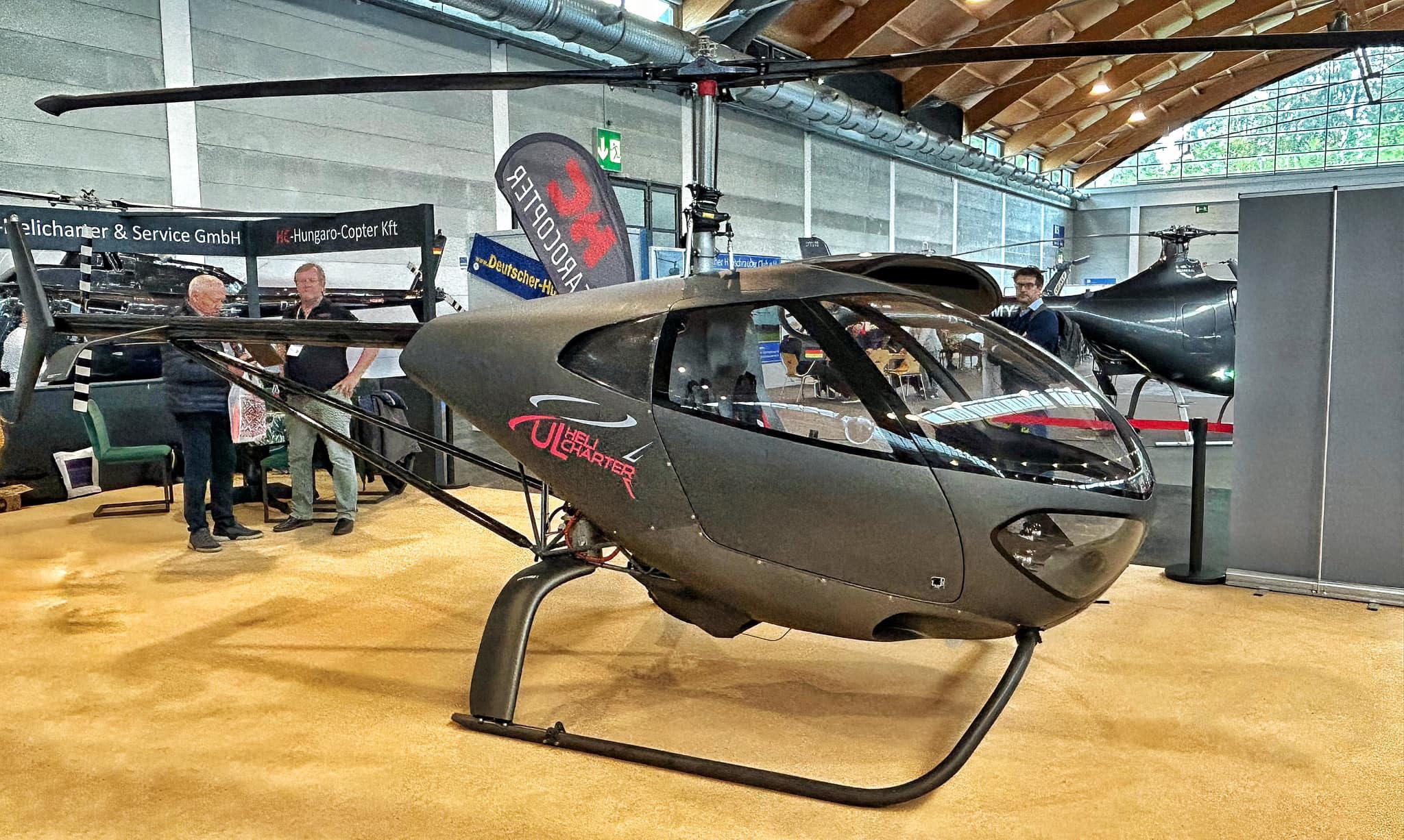
choice must be made between the use of liquid and gaseous hydrogen. Further, it will require massive changes to the current airport infrastructure.
Also prominent this year was Turbotech’s lightweight 130 shp turbine. This is hot news because it can burn sustainable biofuel alternatives to JetA – and Avgas.
Aero is good for anticipating industry trends, the drag of regulation, and economic and cultural pressures. In several forums discussion continued from past years has taken on greater urgency.
In the short and medium term, however, the industry must move to unleaded Avgas in Europe as soon as January 2025, according to

72 May 2024
A SMALL helicopter - the Hungaro Copter powered by a Rotax 915.
Drones are big at AERO - and this one is really big
A BIG helicopter - a German Army NH90. So many sensors!

73 May 2024
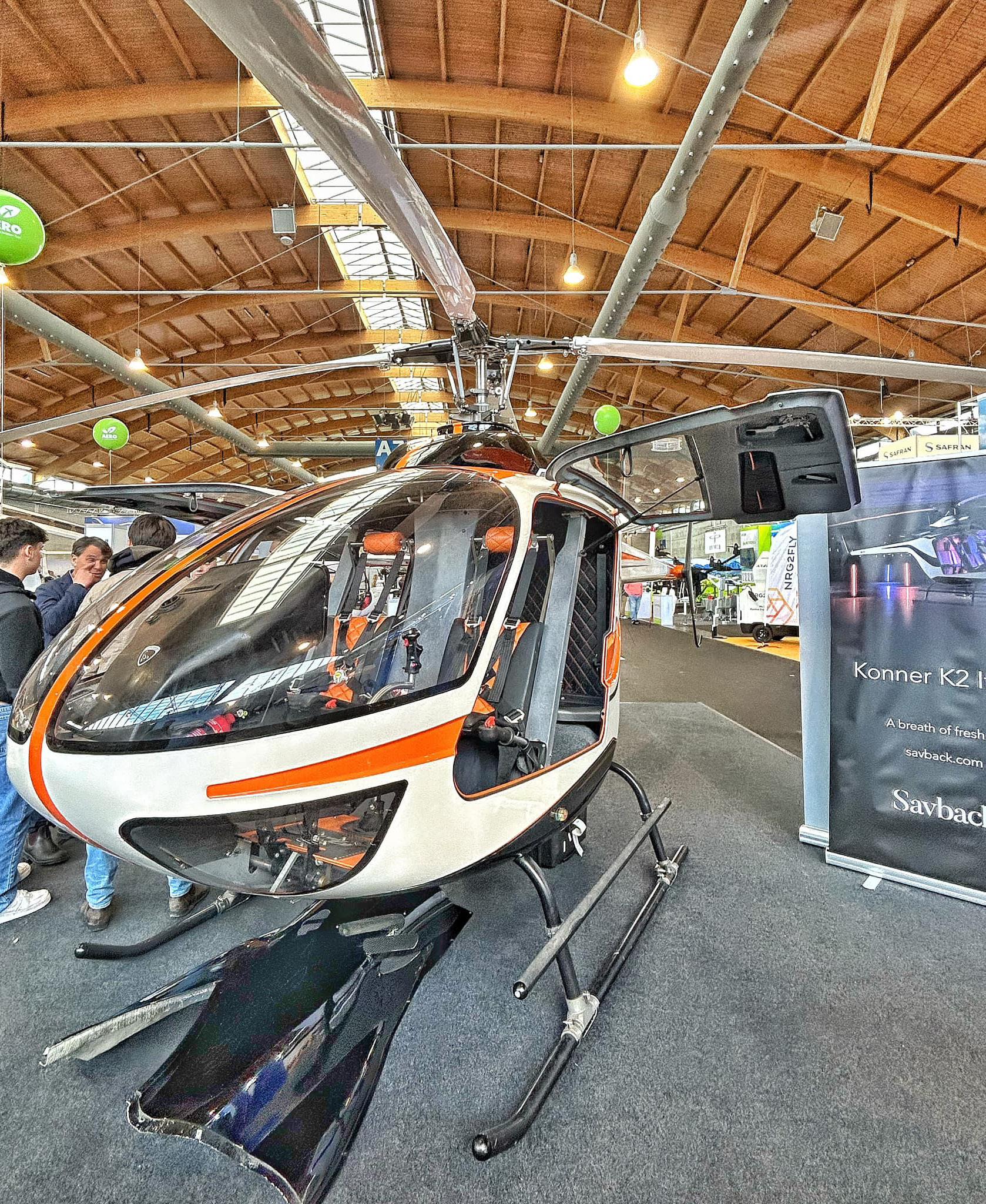
74 May 2024
A newcomer- the Konner K2 Italia helicopter.
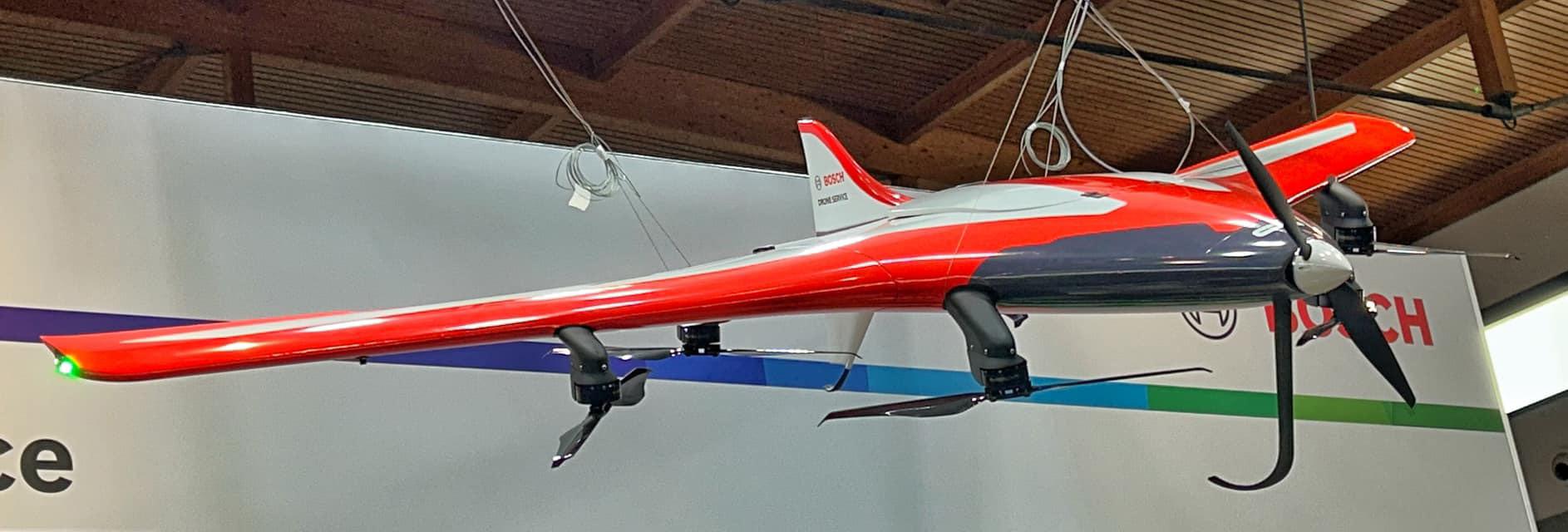
GAMA. Pressure on Avgas has triggered piston manufacturers such as Diamond and Tecnam to re-engine their fleets to burn JetA.
Tecnam introduced an upgraded version of its twin, the Tecnam P2006T NG. The Italian manufacturer has added an additional front door, larger windows, external access to the baggage compartment and an updated interior. Power is provided by twin Rotax 912iS engines for high altitude efficiency and reduced fuel consumption. A premium version with a leather interior is also available.
French aircraft manufacturer Elixir announced new production facilities in both France and the United States. The French site, the manufacturer’s third in France, will produce the composite fuselage and flight controls in Aytré. In addition, a reassembly plant will be located at Sarasota/Bradenton International Airport in Florida, intended for U.S. customers. A press release said, “The demand for Elixir aircraft in the American market is substantial, with over 200 units already pre-ordered.” It’s not cheap –prices range from $300,000 for the entry model powered by a Rotax 912iS engine to $400,000 for the more advanced version.
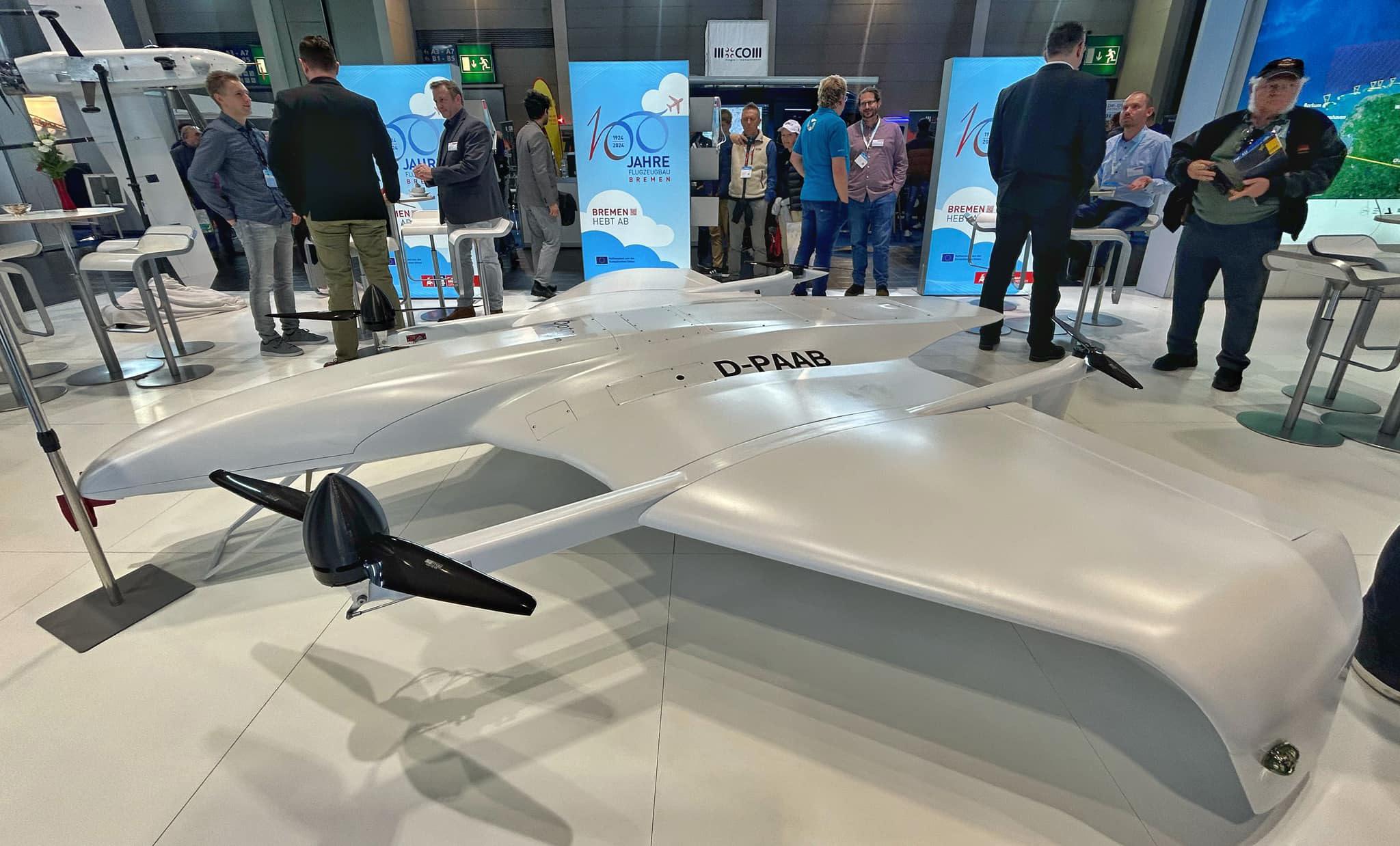
75 May 2024
Bosch is getting into the drone market.
Tilt-rotor drones remain popular.
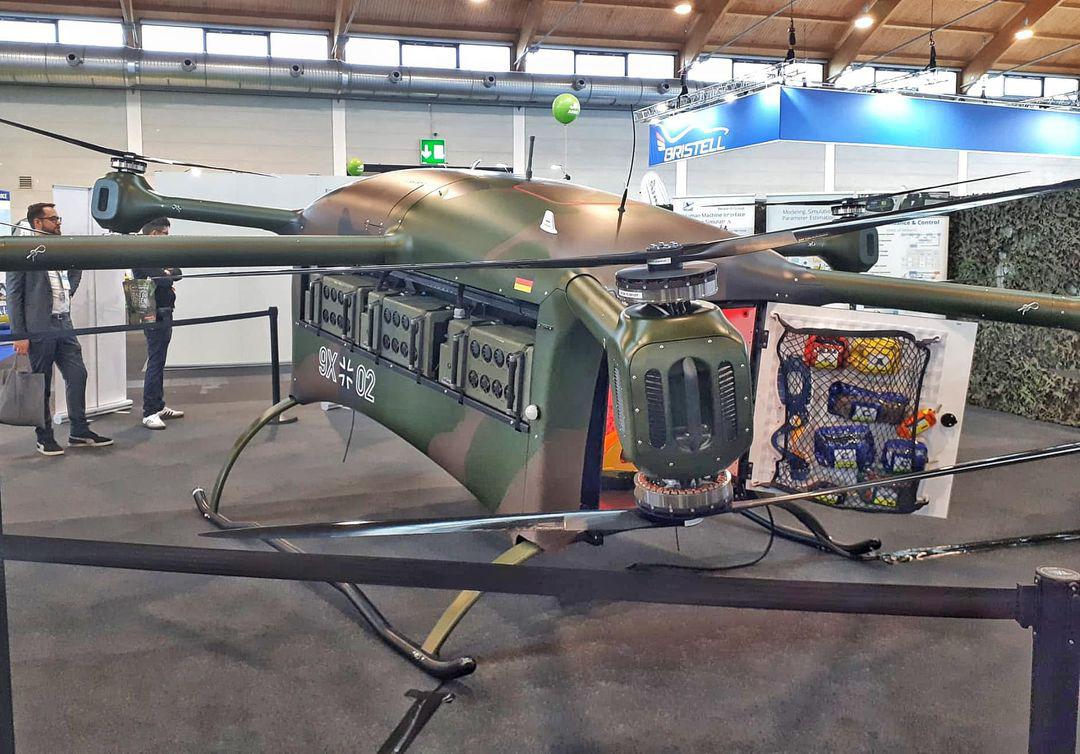
Austria-based Diamond announced its intent to produce its eDA40 for flight training. The aircraft is all-electric and based on the DA40. The company joined forces with Lufthansa Aviation Training and tested the eDA40 in “real training conditions” in Switzerland. The aircraft is powered by an “ENGINeUS” electric smart motor supplied by Safran, drawing power from an electric power systems battery module equipped with a DC fast charging system.
BRM Aero, the Czech Republic-based aircraft manufacturer of Bristell aircraft, and Switzerland’s H55, the technological spinoff of Solar Impulse, announced the B23 Energic. This two-seater is a fully electric aircraft “offering unparalleled performance, efficiency, and environmental sustainability […] with a maximum take-off weight of 850 kg, 60 minutes of endurance, plus reserves, and an hour charge time,” according to a joint press release. The H55‘s propulsion and battery technology has received acceptance for the European Union Aviation Safety Agency’s Compliance
Checklist, a significant step toward certification of the entire electric propulsion system.
Germany-based Elektra Solar presented its updated Elektra Trainer electric aircraft, recipient of the Innovation Award at AERO 2023 and certified as an ultralight. Charging modes include a solar trailer. This year’s model has long winglets for better aerodynamics, an integrated charger, thrust reversers, and a new instrument panel.
Continental introduced its newest Jet A piston engine, the CD-170R, specifically for rotorcraft applications. Combined with FADEC, this 170-horsepower, turbocharged engine offers lower fuel Thanks to FADEC and dual redundancy, it’s expected to burn 7.9 gallons of Jet A-1 per hour in cruise.
One of the repeat stars of the show was the side by side corrugated-skin Junkers A60. Following the tandem seat Junkers A50 Junior, updated from 1929, the A60 is another new design with
76 May 2024
Leave it to the Germans to build this behemoth Graf Zeppelin of drones, looking like a massive bumble-bee.
Electric remains the big theme - this is a project from Stuttgart University.
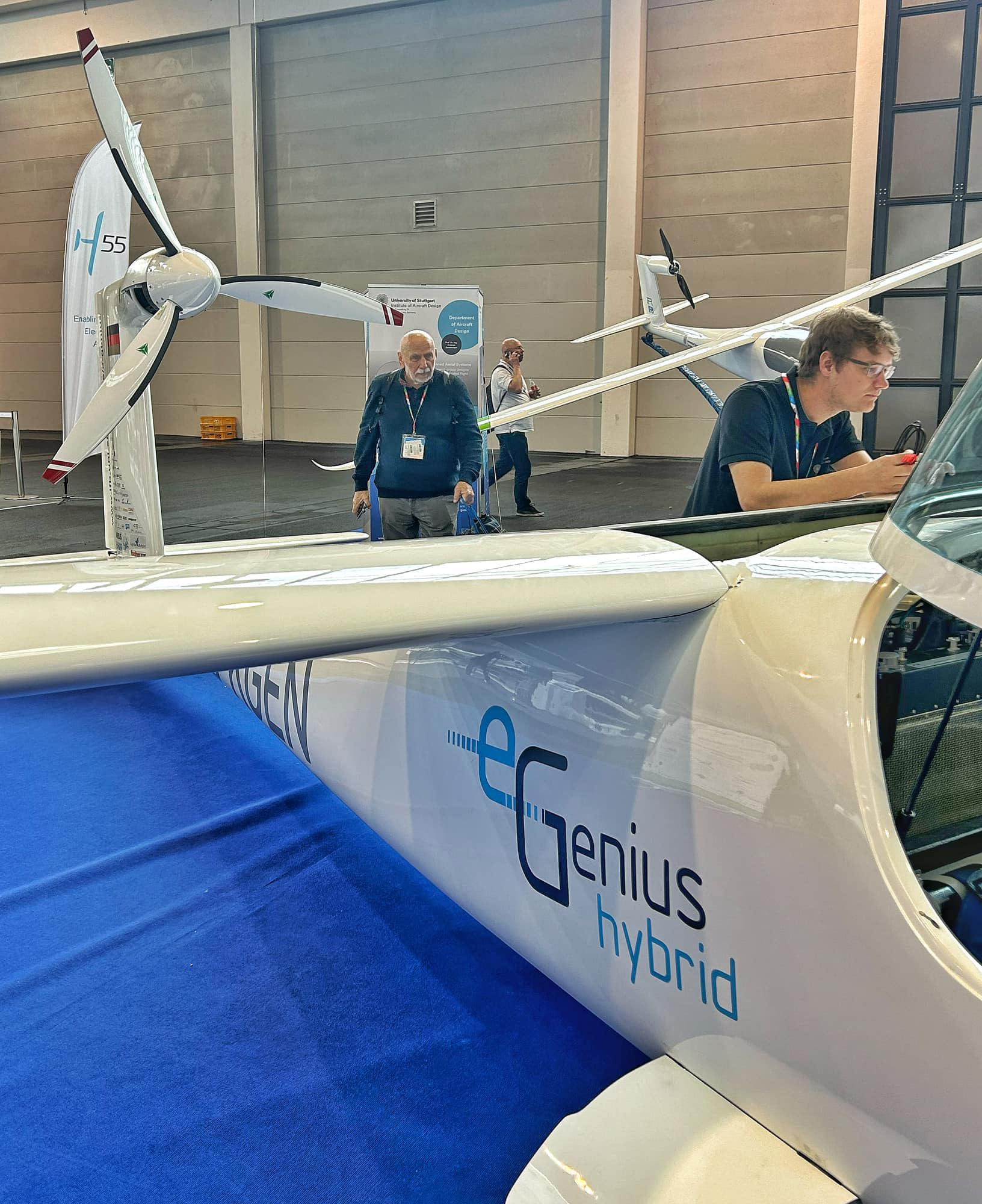
77 May 2024
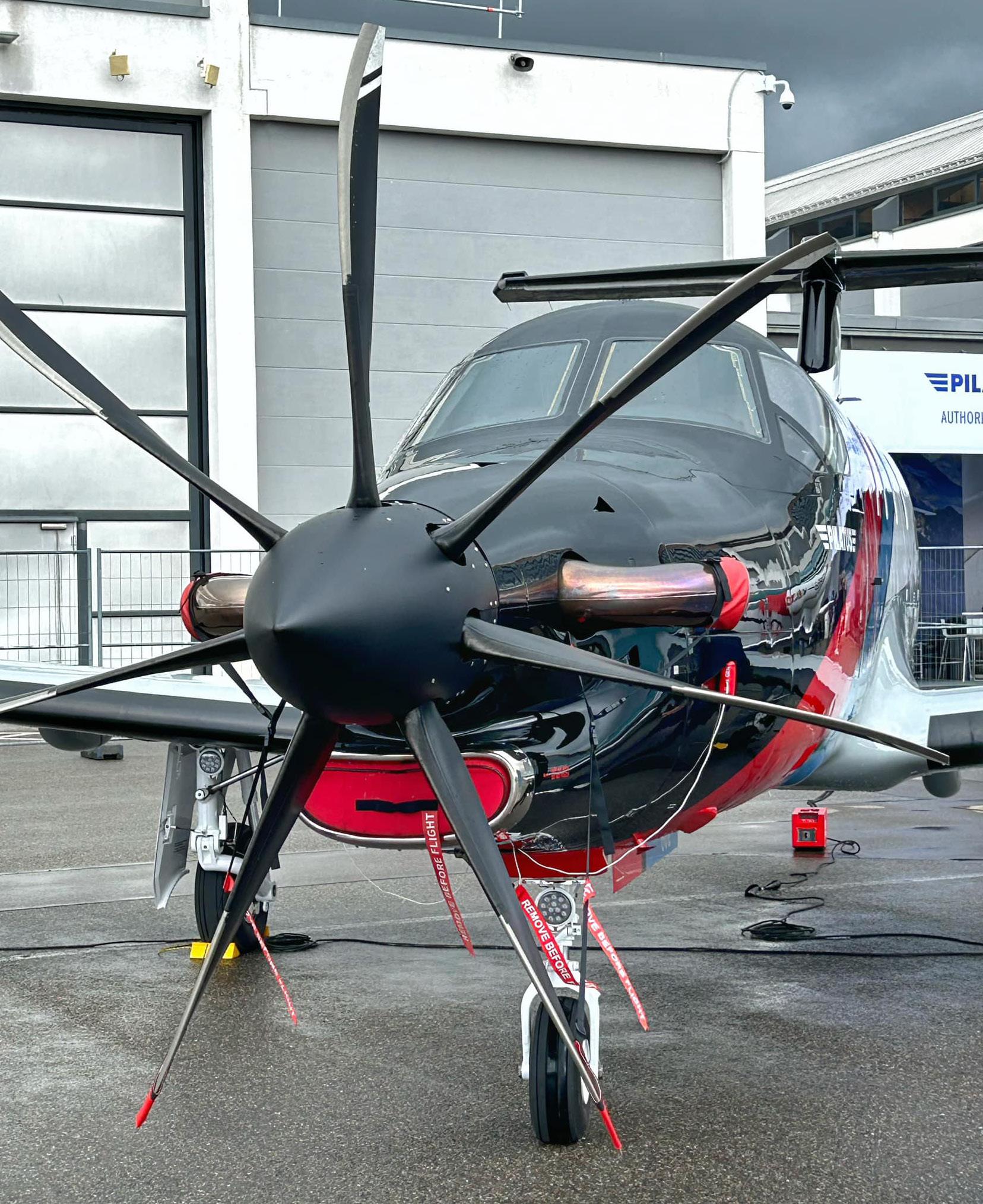
78 May 2024
Props were big - the Silent 7 - MT-Propeller MTV-47 on the Pilatus PC-12.
Another big prop on a PC-12.
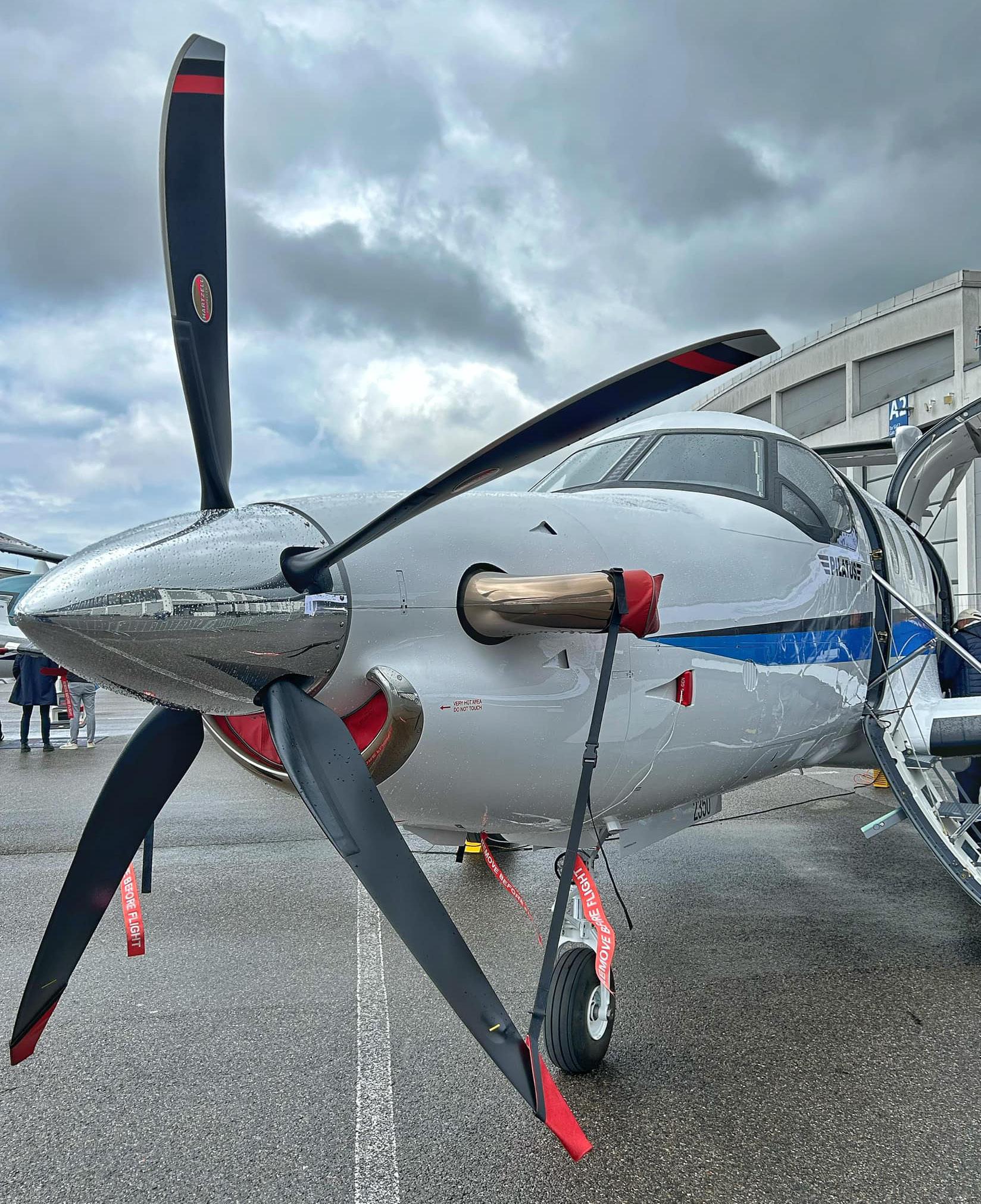
79 May 2024
retro looks. “We wanted to offer our customers side-by-side seating, versus the tandem seating on the A50,” said Alexander Jainsky, the Junkers salesman. “It’s about the joy of flying an extremely beautiful machine; a lifestyle,” explained Jainsky. Prices start around $260,000. The aircraft is powered by a Rotax 912iS, and has retractable gear. There is a choice of canopy including a convertible, open-air top.
Manpower
Woman power remains a challenge, with OEMs still trying to attract the 50 percent of the population — women — that remains elusive. Cate Brancart, GAMA’s director for European safety and sustainability, said, “One of the biggest events that we have is Aviation for Girls.”
“It’s about the joy of flying”
Challenges replacing human capital throughout the supply chain has translated into ongoing constraints in throughput of materials, parts,

Advanced Air Mobility
A further key trend is advanced air mobility. The last mile will be tough, and placement of vertiports within communities isn’t going to be easy. The public perception is that electric vertical takeoff and landing aircraft will provide luxury lift for the 1 percent. j

The Rotax 916 iS equipped Sling TSi.
The Rotax 916 iS equipped Sling TSi. Our preferred “Search Engine”... Our preferred “Search Engine”...
This Easter, where will your Sling search take you?
This Easter, where will your Sling search take you?
80 May 2024
+27 (0) 11 948 9898 | www slingaircraft com | sales@slingaircraft com | AMO 1264 | Manufacturing Organisation M677
ELECTRIC AIRCRAFT
– NO PILOT LICENCE NEEDED
Lift Aircraft has launched pay-per-flight customer experiences with Hexa, its personal electric vertical takeoff and landing (eVTOL) aircraft.
LIFT AIRCRAFT, manufacturer of the singleseat Hexa, has announced the launch of customer eVTOL flights at Lakeland Linder International Airport (KLAL) in Florida. The announcement kicks off the company’s inaugural pay-per-flight U.S. tour, during which it will take its mobile location around the country and introduce customer flights in additional cities.
“We’re not just providing entertainment. We’re offering the chance to step into a new era of mobility,” said Matt Chasen, founder and CEO of Lift. “We’re pushing the boundaries of what’s possible in aviation.”
The company will offer customers a two-hour experience comprising ground training and real flights under the guidance of flight instructors. Customers will familiarize themselves with the aircraft and its controls, first on the ground and then in a virtual reality flight simulator. After about an hour, Lift said, they’ll be ready to take to the skies on their own. Flights can be booked via the company’s new mobile app or directly through its website.
In lieu of hundreds of hours of flight training, Lift claims beginner training on Hexa’s control system—which consists of a single, three-axis joystick—can wrap up in less than an hour. A redundant autopilot computer aids the pilot during flight, but they can also switch to what Lift calls “Look, mom, no hands!” mode.

The 15-by-15foot aircraft can carry up to 250 pounds in passenger configuration. It cruises at about 60 knots at up to 9,000 msl, while endurance (10-17 minutes) and range (8-15 sm) depend on payload. Hexa is also durable enough to fly in 20-knot winds, medium rain, and temperatures between -30 to 50 degrees C .
Hexa requires no pilot certification to fly. That’s because the aircraft’s 432-pound weight qualifies it as a Part 103 ultralight, a classification confirmed by the Light Aircraft Manufacturers Association (LAMA) in 2022.
The U.S. Air Force is another early Hexa customer. Lift has earned five contracts from AFWERX, the innovation arm of the Air Force, to develop the design and train Air Force personnel to fly it. Airmen made the first remote flight of Hexa in 2022 at Eglin Air Force Base’s Duke Field (KEGI) in Florida.
81 May 2024 NEWS
The Lift Hexa eVTOL is now approved in Florida. j
VANS AIRCRAFT
- EMERGING FROM CH 11
In an April 2024 announcement the company says that almost 85% of Van’s Aircraft customers have renewed their contracts at the increased prices.
CLYDE HAMSTREET, the bankruptcy consultant helping Van’s Aircraft says he’s confident the company will emerge from Chapter 11 and resume profitability.
Hamstreet said, “We’ve got a backlog of business now that we know … we can be profitable and will allow us to repay our prepetition obligations so I’m pleased with it.”
Hamstreet said the reorganization plan has been filed with the court and is now under review. It’s expected to be approved in mid-May.
Hamstreet said the strong support of customers and vendors, along with the millions of dollars in cash that founder Dick VanGrunsven and his
family loaned the company to keep it afloat, all helped ensure a “good outcome” for creditors and a positive future for Van’s.
“There’s a lot of things coming together … and it really gets pretty exciting knowing what’s coming and what the opportunity is.”
Hamstreet believes Van’s will survive bankruptcy because they now have a strong balance sheet and high demand for its products.
In future, kit deposits will remain in a separate account and held until manufacturing of the customer’s kit starts.
j
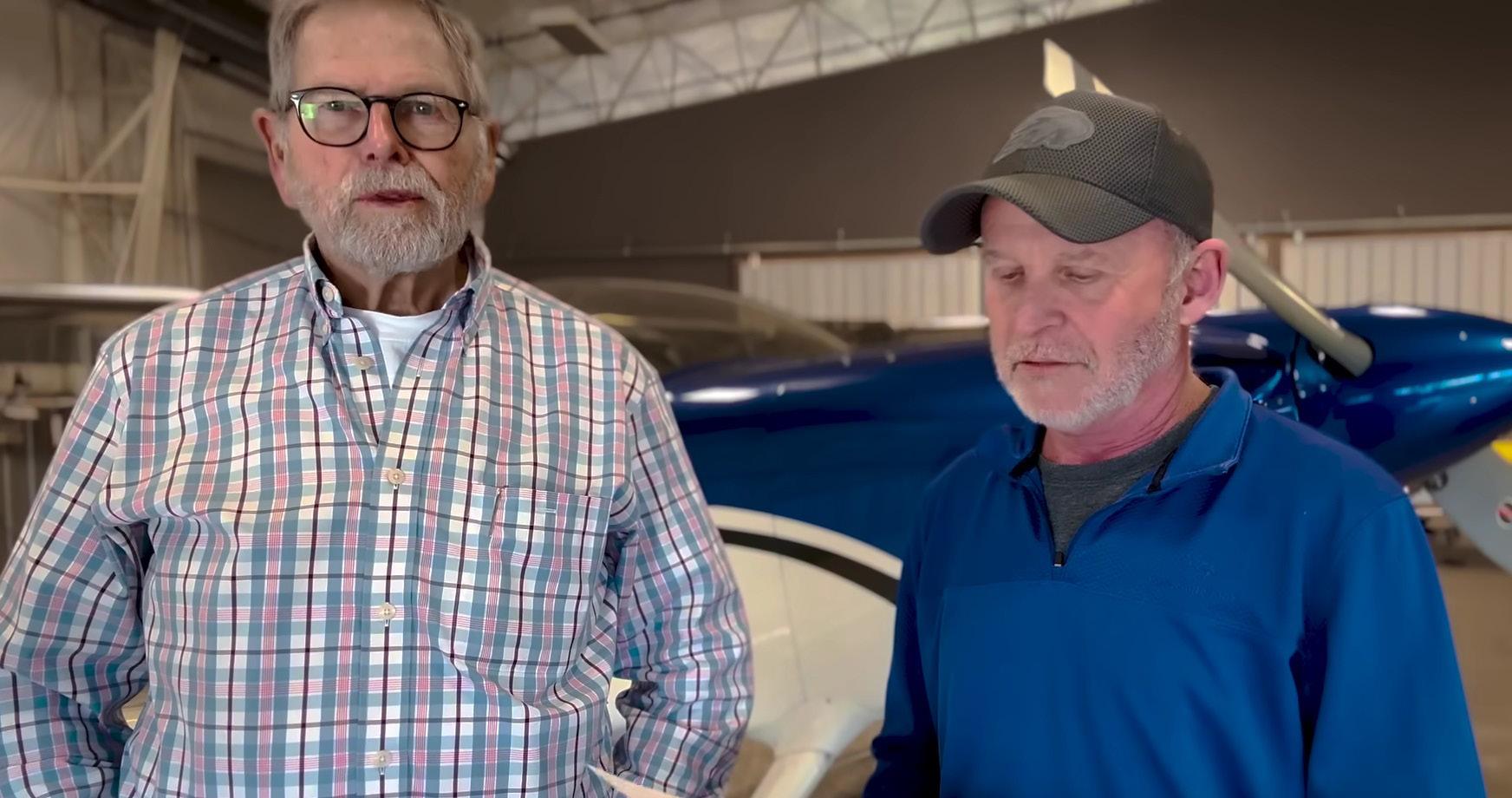
82 May 2024 NEWS
Clive Hamstreet (L) gives an update on Vans recovery.
Hangar to Rent
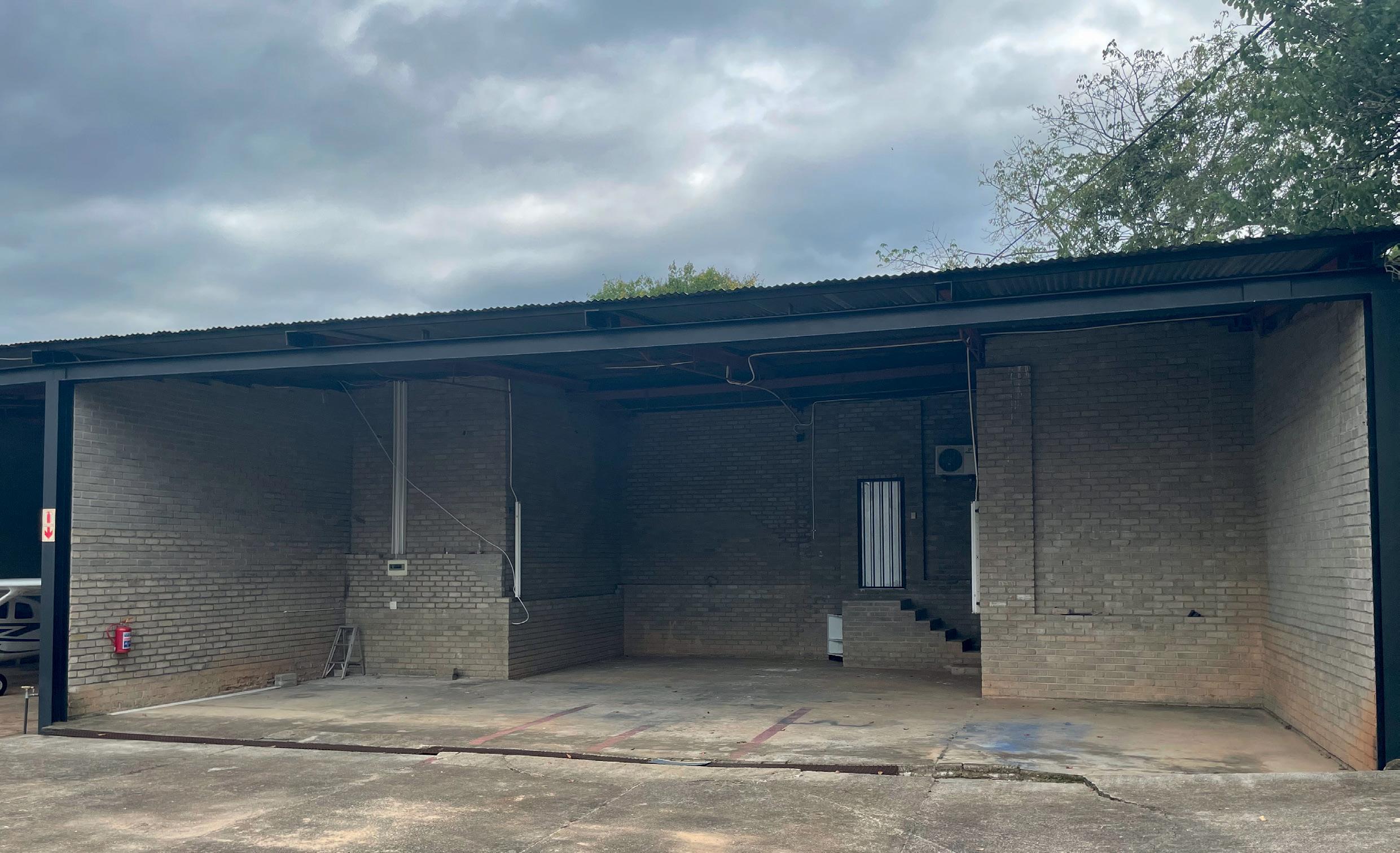
Hangar available in White River area:
T-hangar available for rent at a secure private farm airstrip near White River. No landing fees. Power available. R2200/m. Contact Jeremy (064 931 1642).

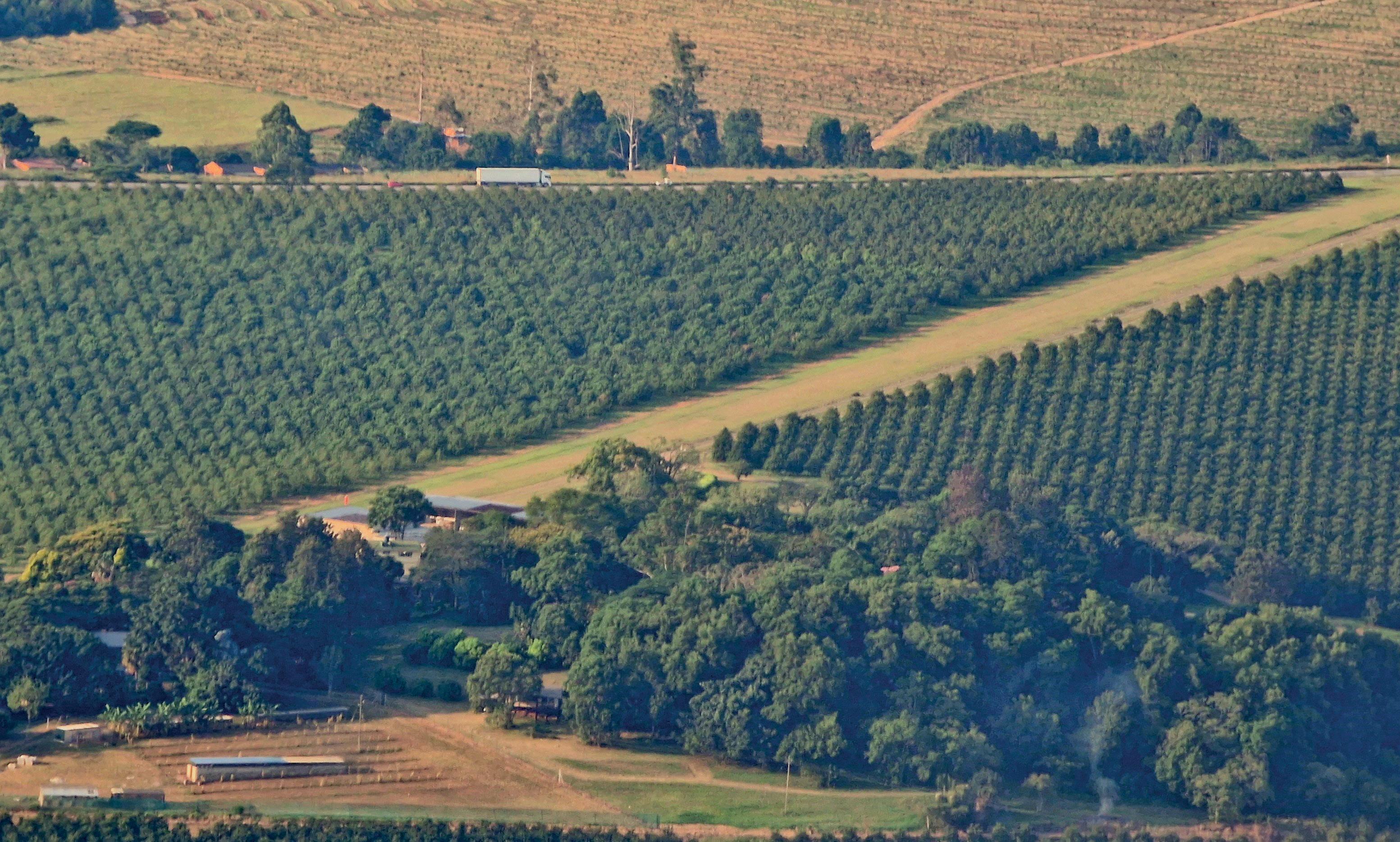


4 May AFB Zwartkops
Major Michael Church
E-mail: mike.church172@gmail.com Cell: 072 720 0700
23 to 25 May
Louis Trichardt
David@pilotinsure.co.za • 073 338 5200 race@sapfa.co.za • 082 449 2531
Nelspruit
Contact:

6 - 10 June
Zimbabwe
E-mail: zimairrally@gmail.com
Website: www.zimairrally.com
25 May Bloemfontein
Conrad Botha
E-mail: rowco24cc@mailbox.co.za Cell 082 465 4045
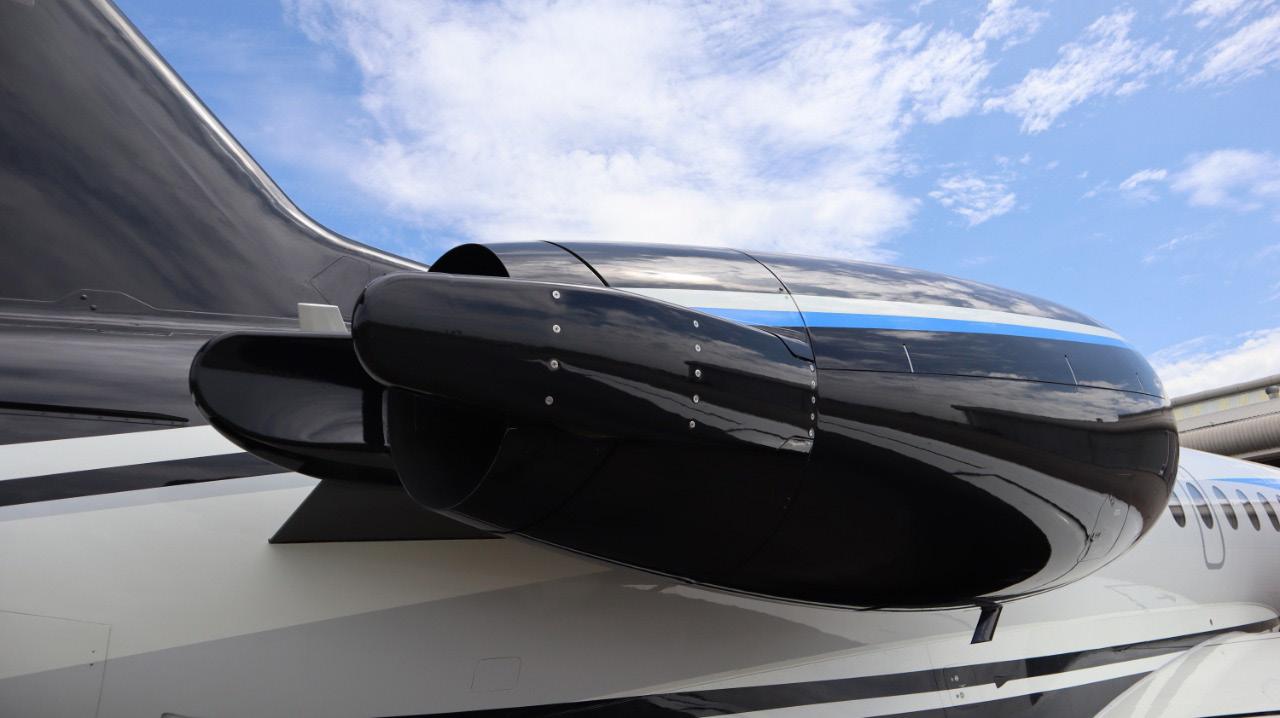
28 -30 June
Warmbaths Airfield
Richard Nicholson
Richard.nicholson1963@gmail.com Cell: 082 490 6227
21 to 23 May
Sandton Convention Centre
Nick Fadugba
Email: nickfadugba@africanaviation.com

Johan Pieters
E-mail: Johan@champ.co.za Cell: 082 923 0078
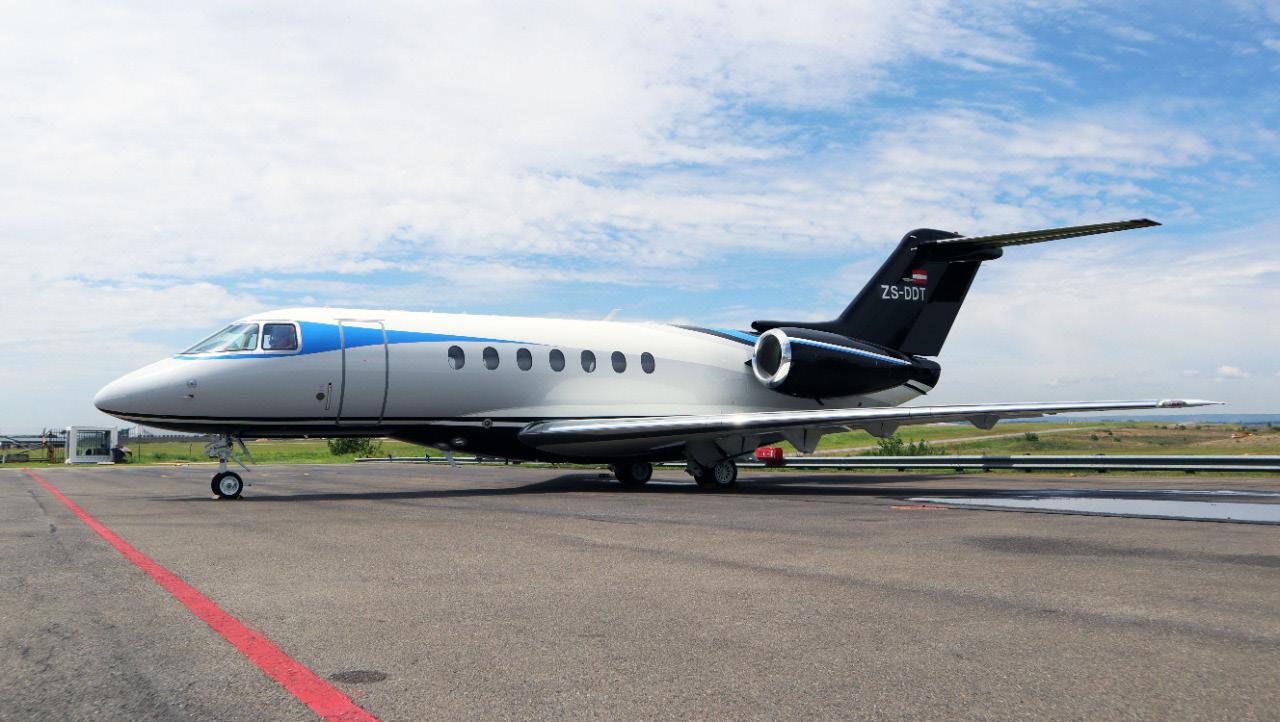
8 June
Lanseria International Airport
Neil Bowden
E-mail: airadventuresa@gmail.com
3 -5 July
Wonderboom National Airport
Website: www.aerosouthafrica.com
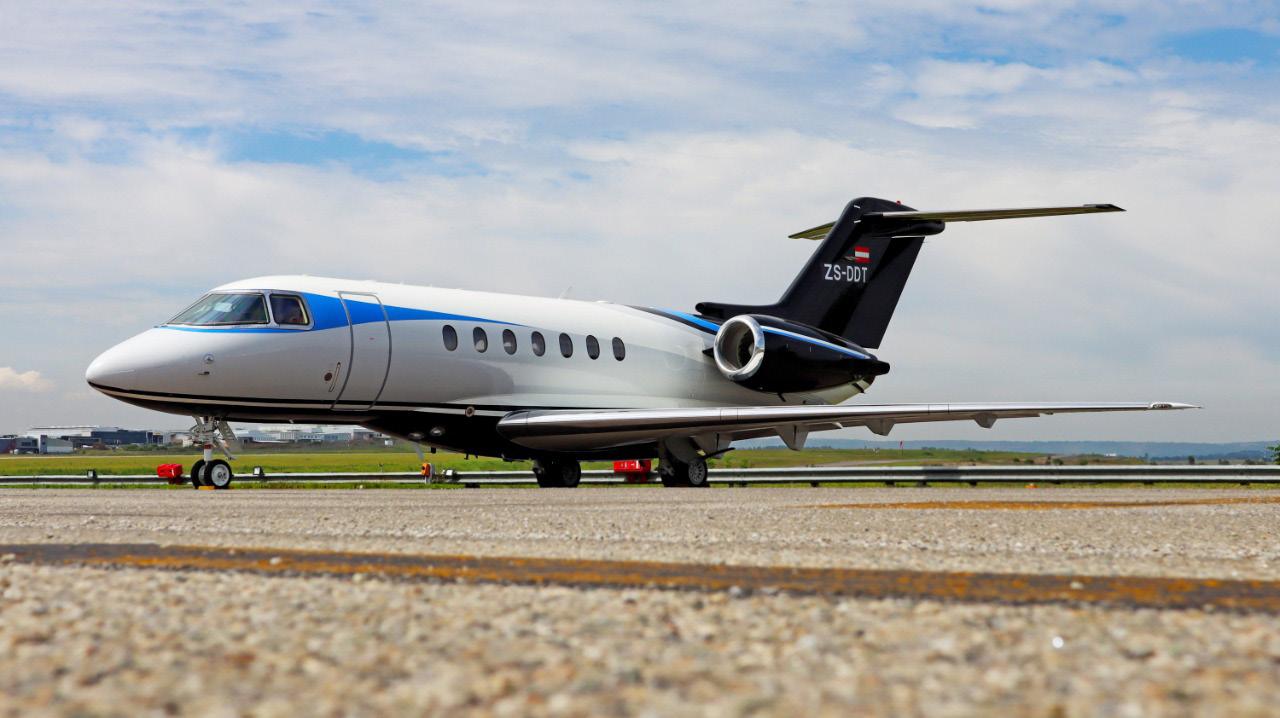
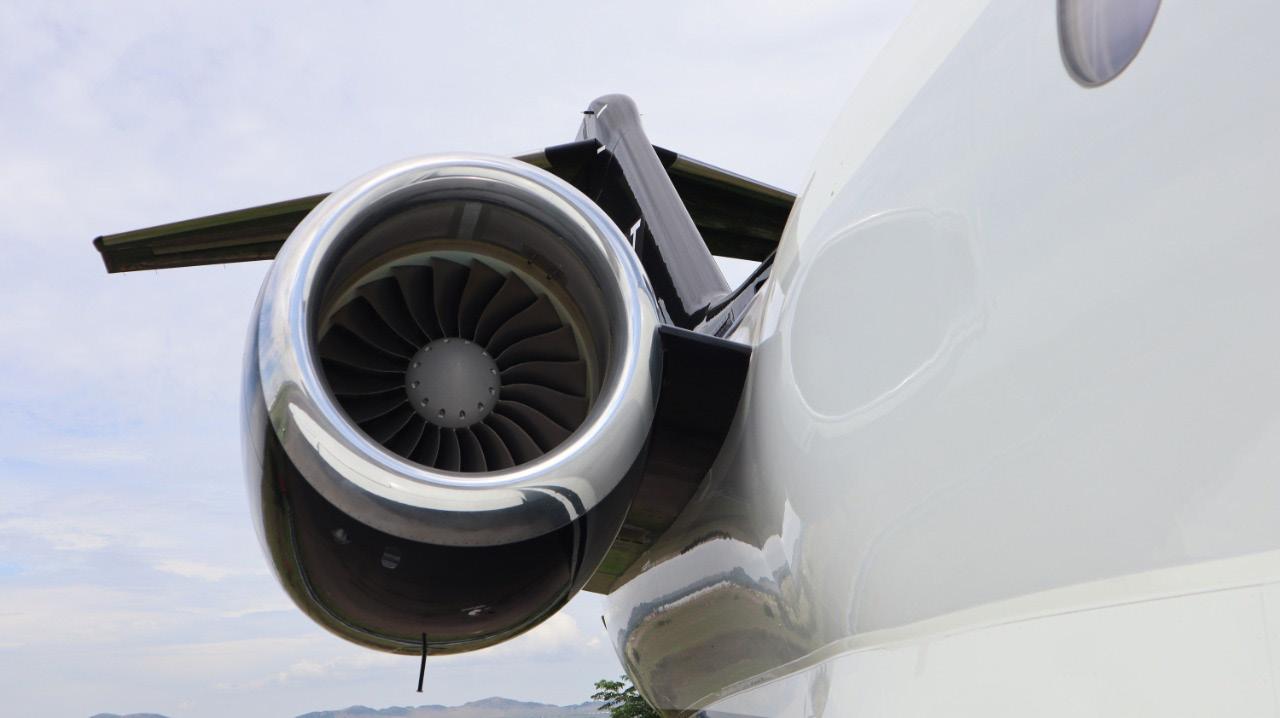
Maputo
Gavin Neil E-mail: gavin@haps.co.mz
27 July
Durban
Chris Theodosi
E-mail: chris@creativespacemedia.co.za Cell: 071 220 1245
22 - 28 July Wisconsin, USA
Airfield camping contact Neil Bowden E-mail: airadventuresa@gmail.com

84 May 2024 Tel: +27 (0)10 900 4149 | Mobile: +27 (0)82 547 8379 Info@earefurbishment.com | Francois@earefurbishment.com Hangar 24 (Interior Shop) and Hangar 31 (Paint Shop). Lanseria International Airport, South Africa, Gate 5 North Side.
LOWVELD AIRSHOW
May
EVENTS CALENDAR
11
willemein.hodgkinson@kishugu.com SAPFA PRESIDENT’S TROPHY AIR RACE
TEMPE AIRSHOW
ZIMBABWE AIR RALLY (50 YEARS)
NEWCASTLE AIRSHOW
Newcastle
1 June
EAA SOUTH AFRICA YOUNG EAGLES DAY
MAPUTO AIRSHOW
15 June
EAA TAILDRAGGERS FLY-IN
AERO SOUTH AFRICA
EAA AIRVENTURE OSHKOSH
VIRGINIA AIRSHOW
SAAF MUSEUM AIRSHOW
AIR FINANCE AFRICA
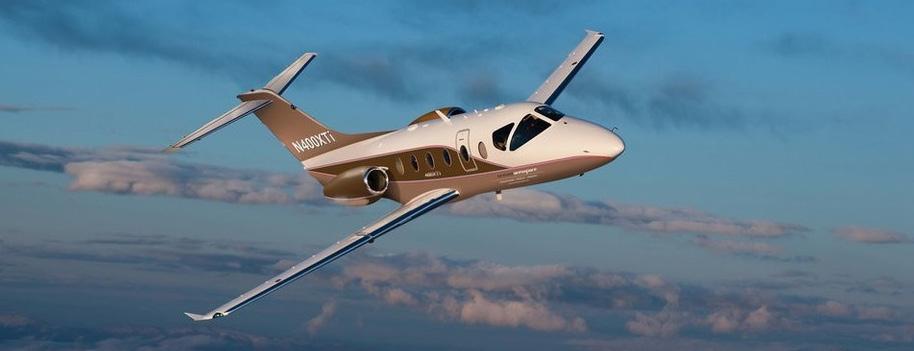

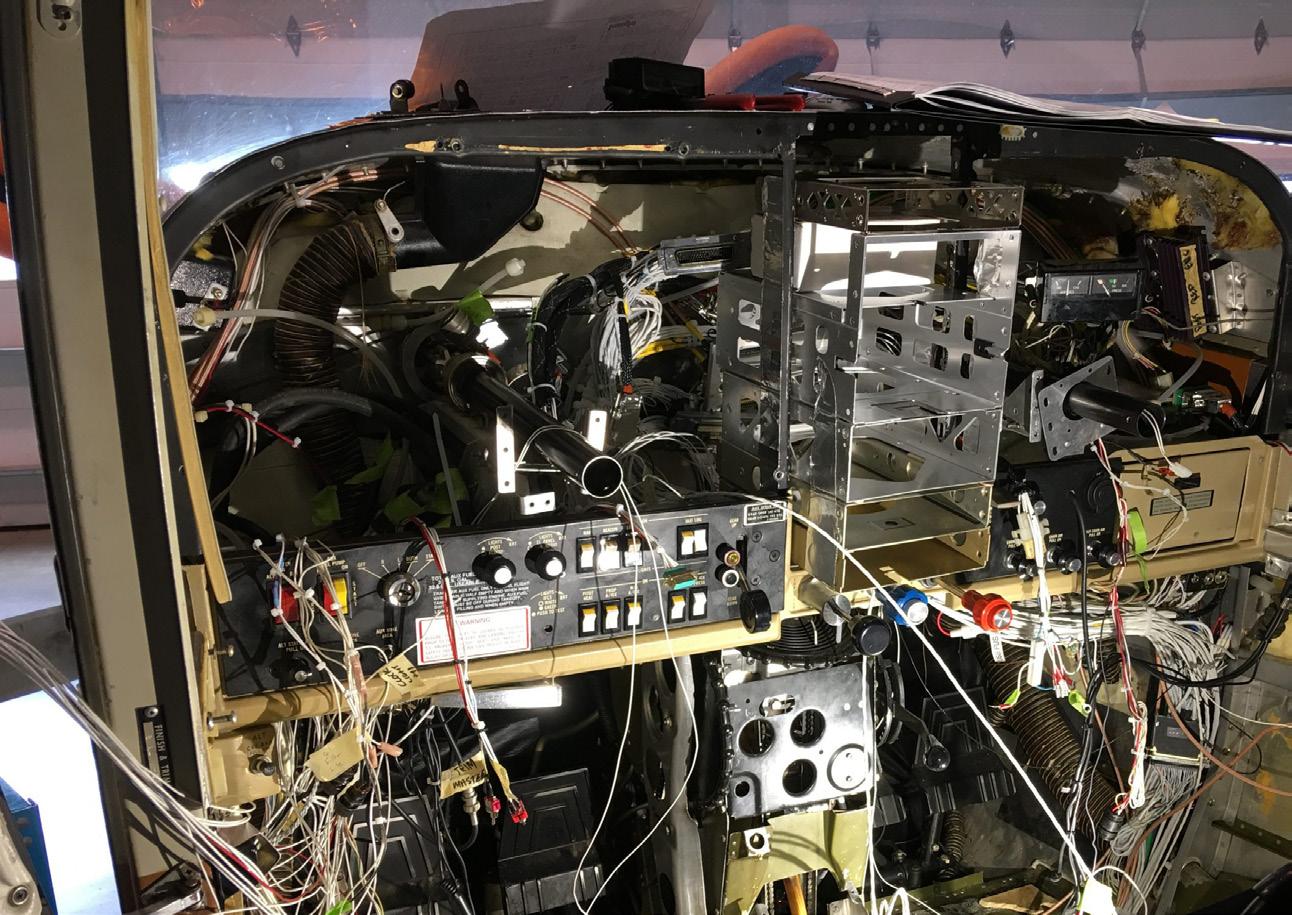
REFURBISHMENT GUIDE
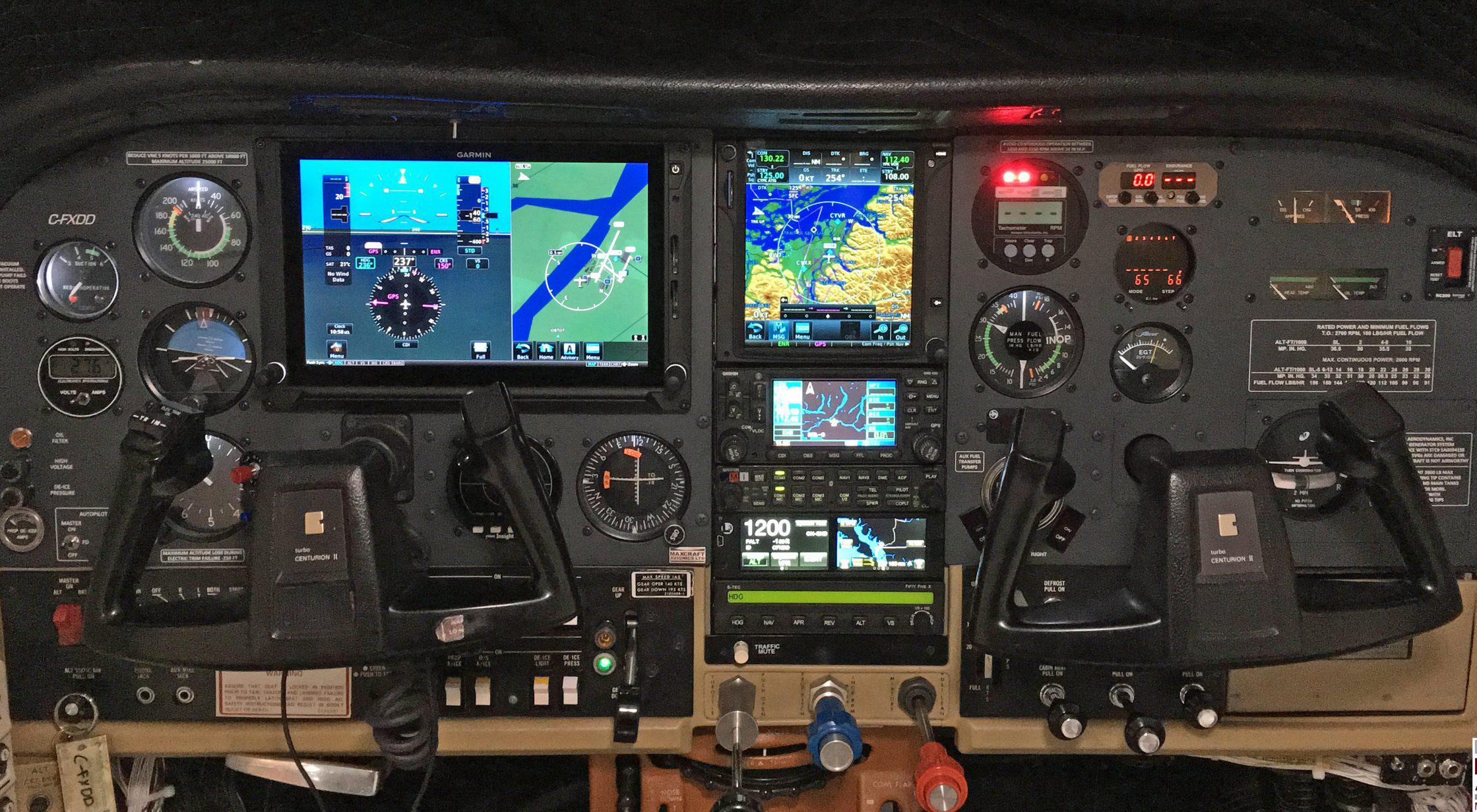
85 May 2024
Guy Leitch
AIRCRAFT MAINTENANCE REFURBISHMENT AND AVIONICS GUIDE
The weakness of the Rand against the US dollar in the past few years has given an enormous boost to the aircraft refurbishment industry in Southern Africa. Aircraft owners are choosing to upgrade their existing aircraft rather than replace them with new models.
THE REFURBISHMENT INDUSTRY has made it possible to own old aircraft that are as good, if not better, than new. Owners are increasingly adding new avionics such as terrain avoidance systems, that a fifty-year-old piston single would have lacked because those systems had not yet been invented.
Thankfully South Africa still has a deep repository of skills in aviation maintenance and thus a thriving industry refurbishing older aircraft.
your insurance is much cheaper
It is not uncommon to find 60-year-old airframes being refurbished to genuinely better than new condition, thanks to engine improvements and updated avionics, particularly since ‘glass cockpit’ instrumentation has become far more affordable and easy to install – even in type certified aircraft.
These days a good used Cessna 182 with perhaps a midlife engine can be bought for around R2 to 3 million – which is a quarter of the price of a new plane. Not only have you saved millions, but your insurance is much cheaper.
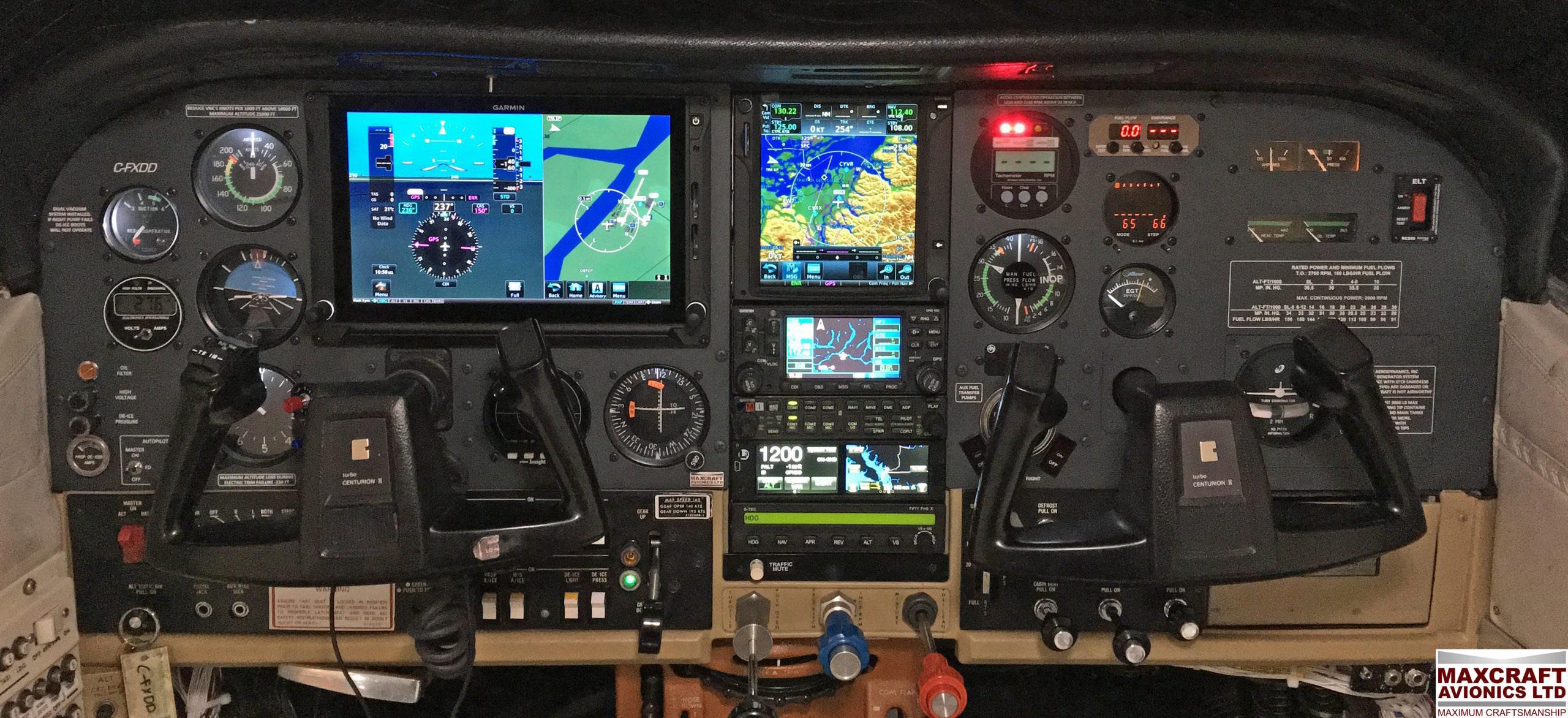
86 May 2024
Introduction
Aircraft such as the Cessna 210 have been very successfully upgraded.

Of course, maintenance will be a bit – but not that much – higher. And this is where a good AMO comes in.
For seven years SA Flyer owned a Cessna 182, ZS-FPI, and then a complex turbocharged retractable Piper Saratoga, ZS-OFH. What we learned is that the differences in maintenance between a good and poor AMO is very noticeable in terms of aircraft availability and reliability. This was evident when we switched from the Rand Airport based agents to Ferreira Aviation in Bloemfontein.
Avionics
Avionics are the field where the most progress has been made and this makes older aircraft excellent candidates for an avionics upgrade. Particularly popular are STCs for the installation of the industry standard Garmin G600 and G1000. And for those aircraft that have the performance – the installation of altimetry to meet RVSM requirements. A further important upgrade that is expected to soon becomes compulsory is ADSB – in and out.
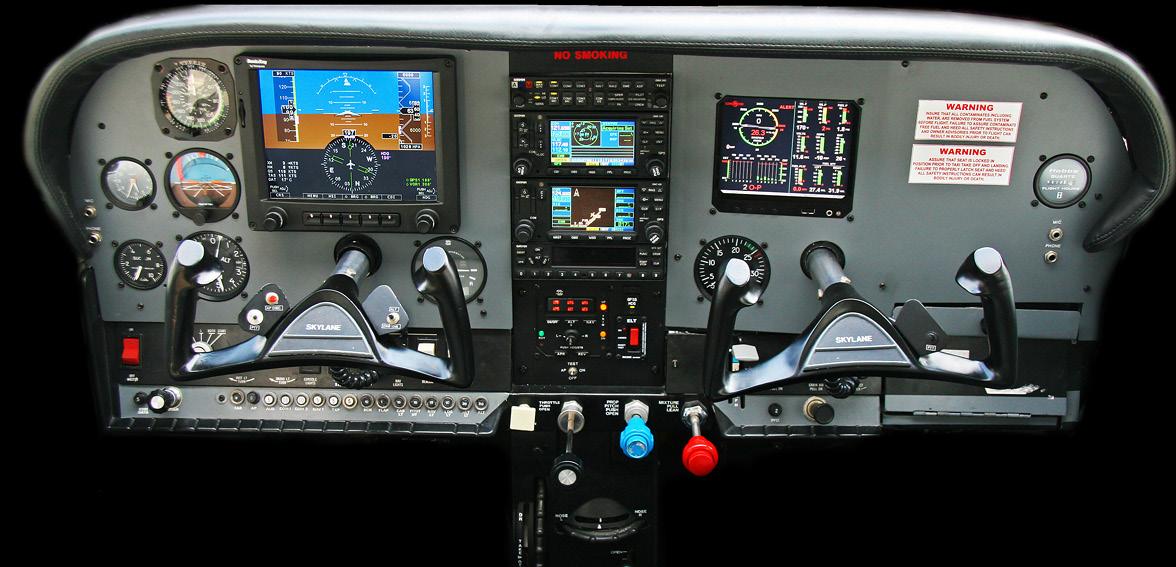
87 May 2024
Instrument upgrades such as this to SA Flyer's C182 improve the aircraft's capability and safety.
Nextant's 400TXi very successful upgrade of the original Hawker 400.
Older corporate aircraft have been excllent candidates for avionics upgrades such as this Garmin G1000 NXi for a King Air 200.
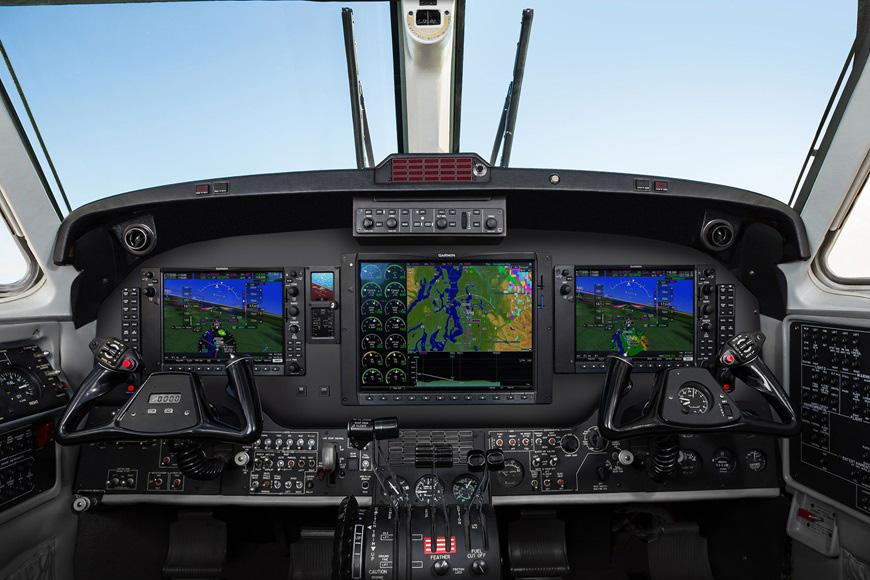
Removing and replacing old instrumentation is a skilled job.

88 May 2024 Introduction
Specialist avionics installers at Lanseria such as Aeronautical Aviation and Century Avionics pioneered the installation of the industry standard Garmin G600 and G1000 into King Air 200s and similar turboprops and these have now become a very popular upgrade across the industry.
Typical installations include a dual air data attitude heading reference system (AHRS), dual PFDs, a centre MFD with moving map, FMS, navcoms and WAAS GPS, radar display, and a pedestal-mounted FMS keyboard.
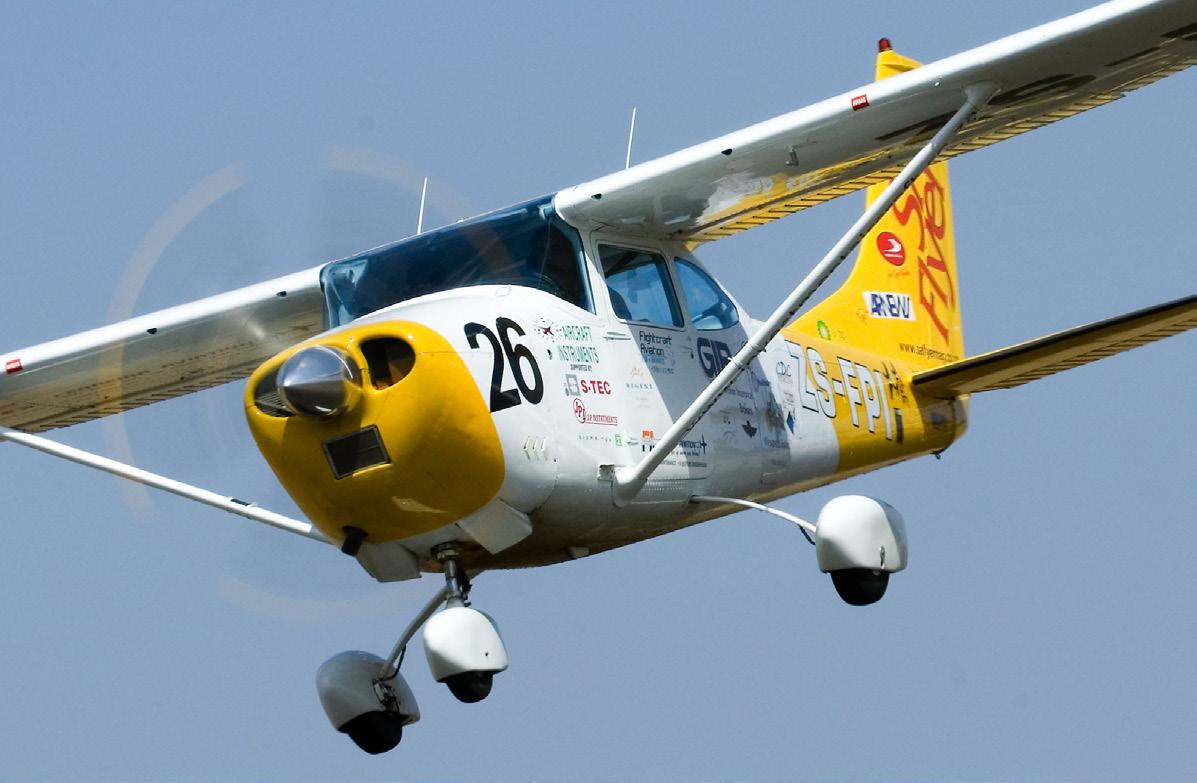
Popular too are numerous electronic engine instrument displays and a battery powered all-inone standby PFD.
A typical avionics selection for the upgrade of older piston singles involves a Garmin G600 MFD with synthetic vision as a PFD for the pilot’s side. This gets its data from a WAAS capable, TAWS-B certified Garmin GTN650 GPS/navcom that fits in the centre radio stack.
On the right side of the panel a JPI EDM 930 engine-monitoring screen that displays all engine parameters including fuel flow, rpm, manifold pressure and electrical output is an ideal partner for GAMI injectors for better temperature control and lean of peak operation for fuel injected engines.
Engine Upgrades
The leader in engine upgrades to the ubiquitous turboprops that are so popular in Africa is Blackhawk. This company has specialised in STC approved engine upgrades to the
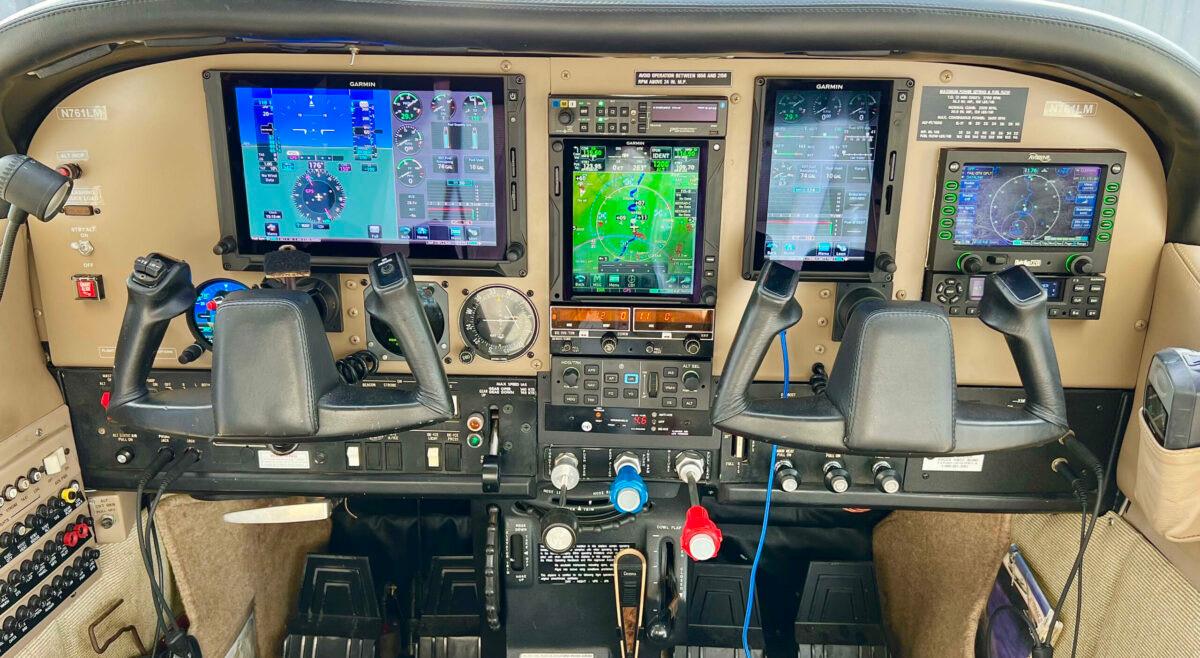
89 May 2024
SA Flyer's Cessna 182 is an excellent example of what can be accomplished with refurbishment.
Aircraft such as the Cessna 210 have been very successfully upgraded.

King Air range in particular, but also handle Cessna Caravans , Pilatus PC-12s and Piper Cheyennes.
The upgrade that put Blackhawk on the map is its Beechcraft King Air 200 engine replacement. Blackhawk offers no less than three engine upgrade packages for King Air 200s. These are the XP42, XP52 and XP61, and they all generate important performance and savings benefits, yet each package has distinctive characteristics to benefit specific flight requirements and profiles. Some of the key benefits include: An increased rate of climb, higher single engine service ceiling and faster cruise speeds resulting in reduced time on airframe and engines and a higher Vref resale value.
Blackhawk’s XP52 engine upgrade exchanges the B200’s original PT6A-41 or PT6A-42 engines for factory-new Pratt & Whitney PT6A52 engines. No major airframe modifications are required and some of the key benefits are for Africa’s hot and high operations: the extended maximum operating ITT to 820 C with a higher horsepower flat rating of more than 1346 shp which enables it to reach higher altitudes more quickly, fly higher and faster and thus reduces specific fuel consumption. It is calculated that this typically saves $38,000 per year in reduced operating costs.
Bizjets, which tend to age quicker due to higher utilisation and faster obsolescence due to jet engine designs becoming more fuel efficient, are excellent candidates for refurbishment. This is especially evident in the re-engining of older airframes such as the HS125-400 with modern high bypass fan jets.
A very successful upgrade has been the Nextant 400XTi upgrade of the original Beechjet 400A / Hawker 400XP. Nextant was the first company to introduce the concept of re-manufacturing business jets. Its first product was the 400XT, a modified and modernised Beech 400A/XP, fitting it with new Williams FJ44-3AP with Full Authority Digital Engine Controls (FADEC) and a Rockwell Collins Pro Line 21 integrated avionics suite. Other changes include the overhauling and replacing of all life-limited components returned to zero-time status by replacement or overhaul and replacement of all new primary wiring harnesses.
Even the basic jets with OEM fanjets such as Cessna’s Citation 501-SP are able to benefit enormously from engine upgrades. New engines such as the Williams FJ44, which put out 2,300 pounds of thrust a side, provide a much-needed performance improvement. Nextant's 400TXi
90 May 2024
successful
Introduction
very
upgrade of the original Hawker 400.
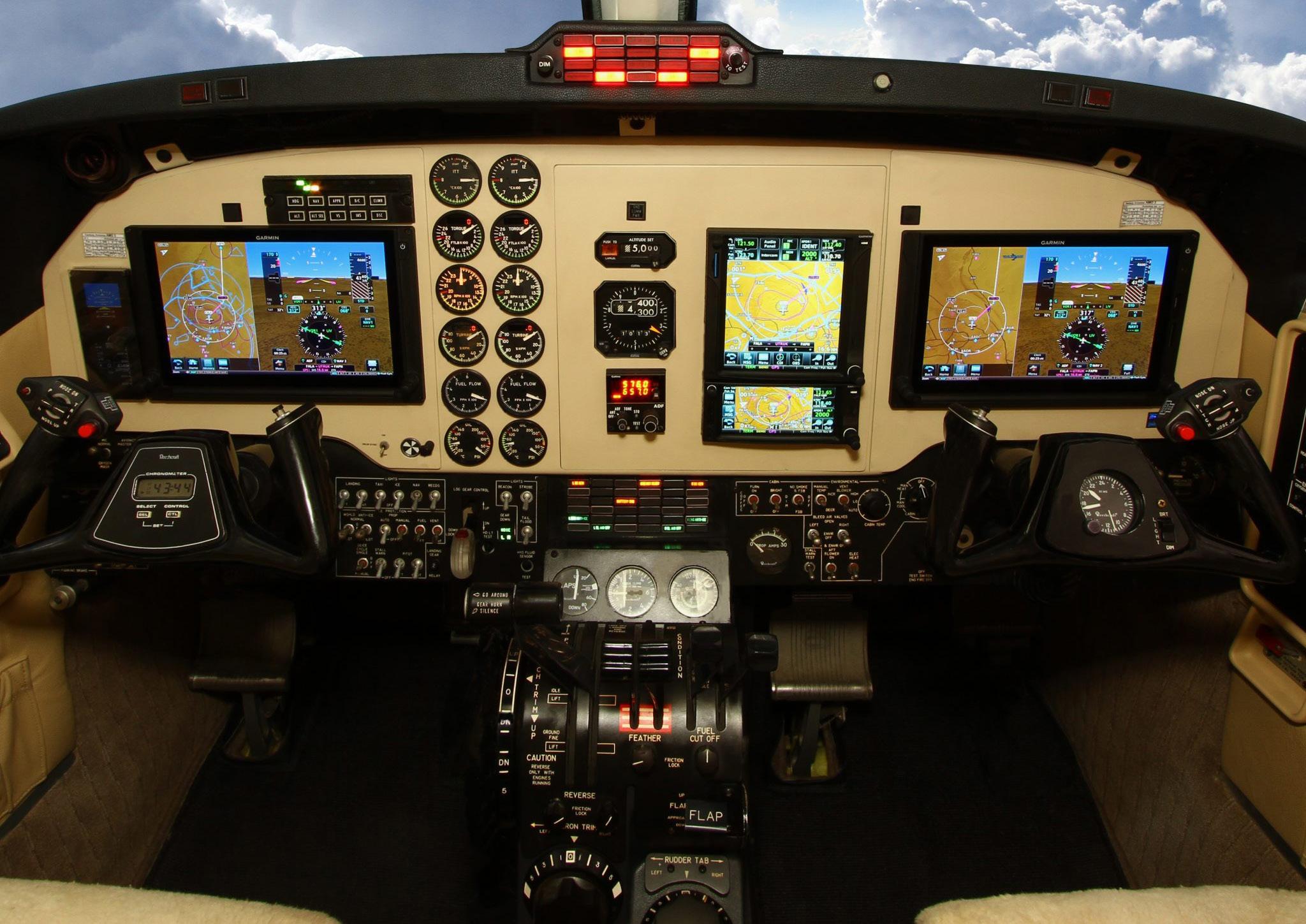
Exteriors
It’s not just about engines and avionics –refurbishment customers want their planes to look like new. All good paint shops start with a complete paint strip and prime, followed by three coats of base paint with additional coats for the colour. Decals are becoming an increasingly popular option.
Specialists can do you custom paint schemes as was the case with the yellow extremities we had for better visibility on our C182 and the ‘heart attack’ scheme on our Saratoga. This scheme was done by our artist Darren Edward O’Neil and we were so pleased we added his signature. Darren will propose a sketch layout and then, with painstaking attention to detail and proportion, make sure it is applied as intended to the physical requirements of the actual aircraft.
A key point to remember when repainting aircraft is that it must be done by an approved maintenance organisation as the control
surfaces have to be removed and then professionally rebalanced before installation.
Interiors
Interiors are another critical item – most owners elect to use wool carpeting, and new padding and leather covering for seats. All materials must have a fire certificate – so this is not a job for non-aircraft approved suppliers, even if they are much cheaper.
Another popular aftermarket option are airbags –built into the seat-belt for the front two seats, as well as new LED lights and new plastic window reveals.
South Africa is blessed to still have such a deep legacy of aircraft refurbishment skills and it is the antidote to increasingly unaffordable new aircraft prices. j
91 May 2024
A
Beechcraft King Air 200 upgrade by Century Avionics.
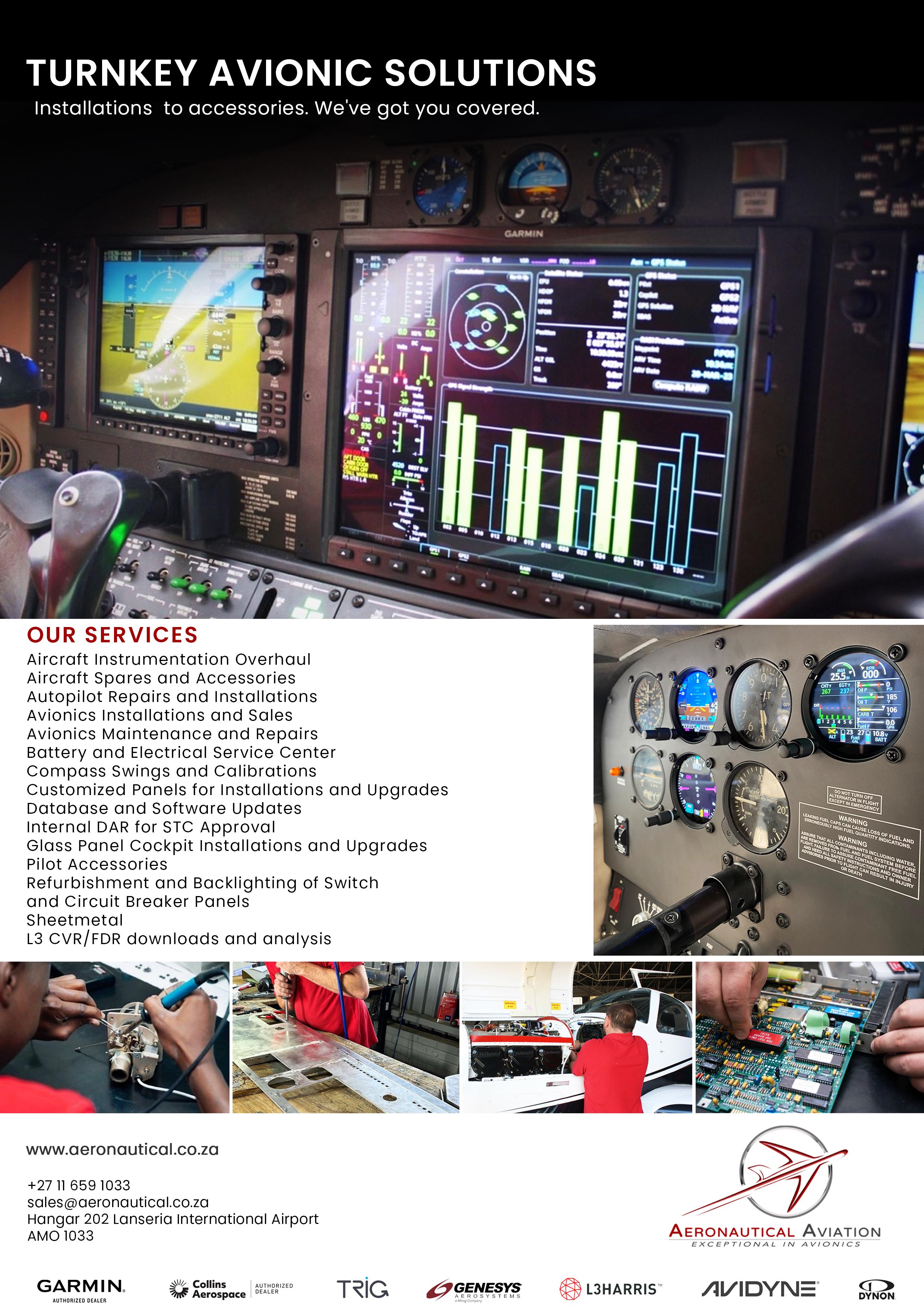
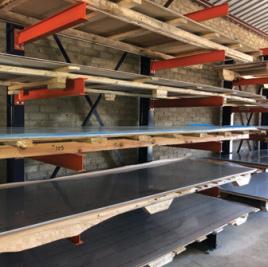
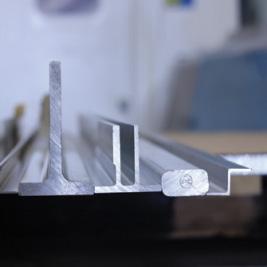





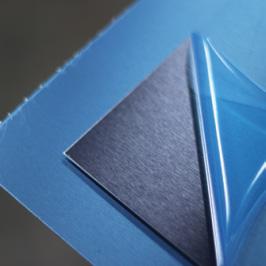


93 May 2024
AEROSPACE
ELECTROPLATING
AMO
506
For all your SACAA approved plating requirements
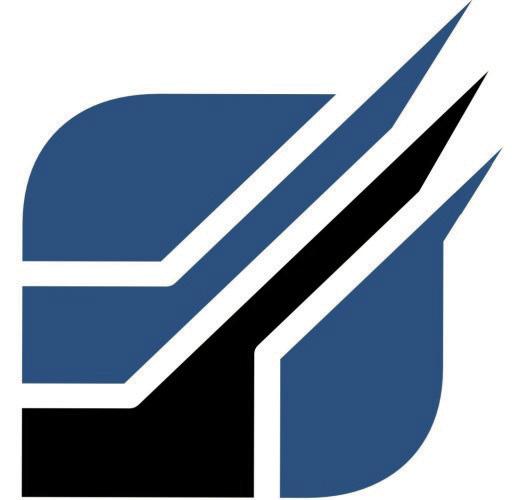
ForallyourSACAA
approved
platingrequirements

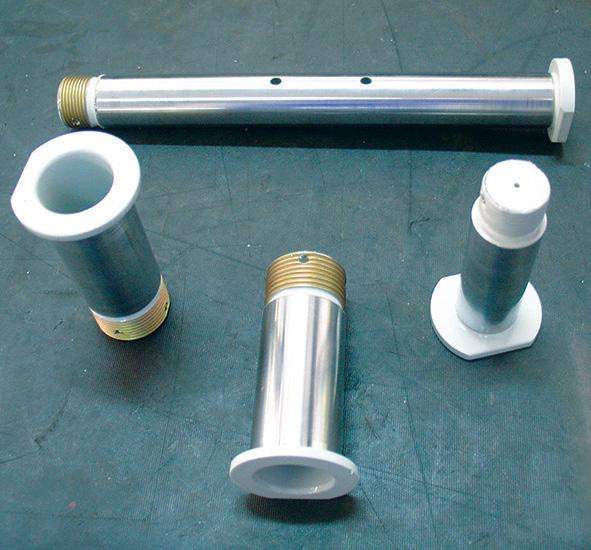
We are situated at 30B, Building 98, Rand Airport. Next to Fields Airmotive. Call Oliver on 011 827 7535 or Peter on 081 755 2534 or 083 208 7249
For all your Aircraft and Allied Electroplating requirements.
• Now certified for TCAS training.
• RNAV and GNSS
Certified on all flight models from single engine to turbine.
Alodine
Cadmium Plate in Gold or Silver Passivation Hard Chrome
Hard Silver Plate
Electroless Nickel Hard Copper Plate
Anodising in Grey, Red or Black Black Phosphating Phosphating
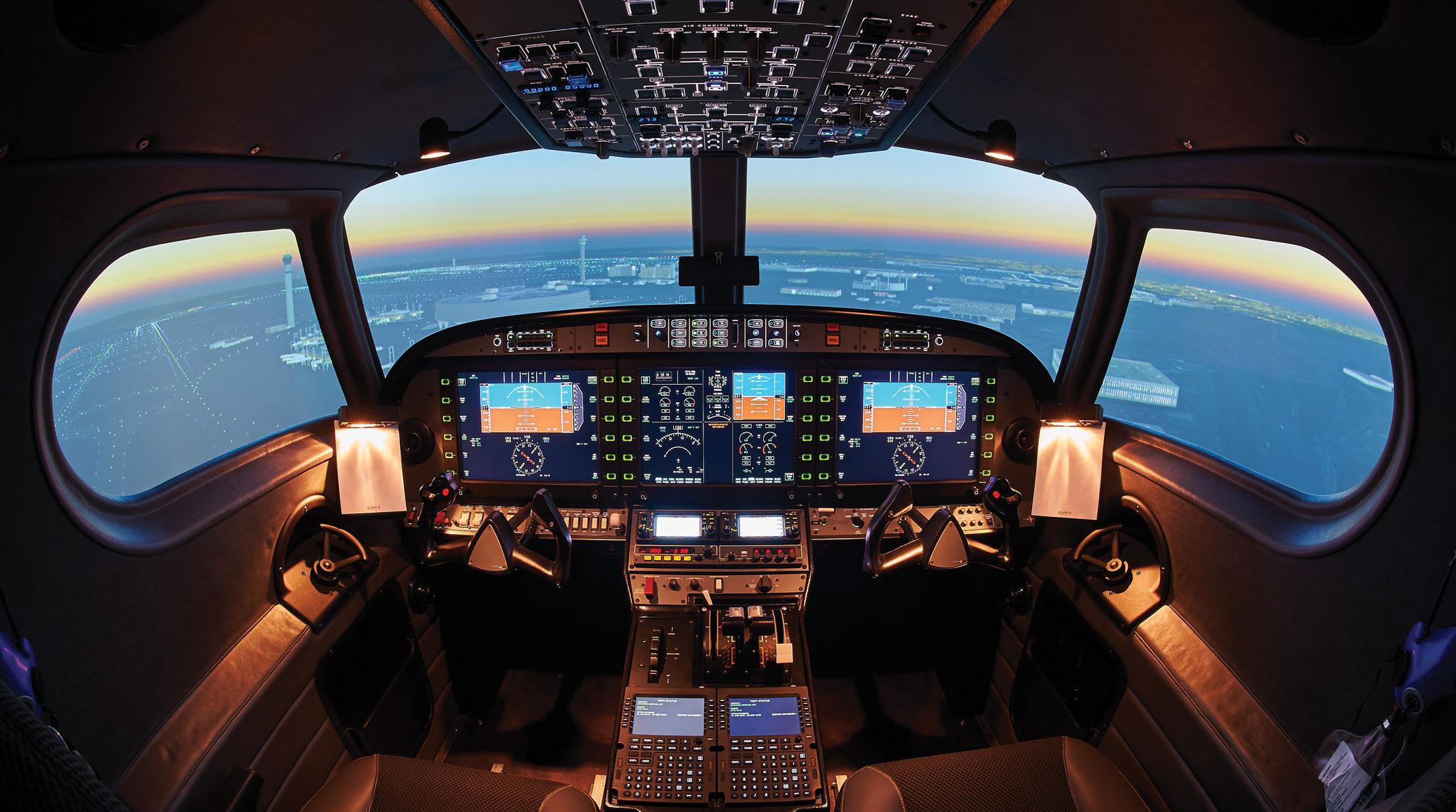



94 May 2024 AMO
506 ForallyourSACAA
approved
We
827
7535
or063 orPeteron081775
are
situated
at
30B,
Building
Call
Des
on
011
2434
or083 For
all
yourAircraftand
Allied
We
Building
98,
Rand
Airport.
Next
to
Fields
Airmotive. Call
Des
on
011 orPeteron081775
2434
or083 For
Cadmium Plate Clear Passivation Hard Chrome Hard Silver Plate Electroless Nickel Hard Copper Plate Anodising in Grey, Black Phosphating Phosphating AEROSPACE
AMO
situated
at
30B,
Fields
Airmotive. Call
Des
on
011 827
7535
or063 rPeteron081775
2434
or083 For
all
yourAircraftand
Allied
Electroplatingand
queries. Cadmium Plate in Gold,Silver or Clear Passivation Hard Chrome Hard Silver Plate Electroless Nickel Hard Copper Plate Anodising in Grey, Red or Black Black Phosphating
are
situated
at
30B,
all
ELECTROPLATING
506 ForallyourSACAA
approved
platingrequirements We
are
Building
98,
Rand
Airport.
Next
to
SA Flyer 2023|0 7 SA Flyer 2023 | 08 TRAIN ON THE MOST MODERN FLIGHT SIMULATOR AVAILABLE IN SOUTH AFRICA WITH NEW
VFR LEVEL TERRAIN GRAPHICS
PPL
BETWEEN
INFORMATION:
Website:
TO ATPL TRAINING AND EVERYTHING IN
CONTACT US OR VISIT OUR WEBSITE FOR MORE
Tel: 011 701 3862 E-mail: info@aeronav.co.za
www.aeronav.co.za SACAA ATO No: SACAA/1110/ATO

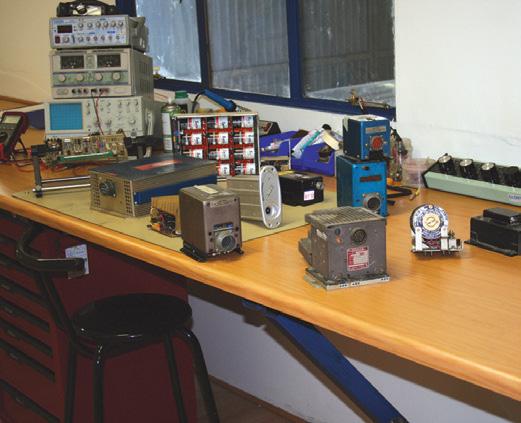
WE SPECIALIZE IN: - Avionics - ACK Agents (ELTs') - Repairing and fault finding in rotor and fixed wing aircraft - Overhaul and repairing of DC/ AC Electrical, Magneto and ignition equipment - Full Battery workshop facilitating NiCad and Lead Acid batteries - Aircraft electrical modifications and installations - We travel to any destinations for MPI’s and repairs
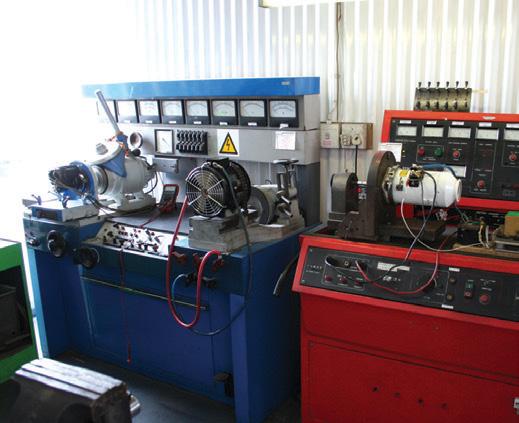

Signature Hanger, Beachcraft Road Cape Town International Tel: 021 934 5373 Erwin Erasmus: 082 494 3722
Website: www.aeroelectrical.co.za
Email: office@aeroelectrical.co.za
95 May 2024
TOWN
Danie van Wyk: 083 269 8696 Fax: 011 701 3232 CAPE
AMO 1011
CESSNA 425 AVIONICS UPGRADES: DESIGN & IMPLEMENTATION
The weakness of the Rand against the US dollar in the past few years has given an enormous boost to the aircraft refurbishment industry in Southern Africa. Aircraft owners are choosing to upgrade their existing aircraft rather than replace them with new models.
TAKING INTO CONSIDERATION: the aircraft type, operation and crew workload, we customise a carefully personalised panel to meet our client’s needs, whilst striving to exceed their expectations.
With quality workmanship and top of the range avionics, products & support from leading industry brands such as Garmin, Honeywell, Genesys, Avidyne, Freeflight, Kannad, which are a few of the brands represented by Century Avionics, we aim to deliver a product that brings the newest and most functionally rich avionics technology into the cockpit.
customer (or pilot) we are able to identify and establish the best combination of equipment to be installed in the aircraft.
to enhance safety and situational awareness
Cessna 425 Upgrades
Century Avionics has had the opportunity to upgrade different Cessna 425 aircraft with various combinations of avionics.
There are number of considerations of components in designing the interface of a glass cockpit. There are also a number of ways to achieve that and through consultation with the
In order to bring true glass cockpit capabilities to the aircraft, we fitted either dual 10” Garmin G600 TXi touchscreens or a G600Txi 10” and 7” Portrait Display as Primary Flight Display/ Multifunction displays. Where we added an Engine Instrument System (EIS) we installed the 7” portrait display to the two 10” displays. https:// centuryavionics.co.za/product/garmin-g600-txi/
96 May 2024
Century Avionics
Lined up and ready to go - Century Avionics upgraded this Cessna 425 to a state-of-the-art glass cockpit.
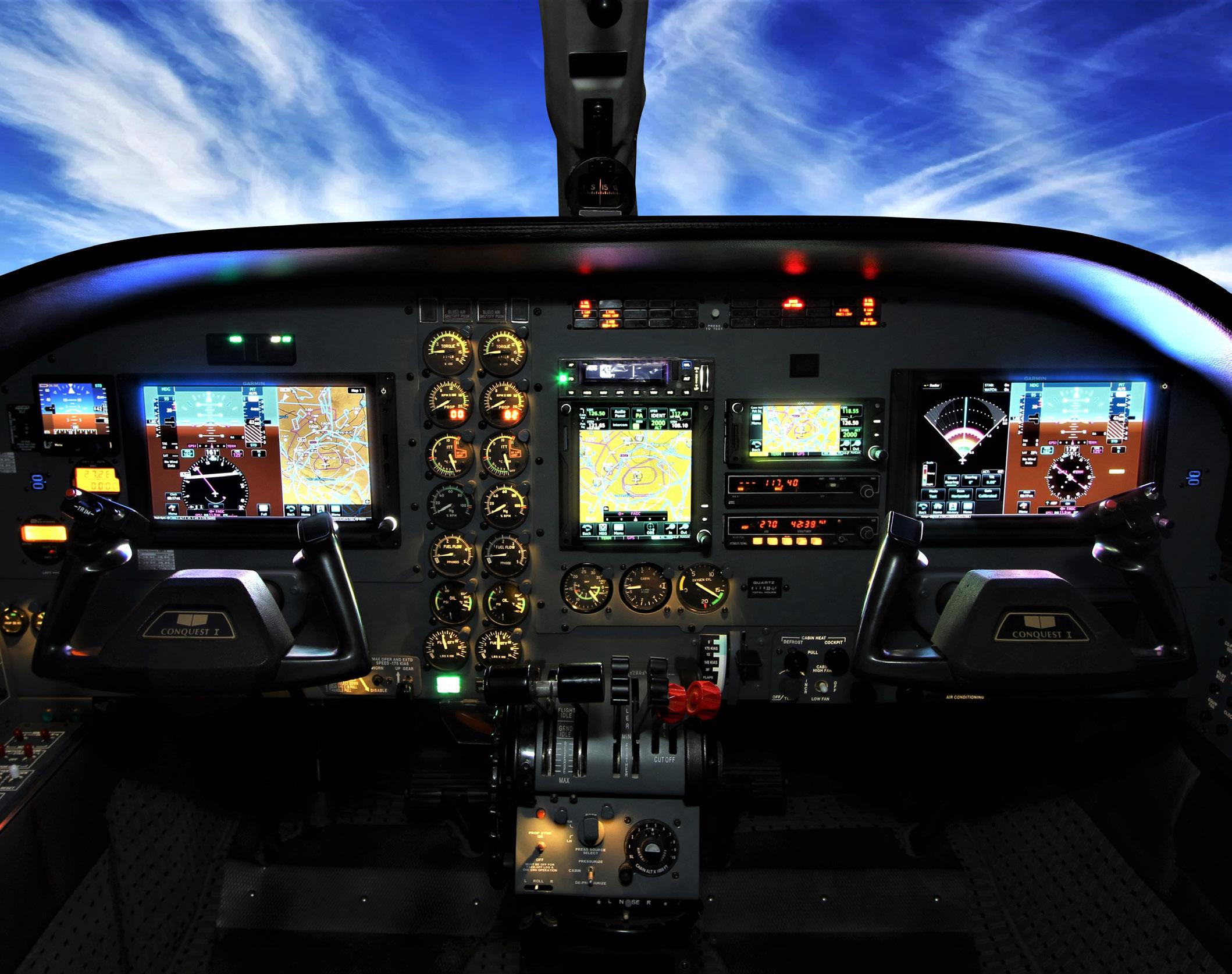

97 May 2024
The Cessna 425 before its upgrade.
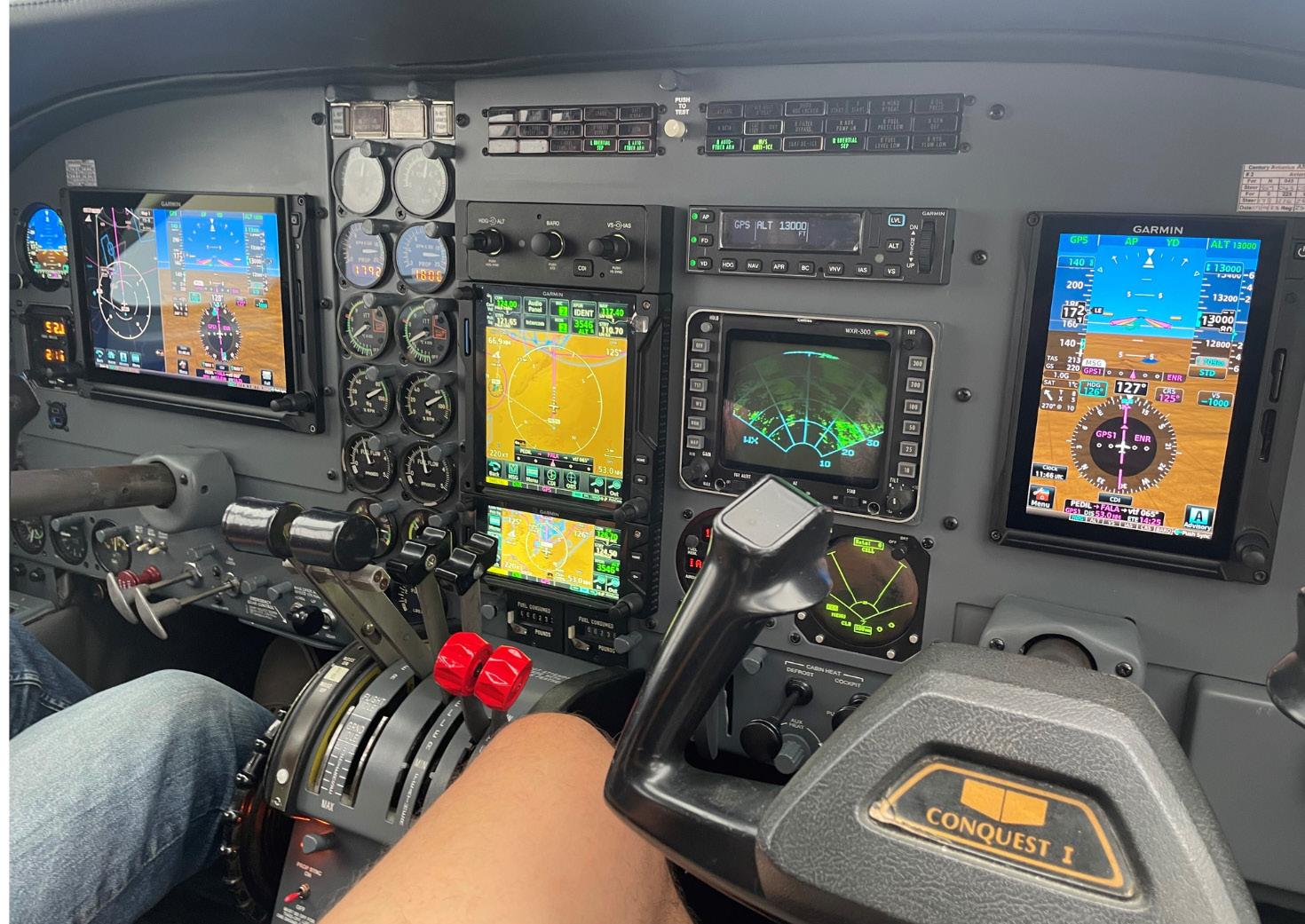
Designed to interface with a range of avionics, radios, navigators, and audio panels, the G600 Txi truly offers a vast array of features, options, and panel layout possibilities.
The dual-screen G600 TXi works with the avionics stack, pairing both a primary flight display (PFD) and a multi-function (MFD) display in a single 10-inch-wide bezel to provide a fully certified upgrade option for your cockpit. The G600 Txi requires two WAAS enabled receivers to provide navigational input to the G600Txi.
https://centuryavionics.co.za/product/garmin-gtn750-xi-series/
to enhance safety and situational awareness
The GTN-650Xi is the smaller, 2.64-inch-tall NAV/Comm/WAAS GPS package and is a fully integrated solution. With its state-of-the-art hardware, and boasting a large, ultrahigh-resolution display, wide viewing angle, and superior readability in the cockpit, it is the perfect choice. https:// centuryavionics.co.za/product/ garmin-gtn-650xi-series/
In the Cessna 425s the customers opted for the GTN-750Xi and GTN-650Xi Navigator bringing the best level of navigation and communication.
Pairing this with the bigger Garmin GTN 750 Xi navigator, the Garmin GTN 750 Xi is a powerful avionics system that offers a wide range of features to enhance navigation, communication, and situational awareness for pilots flying under both VFR and IFR. Naturally the GMA-35c
98 May 2024
Functionality and safety are much improved by the upgrades.
Century Avionics
remote mounted Audio panel is included (it works with the GTN 750 Xi) and contributes to more efficient pilot, crew and passenger communications and an organised cockpit environment, improving safety. The GTN-750Xi serves as a colour radar display for a weather information overlay to the moving map page, further providing a full picture of the weather and terrain en-route.
One of the very important considerations is an ADSB Transponder. The GTX-345 is a versatile and essential component of modern avionics and provides ADS-B compliance, traffic awareness, weather information (US only), and enhanced situational awareness to pilots flying in a variety of airspace environments. This transponder is AML STC approved specifically for general aviation aircraft, offering a range of features primarily focused on enhancing safety and compliance with modern airspace requirements, making this essential in our glass cockpit upgrade. https://centuryavionics.co.za/product/ garmin-gtx-345-w-r/
enhance safety and situational awareness. Their compact design, reliability, and integration capabilities make it a valuable asset for aircraft operators seeking to improve redundancy in their avionics. https://centuryavionics.co.za/ product/esi-500/
essential for a quality panel upgrade
The Garmin GFC 600 is an advanced digital autopilot designed for a wide range of aircraft, offering precise control and automation capabilities to enhance safety, comfort, and efficiency during flight. With its advanced technology, the GFC 600 can handle various flight situations, including climbs, descents, turns, and even coupled approaches, making this the perfect autopilot for our panel design functionality and installation. Overall, the integration of the GFC 600 autopilot to the Cessna 425 enhances the aircraft’s capabilities, making it more efficient and safer to operate, especially during long flights or in challenging weather conditions. https:// centuryavionics.co.za/product/ garmin-gfc-600-digital-autopilot/
Standby Instruments are essential for a quality panel upgrade. This can be accomplished by utilising the original airspeed, artificial horizon and altitude indicator. However often space constraints dictate the addition of an electronic standby indicator such as a GI-275 or ESI-500. https://centuryavionics.co.za/product/garmin-gi275-flight-decks-displays/
The GI-272 or ESI 500 Electronic Standby Instrument are a critical component of modern cockpit avionics, providing pilots with essential flight information and backup functionality to
Our technical and certification team works as a well-experienced unit to ensure certification requirements are complied with, whether a DAR (Designated Approved Representative) sign-off or a minor modification approval through SACAA is required.
Upgrade options and combinations for various aircraft are ever-increasing and Century Avionics is there to assist with your next avionics project. Let us upgrade your panel! j
99 May 2024




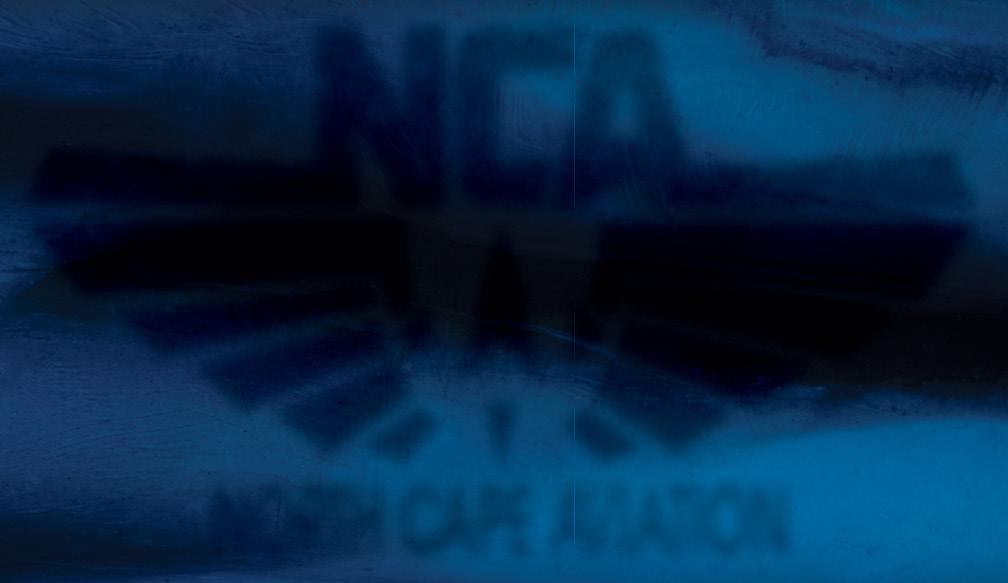


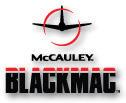


At Dynamic Propellers cc we overhaul and maintain all Hartzell, McCauley, MT-Propeller, Hoffmann, Dowty, Sensenich, Whirl Wind and Hamilton standard propellers to include metal and composite blades. We do all maintenance procedures related to aircraft propeller overhauls as called for by the various propeller manufacturers including cadmium plating.
Everything is performed in-house, including cold compression rolling on Hartzell propeller blades, as well as dynamic balancing of propellers in the field. Dynamic Propellers cc is an Authorised Service

Centre for MT-Propeller and Whirl Wind. Dynamic Propellers cc is also appointed as the sole McCauley Authorised Service Centre for the African continent.
We carry a large stock holding of fast moving propellers, hubs, parts, de-icing parts, overhaul kits etc. in our inventory to cater for Hartzell, McCauley, MT – Propeller, Hoffman, Dowty, Sensenich, Whirl Wind and Hamilton standard propellers. We do a huge amount of travelling to local, domestic and neighbouring countries as well as abroad to cater for customer’s propeller requirements.
102 May 2024
0 5 25 75 95 100
www.dynamicpropellers.co.za
Tel: +27 11 824 5057 • Fax2mail: 086 548 2651 E-mail: andries@dynamicpropeller.co.za • Andries: 082 445 4496

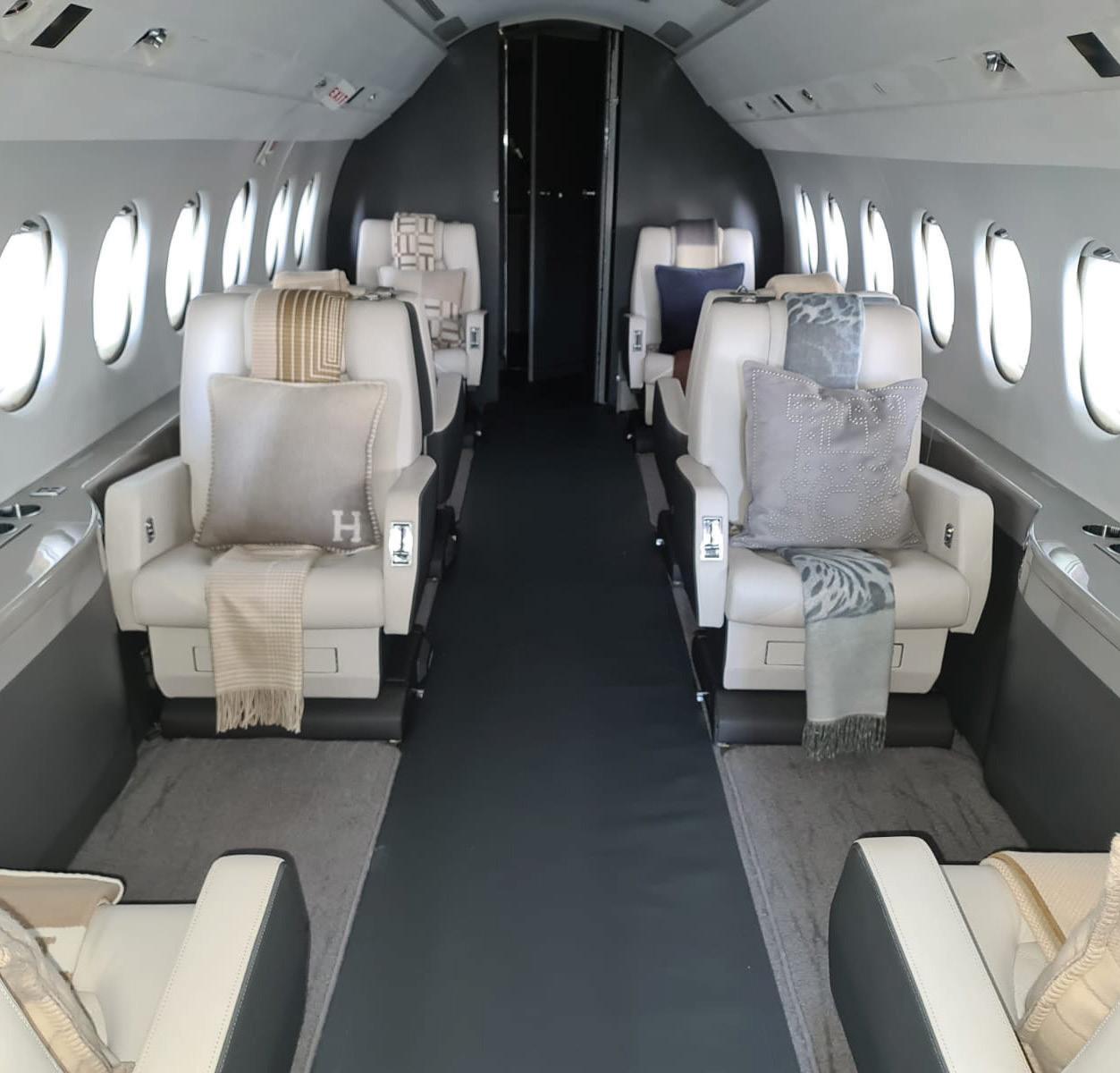
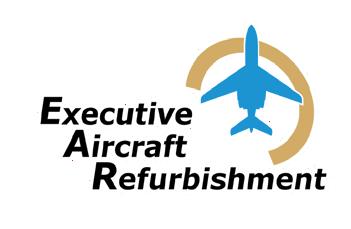



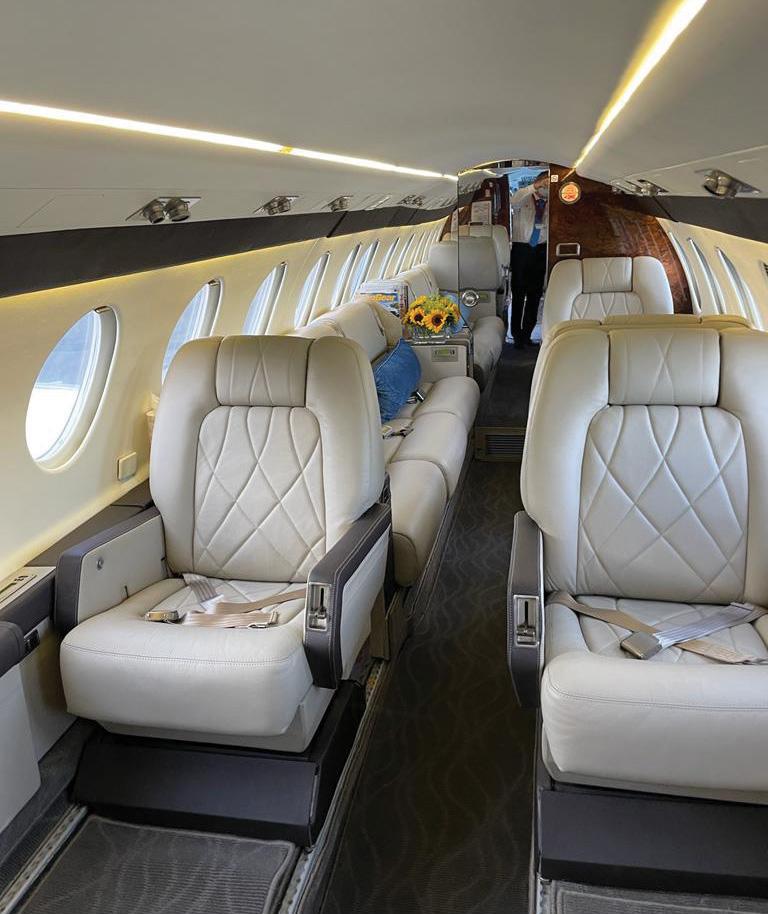

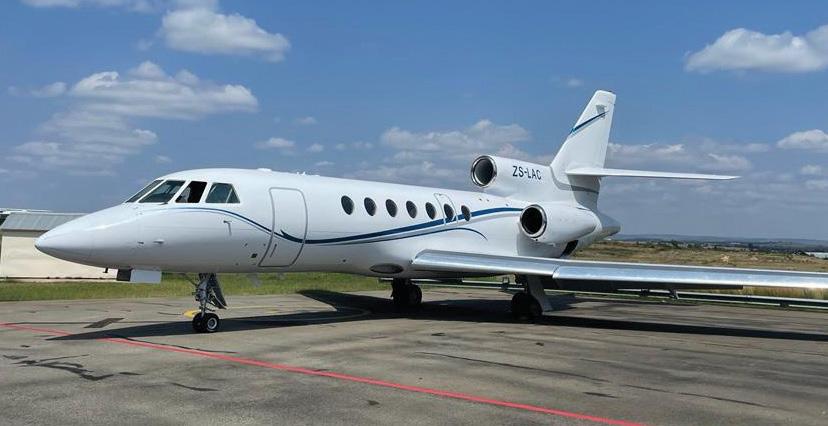
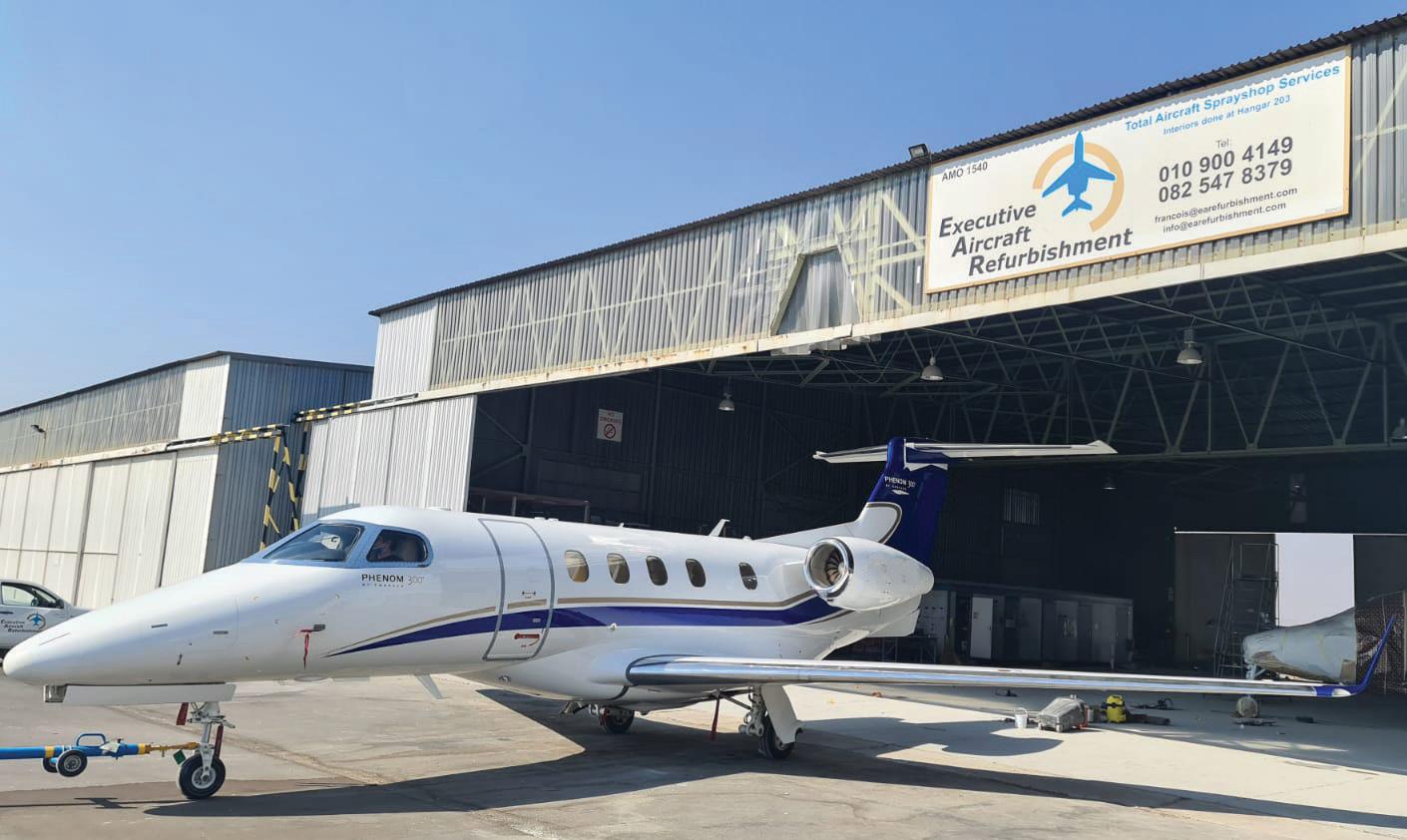

103 May 2024 C O M F O R T & Q U A L I T Y A I R C R A F T R E F U R B I S H M E N T Tel: +27 (0)10 900 4149 | Mobile: +27 (0)82 547 8379 Info@earefurbishment.com | Francois@earefurbishment.com Hangar 24 (Interior Shop) and Hangar 31 (Paint Shop). Lanseria International Airport, South Africa, Gate 5 North Side.


Where romance meets nature
Located in South Africa’s Safari hub of Hoedspruit, Safari Moon is a boutique base from which to discover the wonders of South Africa’s Lowveld region. Explore a range of nearby attractions from the famed Kruger National park to the scenic Panorama Route, or simply chose to relax and unwind in nature, making the most of your private piece of Wildlife Estate wilderness.
104 May 2024 FlightCom Magazine 35
CONTACT: bookings@safarimoon.co.za 083 449 5868

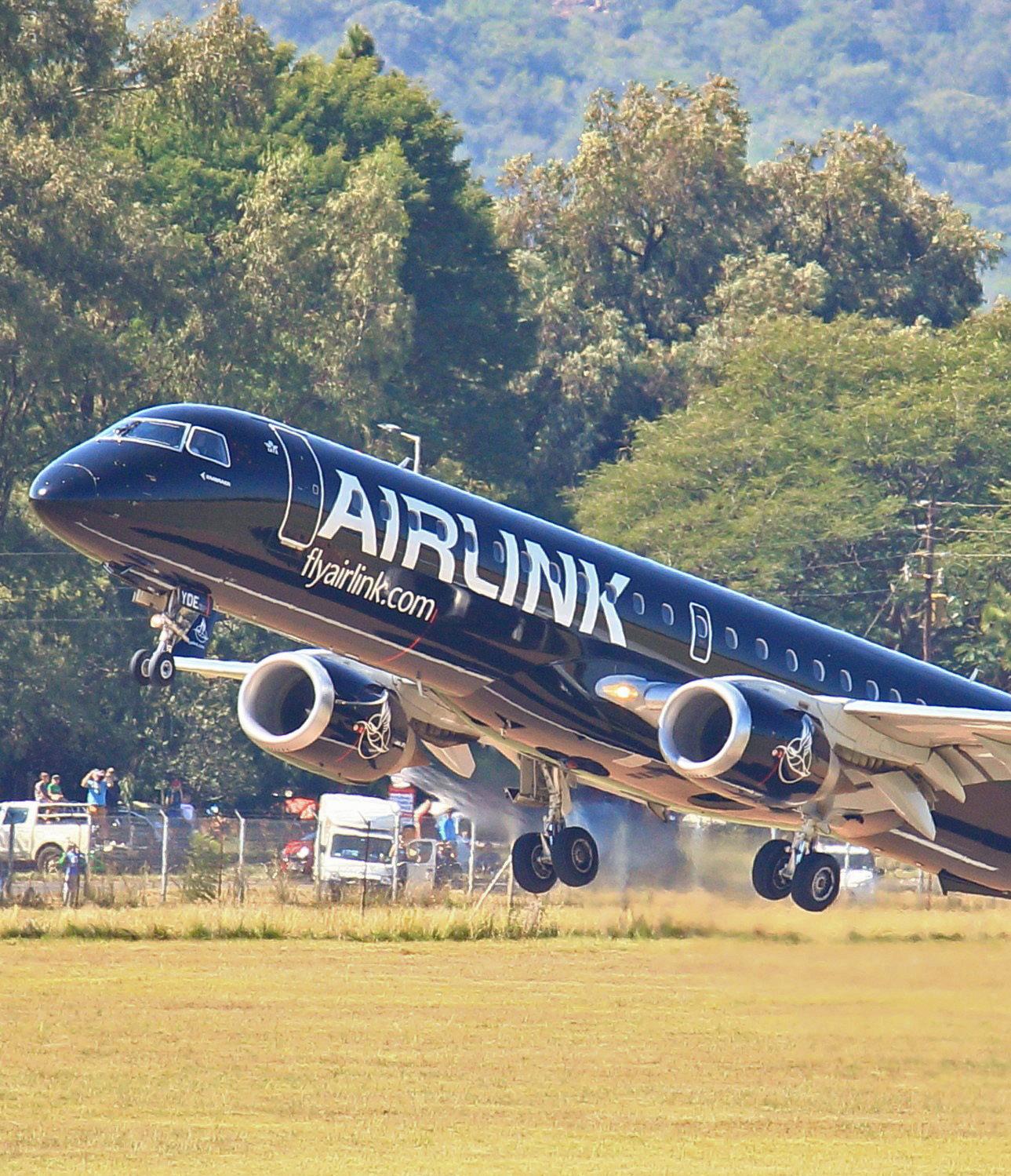
FlightCm Afr ican Commercial Aviation Edition 184 | May 2024 SACAA’s 25th Anniversary Air Show
John Bassi –Things Fall Apart Iris – Early Sudan days Okavango –Romantic exploits!
Cover: Trevor Cohen
Hugh Pryor - Teleportation Pt2
AME Directory
Laura McDermid - Iris flies across Sudan
News - SAA – Takatso deal investigation
News - Russian Tu-22M3 Backfire shot down
Jeffery Kempson - Okavango Dreaming Pt1
News - SITA Latest Airport Tool
John Bassi - When Things Fall Apart Pt1
Managing
Superior Pilot Services: Flight School Directory
Merchant West Charter Directory
Skysource AMO Listing
Backpage Directory
6358
Layout & Design
Patrick Tillman: Imagenuity cc
Contributors
John Bassi
Laura McDermid
Darren Olivier
Jeffery Kempson
(0)81 039 0595
(0)15 793 0708



MAY 2024 EDITION 184 TABLE OF CONTENTS +27
+27
+27
ADMIN: TRAFFIC: Publisher
cc
(0)83 607 2335
ACCOUNTS:
Flyer and Aviation Publications
Editor
Guy Leitch guy@flightcommag.com
Advertising Sales Howard Long sales@saflyermag.co.za 076 499
© FlightCom 2023. All rights reserved worldwide. No part of this publication may be reproduced, stored in a retrieval system, or transmitted by any means, electronically, mechanically, photocopied, recorded or otherwise without the express permission of the copyright holders. CAA’s 25th Anniversary Airshow 04 07 08 12 13 14 19 20 24 32 33 34 36
A NOTE FROM THE EDITOR:
In the provision of air connectivity, especially intra-African connectivity, a key motivation for African airlines is that they serve a very necessary developmental function for peripheral areas.
HOWEVER, THIS DEVELOPMENTAL function
may be uneconomic and thus would require government subsidy, either of the route, or the entire airline. And thus do African airlines have a major excuse to be loss making.
Over the past 100 years, there has been massive ruralurban migration and thus peripheral towns struggle to survive. It is argued that without government supported airline connectivity, many of these small towns would simply wither and die.
When potential investors look to set up factories or shops in regional towns one of the first questions asked is; is there a regular and safe airline service? Often these routes are too thin to be commercially viable for private sector operators and so it is argued that a state-owned carrier is needed for these routes.
with more passenger demand attracts bigger gauge aircraft that are far more efficient in seat mile costs than smaller gauge aircraft. The smaller aircraft are typically turboprops, which are not as popular with passengers as pure jets, and in some cases single engine aircraft such as the Cessna 208 Caravan and Pilatus PC-12.
$1.2 million to subsidise about 8 passengers.
The on-the-ground reality is that passengers will often choose to travel the 100 km by road to get to larger airports with better connectivity than use small aircraft on subsidised regional routes. The net effect is that it is not unusual for subsidised flights to be mostly empty. In Kingman, Arizona, the government paid $1.2 million a year to subsidise about eight passengers a day.
This is however a challenge that has been thoroughly explored in the United States which introduced the Essential Air Service program (EAS). The EAS programme was launched in the 1970s, when the US Congress deregulated the airlines yet needed to protect rural airports and air services. The EAS pays airlines a federal subsidy for each passenger they fly. However, like all market interventions, the subsidy has distorted the market, created inefficiencies and arguably, become unproductive.
In the USA, with its highly developed landscape, many of the cities the EAS subsidy benefits are less than 100 km from larger airports. A larger airport
Interestingly, where democracy has a fine balance between two dominant political parties, these subsidies are seldom challenged due to the political consequences. Thus, in the USA, efforts to reform the EAS subsidy have been rejected by Congress, where both Democrats and Republicans have defended the federal grants for their airports.
The many proponents of airline state ownership argue that profitability should be secondary, given the stimulating effect it provides for the economy. But the experience of the American EAS subsidy proves otherwise. African governments would do well to heed the market lessons of the EAS programme.
PART 2
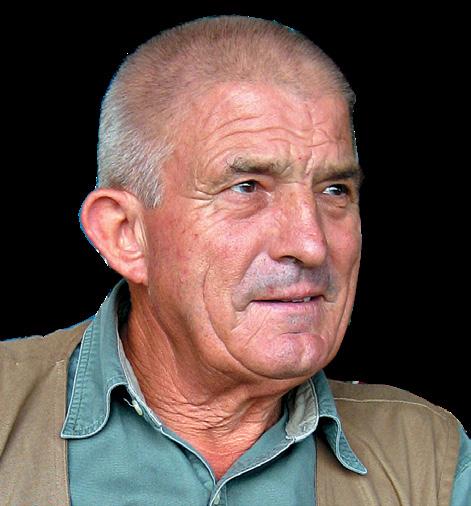
TELEPORTATION
Hugh continues his story of the great debates about where a comely future SAA pilot has a tattoo – and whether teleportation will destroy pilot jobs.
“ TELEPORTATION!” shouted Ian, the only direct BP employee on site and therefore the chairperson of the proceedings on this particular occasion, “Is the topic for our discussions this evening. It was suggested by Captain Andrew, and therefore I would ask him to introduce the uninitiated to this fascinating subject”
The collective focus of the congregation panned from the beguiling jeans-belly T-shirt interface to the large form of Andrew as he rose majestically to his feet.
“Lady,” a courtly nod in Chris’s direction, “And Gentlemen.” Andrew gathered up eye-contacts from the rest of the audience, “...a kangaroo leap in the pursuit of knowledge on the subject of Quantum Mechanics was reported in the newspapers this last week.”
Now all eyes were on Andrew.
A hush settled on the floor of the house.
“The significance of this event needs hardly to be emphasised. The prospect of long-distance space travel becomes a possibility denied by earlier concepts of space and time. ‘Infinity’ becomes ‘now’. The Quantum Revolution is upon us and I would ask you to contemplate, for a moment, the ways this may affect you personally and humanity as a whole.
twenty-three hours in the back of a Jumbo Jet
“Then I would like you to consider the benefits and disadvantages of the event and decide whether you feel that we should pursue this technology further or attempt to nip it in the bud and outlaw it from the start.”
“An act of teleportation was carried out and verified at a university in Australia. Not quite ‘Beam me up, Bruce!’ just yet, though. One single atom of Hydrogen was teleported from one side of a room to the other... instantly...in no measurable period of time at all.”
Andrew resumed his seat, and the floor was taken by Geoff, a big-framed Canadian drilling engineer who was, incidentally, the unlikely collector and breeder of minute little ponies. “Well, I don’t know about you, folks,” he smiled, “but if I was given the choice of spending twenty-three hours crumpled up in the back of a Jumbo Jet, to get from London to Sydney Australia, surrounded by caterwauling kids and puking parents, or just popping down to the teleporters, spending an extra fifty bucks and being zapped there
4 FlightCom: May 2024
BUSH PILOT HUGH PRYOR
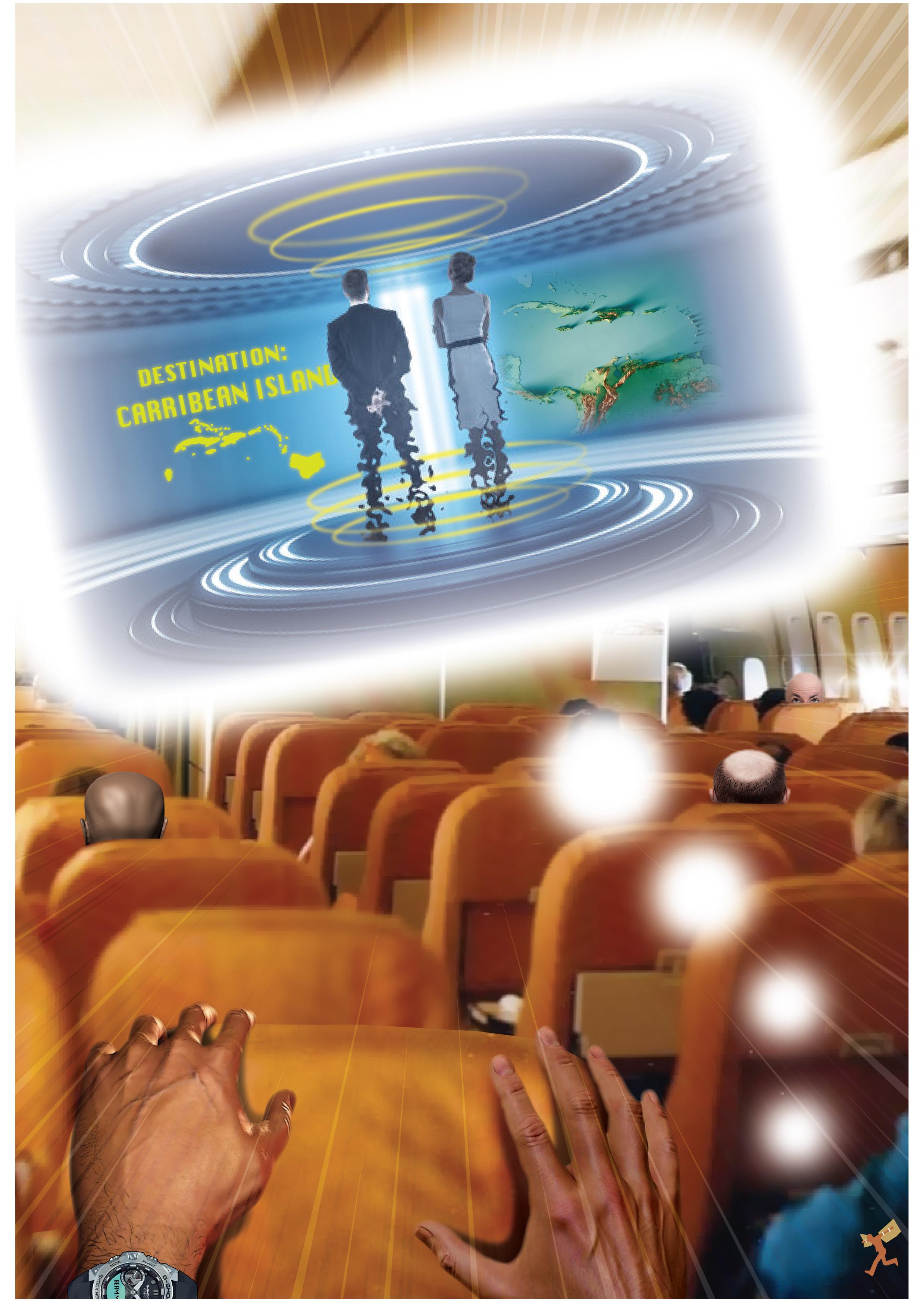
direct, instantly, I know which I would chose.”
Chris then stood up, her chin and various other delightful features jutting forward defiantly. “Well, as you guys already know, I have just set out on an airline career.”
Her voice rang out daintily in contrast to the low growling timbre of the rest of the speakers. “I have spent the last four years studying for a profession which can take a whole lifetime to achieve the ultimate goal.”
I found the vision of Christine, with the four gold bars of command, gleaming in support of the golden tresses adorning her exquisite visage, quite captivating, speaking of ultimate goals.
“I cannot support a technology which threatens to destroy so many thousands of years of experience, skill and tradition. The Quantum Revolution will be the end of the human race as we know it.”
There followed a short pause, while the participants absorbed the tragedy of not being able to see Chris in uniform if the new technology were ever allowed to take over. Then John, a large English drilling engineer, with a reputation for having a powerful intellectual mind, assumed the stand, using his glasses as a theatrical prop to conduct his discourse.
would have to be dematerialised permanently into a kind of nondimentional limbo, before we discovered how to rematerialize them. With all the inherent dangers of aviation, it was still one of the safest forms of transport ever invented, whereas teleportation was, until just recently the stuff of science fiction.
An amused grin spread across Andrew’s face, “Yes,” he said smiling. “The teleporters are bound to have many of the same problems as the present day airline industry. Lost baggage is still going to be one of the features of any future mode of transport. Imagine, if you will for a moment, the reaction of the doting Australian mother when she finds that her darling little Johnnie, freshly zapped back from school in England, has been rematerialized with an enormous pair of black ones!”
The World’s Favourite Civil Aviation Magazine
Andrew’s audience were warming to the subject. There was a shout of, “Probably not as violent as the reaction of Mr. Bicycle Olepombafoo, when he reappears in Obongobongoland, to discover that he’s got a silly little pair of white ones!”
A guffaw of laughter rippled around the little bar as imaginations started to takeoff on their own.
“But of course, there would be the nice lady in the Lost Baggage Office,” said Estfand, an Iranian drilling engineer, making his first contribution to a Teguentour debate.
“Much though I bewail the more regrettable effects of Quantum Mechanics on the career of someone so delightfully enthusiastic as the young lady here, we cannot ignore the future. Quantum Mechanics will come, whether it is promoted or prohibited. Our most important task, as I see it, is to try and understand it deeply enough to be able to harness it responsibly for the benefit of our young friend here and for mankind as a whole.”
I briefly chipped in to draw attention to the dangers inherent in the new thinking. How many individuals
“She would produce that Lost Property chart, you know, the one with all the different shapes and sizes of luggage on it, only this time it would not just be about luggage, would it? She would ask you to identify the missing items, in order to facilitate their repatriation to their original owner as quickly as possible, which could be quite quick, with quantum mechanics around.”
“What about if Darling Little Johnnie didn’t want to lose his new acquisitions.” Chris was wiping away tears of laughter from her eyes as she spoke. “How
6 FlightCom: May 2024
HUGH PRYOR
would Mr Olepombafoo then get his own back, so to speak?”
“Maybe he would have to visit the teleporters’ monthly e-bay auction of unclaimed body parts and see if they had any suitable substitutes for his missing bits.” said Nigel, our Medic. “He’d have to find somebody else to fit them though. I wouldn’t touch the things. You’d never know where they might have been!”
The ribaldry giggled away until the beer was finished, and beds beckoned. No decision was reached about whether the new technology should be encouraged or abhorred, but even as I laid my head on the pillow, my brain was buzzing with the vast oceans of new knowledge opened up by Quantum physics.
I couldn’t help wondering whether the human race would be up to the challenge. So many things would become irrelevant. Air travel, for a start. Just imagine a world without aircraft. Think of the number of people
looking for jobs. Not just pilots, not just engineers but all the people who run airports and build aeroplanes.
Just imagine a world without airports. Just imagine a world without airplane magazines. What would they call the new Quantum Mechanics magazine, which replaced them? Probably something original like: QM.
I know quite a reasonable Editor, if they are looking for one. He’s currently editing what he touchingly calls, “The World’s Favourite Civil Aviation Magazine” in the United States, but I don’t know how long they will be able to struggle on, with publications like QM coming onto the shelves, do you?

AME Doctors Listing
Britz Rudi Wonderboom Airport 083 422 9882 rudiavmed@gmail.com
Church Belinda Valhalla 079 636 9860 churchbs@live.com
Du Plessis Alexander Athlone Park 031 904 7460 dex.duplessis@intercare.co.za
Erasmus Philip Benoni 011 849 6512 pdceras-ass@mweb.co.za
Govender Deena Umhlanga Rocks 031 566 2066/7 deena@drdg.co.za
Ingham Kenneth Midrand 011 315 5817 kaingham@hotmail.com
Marais Eugene Mossel Bay 044 693 1470 eugene.marais@medicross.co.za
Opperman Chris Pretoria Lynnwood 012 368 8800 chris.opperman@intercare.co.za
Tenzer Stan Rand Airport & JHB CBD 083 679 0777 stant@global.co.za
Toerien Hendrik White River, Nelspruit 013 751 3848 hctoerien@viamediswitch.co.za
Van Der Merwe Johann Stellenbosch 021 887 0305 johann.vdmerwe@medicross.co.za
FlightCom: May 2024 7
Regular Class 2, 3, 4 Senior Class 1, 2, 3, 4 On site Specialist tests Off-site Specialist tests FAA registered EASA registered Other countries SURNAME FIRST NAME LOCATION TEL NO E-MAIL
✗ ✗ ✗ ✗
✗ ✗
✗ ✗ ✗
✗ ✗
✗ ✗
✗ ✗ ✗ ✗
✗ ✗
✗ ✗ ✗
✗ ✗ ✗
✗ ✗ ✗
✗ ✗
Iris – her early years:
IRIS FLIES ACROSS SUDAN
Laura McDermid continues her stories about Iris McCallum’s early years in East Africa and the Sudan.
THE FIVE MONTHS THAT I’d been at Sunbird Aviation had been a steep learning curve in terms of learning how to navigate unchartered territories using only a watch and a compass.
I found that the most difficult aspect of this was to keep the faith. I soon learned that the secret to bush flying is to maintain your heading, and not to do anything stupid by trying to correct something you have no control over.
Easier said than done of course.
These were all new places, and not many pilots had flown there.
Whenever I was unsure of a route, I would consult one of my colleagues. I sought out Captain Douglas Bird, inevitably named Dicky Bird.
there are no land marks and no nav aids
On 8 September 1980, I was to fly a bunch of Belgian Missionaries, who were based in Aweil, a city in northwestern South Sudan near the Sudanese border, from Wilson Airport in Nairobi in my old mate ‘ARN’, the Piper Aztec 5Y-ARN.
In order to clear customs and refuel, we had to fly to Juba, the capital of South Sudan, a distance of 489 nm and then a further 343 nm to Aweil.
Dicky Bird had done my first Kenyan instrument rating on his Piper Twin Comanche PA-30 (known amongst the pilots as the ‘widow maker’). I had previously done a twin rating on a PA-30 in the USA, and was comfortable flying the aircraft, even after not having flown one in a long time.
The aeroplane was VMC critical and was known to live up to its nickname if flown in adverse weather. Having only ever flown the PA-30 at sea level in Florida, flying this aircraft at altitude was a wonderful challenge.
8 FlightCom: May 2024
LAURA MCDERMID

Dicky Bird brought out some large Operational Navigation Charts (ONC) and laid them out on the board room table. ‘Iris, the most difficult part of this trip will be from Bor to Aweil’, he drew a line with his pencil between the two points, ‘there are no land marks and no navigation aids.’
He took out his protractor and ruler and measured the distance.
‘You’re going to be flying approximately two and half hours over the Sudd.’
‘Iris don’t fly directly from Bor to Aweil, fly to Wau instead and most importantly pick up the railway line.’ He drew a squiggly line on the map punctuated with bisecting lines, indicating the railway line.
‘Once you find it, turn right; Wau is at the end of the line. From there it’s not a long fight to Aweil, just stick to your compass heading and time.’
Once you find it, turn right
The Sudd is a vast swamp in South Sudan formed by the White Nile’s Bahr al-Jabal section and is the largest freshwater wetland in the Nile Basin, covering an area of 500 km south to north and 200 km east to west.
The Arabic word Sudd means ‘obstruction’, as indeed this swamp proved to many intrepid explorers over the centuries.
‘Oh and Iris, another thing, never ask your passengers if they recognise anything from the air because they won’t, even if they’ve been there a thousand times.’
I was all set.
Kenya Breweries had just launched the Tusker bottles for export, which we fondly nicknamed Dumpies.
Having learned early on that you had to be selfsufficient on these trips if you wanted a cool beer at the end of a long hot day, I managed to squeeze six of them into my mini green cool bag with an ice pack.
FlightCom: May 2024 9
Juba Airport circa 1980.
It was the morning of the departure. I glanced at my watch for the umpteenth time willing the hands to freeze. My passengers were late which meant that I’d be chasing the sun that afternoon.
Furthermore, flying in the rift valley as it was heating up always meant a rough ride.
By the time we got through customs and immigration at Wilson, my airborne time was 10h30.
I flew north along the Great Rift Valley, skirting Nakuru National Park, over the Turkwell Gorge, along the river via Eldoret and over Kitale on the Western wall of the Rift west of Lake Victoria, and within sight of Mt. Elgon.
I
I remained high over the Lolibai and Dongatona Mountains, until I was cleared to descend into Juba.
The flight took 3.5 hours. Due to a difference in time zones, we had gained an hour, a small win.
As I opened ARN’s door, a wall of heat hit me. I felt as if I’d been punched in the solar plexus. I tried to suck air into my lungs, but it seemed devoid of oxygen and my mouth gasped stupidly like a fish on dry land. The heat scorched my eyeballs and leached every ounce of moisture out of them.
blinked to stimulate my tearducts
The land here was predominantly used for farming, and was a rich verdant green, a testament to the fertile soil.
The sun was now directly above me, pressing my shadow into a tight ball.
I blinked rapidly in a vain attempt to stimulate my tear-ducts; each time I closed my eyes it felt like sandpaper behind my eyelids.
After refuelling the aircraft, I tackled the nauseating process of immigration and customs, ushering my passengers into the airport. In the arrival lounge, old fans whirled overhead at almost zero RPM. They

10 FlightCom: May 2024
PILOTS
The Sudd.

didn’t help to cool things down, in fact they seemed to spread the heat. I watched as the fans above my head groaned impotently, no doubt slowed by years of fly shit.
We departed Juba at 13h30 local time for Bor. The soft, superheated air rising from the runway offered so little body for the wings that we ascended reluctantly, seeming actually to sag when the wheels broke ground and sometimes barely surmounting the oncoming trees.
As expected, the flight was rough
As expected, the flight was rough. I heard one of my passengers vomit noisily into an air-sick bag. That’ll teach the buggers for being late.
This part of the trip was still easy, I just followed the White Nile North for about 40 minutes to find Bor airstrip. The Nile held an excitement and allure when viewed from the air. This river had so much history that, regardless of how many times I laid eyes on it, it was like seeing it for the first time.
I landed at Bor and offloaded the supplies that I’d bought with from Nairobi for the local mission, and topped ARN up with avgas.
We spent 40 minutes on the ground and got airborne at 16h00 for Aweil via Wau.
FlightCom: May 2024 11
Aerial view of Aweil, capital of Northern Bahr el Ghazal in South Sudan.
SAA – TAKATSO DEAL INVESTIGATION
THE SOUTH AFRICAN Special Investigating Unit (SIU) is investigating the failed sale of South African Airways (SAA) to the Takatso Consortium.
Parliament’s Public Enterprises Portfolio committee recommended that the SIU should investigate the nowcancelled deal.
In November 2023, SIU chief investigator Leonard Lekgetho told parliament's SCOPA that the SIU received new allegations in relation to the SAATakatso deal, which was undergoing SIU internal processes of assessment.
“The SIU has made requests for information from various sources that include the Competition Commission, the auditor-general and the Department
of Public Enterprises in order to assess and motivate for a proclamation. The information is being packaged and is to be submitted soon from various entities,” he said at the time.
Kganyago indicated that should the SIU’s current investigation at SAA find anything on the SAA-Takatso matter, “if it falls under the existing proclamation, we take it and continue with the investigations”. The Department of Public Enterprises did not respond to a request for comment. Minister Pravin Gordhan had threatened to take the portfolio committee to court over its decision to call for the SIU to probe the failed deal. Political parties across the complete spectrum welcomed the proactive stance by the SIU, while Parliament has yet to make a formal referral.
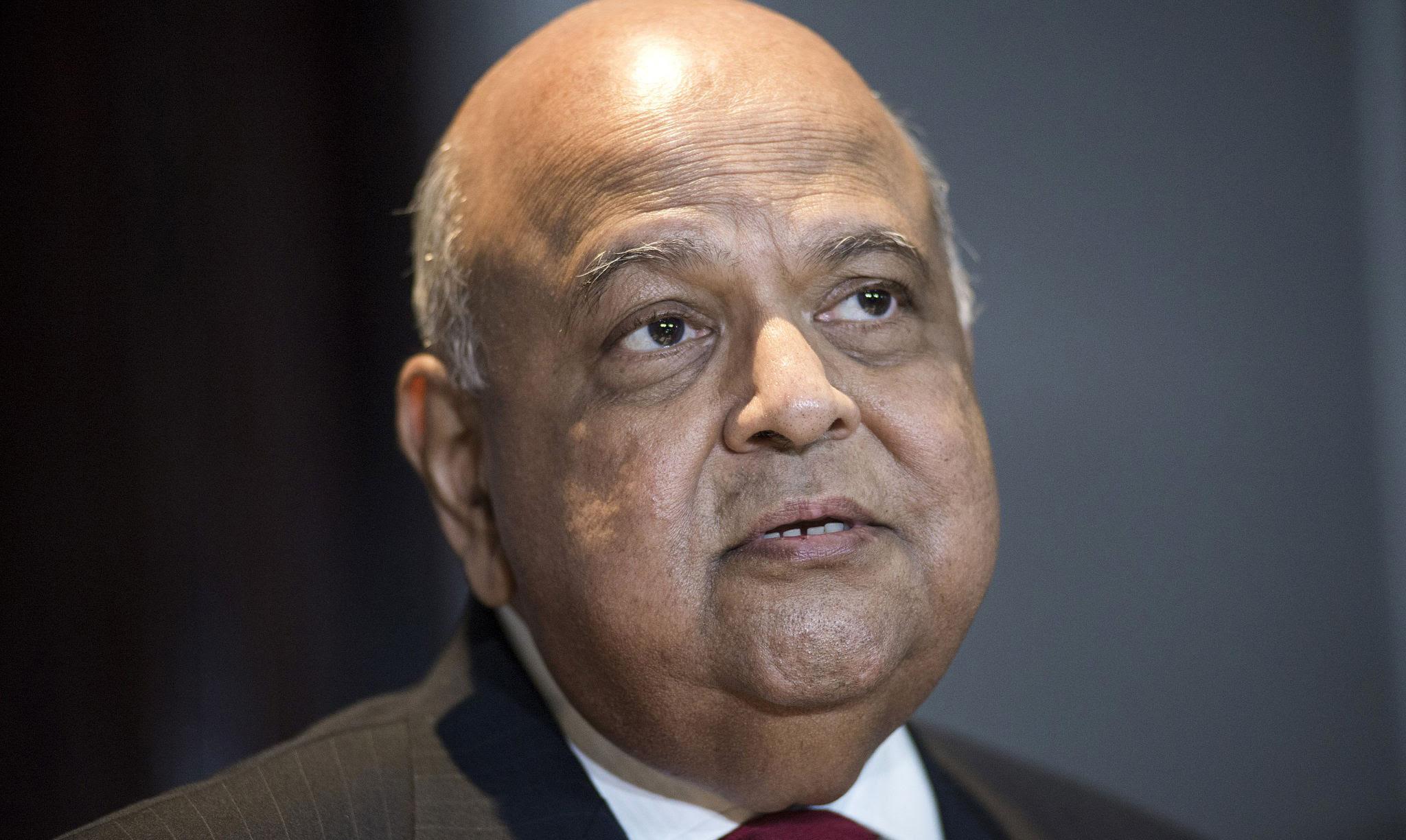
12 FlightCom: May 2024
NEWS
Pravin Gordhan threatened to take the parliament portfolio committee to court.
RUSSIAN TU-22M3
BACKFIRE SHOT DOWN
In a hugely significant loss for Russia, Ukraine has claimed that it shot down a Tu-22M3 Backfire-C bomber in the Stavropol region in southern Russia.
Lt. Gen. Kyrylo Budanov, the head of the Ukrainian Ministry of Defence’s Main Directorate of Intelligence (GUR), claimed that the large Russian bomber was brought down by a Soviet-era S-200 (SA-5 Gammon) long-range surface-to-air missile.
A social media video shows the aircraft spiralling toward the ground, in an apparent flat spin, with its rear fuselage on fire. Subsequent photos and a video show the wreckage of the bomber on the ground, still burning.
Ukraine claimed responsibility for the destruction of the bomber saying the Tu-22M3 was returning from a missile attack against Ukraine when it was shot down ‘at a distance of about 300 kilometres from Ukraine.’
The Russian Ministry of Defence confirmed that a Tu-22M3 crashed ‘In Stavropol territory, while returning to its base after carrying out a combat task. The ministry said that all four crew members ejected. The Russians blamed a ‘technical malfunction’ for the incident, saying this was based on initial information and said the Backfire was not carrying munitions at the time of the crash.

FlightCom: May 2024 13
NEWS
The still-burning wreck of the Russian Backfire bomber.
JEFFERY KEMPSON
PART 1
OKAVANGO DREAMING:
A trilogy of tropical airborne romances.
Mopani trees occur in tropical southern Africa. They have distinctive leaves that resemble butterfly wings. Within the belt of Mopani trees in northern Botswana, there lived three beautiful blonde, blue eyed girls who dramatically affected my flying life.
THE FIRST GIRL LIVED on a houseboat at Shakawe, on the Okavango panhandle in north western Botswana. I landed there while operating a scheduled flight for one of the earlier versions of Air Botswana.
In physical beauty, this lady on a scale of 1 to 10, was an 11. She was well spoken, with beautifullymodulated cadences and a captivatingly musical laugh.
I urged my girlfriend to hurry AFRICA
In the evenings she ran the bar at the fishing camp, where I would spend happy hours wooing her with hopefully amusing repartee. This was rewarded with numerous starspangled nights aboard her quaint but comfortable houseboat.
One memorable afternoon we boarded a tourist boat and set off down river between picturesque avenues of papyrus, to picnic on a sand bank.
Many sand banks were already occupied by basking crocodiles, so we kept going. About thirty minutes later we nosed onto a large crocodile-free sandbank on the inside meander of the river. We pulled the bow ashore, opened a bottle of wine, and ate freshly prepared sandwiches.
Later we slipped off our swimming costumes and made memorable love.
The afternoon was fading as we packed the picnic box and towels back into the boat. She climbed aboard and made her way aft as I pushed us off the sandbank. The boat suddenly broke free of the grip of the sand and I fell flat on my face .
I watched the current carry the boat out of reach. She laughed and pulled the outboard’s starting rope. Nothing. She pulled it again, and again.
14 FlightCom: May 2024
FLYING
The current took the boat ever faster down river from the fishing camp.
I shouted to her to connect the fuel pipe to the spare fuel tank.
As she did this, the boat drifted around the bend in the river, and I realised this was now a really seriously situation.
Then I heard the engine start, but it died after a few moments. I shouted to her to press the rubber priming bulb, but I don’t know whether she heard me. Then after what seemed like an eternity, I heard the boat’s engine start – and keep running. I felt a great surge of relief.
for a two-night stop, and told him that I wanted to do his flight. As I was the Chief Pilot, and also a director of the company, he did not demur, particularly as both involved stays at pleasant riverside locations, with beer at staff-rates for pilots.
‘My husband and daughter.’
Bearing in mind the old adage that “Faint heart never won fair lady” I had, with some trepidation, decided to present the Shakawe blonde with the option of remaining with her estranged husband and daughter, or coming to live happily ever after with me in northern Joburg.
I looked for hungry crocodiles but happily saw none, as the boat approached against the current. I waded out and hauled myself aboard. We had both been more frightened than we cared to admit.
Some weeks later, I noticed a young girl in the blonde’s company, together with a handsome young male stranger sitting separately in the bar area. Later, as the lady and I strolled to her houseboat, this chap sprang out from behind a bush and bade us each, by name, good night.
I muttered a thanks. After boarding the houseboat I asked my lady friend who the fellow and the young girl were
‘My husband and daughter.’
It transpired that the estranged husband was trying for a reconciliation. The houseboat did not rock that night.
A week later, I was at Maun with an Aero Commander 500B, which I was to fly to Kasane for a two-night stop. Back then, there was almost no phone connection with many of the outlying locations. Communication was principally through side band radios, on a schedule set by the game lodges.
I found the other pilot, who was due to fly to Shakawe
It was an awkward few days. But on the second morning I took off from Shakawe with the blonde by my side and her daughter in the cabin.
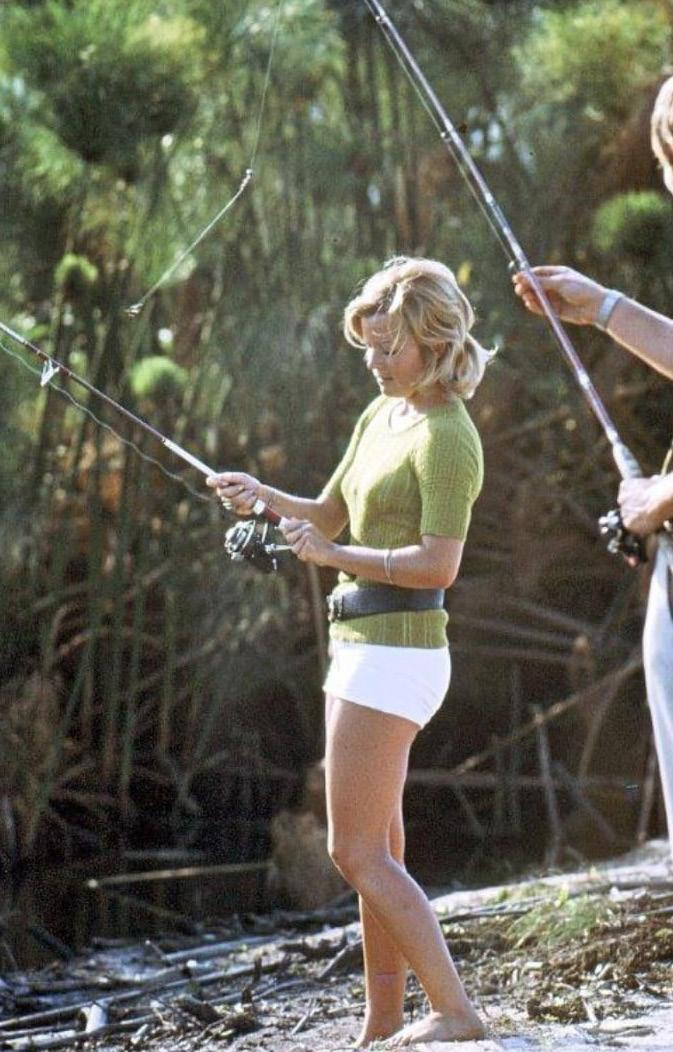
FlightCom: May 2024 15
On a scale of 1 to 10, she was an 11.
JEFFERY KEMPSON
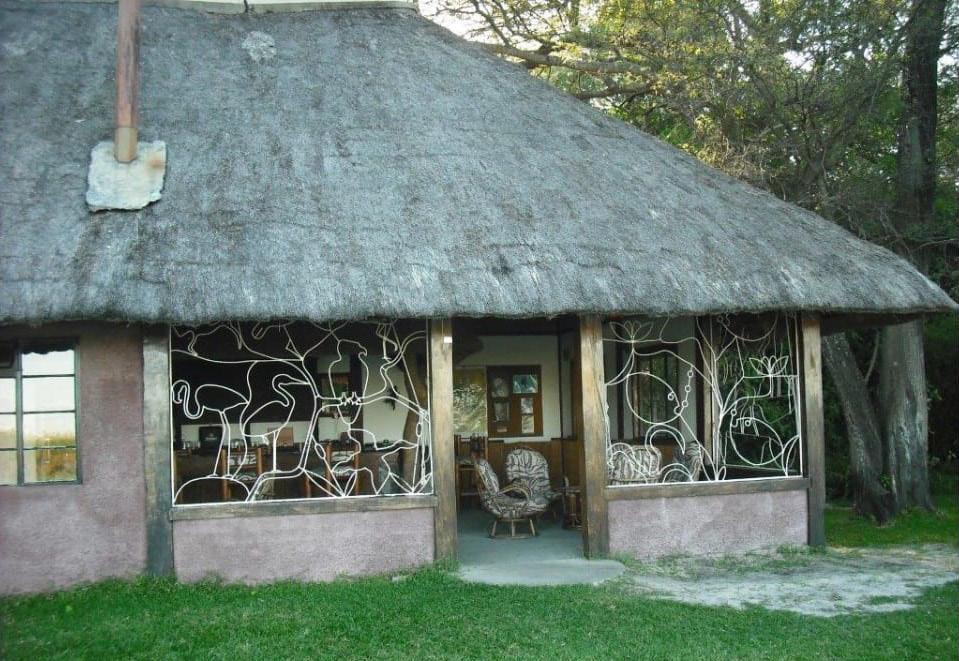
As we climbed away over the fishing camp, she said; “He’ll be down there, drinking and crying.”
Her words were sobering . I reduced the power and started to turn back. She put a hand on my knee and said, “Don’t go back. I’ve already left him, so if you don’t take us away now, we’ll just have to leave some other way.”
I pushed the throttles back up and turned back on track.
One of the passengers asked, ‘Are we going back?’
“No.” I replied, “I thought I saw an elephant, but it’s gone.” Mollified he relaxed in his seat.
The thought of the husband and father weeping in the riverside bar, as the sound of my engines carried his wife and daughter away, has burdened me ever since.
Her mother lived in Francistown, so I dropped her there for a few of days while I continued scheduled flying.
Then I collected her and flew the late afternoon schedule to Selebe Phikwe, then onto Gaborone.
Half an hour after leaving Selebe Phikwe the sun set and I turned on the red instrument lights, which back then were the norm to preserve the pilot’s night vision. I closed the curtain between the cabin and the cockpit. Then I wound out the trailing HF aerial to make the half hourly Ops normal calls to Jan Smuts. In those days most of Botswana lay within the Johannesburg FIR.
Sometime later, I tuned the radio to a Rhodesian music station, then handed a headset to my girlfriend. None of our autopilots worked, so we hand flew everywhere, which was not a hardship in an inherently stable plane.
The cockpit grew a little chilly, so I switched on the Janitrol heater in the nose and was gratified that it didn’t explode on this first winter ignition, flooding the windscreen with burning avgas. Then I selected a temperature that would dissuade passengers from opening the curtain to request a heating change.
16 FlightCom: May 2024
The bar at Shakawe Fishing Camp.
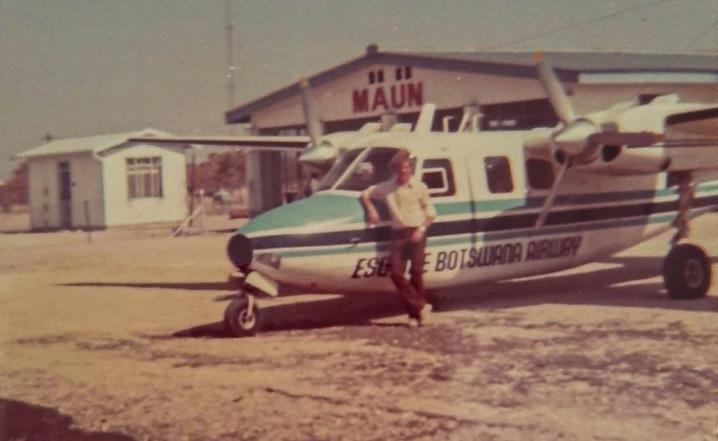
A little later, with her hand on my thigh, my new girlfriend became amorous.
Just then the radio started playing the Shirley Bassey hit “Never Never Never.” I sang softly along to the music and thought that it doesn’t get any better than this. It’s been worth all the flight tuition fees, passing the Commercial Pilot exams, the stringent flight tests, and medical examinations.
Sometime later, as I began the descent, my beautiful new princess shifted position, and began to arouse me in earnest.
my right hand to close the throttles, flared, and touched down smoothly. Clearing the runway, I realised I’d forgotten to wind in the trailing HF aerial, which now adorned the airport’s boundary fence. It was worth it.
my engines carried his wife and daughter
I set up a long final approach towards the extended centre line of the runway and switched on the landing lights to pick up the reflectors along the runway edges.
Gaborone gave me a direct approach to the runway.
I urged my girlfriend to hurry, she giggled. I took flaps, selected gear, and slowed to the minimum approach speed. I stroked her hair, and sometime later moved
We set up home in a house north west of Johannesburg, anticipating the construction of Lanseria Airport, then later moved to a cottage in Rivonia. I could spend a week or more at home. I took up photography and learnt about f-stops, shutter speeds and the like, and became fairly proficient. I turned a bedroom into a dark room, developed the black and white negatives, used an enlarger and made prints. Some I merged into “Photo Shop” type renditions with moderate success.
I only took pictures of my ultra-photogenic new girlfriend and aeroplanes. Until one day she declared that she was tired of smiling into a camera, and also fed up with the smell of photographic chemicals in the house. So I quit photography.
FlightCom: May 2024 17
Jeffery Kempson with an Aero Commander 500B at Maun in the 70s.
Dining out with her could be a mixed blessing. Walking into a busy northern suburbs restaurant often caused a lull in conversation, as husbands and boyfriends gawked, and their wives and girlfriends sometimes glowered at my partner, the smiling femme fatale.
We lived together for nearly three years, and were very happy at times, though my long and frequent flying absences put an inevitable strain on our relationship, not helped when I bought the growing daughter a bicycle and a model train for her birthday.
I thought that professional pilots constituted a higher life form, and that any sensible girl would be happy and proud to welcome her man home after transiting the dangerous sky. Apparently, she did not share my view.
We parted amicably, and she kept the car I bought her, and the furniture which I was still paying off. We later tried a couple of reconciliations, which didn’t really work out.
After a long and uncomfortable silence he said, “That morning, when I heard your plane’s engine note change, I thought you were bringing my wife and daughter back. So I walked out the bar, but then you turned and flew away. That felt like the end of my life!”
We both cried. As the sun set, we finished discussing how the blonde had ultimately blighted both our lives.
We stood up, shook hands, and he walked away. In the intervening years I had heard that he was a good man. Our shared misery had been cathartic, and as I descended the stairs towards the breakfast room the following morning, I felt a lightness of being, perhaps occasioned by a large karmic debt having been paid.
quell memories just a tear away
In retrospect I was too proud – and a little immature in my view that a professional aviator must be a prestigious catch.
A few years on I saw a picture of her now grown-up daughter on the back of the Sunday Times. She had become a beautiful model. It could not have been otherwise.
Many years later, I flew a charter flight to Victoria Falls, and one afternoon, while sitting on a bench under a large fig tree in the grounds of the Victoria Falls Hotel, a man sat down beside me, and said, “Hello Jeff.”
My blood froze; “Hello,” I replied. “What are you doing here?”
“I’m a salesman for a tyre company in Port Elizabeth, I’ve achieved my annual sales quota and won a prize of flights and three nights at Vic Falls.”
They say that “all’s fair in love and war.’ I disagree. The indelible stain of guilt lives with me. My only defence is that she was irresistibly beautiful. I never saw him again.
The night I left her, I loaded my suitcases into the car, then drove around aimlessly, in a state of abject misery for several hours. Sometime after midnight, I roused the staff of a Honeydew motel and booked in for the remainder of the night.
In the morning, I drove to Rand Airport, boarded one of our aircraft fresh from maintenance, and flew away, to Gaborone. There to stay and run our operation, Esquire Botswana Airways.
These days I exercise at a Park Walk in Johannesburg. On the way there, I drive past the motel that I had booked into that bleak night, so many years ago. I avert my gaze to quell memories just a tear away.
18 FlightCom: May 2024
JEFFERY KEMPSON
SITA LATEST AIRPORT TOOL
SITA, a leading technology company in the air transport industry, has launched its Airport Operations Total Optimizer, which harnesses AI to optimise various airport operational, financial and sustainability functions.
OVER THE PAST DECADE, airports have tried to optimise individual airport functions, most of which are not well-synchronised with each other. Teams, systems, procedures and key performance areas often conflict with one another and significantly reduce efficiencies, costing airports millions of dollars a year.
Staff in a modern airport operations centre take many things into account when making decisions. The problem today is that the tools currently at their disposal have a static configuration. This prevents the team from dynamically adapting their plans, to consider changes or priorities in the airport environment. Total Optimizer allows airport teams to dynamically set the relative priority of different aspects, such as operational performance, capacity provision, revenue generation, cost efficiency, passenger experience and environmental sustainability.
“This is one of the biggest innovations yet in the sphere of total airport management,” says Stefan Schaffner, VP of Airports at SITA, citing the platform’s impressive ability to leverage AI and data analytics.
SITA, with help from leading airports like TorontoPearson in Canada, has been closely studying the challenges airports face in achieving total airport management.
The SITA Airports Operations Total Optimizer is the latest in a series of solutions to optimize airport operations by leveraging accurate, reliable, shared real-time data. Already, more than 240 airports and 50 off-airport sites use SITA’s Airport Management Solution (AMS) and SITA’s Airport-Collaborative Decision-Making (A-CDM).
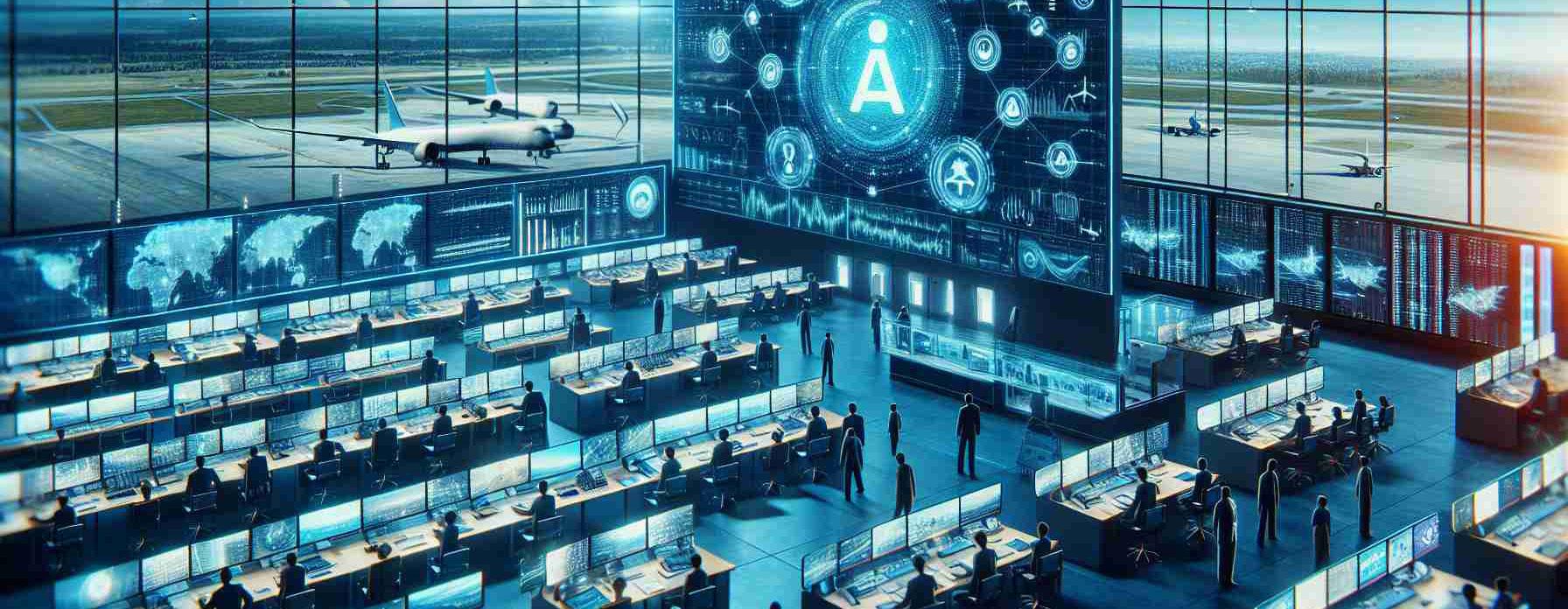
FlightCom: May 2024 19
NEWS
The 1 MW hydrogen engine installed on a Dash 8.
PART 1
WHEN THINGS FALL APART
It was going to be another typical semi-desert, Karoo October day with furnace heat shimmering off the dry plains.
ACCORDING TO THE forecasts, the wind gusts were to exceed 40 kilometres per hour and temperatures would rise to 48c by 11.00. This combination would become unworkable by 10:00 and so the pressure was on.
Weeks before, the plan seemed simple enough, whilst chattering around a table in an air-conditioned room with mugs of tea.
Management, or human intervention, of wildlife has become a critical component within the sparse islands of wild areas that remain. The interchanging of genetics by relocating animals to and from various game parks is a common example of a management tool, mimicking historical Alpha bull movements.
Our window of working time was critical, as it somehow always is, due mostly to climatic limitations, which in turn escalate other factors, each increasing risk.
The Bat-Hawk communicates the rhino’s location
There are many logistical issues that must be in place prior to a capture operation. The permits to move animals, dated to coincide with the availability of vets to capture and monitor the transport, special crates, and a flatbed truck with a crane for loading and offloading, staff and security vehicles, a ground team to help with the capture, trackers to help find the rhino in the first place, and lastly, a helicopter.
And so, on this occasion, a decision was made to capture two specific black rhino bulls for relocation into another existing population, to promote genetic diversity.
Daytime weather, wind and high temperatures put time pressures onto such operations, limiting the hours available to safely do the job, indirectly increasing challenges, which are many. Office planning and pre-dated permits seldom coincide with ideal weather conditions.
The objective of this operation was to find a specific animal, based on historical data, knowing the DNA and family history of the animal wanted. A very wild
20 FlightCom: May 2024 HELICOPTERS
JOHN BASSI
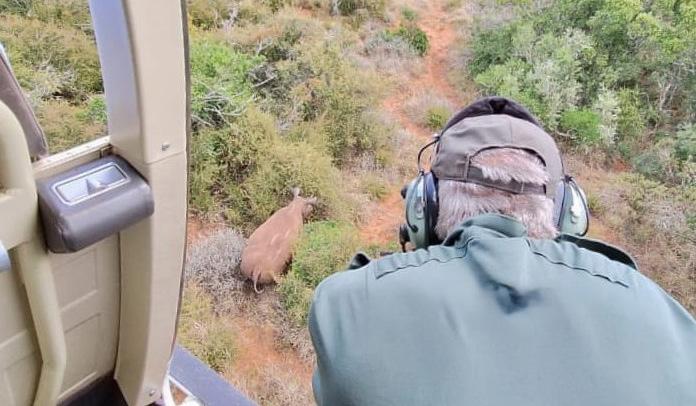
animal, that has had a couple of millions of years on earth to perfect his acute censes, and is lurking somewhere in a vast area, of over 100,000 hectares, which has extremely limited road access.
Trackers go out before sunrise to search for spoor. They may find tracks, but there’s no way of knowing if they were left behind by that specific rhino. This is where the spotter plane should come into the mix, saving time and expense, to search the area without spooking the rhino, confirming its correct identity, or not.
The silenced Rotax engine installed in most Light Sport Aircraft creates little or no disturbance and is ideal for monitoring, whereas, the blade slapping, turbine and tail rotor noise from a helicopter creates fear in the reclusive rhino and they soon run for cover.
In the perfect world, once the correct animal is identified, the spotter plane, which in this case was a Bathawk, uses its advantage of being able to climb above the terrain, gaining height, in order to communicate with VHF, the rhino’s location to the ground recovery team. The updated information is also communicated to the helicopter to get ready to go, with the vet.
Being in mountainous terrain, communication was poor and limited to VHF line of sight within five kilometres, requiring a fair amount of flying back and forth attempting to raise clear communications.
the LSA pilot confirms the identity of the animal
At the pre-work briefing the previous night, radios were handed out, the common frequency was decided, LSA take-off time noted and deployment of the trackers confirmed along with the locations of the recovery teams and trucks. We were all set as per operations normal.
The pilots flying the LSA often remark on how calm the rhino are as they circle at two to three hundred feet. Long before the inbound helicopter is visible, the rhino become agitated and start to hastily move away, often running non-stop for many kilometres.
Since the precise location of the rhino was not known, most of the planning and positioning of trucks and staff was based on an educated guess. Regardless of the best planning, it could take up to an hour for the recovery truck to get to wherever the rhino eventually
FlightCom: May 2024 21 Positioning the vet for a clean dart shot.
Time and temperature are limited when a rhino has been darted.
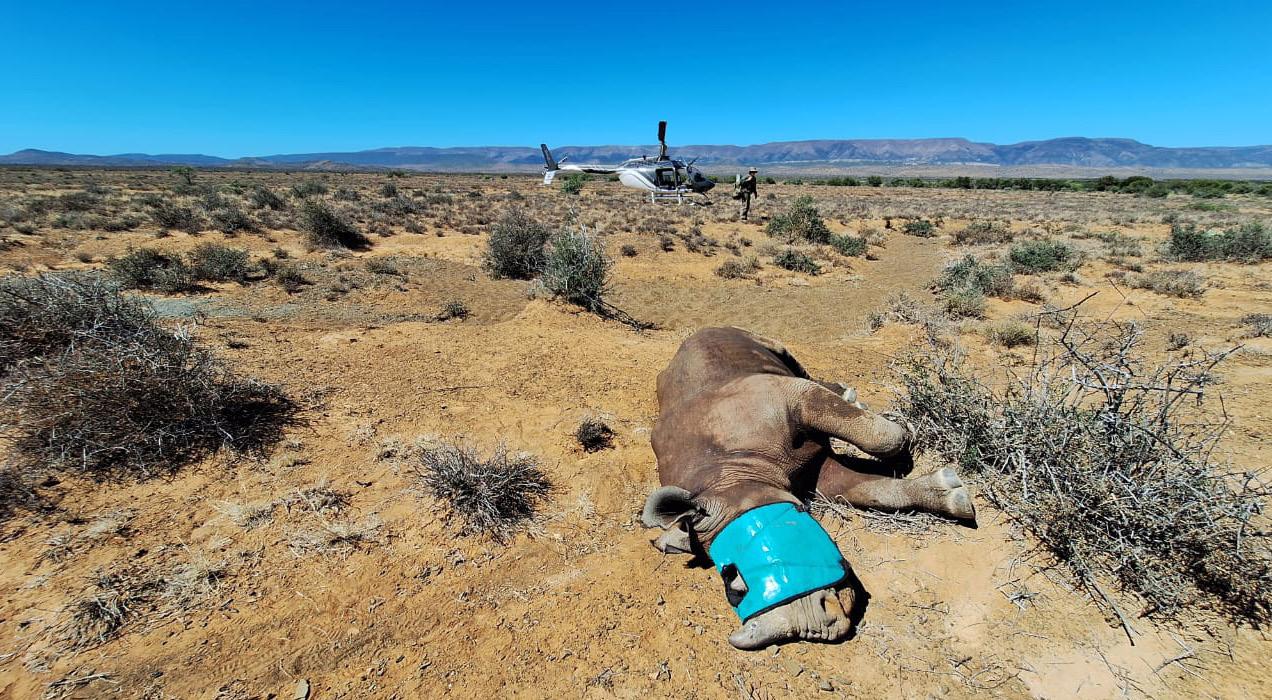
popped out. It would also take up to 45 minutes for the helicopter to lift, get to the location of the rhino and then coax the animal as gently as possible a few kilometres from its hiding place to a safe location where the recovery would be possible.
Our Standard procedure is: before first light the trackers are deployed and already in hot spot areas. The trucks and team are in strategic positions. The LSA is airborne and sweeping river-lines assisting with covering a large area and ready to immediately move to the trackers should they find fresh tracks, or a rhino. The helicopter team and veterinarian are standing by and ready at the push of the start button.
As soon as a rhino is located, the LSA pilot confirms the identity of the animal and record a GPS co-ordinate. He then climbs away and flies until radio contact is established with the mobile recovery team in the LandCruiser and the trucks, whose drivers would be given the best route to get as close as possible to an ideal recovery point.
The pilot will then fly towards the helicopter team, giving an update and an estimate of the time it will take for the trucks to get into position. He will then fly back to the trackers to monitor the rhino’s movements from high up, and co-ordinate the operation from above.
I would only lift off when I knew that the recovery team were in position and the rhino was visual.
All of this had to happen before the ground temperature became dangerously hot, preferably not above 26C, taking into consideration that the helicopter would need to push the rhino towards a safe darting and recovery location, hopefully not more than three to four hundred metres. The rhino would be running hard all this time in the baking sun. It would be further stressed by a very intimidating machine and once immobilized, unable to regulate his core body temperature. The need for fast and efficient work to minimize all this stress, overheating and risk of death cannot be overstated.
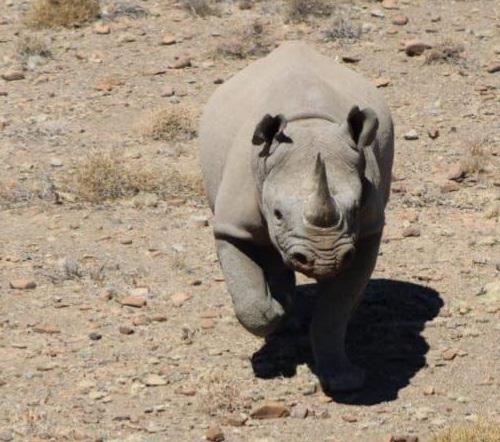
The black rhino is known for its aggression.
22 FlightCom: May 2024
HELICOPTERS

On top of all this stress for the rhino, he would then be confined inside a steel container getting bounced about on the back of a truck for at least seven hours, in the heat of the day.
Obviously, with a well-oiled and experienced team, all in radio contact, with the Bat-hawk eye in the sky, what could go wrong?
Unbeknown to us, chaos awaited. Our first challenge was that unfortunately the LSA pilot was not going be able to help search and fly due to the possibility of gusting wind. The pilot’s whereabouts were then unknown and there was no further communication, I therefore assumed we were on our own.
The next potential problem was that the two teams of trackers who had departed along with three ground vehicles with rangers to various locations as back up, had not left at first light. This would result in a later start, moving into the heat zone.
Then we discovered that the trackers did not have radios and no cell phone signal, and therefore, no communication, with anyone. The recovery trucks
were in the wrong place and they too could not be contacted by radio and to top it all, we could not make any radio contact with the three ranger teams in the back up vehicles.
We, the oblivious helicopter crew, waited on the ground for news or an update from anyone out there as to any sign of the rhino. The sun was rising higher, the tops of the trees were rustling with occasional breaths from a warm wind and there was silence in the air.
By taking off too soon in the helicopter, there was the risk that we would spook the rhino deeper into more remote areas. But with no communication and no clue about what was happening, and the temperature increasing, a decision was made to takeoff, fly high and establish communications with the tracking teams, the recovery team and the trucks, gaining an updated overview of the actual situation. From there we would decide on our next course of action, to land on top of a mountain with VHF coms, or to assist with searching.
Little did we know, until later, that none of that would be possible due to a total breakdown of communication.
FlightCom: May 2024 23
The Bat hawk is an invaluable spotter - when used correctly.
CAA’S 25TH ANNIVERSARY SHOW
The Silver anniversary of the CAA was hosted at Wonderboom Airport on a hot autumn Saturday in mid-April. The show was by invitation only yet had about 3000 spectators and underprivileged children through the gates.
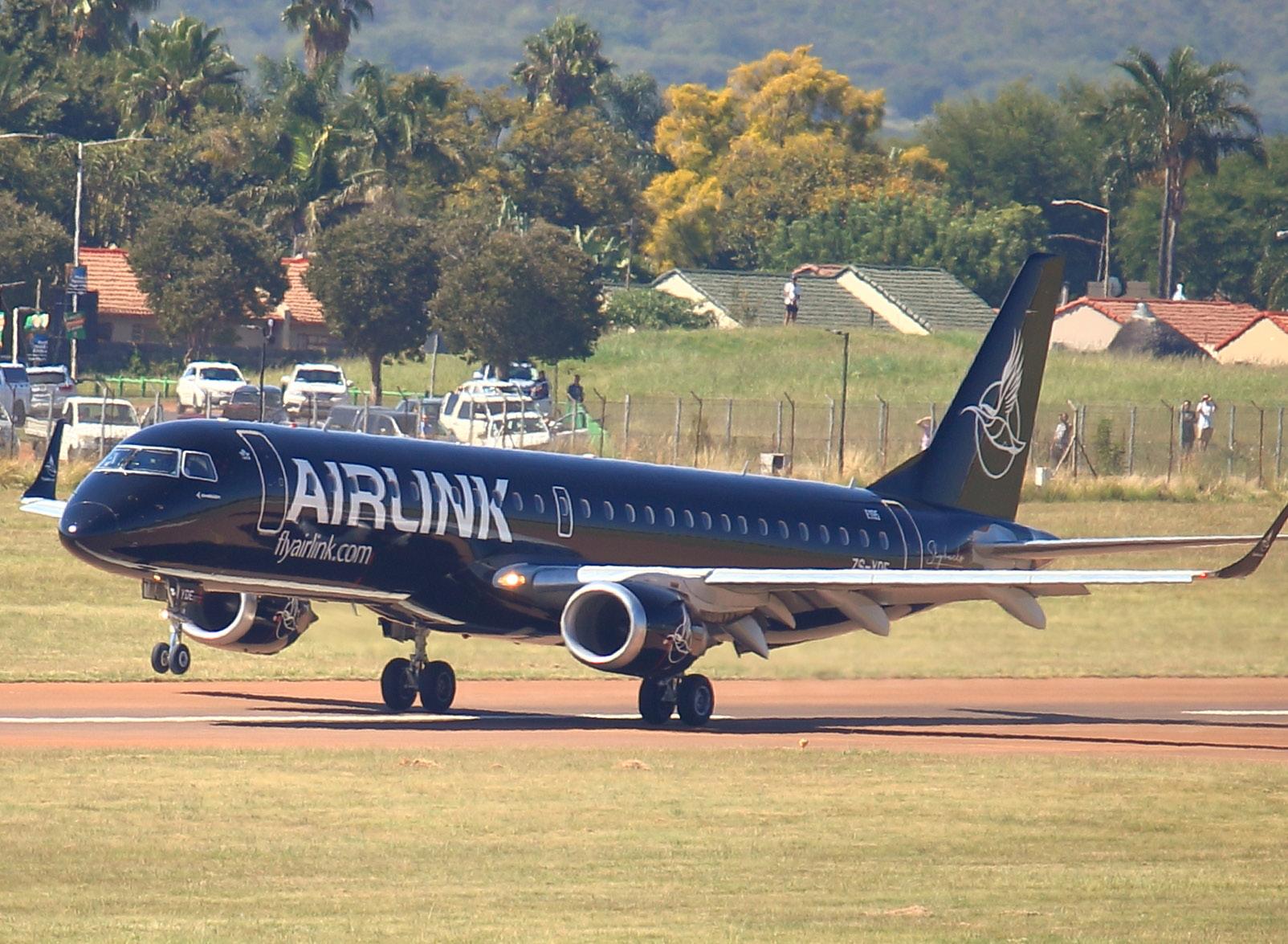
24 FlightCom: May 2024 AIRSHOWS CAA’S 25TH ANNIVERSARY
Text and Pictures Trevor Cohen
Star of the show was the Airlink Embraer E195 in Skybucks livery.
The crowd enjoyed the food stalls.
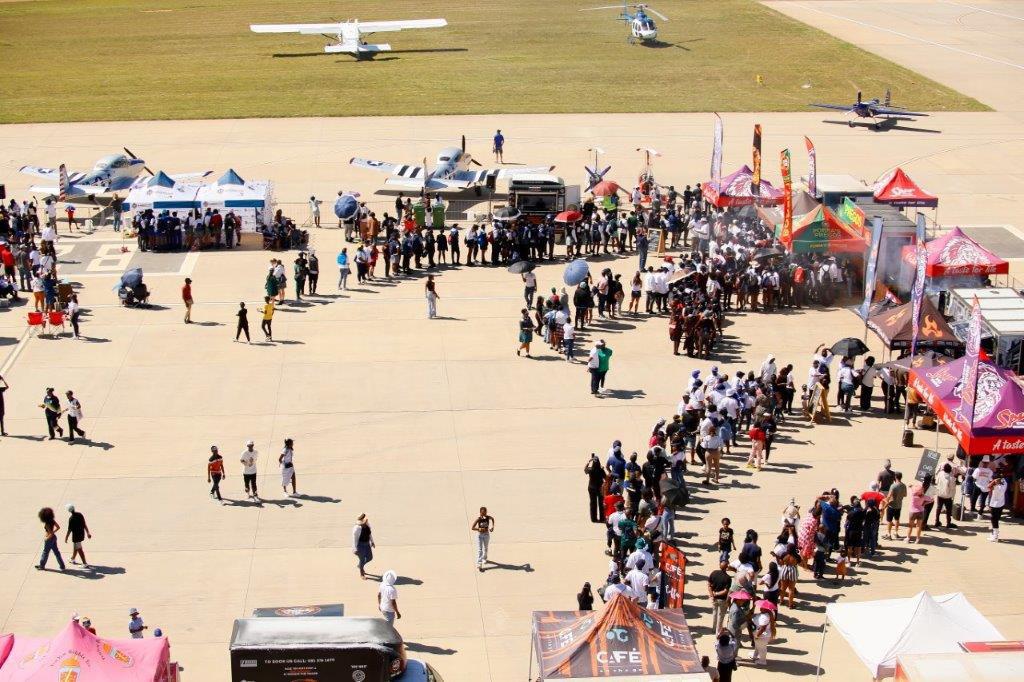
THE CAA’S STATED AIM is to bring aviation closer to those from disadvantaged backgrounds who can only see aviation from a distance.
Spectators were able to get close to aircraft and see them start and then takeoff and preform.
There were representatives from the CAA, ATNS, ACSA and other government organizations in the tent stalls. A number of commercial operators were also in attendance.
The show started with the very impressive landing of the black liveried Airlink Embraer 195.

'Roofkykers' - the 'currently advantaged' spectators who were not invited.
FlightCom: May 2024 25

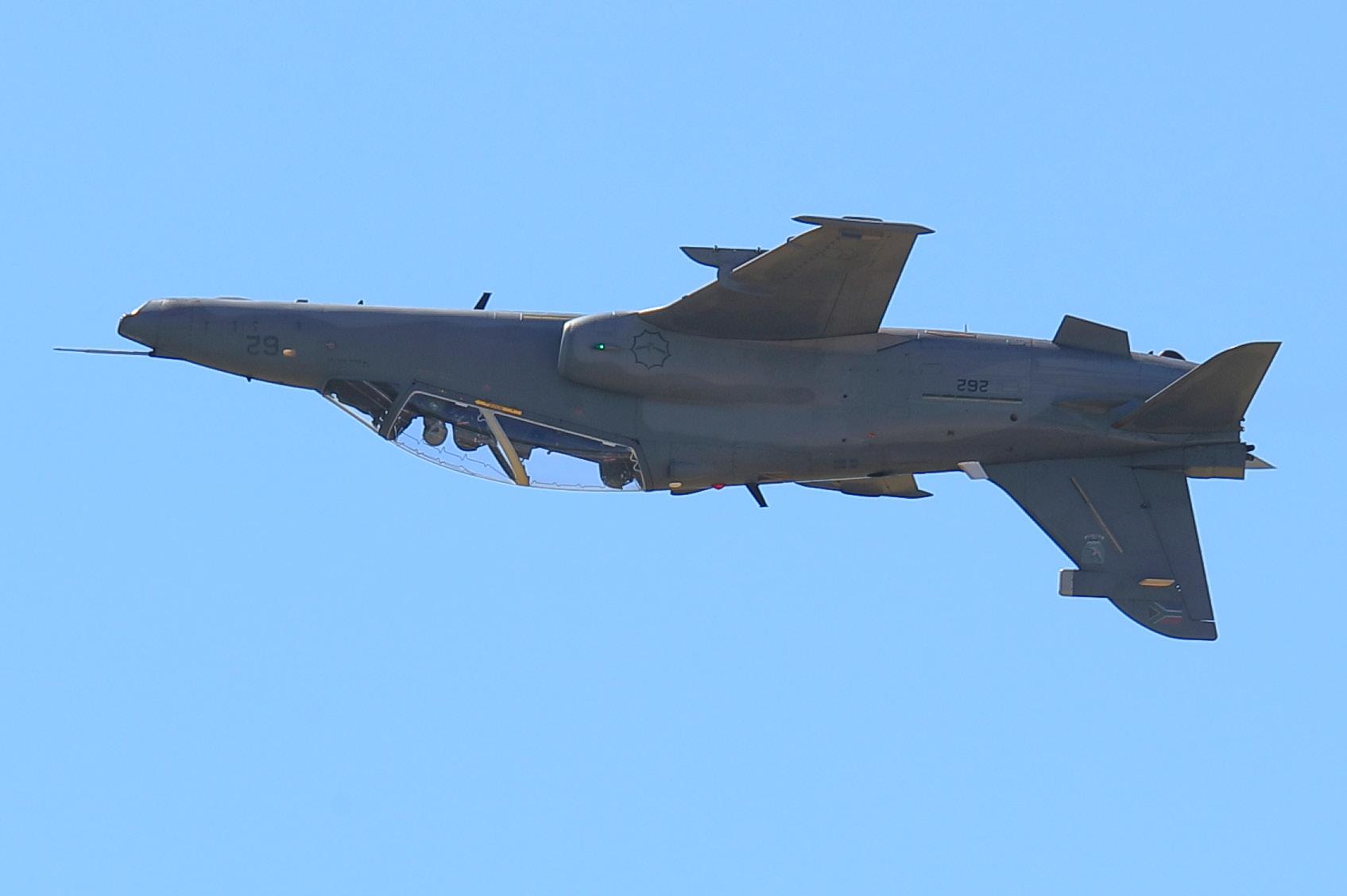
26 FlightCom: May 2024
AIRSHOWS
ABOVE: Scully Levin puts the Cirrus SR22 through its paces.
BELOW: Fast jet action in the Hawk Mk120 flown from Makhado AFB by Lt Col Scott Logie.

ABOVE: The always available Puma Flying Lions put on a great display.
BELOW: Classic action from the SAAF Museum Tiger Moth.
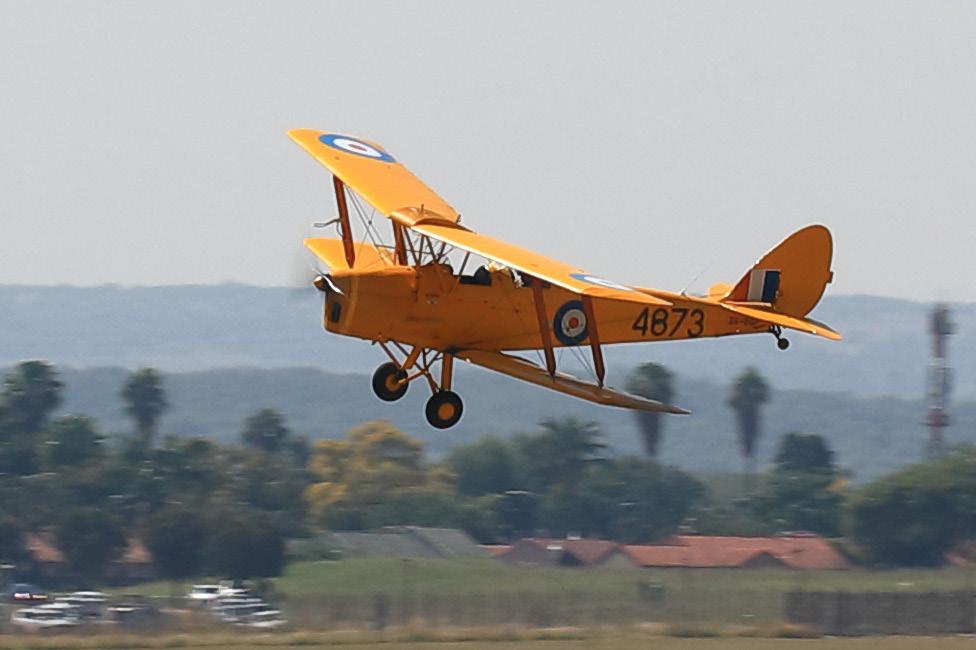
FlightCom: May 2024 27
AIRSHOWS

ABOVE: Juba Joubert in action in the Gazelle.
BELOW: Something new - the two Navion display.

28 FlightCom: May 2024
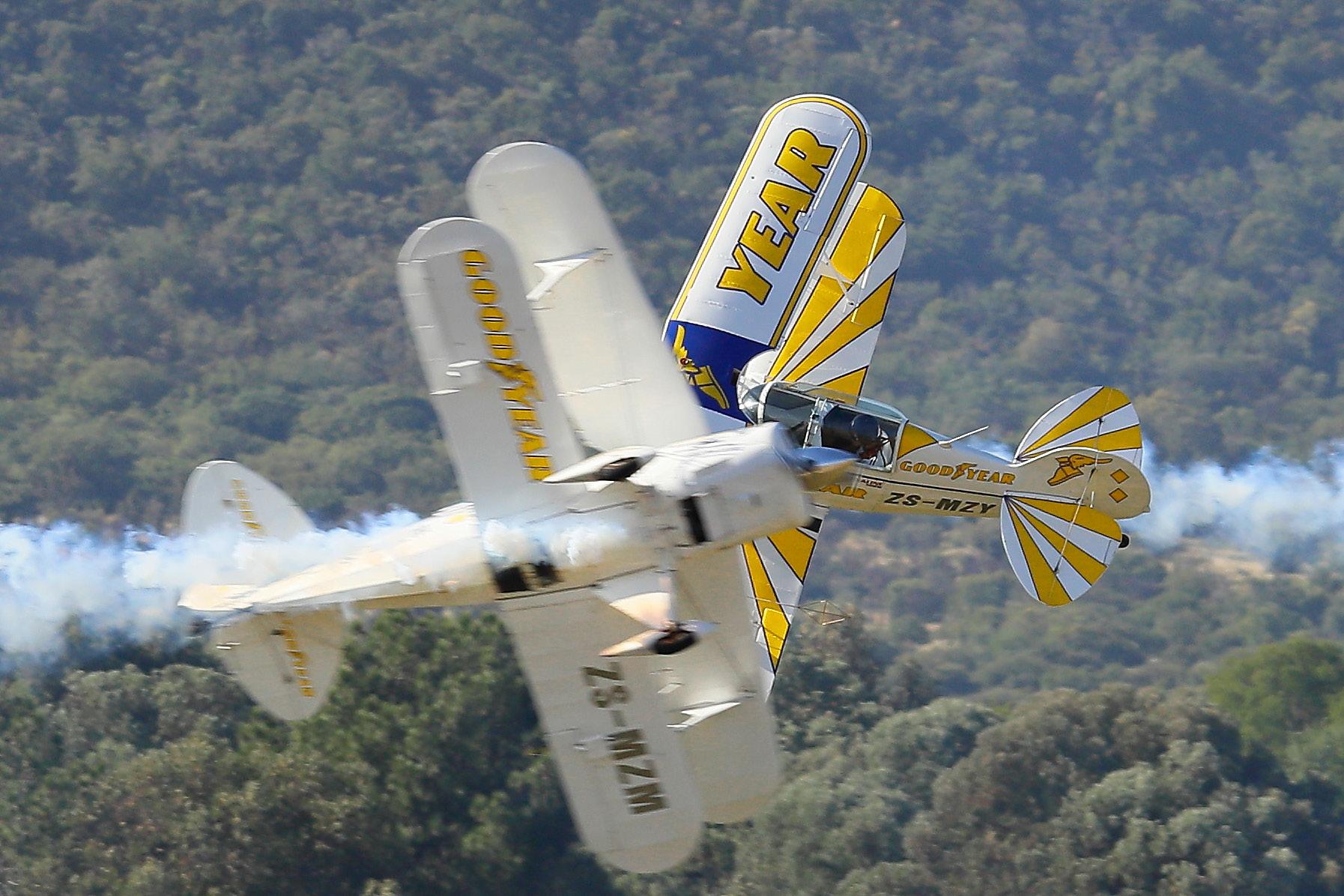
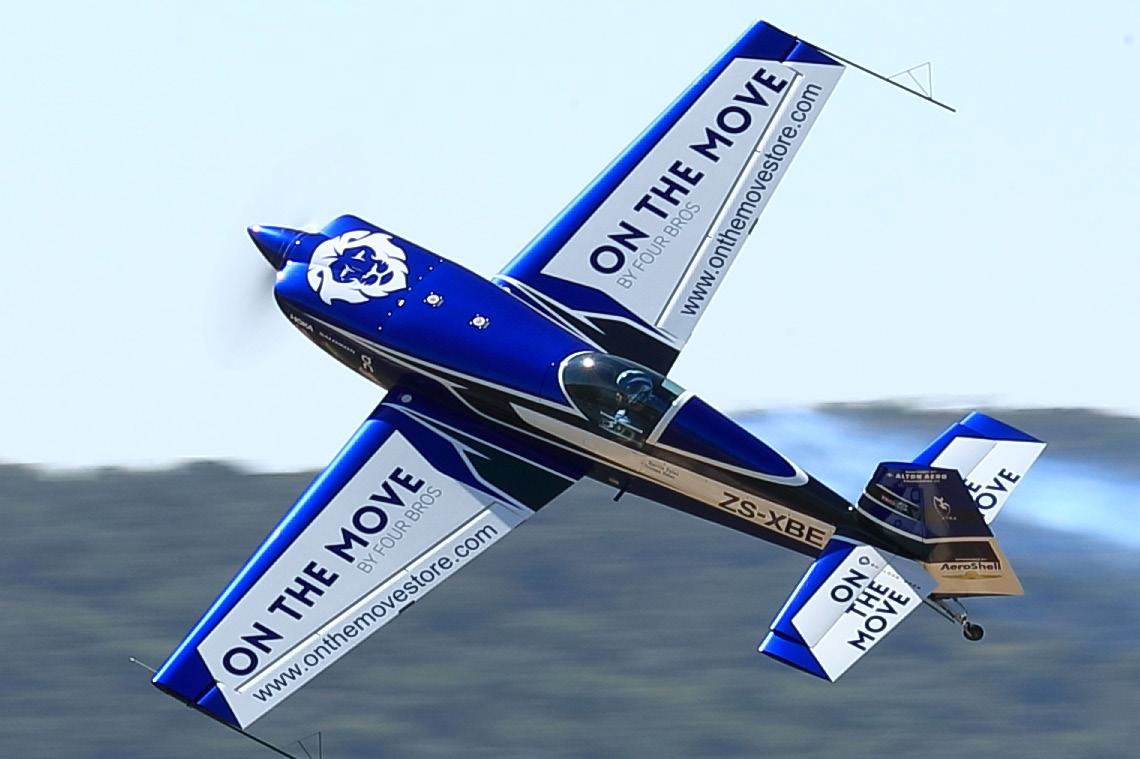
FlightCom: May 2024 29
ABOVE: The show was closed by the Goodyear Eagles Pitts Specials. BELOW: Young Tristan Eales in his Extra 330.
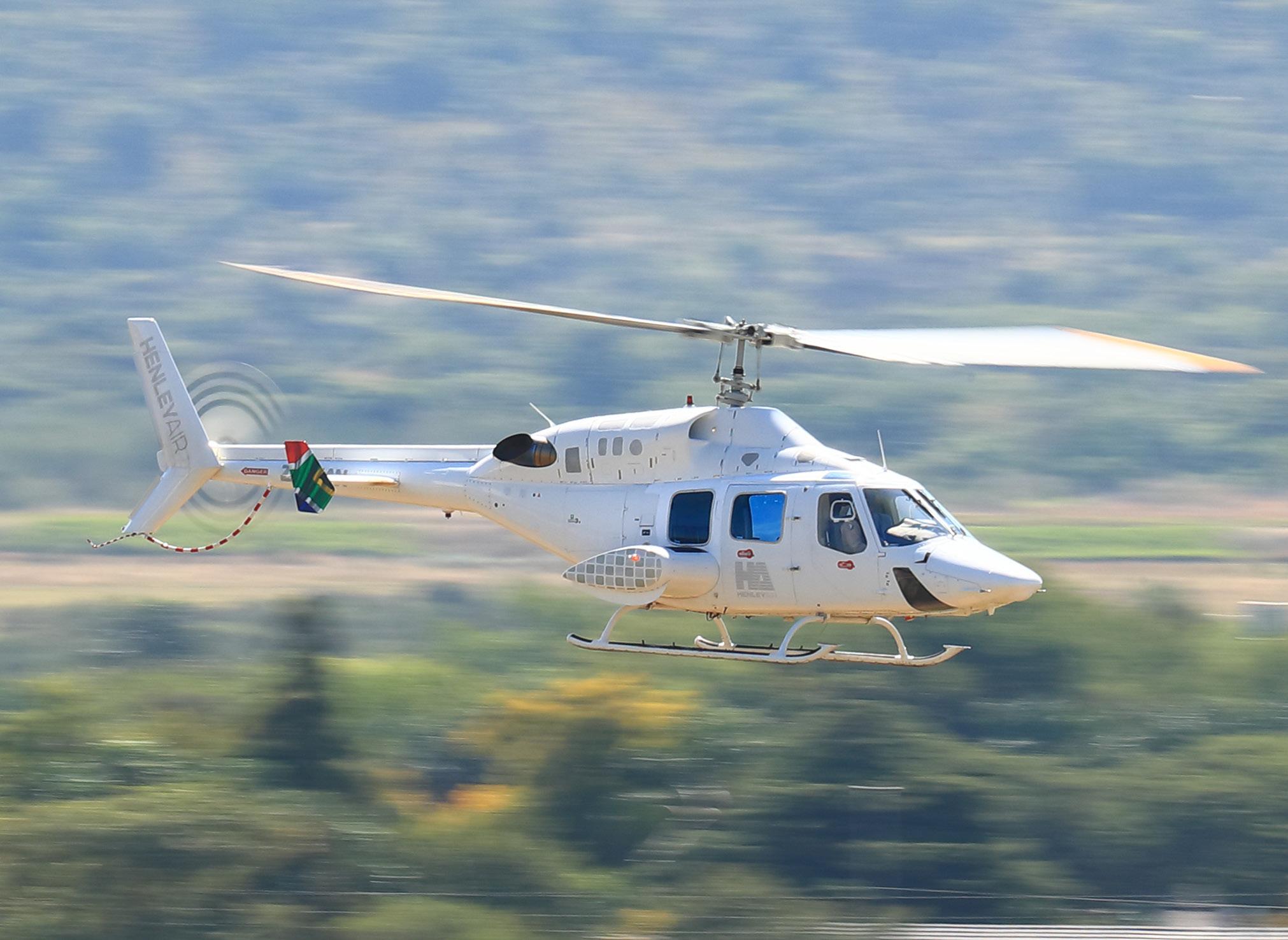
Then welcome speeches were made by the young and photogenic Mayor of Tshwane, Cilliers Brink. A rambling keynote speech was delivered by the Minister of Transport, Sindisiwe Chikunga.
The 25th birthday cake was cut and then the aerobatic displays began with the Puma Flying Lions doing a two and then three ship display, flown by Arnie Meneghelli, Sean Thackwray and led by Ellis Levin
an aerial ballet with two helicopters AIRSHOWS
Following his remarkable performance at Stellenbosch, Juba Joubert amazed again flying an Alouette III and Gazelle.
Andrew Blackwood Murray flew his polished display in his well-travelled Nashua Extra 300 and Tristan Eales flew his first airshow in the Extra 330C. Grant
Helicopter action came from the SAAF Museum’s Alouette II and III which performed an aerial ballet with the two helicopters flying nose to nose around each other.
From Henley Air at Rand, Andre Coetzee brought his Rocket emergency services Bell 222.
The Raptors RV Team of Trevor Warner and Dion Raath put on a 2-ship display team and Scully Levin very effectively demonstrated the Cirrus 22.
Lt Colonel Scott Logie, call sign Prowler, demonstrated the BAE Hawk Mk120 which was operated out of Makhado Air Force base in the far north.
30 FlightCom: May 2024
Timms flew an elegant Tiger Moth demonstration.
The Bell 230 from Rocket EMS at Rand.

The SA Police thrilled the crowd with their anti-hijacking demo.
A two ship Savanah demo was flown by Jason Beamish and Richard Nicholson.
Pitts Special action came from Arnie Meneghelli, Sean Thackwray and Ellis Levin in the Pitts Special Hired Gun display
Captain Jaco Henning and Dean Nicholas took the Airlink E195 Embraer (in Skybucks livery nicknamed Black Betty) through her paces around Northern Tshwane.
Andre Van Zyl flew his Magni Gyro and impressed all by showing just how capable the tiny aircraft is.
Lt Colonel Scott Logie, call sign Prowler
Rodney Chinn and Grant Timms flew a beautiful formation display in de Havilland Chipmunks. Next up was a display of two North American Navion’s flown by Reyno Coetzer and Steve and Mike George.
Commentary was provided by the evergreen Brian Emmenis and his Capital Sounds team who kept the spectators informed and entertained. A big hit with the crowd was the SA Police antihijacking recovery demonstration using an Airbus Squirrel H125 and a Pilatus PC-6 Porter. The flying display closed with the Goodyear Pitts display.
This aviation event was an outreach, and so if just one person who attend the show takes up aviation as a career, then the show will have achieved its goal.
FlightCom: May 2024 31


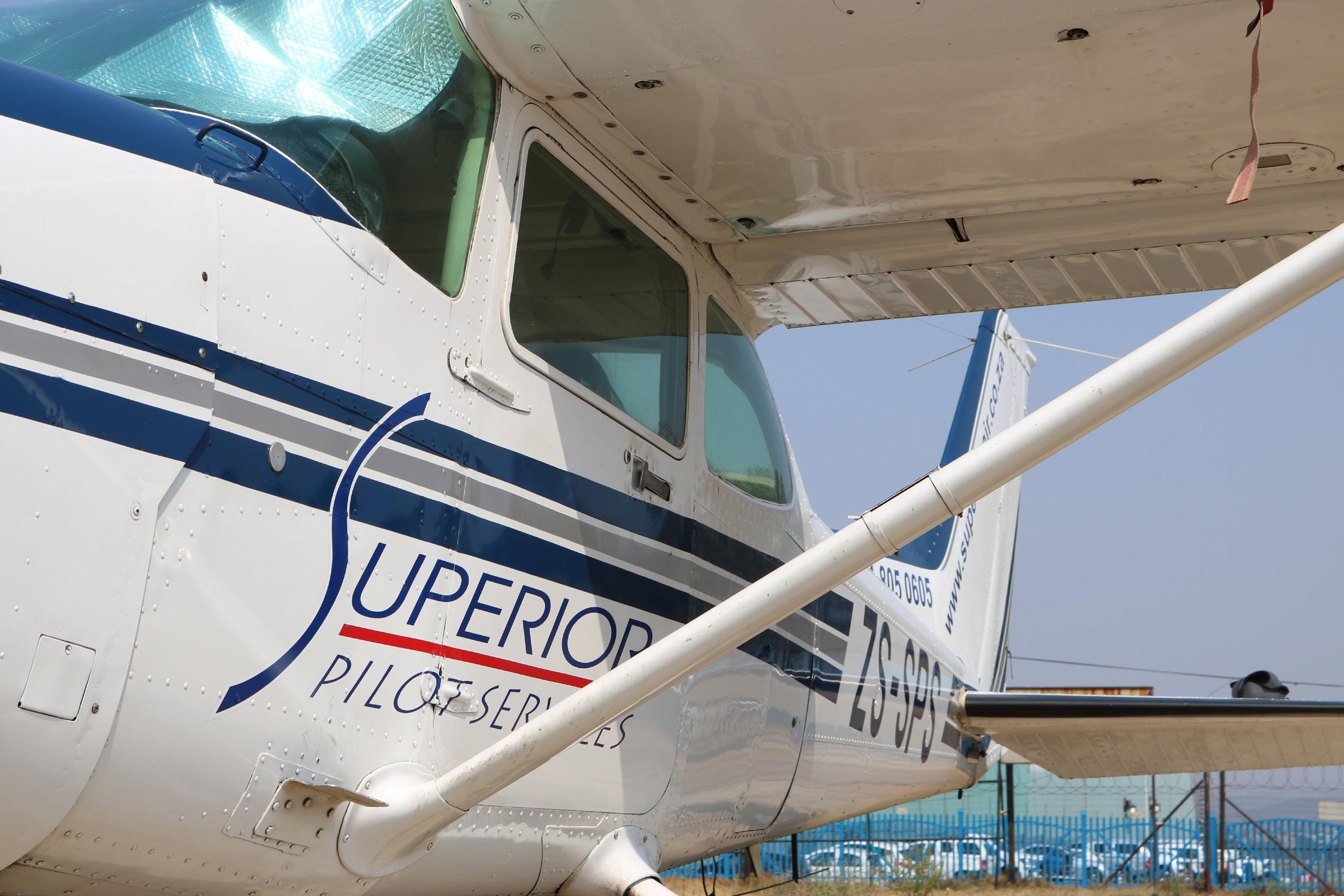


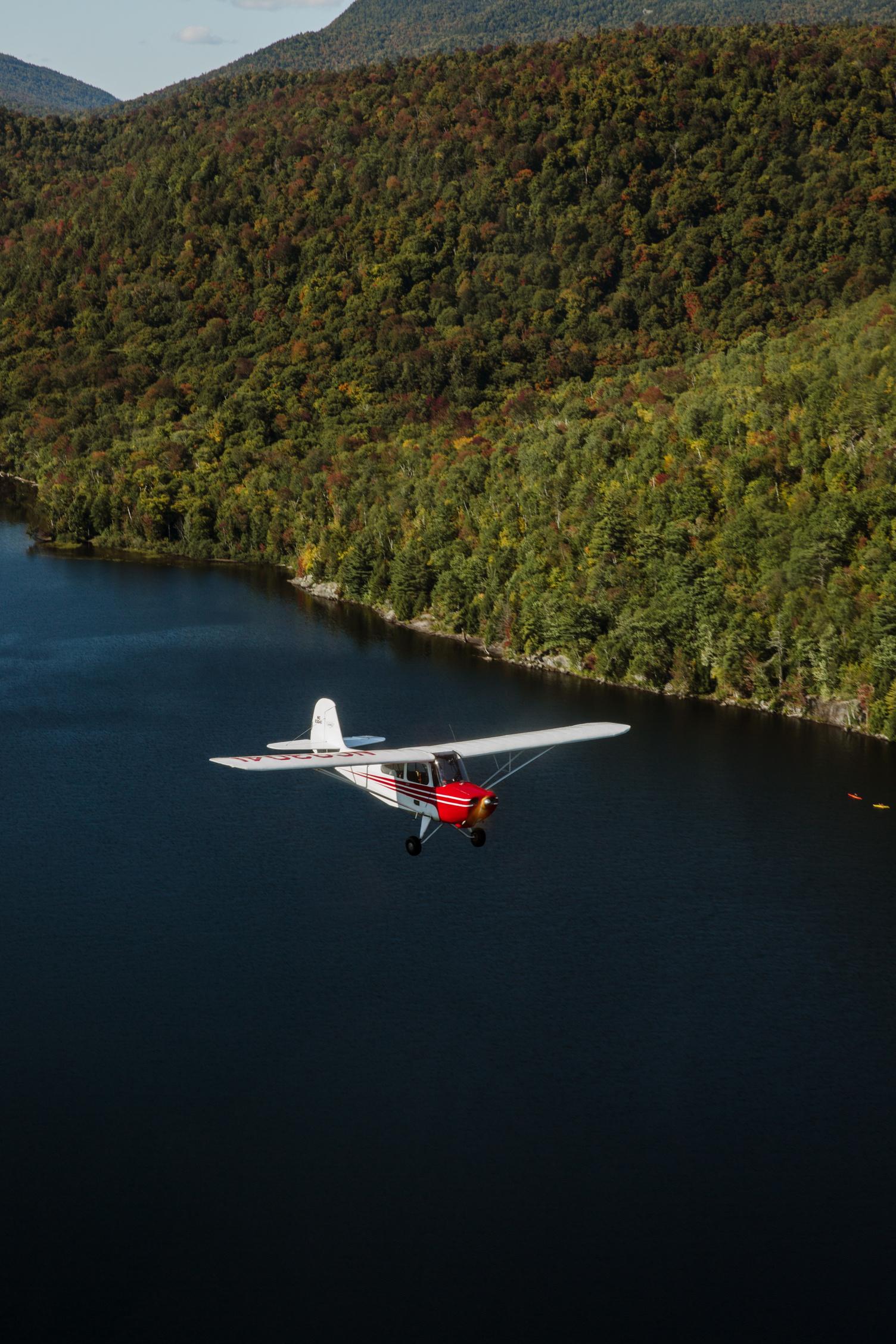
32 FlightCom: May 2024 Tel: +27(0)11 805 0605 • www.superiorair.co.za • info@superiorair.co.za TurbineGS Training Ab-Initio Training Single Engined Multi Engine Night Rating IF Rating Instructors Rating Simulator Training Conversions CPL Theory CPL Practical Helicopter Training Tail Draggers Pilot Shop Conferences Hire and Fly Charters Aerobatic Training Beginners/Advanced Gyro-Copter Training Microlights & Ferry Flights Accommodadtion Aircraft/Heli Sales Club Facilities Drones NAME OF SCHOOL CODE TEL NO FAX NO BEAUFORT WEST AIFA (044) 272 5547 info@aifa.co.za j j j j j j j j j j j BRAKPAN BENONI FABB Titanium Air (011) 914-5810 083-292-0978 j j j j DURBAN Starlite Aviation Training Academy (031) 571-6600 www.starliteaviation.com j j j j j j j j j j j j j j j j j j j j j j j EAST LONDON Border Aviation Club (043) 736-6181 086-516-8475 j j j j j j j j j j j j j j j GEORGE AIRPORT AIFA (044) 272 5547 info@aifa.co.za j j j j j j j j j j j Savannah Helicopter Training (044) 876-0096 j j j j j j j j j j j GRAND CENTRAL Superior Pilot Services (011) 805-0605 Info@superiorair.co.za j j j j j j j j j j j j j j j j j KRUGERSDORP Alpi Flight Academy (082) 556-3592 086-605-8948 j j j j j j j j j j j j j j j j j LANSERIA AIRPORT / RANDBURG Aeronav Academy (011) 701-3862 701-3873 j j j j j j j j j j j j j j CSA Aviation (011) 701-3835 www.cirrussa.co.za j j j j j j j j j j j j j j Skyhawk Aviation (011) 701-2622 701-2623 j j j j j j j j j j j j j j j j MOSSEL BAY Starlite Aviation Training Academy (044) 692-0006 www.starliteaviation.com j j j j j j j j j j j j j j j j j j j j j j j PANORAMA Johannesburg Flying Academy (064) 756 6356 j j j j j j j j j j j j j PORT ELIZABETH Algoa Flying Club (041) 581-3274 086-461-7067 j j j j j j j j j j j j j j j RAND AIRPORT Johannesburg School of Flying (011) 827 9827 info@jsf.co.za j j j j j j j j j j j j j j j U Fly Training Academy (011) 824-0680 390-1738 j j j j j j j j j j j j j j j VEREENIGING AIRPORT Bird Aviation (016) 556-1007 info@birdaviation.co.za j j j j j j j j j j j j j j j j j WINDHOEK - EROS AIRPORT Desert Air (PTY) LTD +264 61 228101 +264 61 254 345 j j j j j j j j j j j WONDERBOOM AIRPORT / AEROPARK / RHINO PARK - PRETORIA Blue Chip Flight School (012) 543-3050 543-1826 j j j j j j j j j j j j j j j j j j j Loutzavia (012) 567-6775 543-1519 j j j j j j j j j j j j j j j j j j j Legend Sky (083) 860-5225 086-600-7285 j j j j j j j j j j j j j j j j j Powered Flight Training (078) 460-1231 086-666-2077 j j j j j j j j j j j j j j j j j Vortx Aviation Training (072) 480-0359 086-524-0949 j j j j j j j j j j j j j




CHARTER DIRECTORY < 20 pax > 20 pax Biz-Jets V.I.P Long-Range Freight Helicopter Special Events Safari Charters Contracts Aircraft Sales Surveys Maintenance Aerial Photography Aircraft Leasing Security Based (armed) Line Inspections Lodge Transfers Export Docs & Clearing Hangarage Dangerous Goods NAME OF CHARTER CODE TEL NO FAX NO BRAKPAN FABB Titanium Air (011) 914 5810 083 292 0978 j j j j j CAPE TOWN ExecuJet South Africa (021) 934 5764 934 2087 j j j j j j j j j j j j j j j j Streamline Air Charter (011) 395 1195/8 j j j j j j j j DURBAN KZN Aviation (031) 564 6215 564 6222 j j j j j j j j j j j GRAND CENTRAL Pambele Aviation (011) 805-0652/82 805-0649 Dreams Treasury | Working Capital | Asset Management | Wealth
AMO LISTING
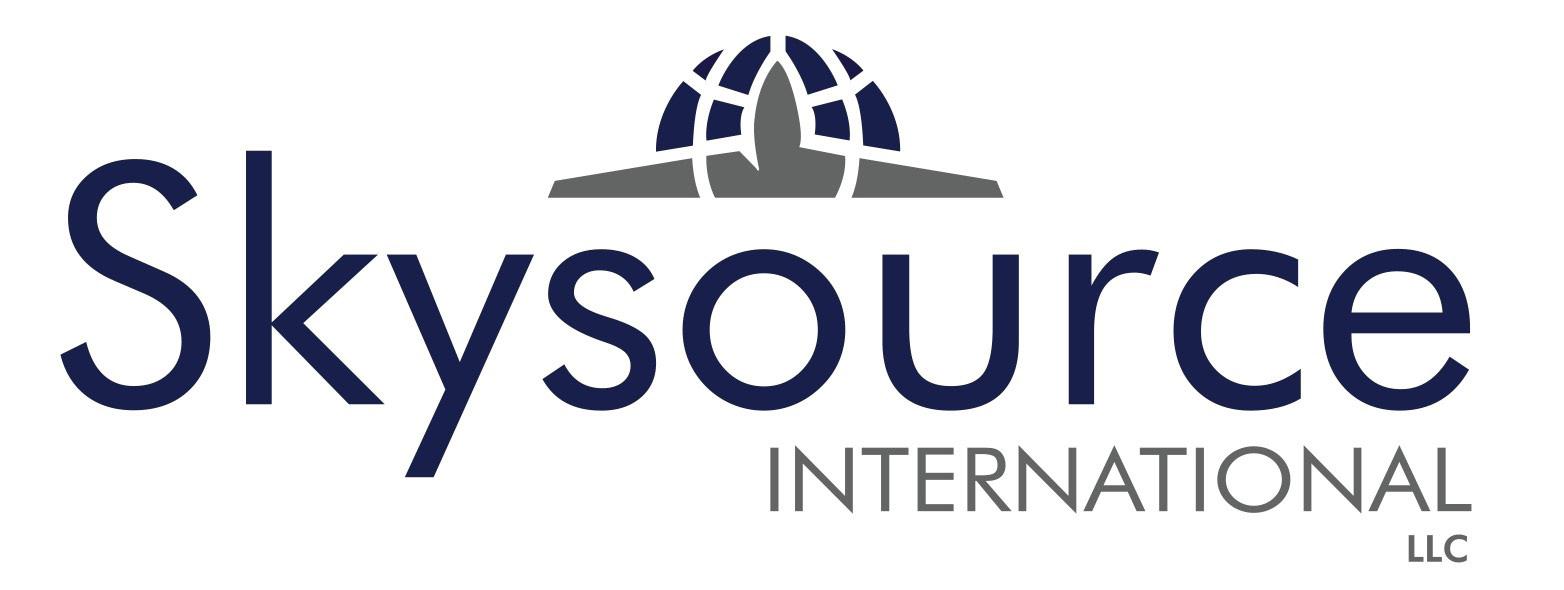
South Africa
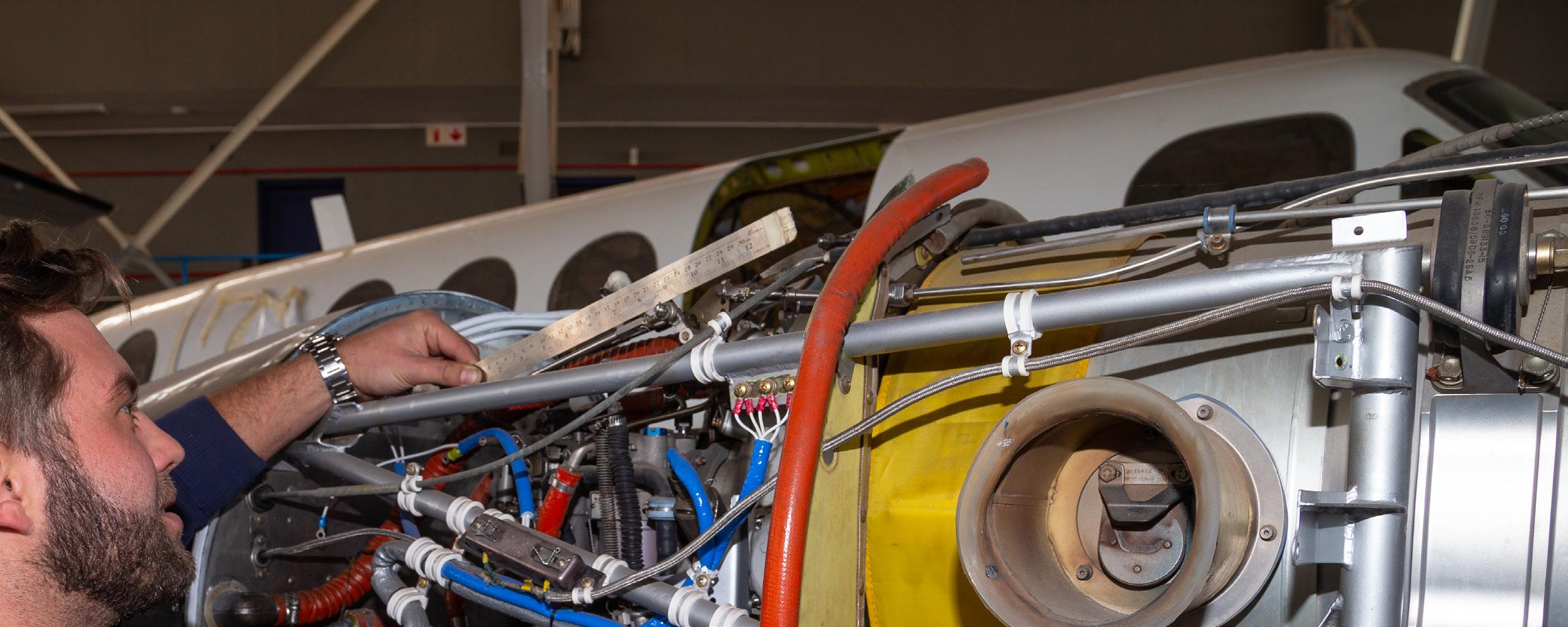
Fixed Wing Helicopter Avionics Piston Engines Turbine Engines Propellers Weight / Balance Paint Interior Sheet Metal Rebuilds Overhauls Electrics NDT Testing Refurbishments Structural Repairs Inspections NTCA Aircraft Seat Belts Instruments NAME OF AMO CODE TEL NO FAX NO CAPE TOWN Erwin Electrical Solutions t/a AES (021) 934 5373 j j j j j j j j j ExecuJet South Africa (021) 934 5764 934 2087 j j j j j j j j j j j j j j j Ultimax Aviation (Pty) Ltd (072) 878 8786 j j j j j j j j j j j j j DURBAN BAC Aviation (035) 797 3610 797 5341 j j j j j j j j j j GRAND CENTRAL AIRPORT Astwood Aircraft Electrical (011) 315 9605 315 0094 j Superior Rotorworx (076) 595 2120 j j j j j j j j j j j j j j j j j
Skyworx Aviation (082) 346 0150 086 697 9096 j j j j j j j j j j j LANSERIA AIRPORT Erwin Electrical Solutions t/a AES (021) 934 5373 j j j j j j j j ExecuJet South Africa (011) 516 2300 011 659 1071 j j j j j j j j j j j j j j j Gem Air (082) 905 5760 011 701 2653 j j j j j j Guardian Air Maintenance (011) 701 3011 j j j j Lanseria Aircraft Interiors (011) 659 1962 j j j j j j Plane Maintenance Facility (011) 659 2204 pmf@myconnection.co.za j j j j j j j j j j j j j SkySource International SA (011) 900 4300 j j j j j j j j j j j j j j The Propeller Shop (011) 701 3114 086 543 7988 j Tynay Aviation (082) 088 6663 011 659 1157/8 j j j j j j j j CAPE WINELANDS AIRPORT Diepkloof Aircraft Maintenance (083) 454 6366 j j j j j j j j j j j j NELSPRUIT Aircraft Maintenance International (013) 741 8221 082 787 0415 j j j j j j j j j j j j j Leading Edge Helicopters cc (013) 741 5582 741 8188 j j j j j j NEW TEMPE BLOEMFONTEIN Ferreira Aviation (051) 451 1682 451 1683 j j j j j j j j j j j OR TAMBO INTERNATIONAL AIRPORT Nevergreen Aircraft Industries (010) 003 3747 manager@nevergreen.co.za j j j Star Air Maintenance (011) 395 2201 973 4761 j j j j j j j j j RAND AIRPORT1 Aerospace Electroplating (011) 827 7535 827 9896 j j j j j j j j Aviation Rebuilders CC (011) 827 2491 lyn@aviationrebuilders.com j j j j j Clifton Electronics (011) 383 2024 086 689 5645 j j j Dynamic Propellers (082) 445 4496 086 548 2651 j j Skytrim (011) 827 6638 www.skytrim.co.za j j j j
KRUGERSDORP
AMO 1427 www.skysourcesa.com
PTY Skysource International SA, Hangar 203, Lanseria International Airport
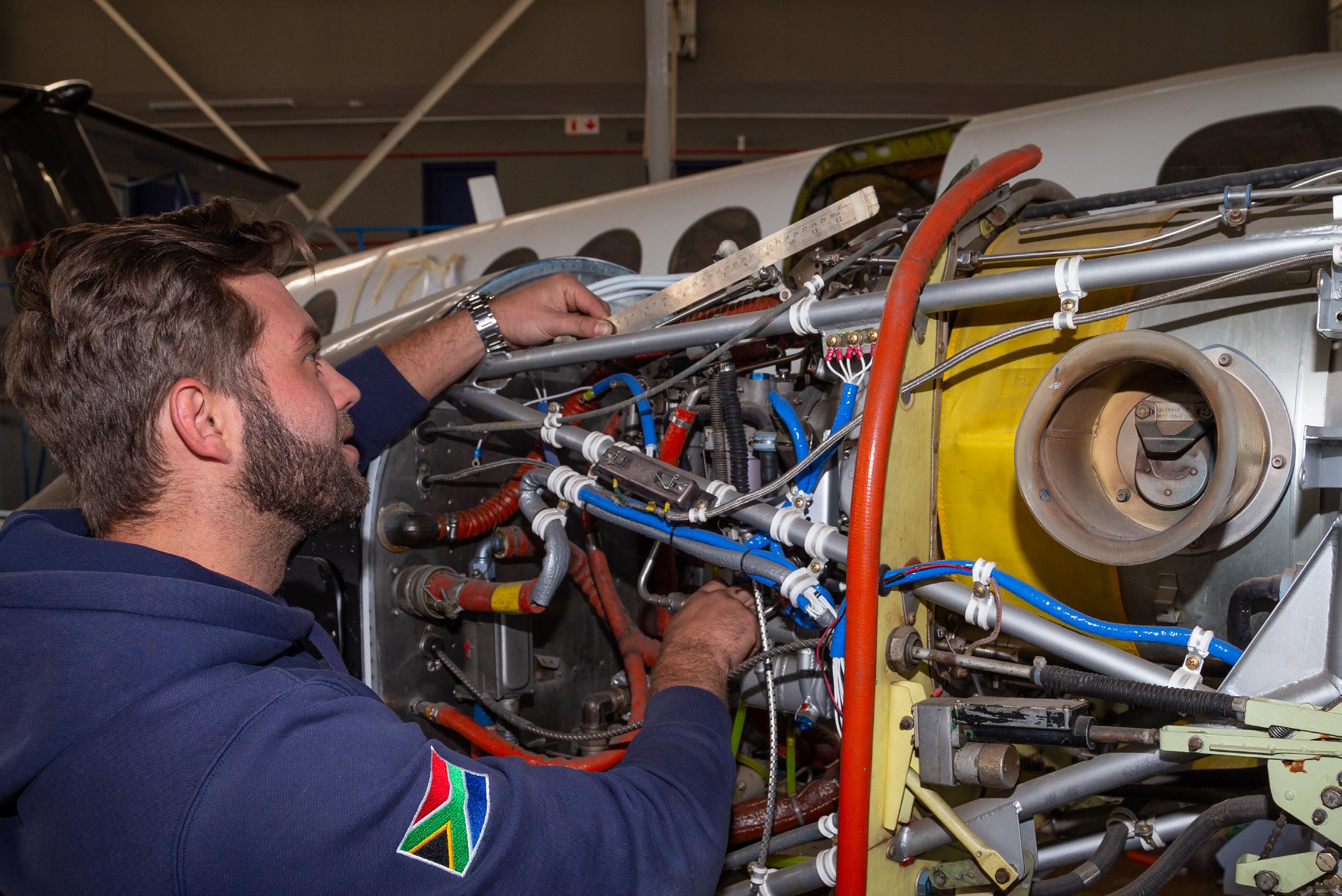
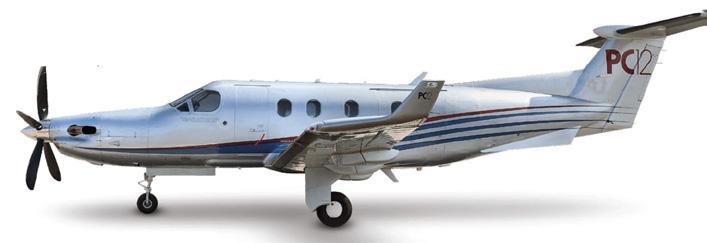
NAME OF AMO CODE TEL NO FAX NO Fixed Wing Helicopter Avionics Piston Engines Turbine Engines Propellers Weight / Balance Paint Interior Sheet Metal Rebuilds Overhauls Electrics NDT Testing Refurbishments Structural Repairs Inspections NTCA Aircraft Seat Belts Instruments Composite Manufacturing RAND AIRPORT
Emperor Aviation (082) 497 1701 j j j j j j j j j j j j j j j FLYONICS (Pty) Ltd (082) 686 2374 michael@flyonics.co.za j j j Heli-Afrique cc (011) 827 8632 086 503 1870 j j j j j j j j j j SPRINGS AIRFIELD Legair Maintenance (083) 736 3969 086 508 6010 j j j j j j j j j j j j j j j j j WONDERBOOM AIRPORT - PRETORIA 208 Aviation 083 744 3412 j j j j j j Aerocore (012) 110 4033 082 565 2330 j j j Aircraft Maintenance @ Work Pty Ltd (012) 567 3443 j j j j j j j Aerotric (087) 802 1347 aerotric@aol.com j j j j j Aero Engineering & Powerplant (012) 543 0948 543 9447 j j AviSys Aviation Systems (083) 442 5884 086 618 6996 j j j j j Avtech (082) 749 9256 j j j j j j j APCO Pty Ltd (012) 543 0775 567 3630 j j j Breytech Aviation cc (012) 567 3500 086 643 0122 j j j j j j j j j j j j j j Propeller Centre cc (012) 567 1689 j j NIGERIA - MURTALA MUHAMMED INTERNATIONAL AIRPORT ExecuJet Aviation Nigeria Ltd +2341 295 5110 j j j j j j j j j j j j JOHANNESBURG F Gomes Upholsters (011) 614 2471 614 9806 j j j j j PRETORIA M&N Acoustics Services Pty (Ltd) (012) 689 2007 086 211 469 j j j j j j j j j j j AMO LISTING AIRCRAFT MAINTAINENANCE AND REFURBISHMENT QUALITY IS OUR PASSION CALL US NOW FOR ALL OF YOUR AVIATION NEEDS! info@skysourcesa.com +27 10 900 4300 • +27 72 036 3433 WE SPECIALIZE IN: Pilatus PC-12 Beechcraft 90 Series Beechcraft 200 Series Beechcraft 350 Series Beechcraft 1900D Series Cessna Caravan C208 Series Aircraft info@skysourcesa.com +27 10 900 4300 • +27 72 036 3433
CONTINUED
BACKPAGE DIR ECT ORY
208 Aviation
Ben Esterhuizen +27 83 744 3412 ben@208aviation.co.za www.208aviation.com
A1A Flight Examiner (Loutzavia)
Jannie Loutzis 012 567 6775 / 082 416 4069 jannie@loutzavia.co.za www.loutzavia.co.za
AES (Cape Town)
Erwin Erasmus 082 494 3722 erwin@aeroelectrical.co.za www.aeroelectrical.co.za
AES (Johannesburg)
Danie van Wyk 011 701 3200 office@aeroelectrical.co.za www.aeroelectrical.co.za
Aerocolour cc
Alfred Maraun 082 775 9720 aeroeng@iafrica.com
Aero Engineering & PowerPlant
Andre Labuschagne 012 543 0948 aerocolour@telkomsa.net
Aerokits
Jean Crous 072 6716 240 aerokits99@gmail.com
Aeronav Academy Donald O’Connor 011 701 3862 info@aeronav.co.za www.aeronav.co.za
Aeronautical Aviation
Clinton Carroll 011 659 1033 / 083 459 6279 clinton@aeronautical.co.za www.aeronautical.co.za
Aerospace Electroplating
Oliver Trollope 011 827 7535 petasus@mweb.co.za
Aerotel Martin den Dunnen 087 6556 737 reservations@aerotel.co.za www.aerotel.co.za
Aerotric
Richard Small 083 488 4535 aerotric@aol.com
Aviation Rebuilders cc
Lyn Jones 011 827 2491 / 082 872 4117 lyn@aviationrebuilders.com www.aviationrebuilders.com
AVIC International Flight Academy (AIFA)
Theo Erasmus 082 776 8883 rassie@aifa.co.za
Air 2000 (Pty) Ltd
Anne Gaines-Burrill 011 659 2449 - AH 082 770 2480 Fax 086 460 5501 air2000@global.co.za www.hunterssupport.com
Aircraft Finance Corporation & Leasing
Jaco Pietersen +27 [0]82 672 2262 jaco@airfincorp.co.za
Jason Seymour +27 [0]82 326 0147 jason@airfincorp.co.za www.airfincorp.co.za
Aircraft General Spares
Eric or Hayley 084 587 6414 or 067 154 2147 eric@acgs.co.za or hayley@acgs.co.za www.acgs.co.za
Aircraft Maintenance International
Pine Pienaar 083 305 0605 gm@aminternational.co.za
Aircraft Maintenance International Wonderboom Thomas Nel 082 444 7996 admin@aminternational.co.za
Air Line Pilots’ Association
Sonia Ferreira 011 394 5310 alpagm@iafrica.com www.alpa.co.za
Airshift Aircraft Sales
Eugene du Plessis 082 800 3094 eugene@airshift.co.za www.airshift.co.za
Alclad Sheetmetal Services
Ed Knibbs 083 251 4601 ed@alclad.co.za www.alclad.co.za
Algoa Flying Club
Sharon Mugridge 041 581 3274 info@algoafc.co.za www.algoafc.co.za
Alpi Aviation SA Dale De Klerk 082 556 3592 dale@alpiaviation.co.za www.alpiaviation.co.za
Apco (Ptyd) Ltd Tony/Henk + 27 12 543 0775 apcosupport@mweb.co.za www.apcosa.co.za
Ardent Aviation Consultants
Yolanda Vermeulen 082 784 0510 yolanda@ardentaviation.co.za www.ardentaviation.co.za
Ascend Aviation Marlo Kruyswijk 079 511 0080 marlo@ascendaviation.co.za www.ascendaviation.co.za
Atlas Aviation Lubricants
Steve Cloete 011 917 4220 Fax: 011 917 2100 sales.aviation@atlasoil.co.za www.atlasaviation.co.za
AVDEX (Pty) Ltd
Tania Botes 011 954 15364 info@avdex.co.za www.avdex.co.za
Aviatech Flight Academy Nico Smith 082 303 1124 viatechfakr@gmail.com www.aviatech.co.za
Aviation Direct Andrea Antel 011 465 2669 info@aviationdirect.co.za www.aviationdirect.co.za
Avtech
Riekert Stroh 082 749 9256 avtech1208@gmail.com
BAC Aviation AMO 115
Micky Joss 035 797 3610 monicad@bacmaintenance.co.za
Blackhawk Africa Cisca de Lange 083 514 8532 cisca@blackhawk.aero www.blackhawk.aero
Blue Chip Flight School Henk Kraaij 012 543 3050 bluechip@bluechip-avia.co.za www.bluechipflightschool.co.za
Border Aviation Club & Flight School
Liz Gous 043 736 6181 admin@borderaviation.co.za www.borderaviation.co.za
Bona Bona Game Lodge
MJ Ernst 082 075 3541 mj@bonabona.co.za www.bonabona.co.za
Breytech Aviation cc 012 567 3139 Willie Breytenbach admin@breytech.co.za
Celeste Sani Pak & Inflight Products Steve Harris 011 452 2456 admin@chemline.co.za www.chemline.co.za
Cape Town Flying Club
Beverley Combrink 021 934 0257 / 082 821 9013 info@capetownflyingclub.co.za www.@capetownflyingclub.co.za
Century Avionics cc Carin van Zyl 011 701 3244 sales@centuryavionics.co.za www.centuryavionics.co.za
Chemetall
Wayne Claassens 011 914 2500 wayne.claassens@basf.com www.chemetall.com
Chem-Line Aviation & Celeste Products
Steve Harris 011 452 2456 sales@chemline.co.za www.chemline.co.za
Clifton Electronics cc CJ Clifton / Irene Clifton 079 568 7205 / 082 926 8482 clive.iclifton@gmail.com
Comair Flight Services (Pty) Ltd Reception +27 11 540 7640/FAX: +27 11 252 9334 info@flycfs.co.za www.flycfs.co.za
Corporate-Aviators/Affordable Jet Sales
Mike Helm 082 442 6239 corporate-aviators@iafrica.com www.corporate-aviators.com
CSA Aviation – Cirrus South Africa Alex Smith 011 701 3835 alexs@cirrussa.co.za www.cirrussa.co.za
C. W. Price & Co
Kelvin L. Price 011 805 4720 cwp@cwprice.co.za www.cwprice.co.za
Dart Aeronautical Pieter Viljoen 011 827 8204 pieterviljoen@dartaero.co.za www.dartaero.co.za
Dart Aircraft Electrical Mathew Joubert 011 827 0371 Dartaircraftelectrical@gmail.com www.dartaero.co.za
Diepkloof Aircraft Maintenance cc Nick Kleinhans 083 454 6366 diepkloofamo@gmail.com
DJA Aviation Insurance 011 463 5550 0800Flying mail@dja-aviation.co.za www.dja-aviation.co.za
Dynamic Propellers
Andries Visser 011 824 5057 082 445 4496 andries@dynamicpropeller.co.za www.dynamicpropellers.co.za
Eagle Flight Academy Mr D. J. Lubbe 082 557 6429 training@eagleflight.co.za www.eagleflight.co.za
Execujet Africa 011 516 2300 enquiries@execujet.co.za www.execujet.com
Federal Air Rachel Muir 011 395 9000 shuttle@fedair.com www.fedair.com
Ferry Flights int.inc. Michael (Mick) Schittenhelm 082 442 6239 ferryflights@ferry-flights.com www.ferry-flights.com
F Gomes Upholsters Carla de Lima 083 602 5658 delimaCarla92@gmail.com
Fireblade Aviation 010 595 3920 info@firebladeaviation.com www.firebladeaviation.com
Flight Training College Cornell Morton 044 876 9055 ftc@flighttrainning.co.za www.flighttraining.co.za
Flight Training Services Amanda Pearce 011 805 9015/6 amanda@fts.co.za www.fts.co.za
Fly Jetstream Aviation Henk Kraaij 083 279 7853 charter@flyjetstream.co.za www.flyjetstream.co.za
Flying Unlimited Flight School (Pty) Ltd Riaan Struwig 082 653 7504 / 086 770 8376 riaan@ppg.co.za www.ppg.co.za
Flyonics (Pty) Ltd Michael Karaolis 010 109 9405 michael@flyonics.co.za www.flyonics.co.za
Gemair Andries Venter 011 701 2653 / 082 905 5760 andries@gemair.co.za
GIB Aviation Insurance Brokers Richard Turner 011 483 1212 aviation@gib.co.za www.gib.co.za
Guardian Air 011 701 3011 082 521 2394 ops@guardianair.co.za www.guardianair.co.za
Heli-Afrique cc Tino Conceicao 083 458 2172 tino.conceicao@heli-afrique.co.za
Henley Air Andre Coetzee 011 827 5503 andre@henleyair.co.za www.henleyair.co.za
Hover Dynamics Phillip Cope 074 231 2964 info@hover.co.za www.hover.co.za
Indigo Helicopters Gerhard Kleynhans 082 927 4031 / 086 528 4234 veroeschka@indigohelicopters.co.za www.indigohelicopters.co.za
IndigoSat South Africa - Aircraft Tracking Gareth Willers 08600 22 121 sales@indigosat.co.za www.indigosat.co.za
International Flight Clearances Steve Wright 076 983 1089 (24 Hrs) flightops@flyifc.co.za www.flyifc.co.za
36 FlightCom: May 2024
Investment Aircraft
Quinton Warne 082 806 5193 aviation@lantic.net www.investmentaircraft.com
Jabiru Aircraft
Len Alford 044 876 9991 / 044 876 9993 info@jabiru.co.za www.jabiru.co.za
Jim Davis Books
Jim Davis 072 188 6484 jim@border.co.za www.jimdavis.co.za
Joc Air T/A The Propeller Shop
Aiden O’Mahony 011 701 3114 jocprop@iafrica.com
Johannesburg Flying Academy
Alan Stewart 083 702 3680 info@jhbflying.co.za www.jhbflying.co.za
Kishugu Aviation +27 13 741 6400 comms@kishugu.com www.kishugu.com/kishugu-aviation
Khubenker Energy (Pty) Ltd T/A Benveroy
Vernon Bartlett 086 484 4296 vernon@khubenker.co.za www.khubenker.co.za
Kit Planes for Africa
Stefan Coetzee 013 793 7013 info@saplanes.co.za www.saplanes.co.za
Kzn Aviation (Pty) Ltd
Melanie Jordaan 031 564 6215 mel@kznaviation.co.za www.kznaviation.co.za
Lanseria Aircraft Interiors
Francois Denton 011 659 1962 / 076 810 9751 francois@aircraftcompletions.co.za
Lanseria Flight Centre
Ian Dyson
Tel: +27 11 312 5166, F: +27 11 312 5166 ian@flylfc.com www.flylfc.com
Lanseria International Airport
Mike Christoph 011 367 0300 mikec@lanseria.co.za www.lanseria.co.za
Leading Edge Aviation cc
Peter Jackson Tel 013 741 3654 Fax 013 741 1303 office@leaviation.co.za www.leadingedgeaviation.co.za
Legend Sky 083 860 5225 / 086 600 7285 info@legendssky.co.za www.legendsky.co.za
Litson & Associates (Pty) Ltd
OGP/BARS Auditing & Advisory Services & Aviation Safety Training
Email: Phone:enquiries@litson.co.za 27 (0) 8517187 www.litson.co.za
Litson & Associates Risk Management
Services (Pty) Ltd
eSMS-S™/ eTENDER/ e-REPORT / Aviation Software Systems
Email: Phone:enquiries@litson.co.za 27 (0) 8517187 www.litson.co.za
Loutzavia Aircraft Sales
Henry Miles 082 966 0911 henry@loutzavia.co.za www.loutzavia.co.za
Loutzavia Flight Training
Gerhardt Botha 012 567 6775 ops@loutzavia.co.za www.loutzavia.co.za
Loutzavia-Pilots and Planes
Maria Loutzis 012 567 6775 maria@loutzavia.co.za www.pilotsnplanes.co.za
Loutzavia Rand Frans Pretorius 011 824 3804 rand@loutzavia.co.za www@loutzavia.co.za
Lowveld Aero Club
Pugs Steyn 013 741 3636 Flynow@lac.co.za
Maverick Air Charters
Lourens Human 082 570 2743 ops@maverickair.co.za www.maverickair.co.za
MCC Aviation Pty Ltd
Claude Oberholzer 011 701 2332 info@flymcc.co.za www.flymcc.co.za
Mistral Aviation Services
Peter de Beer 083 208 7249 peter@mistral.co.za
MH Aviation Services (Pty) Ltd
Marc Pienaar 011 609 0123 / 082 940 5437 customerrelations@mhaviation.co.za www.mhaviation.co.za
M and N Acoustic Services cc Martin de Beer 012 689 2007/8 calservice@mweb.co.za
Metropolitan Aviation (Pty) Ltd
Gert Mouton 082 458 3736 herenbus@gmail.com
Money Aviation Angus Money 083 263 2934 angus@moneyaviation.co.za www.moneyaviation.co.za
North East Avionics
Keith Robertson +27 13 741 2986 keith@northeastavionics.co.za deborah@northeastavionics.co.za www.northeastavionics.co.za
Orsmond Aviation 058 303 5261 info@orsmondaviation.co.za www.orsmondaviation.co.za
Owenair (Pty) Ltd
Clive Skinner 082 923 9580 clive.skinner@owenair.co.za www.owenwair.co.za
Par-Avion Exclusive Catering
Jakkie Vorster 011 701 2600 accounts@par-avion.co.za www.par-avion.co.za
PFERD-South Africa (Pty) Ltd
Hannes Nortman 011 230 4000 hannes.nortman@pferd.co.za www.pferd.com
Plane Maintenance Facility
Johan 083 300 3619 pmf@myconnection.co.za
Powered Flight Charters
Johanita Jacobs Tel 012 007 0244/Fax 0866 66 2077 info@poweredflight.co.za www.poweredflight.co.za
Powered Flight Training Centre
Johanita Jacobs Tel 012 007 0244/Fax 0866 66 2077 info@poweredflight.co.za www.poweredflight.co.za
Precision Aviation Services
Marnix Hulleman 012 543 0371 marnix@pasaviation.co.za www.pasaviation.co.za
Propeller Centre
Theuns du Toit +27 12 567 1689 / +27 71 362 5152 theuns@propcentre.co.za www.propcentre.com
Rainbow SkyReach (Pty) Ltd
Mike Gill 011 817 2298 Mike@fly-skyreach.com www.fly-skyreach.com
Rand Airport
Kevin van Zyl Kevin@horizonrisk.co.za +27 76 801 5639 www.randairport.co.za
Dr Rudi Britz Aviation Medical Clinic
Megan 066 177 7194 rudiavmed@gmail.com Wonderboom Airport
SAA Technical (SOC) Ltd
SAAT Marketing 011 978 9993 satmarketing@flysaa.com www.flysaa.com/technical
SABRE Aircraft
Richard Stubbs 083 655 0355 richardstubbs@mweb.co.za www.aircraftafrica.co.za
Savannah Helicopters De 082Jager 444 1138 / 044 873 3288 dejager@savannahhelicopters.co.za www.savannahhelicopters.co.za
Scenic Air
Christa van Wyk +264 612 492 68 windhoek@scenic-air.com www.scenic-air.com
Sheltam Aviation Durban
Susan Ryan 083 505 4882 susanryan@sheltam.com www.sheltamaviation.com
Sheltam Aviation PE Brendan Booker 082 497 6565 brendanb@sheltam.com www.sheltamaviation.com
Signature Flight Support Cape Town
Alan Olivier 021 934 0350 cpt@signatureflight.co.za www.signatureaviation.com/locations/CPT
Signco (Pty Ltd)
Archie Kemp Tel 011 452 6857 Fax 086 504 5239 info@signco.zo.za www.signco.co.za
Skytrim Rico Kruger +27 11 827 6638 rico@skytrim.co.za www.skytrim.co.za
SleepOver Michael Richardson 010 110 9900 michael.richardson@sleepover-za.com www.sleepover-za.com
Sling Aircraft Kim Bell-Cross 011 948 9898 sales@airplanefactory.co.za www.airplanefactory.co.za
Solenta Aviation (Pty Ltd) Paul Hurst 011 707 4000 info@solenta.com www.solenta.com
Southern Energy Company (Pty) Ltd
Elke Bertram +264 8114 29958 johnnym@sec.com.na www.sec.com.na
Southern Rotorcraft cc Mr Reg Denysschen Tel no: 0219350980 sasales@rotors-r-us.com www.rotors-r-us.com
Starlite Aero Sales
Klara Fouché +27 83 324 8530 / +27 31 571 6600 klaraf@starliteaviation.com www.starliteaviation.com
Starlite Aviation Operations
Trisha Andhee +27 82 660 3018/ +27 31 571 6600 trishaa@starliteaviation.com www.starliteaviation.com
Starlite Aviation Training Academy Durban: +27 31 571 6600 Mossel Bay: +27 44 692 0006 train@starliteaviation.com www.starliteaviation.com
Status Aviation (Pty) Ltd
Richard Donian 074 587 5978 / 086 673 5266 info@statusaviation.co.za www.statusaviation.co.za
Superior Pilot Services
Liana Jansen van 0118050605/2247Rensburg info@superiorair.co.za www.superiorair.co.za
Swift Flite
Linda Naidoo Tel 011 701 3298 Fax 011 701 3297 info@swiftflite.com / linda@swiftflite.com www.swiftflite.co.za
The Aviation Shop Karel Zaayman 010 020 1618 info@aviationshop.co.za www.aviationshop.co.za
The Copter Shop
Bill Olmsted 082 454 8555 execheli@iafrica.com www.execheli.wixsite.com/the-copter-shop-sa
The Pilot Shop Helen Bosland 082 556 3729 helen@pilotshop.co.za www.pilotshop.co.za
Titan Helicopter Group 044 878 0453 info@titanhelicopters.com www.titanhelicopters.com
Top Flight Academy Nico Smith 082 303 1124 topflightklerksdorp@gmail.com
Turbo Prop Service Centre 011 701 3210 info@tpscsa.co.za www.tpscsa.co.za
Ultimax Aviation (Pty) Ltd Aristide Loumouamou +27 72 878 8786 aristide@ultimax-aviation.com www.ultimax-aviation.com
United Charter cc Jonathan Wolpe 083 270 8886 jonathan.wolpe@unitedcharter.co.za www.unitedcharter.co.za
United Flight Support Clinton Moodley/Jonathan Wolpe 076 813 7754 / 011 788 0813 ops@unitedflightsupported.com www.unitedflightsupport.com
Velocity Aviation Collin Pearson 011 659 2306 / 011 659 2334 collin@velocityaviation.co.za www.velocityaviation.co.za
Villa San Giovanni Luca Maiorana 012 111 8888 info@vsg.co.za www.vsg.co.za
Vortx Aviation Bredell Roux 072 480 0359 info@vortx.co.za www.vortxaviation.com
Wanafly
Adrian Barry 082 493 9101 adrian@wanafly.net www.wanafly.co.za
Windhoek Flight Training Centre Thinus Dreyer 0026 40 811284 180 pilots@flywftc.com www.flywftc.com
Wings n Things
Colin Blanchard 011 701 3209 wendy@wingsnthings.co.za www.wingsnthings.co.za
Witbank Flight School Andre De Villiers 083 604 1718 andredv@lantic.net www.waaflyingclub.co.za
Wonderboom Airport
Peet van Rensburg 012 567 1188/9 peet@wonderboomairport.co.za www.wonderboomairport.co.za
Zandspruit Bush & Aero Estate Martin Den Dunnen 082 449 8895 martin@zandspruit.co.za www.zandspruit.co.za
Zebula Golf Estate & SPA Reservations 014 734 7700 reception@zebula.co.za www.zebula.co.za
FlightCom: May 2024 37































































































































































































































































